Home | About us | Support the show | Contact us | Archives | Listen
2018 | 2017 | 2016 | 2015 | 2014 | 2013 | 2012 | 2011 | 2010 | 2009 | 2008
Archives - 2012
Lincoln's ally, our Civil War governor
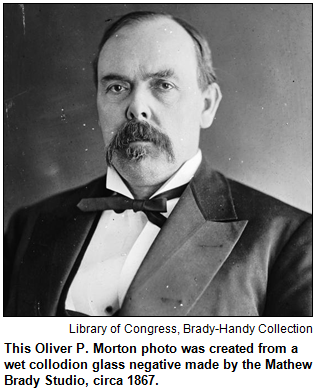 (Dec. 29, 2012) - "If it was worth a bloody struggle to establish this nation, it is worth one to preserve it."
(Dec. 29, 2012) - "If it was worth a bloody struggle to establish this nation, it is worth one to preserve it."
So declared (in a speech delivered a few months before the firing on Fort Sumter, S.C.) one of the nation's most ardent advocates of the Northern cause, an avid supporter of President Abraham Lincoln and the dominant figure in Indiana politics for much of the 1860s and '70s.
Gov. Oliver Perry Morton even was considered as a presidential nominee by the Republican Party (which he helped found in Indiana) more than a decade after Lincoln's assassination.
Amid the acclaim and awards being heaped on the current movie Lincoln, we explore the colorful life of the attorney from Centerville in Wayne County who rose in politics to become Indiana's governor from 1861 to 1867.
Our distinguished guest is an educator who also has been garnering awards - and who has purchased Oliver P. Morton's historic home, which had been greatly deteriorating.
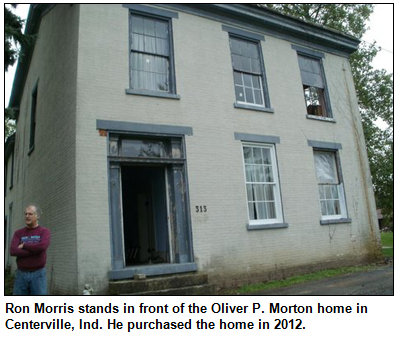 Ron Morris, a Ball State University professor of social studies, is renowned for the ways he uses landmarks to spark interest in history among young people. In September, Indiana Landmarks named him a winner of the Sandi Servaas Memorial Award for his outstanding achievements in historic preservation.
Ron Morris, a Ball State University professor of social studies, is renowned for the ways he uses landmarks to spark interest in history among young people. In September, Indiana Landmarks named him a winner of the Sandi Servaas Memorial Award for his outstanding achievements in historic preservation.
Ron shares insights about the life of Oliver P. Morton, whose statue in front of the Indiana Statehouse is a familiar sight for thousands of Hoosiers every day. Thanks in many ways to Morton's dedication to the Northern cause, Indiana ranked second in the percentage of men of military age to serve in the Union Army during the Civil War.
"To admirers, Oliver P. Morton was a strong, decisive and effective leader, most notably during the Civil War, and one of the state's greatest governors," according to Governors of Indiana (Indiana Historical Society Press, 2006). 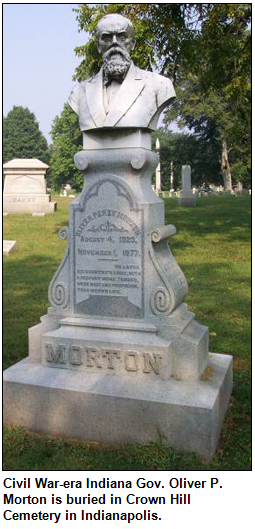 "To detractors, he was a crafty opportunist who shifted positions according to the prevailing winds and a power-hungry schemer who used questionable tactics to assemble and perpetuate his political machine."
"To detractors, he was a crafty opportunist who shifted positions according to the prevailing winds and a power-hungry schemer who used questionable tactics to assemble and perpetuate his political machine."
Morton's critics accused him of greatly exaggerating the presence in Indiana of Copperheads and other Southern-sympathizing groups late in the war so he could expand his powers and become, as some argued, a "virtual dictator."
His historic home in Centerville was purchased last July by Ron Morris, who plans to stabilize it from the elements, then restore it, room by room, to the period between 1848 and 1862. Ron lives nearby in another historic home built in 1830 on the Old National Road in Centerville. He is the author of Bringing History to Life: First Person Presentations in Elementary and Middle School Social Studies (Roman and Littlefield, 2009).
"You can step outside of a classroom in any community and give a class a 3D sense of place and the past," Ron told the Indiana Preservationist, a publication of Indiana Landmarks.
Morton (1823-1877) was the first Hoosier by birth to serve as the state's governor.
Known as the "soldier's friend," he worked tirelessly during the Civil War to make certain "our Indiana boys" were supplied with everything from uniforms and overcoats to weapons and medical supplies. He visited training camps and battlefields, establishing hospitals near the front lines to care for wounded soldiers who could not be transported back to Indiana for treatment.
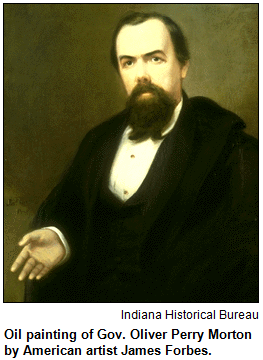 Morton even traveled to Washington to personally request that Lincoln intervene and supply overcoats to shivering Indiana soldiers who were on Cheat Mountain in West Virginia as snow was falling.
Morton even traveled to Washington to personally request that Lincoln intervene and supply overcoats to shivering Indiana soldiers who were on Cheat Mountain in West Virginia as snow was falling.
Several years before the war, Morton had been an anti-slavery Democrat. Then he helped form the People's Party, a forerunner of the Republican Party in Indiana.
The pre-Civil War era in Indiana is familiar turf for our guest Ron Morris, who has produced video games about the Underground Railroad and Morgan's Raid, the swath of destruction waged by Confederate soldiers across southern Indiana.
After the war, Oliver Perry Morton suffered a stroke but was elected to the U.S. Senate. He was serving there in 1876 when, partially paralyzed from the stroke, he placed second on the initial balloting for the presidential nomination at the Republican National Convention. The ultimate nominee was Rutherford B. Hayes from Ohio, who moved into the White House in 1877. Later that year, Morton died following another stroke; he is buried at Crown Hill Cemetery.
Roadtrip: New interpretive panels along Indiana National Road
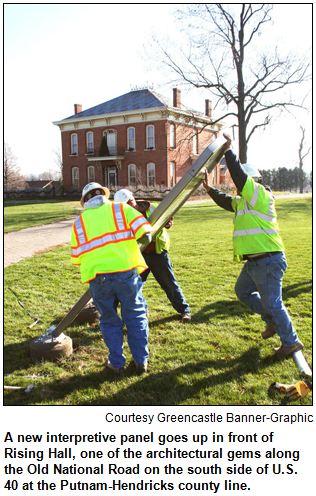 Chris Gahl of Visit Indy suggests we forgo I-70 and take a slower Roadtrip along Indiana's historic Old National Road, also known as U.S. 40, where 15 new interpretive panels have been installed by the Indiana National Road Association (INRA).
Chris Gahl of Visit Indy suggests we forgo I-70 and take a slower Roadtrip along Indiana's historic Old National Road, also known as U.S. 40, where 15 new interpretive panels have been installed by the Indiana National Road Association (INRA).
The Old National Road in Indiana stretches east to west from Richmond to Terre Haute and was our nation's first federally funded interstate highway. In 1811 construction started in Cumberland, Md., and went westward toward Vandalia, Ill., and by 1834, Indiana's section of the road was completed.
Thousands of settlers used the road to move west, and by the 1850s, the traffic included families in covered wagons and stagecoaches, as well as farmers moving their livestock to market.
In 1994, the Indiana National Road Association (INRA) was created to assist in designating the National Road as a National Scenic Byway. More information is available from Joe Frost, the association's executive director, at (317) 822-7939 or jfrost@indianalandmarks.org.
History Mystery
Oliver Perry Morton, Indiana's governor during the Civil War, studied at Miami University in Oxford, Ohio, for a few years as a young man. He left to study law.
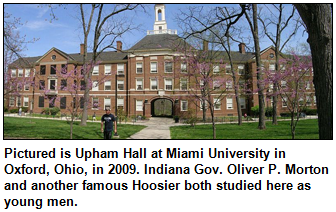 Miami University in Ohio also was the alma mater of another famous Hoosier who, like Morton, had a connection to the Civil War.
Miami University in Ohio also was the alma mater of another famous Hoosier who, like Morton, had a connection to the Civil War.
Question: Who was this other famous Hoosier?
This week's prize is two tickets to the Indiana Experience, two tickets to the NCAA Hall of Champions, and two tickets to the James Whitcomb Riley Museum Home, courtesy of Visit Indy.
Encore presentations
Lincoln's youth in Indiana and historic high school gyms: two classic shows
(Dec. 22, 2012) - The new movie Lincoln - currently playing in theaters and generating widespread critical praise - focuses on the final era of the life of "The Great Emancipator." So how about a refresher about the character-shaping and life-impacting events that happened during his youth in the new Hoosier state?
Abe Lincoln's years in Indiana - he moved here from Kentucky with his family at age 7 in 1816 (the same year we became a state) - are often overlooked.
Many people associate the Hoosier state with high school basketball. Is it any surprise, then, that creative reuses have been found for historic high school gyms in towns across the state?
Those two topics - Lincoln's youth in Indiana and Historic gyms across Indiana - are be the focus of "encore" broadcasts of two popular Hoosier History Live! shows. Instead of a one-hour broadcast, you can enjoy two back-to-back shows from our archives.
Lincoln's youth in Indiana
 For the first classic show (original air date: Feb. 7, 2009), Nelson is joined in studio by two young people and their well-known teacher, who immersed themselves in Lincoln and Indiana lore.
For the first classic show (original air date: Feb. 7, 2009), Nelson is joined in studio by two young people and their well-known teacher, who immersed themselves in Lincoln and Indiana lore.
His guests are Andrea Neal, a history teacher at St. Richard's Episcopal School (and Nelson's former colleague at the Indianapolis Star, where she was editor of the editorial pages and continues to write a column), as well as two of her outstanding students. They are Courtney Burke and Caroline Tucker, who were eighth-graders at St. Richard's when the show was originally broadcast.
Because Abe Lincoln and his family didn't move to Illinois until he was 21 years old, all of his "wonder years" were spent as a Hoosier. Young Abe, who was tall and gangly as a 7-year-old, helped his father clear the unbroken forest in southern Indiana so they could build the family's cabin.
 During our show, Andrea, Courtney and Caroline explain the dramatic changes in the Lincoln family - and in their Little Pigeon Forge settlement - that unfolded during the future president's boyhood.
During our show, Andrea, Courtney and Caroline explain the dramatic changes in the Lincoln family - and in their Little Pigeon Forge settlement - that unfolded during the future president's boyhood.
They discuss his schooling, his tastes in reading (which became a lifelong passion during his Indiana years) and the influence of various adults during his youth. They included his mother, Nancy Hanks Lincoln, who is buried in Spencer County.
Nelson's guests also share insights about the Lincoln family's motivations for moving to Indiana - as well as explanations for why they eventually left to resettle in Illinois.
Historic gyms across Indiana
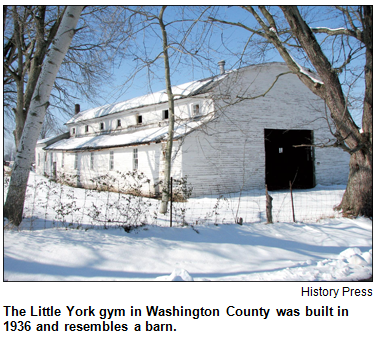 During the second classic show (original air date: Jan. 1, 2011), the focus is on the fates of former gyms, which often served as "town halls," pulling basketball-crazed communities together on Friday nights from the 1920s through the '50s.
During the second classic show (original air date: Jan. 1, 2011), the focus is on the fates of former gyms, which often served as "town halls," pulling basketball-crazed communities together on Friday nights from the 1920s through the '50s.
One historic high school gym is owned now by the Miami Nation of Indians. At least two others are private homes. In another small Indiana town, a high school gym built in 1925 is a fire station.
To explore these and other former gyms, Nelson is joined in studio by Indianapolis Star sportswriter Kyle Neddenriep, the author of Historic Hoosier Gyms: Discovering Bygone Basketball Landmarks (The History Press), and by Chris May, executive director of the Indiana Basketball Hall of Fame in New Castle.
Chris shares folklore about well-known current high school gyms across the state. Kyle's lavishly illustrated book spotlights 100 former gyms; he photographed these "gym gems" in their current uses, which include a church. (That's in tiny Honeywell in far-northeastern Indiana, where a hoop and basket hang over the pews of the Eden Worship Center.) A former gym in the southern Indiana town of Sidney now is a flea market.
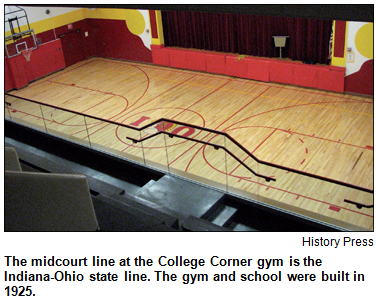 In Peru, a former arena for Peru High School that was the home court of Kyle Macy, 1975's Mr. Indiana Basketball, has been owned for more than 20 years by the Miami Nation of Indians. They have used the gym in various ways, including as the setting for bingo night three times weekly.
In Peru, a former arena for Peru High School that was the home court of Kyle Macy, 1975's Mr. Indiana Basketball, has been owned for more than 20 years by the Miami Nation of Indians. They have used the gym in various ways, including as the setting for bingo night three times weekly.
In far-eastern Indiana, the Wayne County community of Greens Fork has turned its historic gym (built in 1925) into a fire station.
Tune in as we explore these and a hoops-high stack of other gyms, including the New Castle Fieldhouse, which opened in 1960. As many Hoosiers know, the Henry County landmark seats more than 9,320 spectators and is the world's largest high school gym.
Tipton County history and Obama ancestral home
(Dec. 15, 2012) - Take a turn in the spotlight, Tipton County. Not only is there a new visual history book about your history, but a documentary is also in the works about the farmhouse owned by ancestors of President Barack Obama that's located near the tiny town of Kempton.
 Speaking of our commanders in chief: Did you know President Teddy Roosevelt gave a rousing speech to a crowd in Tipton in 1902? Not long afterward, the Rough Rider was hustled to St. Vincent Hospital in Indianapolis for surgery on an injured leg.
Speaking of our commanders in chief: Did you know President Teddy Roosevelt gave a rousing speech to a crowd in Tipton in 1902? Not long afterward, the Rough Rider was hustled to St. Vincent Hospital in Indianapolis for surgery on an injured leg.
That presidential trivia comes courtesy of Images of America: Tipton County (Arcadia Publishing), a visual history book by Tipton-based writer Janis Thornton, who joins Nelson in studio.
So does residential contractor and historic preservationist Shawn Clements, owner of Dunham House, the 19th-century farmhouse built by Obama's maternal ancestors. (Several generations of Dunhams owned the house, until 1969.)
Shawn joined Nelson for a Hoosier History Live! show about the historic homestead in the spring of 2009, almost exactly a year after Obama (then just a candidate for the Democratic presidential nomination) visited the spacious farmhouse accompanied by his wife, Michelle, and their two daughters, with about 100 journalists in tow.
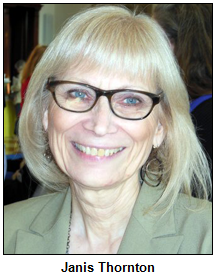 Shawn returns as a guest to share updates because so much has unfolded since his initial appearance on our show, including the documentary under way titled A Single Root.
Shawn returns as a guest to share updates because so much has unfolded since his initial appearance on our show, including the documentary under way titled A Single Root.
Janis covered the headline-making visit because she then was an editor at the Frankfort Times newspaper, although she grew up in Tipton. As a teenager, her first date was at a hometown landmark that has become a rare breed: An independent, locally owned cinema house (with a vintage marquee) called the Diana Theater.
Built by a Greek immigrant to Tipton in 1926, the Diana was devastated by a fire in the 1940s but was quickly rebuilt (with the added enticement of air conditioning) and continues to be run by a descendant of the original owner.
Also during the 1940s, the Tipton County town of Windfall was the setting for a World War II prisoner-of-war camp. Thanks to the help of the Tipton County Historical Society, Janis was able to obtain a rare photo taken inside the camp, which became a temporary home for hundreds of captured Germans and was one of several in Indiana administered by Camp Atterbury.
During our show, we also explore the significant impact of railroads on Tipton (in 1910, there was a tragic collision between a freight train and an interurban, resulting in half a dozen deaths) and the annual event for which the town probably is best known across the state. 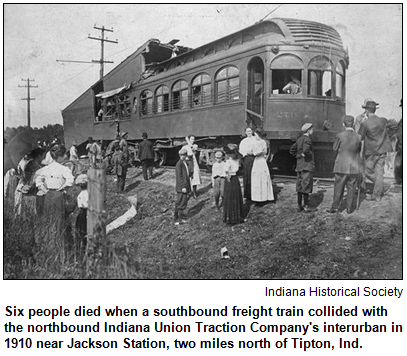 That's the Tipton County Pork Festival, which the community has hosted for more than 40 years.
That's the Tipton County Pork Festival, which the community has hosted for more than 40 years.
The festival draws tens of thousands of visitors to the lawn of the Tipton County Courthouse and surrounding streets. In her book, Janis refers to the county's signature commodity as "a hot, juicy, barbecued pork chop."
Both Tipton County and the town that serves as its county seat are named after Gen. John Tipton, a military leader who battled Native Americans. Miami Indians in the Tipton County area were among the last Native American tribes to leave - or, in most cases, be forcibly removed from - Indiana.
In the 1840s, Barack Obama's maternal ancestors, the Dunhams, became the first white settlers of 120 acres they acquired from a government land grant. Some of their descendants - who included farmers, a physician, attorneys, teachers and even a Democratic state legislator - built the Dunham House and were buried nearby in a family cemetery.
Our guest Shawn Clements has moved some of their headstones, which were deteriorating, inside the house for display, with the permission of descendants of the initial settler, Jacob Dunham (1795-1865).
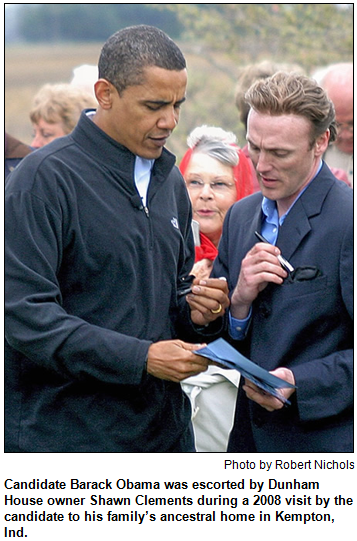 Some of his descendants eventually moved to Kansas, where Obama's late mother, Ann Dunham, grew up.
Some of his descendants eventually moved to Kansas, where Obama's late mother, Ann Dunham, grew up.
Shawn, who grew up in Lebanon and had been living in Noblesville, bought the Dunham House in 2005. As he explained on our show in 2009, Shawn was unaware of the farmhouse's link to Obama, who then was merely a rising political star unknown to much of the general public. Acting on a tip from an elderly Tipton County resident that Shawn explore the home's history, he established the multi-generational link to Obama.
The house has 12 rooms, a spacious porch and 5,000 square feet. When Barack and Michele Obama visited it in May 2008, they were accompanied by their daughters Mala and Sasha, as well as by Secret Service agents, a caravan of news media and bomb-sniffing dogs.
Photos of the visit are featured in the new book by Janis Thornton, who returned to live in her hometown of Tipton after spending 20 years in Los Angeles. Since then, she has worked as a writer, editor and communications director for St. Luke's Methodist Church in Indianapolis, the Frankfort Times and Purdue University.
According to her new book, railroads greatly stimulated Tipton's growth, beginning in the 1850s.
"So eager were farmers to get their grain to market by rail that they donated rights-of-way, despite some old pioneers who insisted nothing could ever replace a good team of horses," Janis writes.
She notes that north-south and east-west tracks eventually formed a junction in Tipton County; at the turn of the last century, passenger trains from each direction met at the junction three times daily.
In addition to the visits by Obama and Teddy Roosevelt, President Harry Truman made one of his whistle-stop speeches in Tipton in 1948. According to Janis' book, Truman's visit drew 9,000 people.
The Tipton County Pork Festival often has drawn even larger crowds. In 1991, for example, about 20,000 festival-goers jammed the courthouse square to enjoy musical entertainment and the assortment of pork products.
History Mystery
 Two years after President Teddy Roosevelt's speech in Tipton in 1902, his vice presidential running mate was a Hoosier. The vice president from Indiana was a conservative selected in part to balance the Republican ticket because Roosevelt was regarded as a crusading progressive. The conservative Hoosier had been an extremely successful attorney for railroads. Then he served as a U.S. senator from Indiana.
Two years after President Teddy Roosevelt's speech in Tipton in 1902, his vice presidential running mate was a Hoosier. The vice president from Indiana was a conservative selected in part to balance the Republican ticket because Roosevelt was regarded as a crusading progressive. The conservative Hoosier had been an extremely successful attorney for railroads. Then he served as a U.S. senator from Indiana.
Roosevelt and the Hoosier won a landslide election in 1904. However, the two men had a cool - and sometimes even antagonistic - relationship during Roosevelt's presidency.
Question: Name the Hoosier who served as vice president in the Teddy Roosevelt administration.
This week's prize is gift certificate to any Arni's Restaurant, and two tickets to the Benjamin Harrison Presidential Site, courtesy of Visit Indy.
Roadtrip: Schimpff's Confectionery in Jeffersonville
Chris Gahl of Visit Indy suggests that we enjoy a Roadtrip to Jeffersonville to visit Schimpff's Confectionery, which is decked out for the holidays and has been operating as a candy store, soda fountain and lunch counter over 120 years.
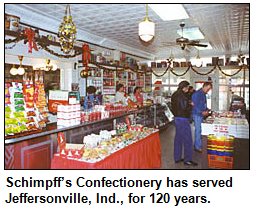 Schimpff's is in Jeffersonville's historic, walkable downtown, with its many enticing shops, at 347 Spring St. You can watch candy being made at the candy museum next door. Stroll south down Spring Street and you come to the Ohio River and the Jeffersonville RiverStage with its magnificent view of the river and Louisville on the other side.
Schimpff's is in Jeffersonville's historic, walkable downtown, with its many enticing shops, at 347 Spring St. You can watch candy being made at the candy museum next door. Stroll south down Spring Street and you come to the Ohio River and the Jeffersonville RiverStage with its magnificent view of the river and Louisville on the other side.
You'll also see the long-abandoned Big Four Railroad Bridge over the Ohio River being converted to a bicycle and pedestrian bridge connecting Jeffersonville and Louisville.
Other sites in the area include The Depot in Jeffersonville at 600 Quartermaster Station, an 1874 formerly segregated restroom that serves as headquarters for the Southern Indiana African American Heritage Trail. You can even have lunch at The Depot in its attractive small cafe. Also in the area is the Howard Steamboat Museum, and of course the splendid Falls of the Ohio State Park. This Roadtrip was recommended by Eric Grayson and Glory-June Greiff.
Colombian and Venezuelan immigration to Indiana
(Dec. 8, 2012) - Their percentage of the Indiana population is still relatively small, but immigrants from Colombia and Venezuela have grown explosively here - and across the country - during the last 20 years.
So Hoosier History Live! explores immigration from the two South American countries during the next show in our rotating series about the ethnic heritage of the Hoosier state, which has included looks at German, Irish, Scottish and Greek immigration here.
 During our nearly five years on the air, we also have focused on the arrival of Italian stonecutters in Indiana, our Cuban and Brazilian heritages and even the growing Sikh community here. (Click on the link to see the Hoosier History Live! archived enewsletter for that particular ethnic heritage show.)
During our nearly five years on the air, we also have focused on the arrival of Italian stonecutters in Indiana, our Cuban and Brazilian heritages and even the growing Sikh community here. (Click on the link to see the Hoosier History Live! archived enewsletter for that particular ethnic heritage show.)
Nelson is joined in studio by Venezuela native Marco Dominguez, who co-anchors the Spanish-language news webcast launched this summer by WTHR-TV/Channel 13 in Indianapolis.
Our guests also include Fishers resident Bertha Torres, a native Colombian who is past president of the Friends of Colombia Society, and Danny Lopez, executive director of the Indiana Commission on Hispanic/Latino Affairs. 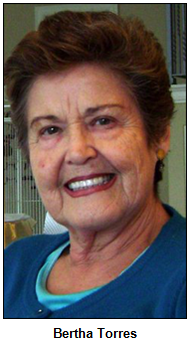 Danny, who is of Cuban heritage, joined Nelson last May for our show about Cuban immigration to Indiana; because of his statewide position, he has informed perspectives about an array of Hispanic communities.
Danny, who is of Cuban heritage, joined Nelson last May for our show about Cuban immigration to Indiana; because of his statewide position, he has informed perspectives about an array of Hispanic communities.
"In all, there are three times as many Colombians as Venezuelans in Indiana," Danny reports. He notes that Colombian immigrants are most heavily concentrated in Lake County and Marion County, whereas their Venezuelan counterparts have tended to settle in north-central Indiana and in Hamilton County.
Our guest Marco Dominguez immigrated from Venezuela to Indiana twice, beginning in the 1980s to study at Vincennes University, then at Butler University. He is former station manager for Univision in Indianapolis and is community sales director for the Finance Center Federal Credit Union. A pioneer in Hispanic media in Indiana, Marco was a producer for WTBU, Butler University's TV station, for eight years.
Our guest Bertha Torres met Manuel A. Torres, her husband of 53 years, when they were children in Bogota, Colombia's capital city. Because Manuel Torres had a long career in the U.S. Army, they lived everywhere from Germany to San Francisco (as well as in Indianapolis during the 1970s when he worked at Fort Benjamin Harrison) before they settled permanently in central Indiana in the early 1980s.
 Bertha is retired after a varied career, including a long stint at P.R. Mallory and Co., the now-closed, Indy-based electrical components manufacturer where she oversaw the international/exports division. Bertha and her husband are the parents of three grown children.
Bertha is retired after a varied career, including a long stint at P.R. Mallory and Co., the now-closed, Indy-based electrical components manufacturer where she oversaw the international/exports division. Bertha and her husband are the parents of three grown children.
According to information supplied by our guest Danny Lopez, much of the Venezuelan immigration has occurred during the late 1990s and early 2000s. In fact, almost 75 percent of Venezuelans living in Indiana came during that period, a trend that many analysts link to the ascendancy of Hugo Chavez, the controversial president of Venezuela.
Venezuelan immigration, in fact, is said to mirror (on a smaller scale) earlier waves of Cubans, with both groups having higher-than-average levels of education and financial resources.
Statistics supplied by Danny indicate about 3,890 people who describe themselves as Colombian live in Indiana. However, he notes wide discrepancies between estimates about immigrants from the Colombian and American governments.
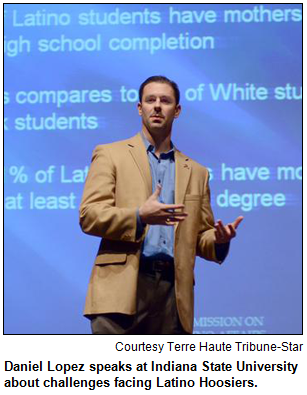 The average Colombian in this country, according to Danny's information, is 34 years old; for the overall Latino population here, the average age is 27.
The average Colombian in this country, according to Danny's information, is 34 years old; for the overall Latino population here, the average age is 27.
In addition to exploring immigration patterns, Nelson and his guests share insights about the culture, impact, contributions and challenges of Colombians and Venezuelans here. He also asks Bertha and Marco to share their personal stories about coming to the Hoosier state.
Some other insights:
- In the Indianapolis area, native Colombians who have become civic leaders include a vice president at Key Bank; the physician-founder of Alivio Health Center, a clinic that provides medical care for a range of Hispanic residents, and an extension educator for Purdue University.
- At the Indianapolis Motor Speedway, several Colombian and Venezuelan drivers have become familiar to racing fans. They have included Juan Pablo Montoya, a native of Bogota who won the Indianapolis 500 in 2000. In 2007, he switched to NASCAR racing; three years later, Montoya was the pole sitter for the Brickyard 400. Other drivers in recent Indy 500s have included E.J. Viso and Milka Duno, both from Venezuela. During the 1980s, popular Roberto Guerrero, a native Colombian, was the runner-up at the 500 twice.
- According to information from Danny, 29 percent of Colombians in the United States have at least a bachelor's degree. That's far higher than both the overall American population and the overall Latino population.
History Mystery
During the early 1960s, children who were evacuated from Cuba because of the Fidel Castro regime were brought to more than two dozen American cities designated as havens. The cities included one in Indiana where Catholic parishes and social service organizations had stepped forward to assist Cuban families.
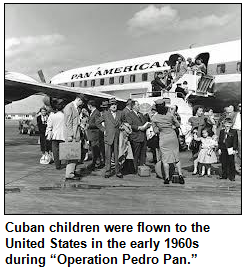 Because of the city's significant role during the Cuban evacuation of children - a project often referred to as "Operation Pedro Pan" - Cubans have had a more significant presence in the Hoosier city ever since.
Because of the city's significant role during the Cuban evacuation of children - a project often referred to as "Operation Pedro Pan" - Cubans have had a more significant presence in the Hoosier city ever since.
Question: What is the Indiana city?
Hints: It is not South Bend, where Cubans also have been a significant presence for generations, generally attributed to Cuban students and alumni of the University of Notre Dame. The other Indiana city - which played a role with "Pedro Pan" children from Cuba - was mentioned on Hoosier History Live! by our guest Danny Lopez during a show last May about Cuban immigration.
This week's prize is two tickets to the 1836 Outdoor Adventure and Winter Fun Days at Conner Prarie, two tickets to the Benjamin Harrison Presidential Site, and two tickets to the Indiana Experience, courtesy of Visit Indy.
Roadtrip: The Nutcracker around Indy
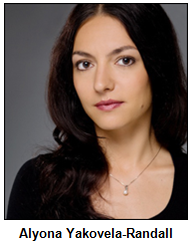 Chris Gahl of Visit Indy suggests that we enjoy Tchaikovsky's magical holiday music with a performance of The Nutcracker at the Tobias Theater at the Indianapolis Museum of Art the weekend of Dec. 14. The Indiana Ballet Conservatory will stage the classic Christmas ballet under the artistic direction of Alyona Yakovela-Randall.
Chris Gahl of Visit Indy suggests that we enjoy Tchaikovsky's magical holiday music with a performance of The Nutcracker at the Tobias Theater at the Indianapolis Museum of Art the weekend of Dec. 14. The Indiana Ballet Conservatory will stage the classic Christmas ballet under the artistic direction of Alyona Yakovela-Randall.
The Indianapolis School of Ballet's performance of The Nutcracker will be the weekend of Dec. 21 at Indy's Scottish Rite Cathedral in a set that recreates Indy's Victorian-era mansion, the Morris-Butler House. Please take time this holiday season to enjoy our local performers and dance organizations!
Live from the Holiday Author Fair
History-making sheriff, immigrants to Indy, crusading politico and public gardens
(Dec. 1, 2012) - For the fifth year, Hoosier History Live! was broadcast from a remote (non-studio) location: the Eugene and Marilyn Glick Indiana History Center, which bustled with captivating interviewees, as about 80 authors with Indiana connections gathered for the 10th Annual Holiday Author Fair. Nelson conducted round-robin chats with a range of fellow authors.
Here are highlights of our special program:
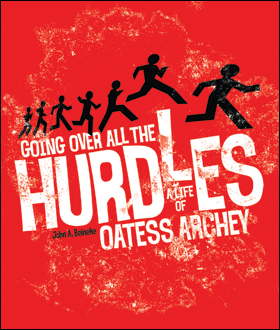 History-making sheriff. Seven years after the notorious lynching in 1930 of two African-Americans in Marion, Oatess Archey was born in the Grant County city. He grew up to become the first African-American to be elected sheriff in Indiana.
History-making sheriff. Seven years after the notorious lynching in 1930 of two African-Americans in Marion, Oatess Archey was born in the Grant County city. He grew up to become the first African-American to be elected sheriff in Indiana.
Mr. Archey, who also was the first black teacher at Marion High School, where he had been a state champion in high hurdles in 1955, joins Nelson for an interview.
So does John Beineke, the author of a biography of his former teacher titled Going Over All the Hurdles: A Life of Oatess Archey (Indiana Historical Society Press). 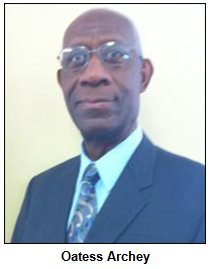 The book describes the hurdles that Mr. Archey encountered during a diverse career.
The book describes the hurdles that Mr. Archey encountered during a diverse career.
After teaching at Marion High School (where he initially had been rejected for the faculty and, despite being a college graduate, was hired instead as a janitor), Mr. Archey became the first black track coach and administrator at Ball State University. That was followed by a stint as an FBI agent and firearms instructor at the agency's headquarters in Washington D.C.
He returned to his hometown and was elected Grant County sheriff in 1998. Mr. Archey served two terms (the Ku Klux Klan denounced his initial election with a protest on the courthouse square), resulting in headlines that caught the attention of John Beineke, a Marion native who now is an administrator and professor at Arkansas State University.
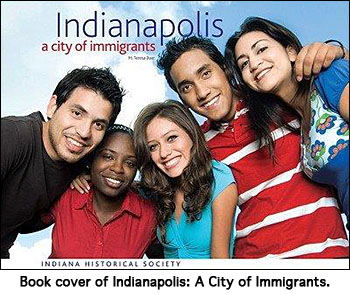 The two share insights with Nelson about various historic events in Marion that are described in Going Over All the Hurdles, including the court-ordered desegregation in the 1950s of a swimming pool in the city's Matter Park. (As boys, Mr. Archey and his brother had to be taken to Anderson if they wanted to swim in a public pool.)
The two share insights with Nelson about various historic events in Marion that are described in Going Over All the Hurdles, including the court-ordered desegregation in the 1950s of a swimming pool in the city's Matter Park. (As boys, Mr. Archey and his brother had to be taken to Anderson if they wanted to swim in a public pool.)
 City of immigrants. Later during our show, Nelson is joined by Teresa Baer, the author of Indianapolis: A City of Immigrants (IHS Press), a booklet that explores the waves of ethnic immigration to the Hoosier capital. It begins with a look at Native Americans (Delaware Indians) during the pre-1800 wilderness era and explores immigrants from Britain, Ireland, Germany and southern and eastern Europe.
City of immigrants. Later during our show, Nelson is joined by Teresa Baer, the author of Indianapolis: A City of Immigrants (IHS Press), a booklet that explores the waves of ethnic immigration to the Hoosier capital. It begins with a look at Native Americans (Delaware Indians) during the pre-1800 wilderness era and explores immigrants from Britain, Ireland, Germany and southern and eastern Europe.
Derived from a suggestion by former Mexican consul to Indianapolis Sergio Aguilera, the booklet also explores African-Americans in early Indiana, the immigration of Asians such as Chinese, Japanese, Koreans and Vietnamese, and also Hispanics from Mexico and other Central and Latin American countries.
According to Teresa, the booklet is intended as a supplement for high school juniors at schools in central Indiana as they study ethnic immigration; it includes a timeline about the waves of arrivals of various groups.
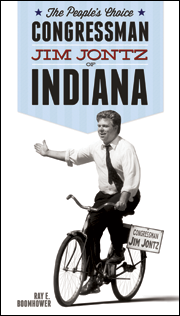 Teresa makes the point that, almost from the very beginning, immigrants have been confronted by resentment and hostility from people who arrived earlier. Initial targets in the 1800s were Germans and poverty-stricken Irish Catholics who came to build canals and railroads.
Teresa makes the point that, almost from the very beginning, immigrants have been confronted by resentment and hostility from people who arrived earlier. Initial targets in the 1800s were Germans and poverty-stricken Irish Catholics who came to build canals and railroads.
"Ultimately, all of us came from somewhere else to be here," notes Teresa, who is managing editor of family history publications at the historical society.
The booklet, which was sponsored by the Efroymson Family Fund, includes vintage photos of a German immigration guide from the 1930s; Greek children during the same era in Indianapolis, and students at Hasten Hebrew Academy during a Passover seder in 1998.
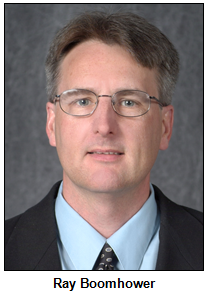 According to Indianapolis: A City of Immigrants, Hispanics in Marion County increased from 33,000 in 2000 to 84,000 nine years later. The booklet is being sold to the general public as well as being used by students, with a free teachers guide available.
According to Indianapolis: A City of Immigrants, Hispanics in Marion County increased from 33,000 in 2000 to 84,000 nine years later. The booklet is being sold to the general public as well as being used by students, with a free teachers guide available.
A "long shot" political career. Nelson also interviews Ray Boomhower, author of The People's Choice: Congressman Jim Jontz of Indiana (IHS Press). It's a biography of Jontz, a populist U.S. congressman and crusading environmentalist from Indiana who died of cancer in 2007 at age 55.
Ray looks at the "long-shot" political career of Jontz, a Democrat known for his frugal lifestyle and "shoe leather" campaigns who repeatedly won various races, beginning as a state legislator, in northern Indiana districts considered to be conservative and Republican.
In 1974, at age 22 while working as an unpaid caretaker for a local nature preserve, Jontz unseated a top Indiana lawmaker by merely two votes. ("One vote more than I needed to win!" Jontz remarked, according to Ray's biography.) After a defeat in his final political race, an effort to unseat U.S. Sen. Richard Lugar in 1994, Jontz became an advocate for environmental groups.
 As a young newspaper report in Rensselaer during the early 1980s, Ray covered one of Jontz's campaigns. Several years earlier, Jontz had been inspired to enter politics by a controversial dam project in Warren County that threatened the Fall Creek Gorge area.
As a young newspaper report in Rensselaer during the early 1980s, Ray covered one of Jontz's campaigns. Several years earlier, Jontz had been inspired to enter politics by a controversial dam project in Warren County that threatened the Fall Creek Gorge area.
Ray is the editor of Traces of Indiana and Midwestern History, the colorful magazine published by the historical society. He has been a Hoosier History Live! guest several times, including shows about astronaut Gus Grissom and suffragette May Wright Sewall, who are subjects of some of his other biographies.
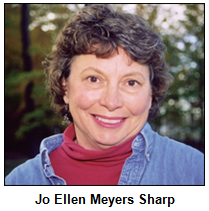 Gardening with Jo Ellen! Another favorite guest, Jo Ellen Meyers Sharp of "Hoosier Gardener" renown, also joins us during this Holiday Author Fair show. That's because Jo Ellen, an Indianapolis-based director of the Garden Writers Association, is the author of The Visitor's Guide to American Gardens (Cool Springs Press), a state-by-state exploration of public gardens.
Gardening with Jo Ellen! Another favorite guest, Jo Ellen Meyers Sharp of "Hoosier Gardener" renown, also joins us during this Holiday Author Fair show. That's because Jo Ellen, an Indianapolis-based director of the Garden Writers Association, is the author of The Visitor's Guide to American Gardens (Cool Springs Press), a state-by-state exploration of public gardens.
Nelson talks about Indiana's public gardens with Jo Ellen, a former Indianapolis Star colleague whose "Hoosier Gardener" column is a popular feature of the newspaper. She also has a regular stint as the "Hoosier Gardener" on WXIN-TV/Fox 59.
Her new book explores about 400 gardens in the United States and Canada and features maps as well as info about garden talks, walks and other events. Many of the gardens in the book are on the National Register of Historic Places. They include the gardens at Oldfields at the Indianapolis Museum of Art, Garfield Park (the oldest city park in Indy) and New Harmony State Historic Park, where the gardens feature a well-known labyrinth.
Fun facts, courtesy of Jo Ellen:
- At Oldfields, the Ravine Garden was designed as a "bright, sunny spring garden" because the owners were away during summers. The gardens at Oldfields were designed by the famous landscape firm of the Olmstead Brothers; the Olmstead firm also designed Central Park in New York City.
- Jo Ellen is a landscape consultant and the owner of Write for You!, a freelance writing business. Her new book pulls together information about attractions and features of public gardens that is unavailable in a single resource elsewhere, including on the Internet. Jo Ellen has been writing and speaking about natural gardening for more than 20 years.
Dan Wakefield on Kurt Vonnegut's letters
 (Nov. 24, 2012) - Over a 60-year period beginning when he was freed as a POW in Germany during World War II, an internationally known novelist from Indiana wrote letters to family members, friends and even literary critics.
(Nov. 24, 2012) - Over a 60-year period beginning when he was freed as a POW in Germany during World War II, an internationally known novelist from Indiana wrote letters to family members, friends and even literary critics.
Now his longtime pal, another novelist from Indianapolis, has edited the letters, which range in tone from haunting, poignant and blistering to witty, warm and irreverent.
Dan Wakefield, the author of Going All the Way (1970) and other bestsellers, returns to Hoosier History Live! to share insights about Kurt Vonnegut Letters (Delacorte Press/Random House).
Dan wrote the introduction for the book, as well as decade-by-decade biographical summaries and (for many of the letters) explanatory notes. The book is being published this month, when Kurt Vonnegut would have celebrated his 90th birthday.
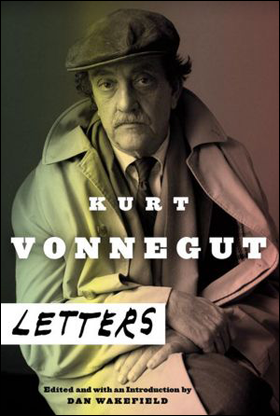 Descended from a German-American family that influenced business, cultural and civic life in Indianapolis (as well as the look of the city) starting in the 1850s, Kurt Vonnegut died in April 2007. That year, the Hoosier capital was in the midst of celebrating a "Year of Vonnegut" as a tribute to the literary lion who drew worldwide acclaim for Slaughterhouse-Five (1969), a novel based on his harrowing ordeal as a POW during the firebombing of Dresden, Germany. Vonnegut, who had been a leader of the POWs because of his ability to speak German, was ordered by guards to haul away corpses of children, women and the elderly.
Descended from a German-American family that influenced business, cultural and civic life in Indianapolis (as well as the look of the city) starting in the 1850s, Kurt Vonnegut died in April 2007. That year, the Hoosier capital was in the midst of celebrating a "Year of Vonnegut" as a tribute to the literary lion who drew worldwide acclaim for Slaughterhouse-Five (1969), a novel based on his harrowing ordeal as a POW during the firebombing of Dresden, Germany. Vonnegut, who had been a leader of the POWs because of his ability to speak German, was ordered by guards to haul away corpses of children, women and the elderly.
"Reading these letters has allowed me to know my friend Kurt Vonnegut better and to appreciate him even more," Dan Wakefield writes in the introduction. "Nothing came easy for him."
Both Vonnegut and Wakefield attended Shortridge High School and were editors of its legendary newspaper, The Daily Echo. Because of their age difference (Vonnegut was a member of the class of 1940; Wakefield of the class of '50), the two did not meet until the early 1960s. Even so, Dan says that as a high school senior he heard about the impact his future friend was beginning to make as a writer.
Years later, Dan credited Vonnegut with a crucial role in making Going All the Way a bestseller by writing an influential review of the novel for Life magazine.
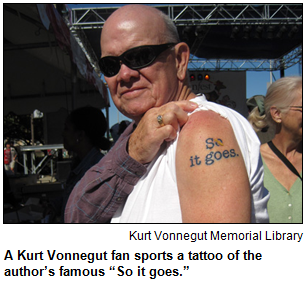 Letters about their mutual hometown are included in the new book. In one, Vonnegut expresses frustration about an infamous book signing for Slaughterhouse-Five at the bookstore in the flagship L.S. Ayres & Co. department store in downtown Indy.
Letters about their mutual hometown are included in the new book. In one, Vonnegut expresses frustration about an infamous book signing for Slaughterhouse-Five at the bookstore in the flagship L.S. Ayres & Co. department store in downtown Indy.
"I sold 13 books in two hours, every one of them to a relative," Vonnegut wrote Wakefield in 1969. "Word of honor."
At that point, cities and colleges across the country were clamoring for a Vonnegut visit, with hundreds of eager book buyers standing in long lines. So the dismal turnout at Ayres (the building was designed by Vonnegut's grandfather, acclaimed architect Bernard Vonnegut; its landmark clock was designed later by Kurt Vonnegut Sr.) was particularly exasperating.
In 1997, Vonnegut wrote a blistering letter to the Junior League of Indianapolis (it also is included in Kurt Vonnegut Letters) over the organization's handling of the sale of a historic home designed by his grandfather.
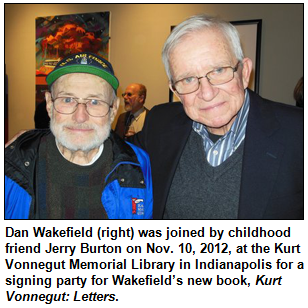 But Kurt Vonnegut, who was based in New York City and elsewhere on the East Coast for much of his post-World War II life, also cherished many aspects of his hometown and came to feel a sense of pride in its rejuvenated downtown.
But Kurt Vonnegut, who was based in New York City and elsewhere on the East Coast for much of his post-World War II life, also cherished many aspects of his hometown and came to feel a sense of pride in its rejuvenated downtown.
Dan Wakefield, who also lived in New York City for many years, as well as in Miami and Boston, resettled in Indianapolis nearly a year ago. Last January, he joined Nelson on Hoosier History Live! to share insights about landmarks from the 1950s (some bygone, some persevering) such as the Red Key Tavern, the Athenaeum and the Ron-D-Vu Drive-In that are mentioned in Going All the Way. A movie version of Going All the Way (1996) starring Ben Affleck was filmed in Indianapolis.
In September, Dan received the Eugene and Marilyn Glick Indiana Author Award for lifetime achievement. In addition to Going All the Way, his books include an acclaimed memoir, Returning: A Spiritual Journey (1988); Creating from the Spirit (1996) and Under the Apple Tree (1982).
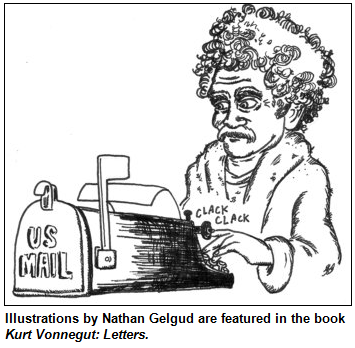 For Kurt Vonnegut Letters, Dan combed through more than 1,000 letters written by the literary lion. To another famous novelist, Norman Mailer, Vonnegut once wrote: "I am cuter than you are."
For Kurt Vonnegut Letters, Dan combed through more than 1,000 letters written by the literary lion. To another famous novelist, Norman Mailer, Vonnegut once wrote: "I am cuter than you are."
Some of his letters from the late 1950s were written on stationary from a Saab dealership on Cape Cod. That’s because Vonnegut, while struggling to support his young family, briefly had the unlikely job of selling Saabs, the Swedish-made car.
As Dan notes in the introduction to Kurt Vonnegut Letters, "Nothing deterred him" as a writer - not even when a relative to whom he had dedicated The Sirens of Titan (1959) his second novel, told him he was unable to finish reading it. (Another relative, who ran a bookstore in Louisville, Ky., apparently refused to stock his novels because they disgusted her.)
After Vonnegut achieved fame, he occasionally fired off letters to school boards and communities that banned his books. They included a town in North Dakota that threw copies of Slaughterhouse-Five into a furnace.
Throughout it all, as Dan notes in Kurt Vonnegut Letters, he maintained and cherished lifelong friendships, including many dating from his Shortridge years.
History Mystery
When Kurt Vonnegut Jr. was a boy in the 1920s, he lived with his family in a three-story, Arts & Crafts-style home on the north side of Indy. Kurt and his two older siblings, Bernard and Alice, left their palm prints in cement outside the back door of the elegant house, which has leaded-glass windows and his parents' monogram on the front door.
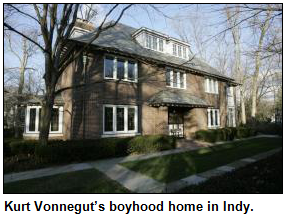 With the onset of the Great Depression when Kurt Jr. was about eight years old, the Vonneguts were compelled to move to a far less impressive home nearby.
With the onset of the Great Depression when Kurt Jr. was about eight years old, the Vonneguts were compelled to move to a far less impressive home nearby.
Later in life, the famous novelist occasionally referred to his initial boyhood home as "the house where nothing bad ever happened."
Question: What street was the initial Vonnegut house - which is still standing - located on?
This week's prize is four tickets to the Indiana Experience (which can also be used to attend next week's Holiday Author Fair) at the Indiana History Center, as well as a copy of both Indianapolis: A City of Immigrants by M. Teresa Baer and The People's Choice: Jim Jontz of Indiana by Ray E. Boomhower. Both of these authors will be at the Holiday Author Fair, and they also will be featured as guests on the Dec. 1 Hoosier History Live! show. These prizes are courtesy of the Indiana Historical Society.
Roadtrip: World War II 'Band of Brothers' member appears in Greensburg
Roadtripper Chris Gahl of Visit Indy tells us about an opportunity to meet and to listen to former Army Ranger Herb Sueth, 88, of Minneapolis, who was part of the famed 101st Airborne, also known as the "Band of Brothers," who parachuted into Normandy before D-Day during World War II.
A "Chautauqua Celebrating Courage and Tolerance" is open to the public and will be held Thursday, Nov. 29 at Greensburg High School Auditorium in Greensburg, Ind., from 7 to 9 p.m. Admission is $5.
According to Greensburg High School history teacher John Pratt, who has also been a guest on Hoosier History Live!, the discussion also will feature four Holocaust survivors who will be coming to Greensburg from all over the country. More information is available from John Pratt at (812) 663-7176, ext. 1222.
Enjoy 'encore' return of Covered bridges across Indiana
(Nov. 17, 2012) - Note: Because of WICR-FM's coverage of the University of Indianapolis football team, which has advanced to the NCAA Division II post-season for the first time, Hoosier History Live! will be pre-empted on the air Saturday. As a treat for our listeners, though, we are offering an encore broadcast of one of the most popular shows in our archives.
The show (original air date: Oct. 22, 2011) explores covered bridges across Indiana. More than 600 wooden, covered bridges were built in our state from 1820 to 1922.
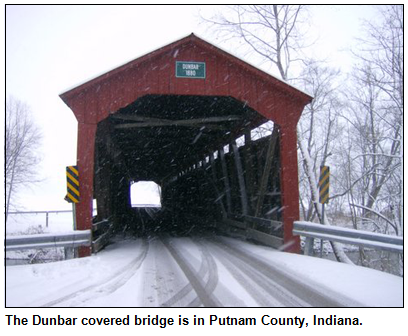 Today, about 90 of these historic gems remain.
Today, about 90 of these historic gems remain.
During this show, Nelson is joined by Margaret Smith of Indianapolis, past president of the Indiana Covered Bridge Society, and Larry Stout of Rush County, who helped spearhead the restoration of the historic Moscow Covered Bridge, which had been demolished by a tornado.
Some fun facts, courtesy of Margaret:
- The Medora Covered Bridge in Jackson County is, at 434 feet, the longest covered bridge in Indiana.
- The Edna Collins Covered Bridge - the last covered bridge built in the state - is said to be haunted. Constructed in 1922, the bridge, which crosses Little Walnut Creek, is haunted by the ghost of a little girl, according to folklore. In the 1920s, she is said to have enjoyed swimming in the creek, but she drowned while doing so at night.
- The Ramp Covered Bridge at the north entrance to Brown County State Park is the only two-lane covered bridge in Indiana. The bridge, which crosses Salt Creek, has another claim to fame: It's the oldest covered bridge still standing in Indiana. In 1838, the bridge was built in Putnam County. During the 1930s, it was moved with the creation of the state park in Brown County.
 The heyday of covered-bridge construction was the 1880s; bridges were covered to protect their flooring and interior from the elements.
The heyday of covered-bridge construction was the 1880s; bridges were covered to protect their flooring and interior from the elements.
Parke County, which is known as the "Covered Bridge Capital of the World", has 31 covered bridges that remain.
In Rush County, a tornado that roared through in 2008 tossed the Moscow bridge (built in 1886) into the Flatrock River. Reconstructed using 30 percent of its original wood, the Moscow Covered Bridge reopened with a community celebration in September 2010.
Last year, Indiana Landmarks honored our guest Larry Stout, president of Rush County Heritage and a resident of the village of Gowdy, with the SerVaas Award for lifetime achievement. His preservation efforts extend far beyond covered bridges, but his county - as well as Parke and Putnam counties - is particularly known for them.
Why those counties? Although there were several builders of covered bridges across Indiana, the three generally considered to have been the most significant were two historic bridge builders based in Rockville in Parke County (the businesses of J.J. Daniels and Joseph A.. Britton), as well as the firm run by A.M. Kennedy (and later by his sons and grandsons) in Rushville.
 Rush County has five covered bridges, all still in use. Some of the other covered bridges across the state no longer carry traffic. They have been bypassed by modern roads or preserved in parks.
Rush County has five covered bridges, all still in use. Some of the other covered bridges across the state no longer carry traffic. They have been bypassed by modern roads or preserved in parks.
"The bridges are located in many out-of-the-way places today, but they once were hubs of commerce," Margaret notes. "Many were railroad bridges. Often, they were the largest covered areas in a community."
That meant, she adds, that they frequently served as the setting for "political rallies, community gatherings and revival meetings – even weddings."
More fun facts, again courtesy of Margaret:
- Many covered bridges were painted red. The Kennedys, though, preferred white.
- Franklin County once had more than 20 covered bridges. Four remain.
- Of about two dozen covered bridges once in Hamilton County, the only original that remains is Potter's Ford Covered Bridge on the west fork of the White River, two miles north of Noblesville. And there is a footpath going north from Potter's Ford Bridge Park that leads to a great swing that has a spectacular view of the White River.
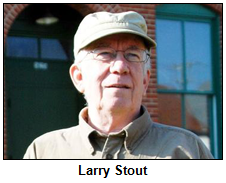 At Conner Prairie Interactive History Park, the Cedar Chapel Covered Bridge was not originally in Hamilton County. Built in Dekalb County, it was moved to Conner Prairie in the 1970s.
At Conner Prairie Interactive History Park, the Cedar Chapel Covered Bridge was not originally in Hamilton County. Built in Dekalb County, it was moved to Conner Prairie in the 1970s.
According to Margaret, the restoration of Potter's Ford is "one of the true success stories of covered-bridge preservation."
She says Potter's Ford, which originally opened in 1871, now even has a sprinkler system to prevent arson and a coating of special paint to resist graffiti. Arson and graffiti have plagued other covered bridges across the state.
Roadtrip: Sandhill Cranes at Jasper-Pulaski Fish & Wildlife Area
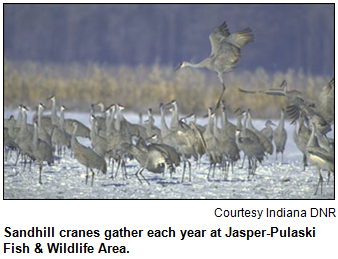 Glory-June Grieff and Eric Grayson report that the greatest spectacle in crane watching is going on right now at the Jasper-Pulaski Fish & Wildlife Area in northwest Indiana near the town of Rensselaer. There's a viewing platform at the edge of Goose Meadow in the wildlife area where on a good late afternoon you may see 15 to 20 thousand of these fascinating birds gabbling away and dancing as a part of their fall migration routine.
Glory-June Grieff and Eric Grayson report that the greatest spectacle in crane watching is going on right now at the Jasper-Pulaski Fish & Wildlife Area in northwest Indiana near the town of Rensselaer. There's a viewing platform at the edge of Goose Meadow in the wildlife area where on a good late afternoon you may see 15 to 20 thousand of these fascinating birds gabbling away and dancing as a part of their fall migration routine.
Glory also says, "Seeing them come in from all directions with their distinct bugling call is a sight - and sound - not to be forgotten."
Try to arrive at least a half-hour before sunset. This gathering takes place at sunrise as well, but then you'd miss the chance to eat at the Whistle Stop several miles south on US 421 (a little north of Monon), where the food is great and the experience heightened by no fewer than four electric trains running on overhead tracks. Allow time for the adjacent train museum, the Monon Connection.
Tell them you were sent by Hoosier History Live!
Enjoy 'encore' return of Tee Pee and other drive-ins
(Nov. 10, 2012) - Note: Because of WICR-FM's live coverage of University of Indianapolis football, Hoosier History Live! was pre-empted on the air for this date. As a treat for our listeners, though, we are offering an encore broadcast of one of the most popular shows in our archives.
The show (original air date: Nov. 27, 2011) explores the distinctive-looking Tee Pee Restaurant in Indianapolis, a favorite hang-out during the "cruising" craze of the 1950s, as well as other drive-ins, bygone and surviving. Nelson is joined in studio by two enthusiasts of the eateries. 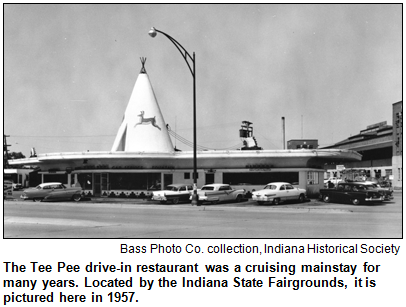 His guests are public historian and preservationist Glory-June Greiff and retired WRTV-Channel 6 cameraman Dick Baldwin, one of the Tee Pee's most loyal customers.
His guests are public historian and preservationist Glory-June Greiff and retired WRTV-Channel 6 cameraman Dick Baldwin, one of the Tee Pee's most loyal customers.
Actually, the Hoosier capital spawned two Tee Pees. The first, which opened in the 1930s and initially was called the Wigwam, enjoyed a high-visibility site next to the Indiana State Fairgrounds off busy Fall Creek Parkway. Years later, a second Tee Pee opened on the Southside.
Glory-June spearheaded a much-publicized (but, alas, unsuccessful) crusade to save the first Tee Pee from the wrecking ball in the 1980s. Its site is now overflow parking for the fairgrounds.
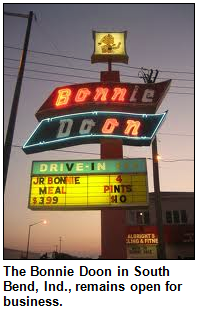 Although the Tee Pee was the favorite drive-in of Dick, our other guest, he also patronized the bygone Pole, a popular drive-in at Lafayette Road and West 16th Street in Indy.
Although the Tee Pee was the favorite drive-in of Dick, our other guest, he also patronized the bygone Pole, a popular drive-in at Lafayette Road and West 16th Street in Indy.
During the show, Glory, who grew up in northern Indiana, dishes about Bonnie Doon Drive-Ins in South Bend and Mishawaka. Some Bonnie Doon locations continue to thrive today.
Nelson shares insights about the bygone Knobby's Restaurants in Indy, popular drive-ins patronized by his family during the 1960s and '70s.
According to The American Drive-In (Motorbooks International, 1994) by Michael Witzel, many of the beloved restaurants were once settings for "some of the most enjoyable diversions" for young people and families alike.  They suffered an "astonishingly sudden fall from grace," Witzel writes, because of the booming popularity of fast-food chains, particularly when drive-through windows became common.
They suffered an "astonishingly sudden fall from grace," Witzel writes, because of the booming popularity of fast-food chains, particularly when drive-through windows became common.
"Waiting for a carhop to serve a meal and remove the dishes became a luxury of another era," Witzel notes.
Even so, the Mug n Bun on the westside of Indy and The Suds Drive-In in Greenwood (which opened as the Dog n' Suds in 1957) are still going strong amid so many drive-in casualties. So is Don Hall's Hollywood Drive-In in Fort Wayne. Its promotions assure customers "the fabulous '50s will live on forever" there.
Not only do Nelson and his guests share insights about those eateries, they explore the bygone Ron-D-Vu near the Butler University campus, the North Pole at Illinois and 56th streets, and Al Green's Famous Food Drive-In on the eastside.
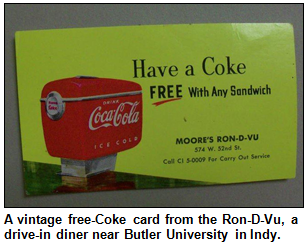 Although the Tee Pees were known as a hub for cruising and for fare such as Big Chief burgers, our guest Dick Baldwin, a member of Tech High School's class of '54, says many folks have forgotten that "wonderful" prawns and a special salad dressing also were served. During our show, Glory reveals which current restaurant in Indy continues to serve salads with the Tee Pee's special dressing.
Although the Tee Pees were known as a hub for cruising and for fare such as Big Chief burgers, our guest Dick Baldwin, a member of Tech High School's class of '54, says many folks have forgotten that "wonderful" prawns and a special salad dressing also were served. During our show, Glory reveals which current restaurant in Indy continues to serve salads with the Tee Pee's special dressing.
She also reflects on her crusade to save the cherished Tee Pee, which was patronized for decades by high school and college students. She practically stood in front of bulldozers to try to stop the demolition of the northside landmark.
The southside Tee Pee, which was located on Madison Avenue, also has been torn down.
But we invite you to tune in to our "encore" show and savor, once again, the culture of cruising and the drive-ins that served as its epicenter.
Roadtrip: International Festival, and 'still-around' Indiana drive-ins
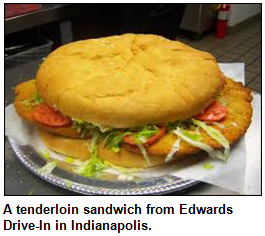 The International Festival, in its 36th year, will be at the Indiana State Fairgrounds on Nov. 16-18. This year the festival will feature a traditional Punch and Judy show, a Celtic heritage night with the Indy Ceili Band and the Richens-Timm Irish Dancers, and the world-renowned Polish dance ensemble Polonia. You also can watch hundreds of immigrants become U.S. citizens at the Naturalization Ceremony on Friday, Nov. 16, at 3 p.m.
The International Festival, in its 36th year, will be at the Indiana State Fairgrounds on Nov. 16-18. This year the festival will feature a traditional Punch and Judy show, a Celtic heritage night with the Indy Ceili Band and the Richens-Timm Irish Dancers, and the world-renowned Polish dance ensemble Polonia. You also can watch hundreds of immigrants become U.S. citizens at the Naturalization Ceremony on Friday, Nov. 16, at 3 p.m.
Also, we thought we'd let you know about drive-ins around Indiana that are still in operation. Getting a mention on the show were Don Hall's Hollywood Drive-In in Fort Wayne, The Lemon Drop in Anderson, The Flagpole in Rochester, Bonnie Doon in Mishawaka, Edwards in Indianapolis at Raymond and Sherman, Mug n Bun in Speedway, and The Suds in Greenwood, complete with active Hot Rod Club.
Check before cruising to these venerable establishments to see if they are open in winter. If you stop in, tell them you learned about them on Hoosier History Live! Here is also a list of Indiana drive-ins still in operation from Dine.com.
Fourth-anniversary celebration
An eclectic mix of 150 at soiree celebrate Hoosier History Live!
"I can't remember the last time I attended a party with such a terrifically eclectic group of people," said Billie Scott, longtime Indianapolis public relations exec.
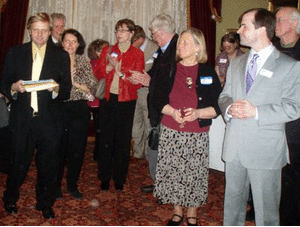 About 150 people crowded into the historic Morris-Butler house on the evening of Feb. 16. The fourth-anniversary party for Hoosier History Live! was graciously hosted for the fourth year in a row by Indiana Landmarks.
About 150 people crowded into the historic Morris-Butler house on the evening of Feb. 16. The fourth-anniversary party for Hoosier History Live! was graciously hosted for the fourth year in a row by Indiana Landmarks.
"We've gotten so crowded, it looks like we'll have to move the party next year to the Cook Theater!" said Indiana Landmarks CEO Marsh Davis.
Jo Ellen Meyers Sharp, the Hoosier Gardener, commented: "It was nice catching up at the party with Nelson Price, Molly Head, Richard Sullivan, Marsh Davis, Suzanne Stanis, Dick Cady, Eunice Trotter and many others at the 4th anniversary celebration of Hoosier History Live, a fab show on WICR-FM (88.7)."
Some of the party guests included:
- Mayor Greg Ballard of Indianapolis.
- Judy O'Bannon, former Indiana first lady.
- Mayor Wayne Seybold of Marion, former Olympic figure skater.
- Dan Wakefield, novelist-screenwriter.
- TV personality Cowboy Bob (Bob Glaze).
- TV personality Janie (Janie Hodge) of "Popeye and Janie" fame.
- Barbara Boyd, former WRTV/Channel 6 anchor.
- Reid Duffy, former WRTV/Channel 6 restaurant reviewer.
- Jim Lingenfelter, architect and president of the Indianapolis-Marion County Public Library Board.
- Dick Cady, Pulitzer-winning investigative reporter.
- Lawrence "Bo" Connor, former managing editor of The Indianapolis Star.
- Ralph Taylor, past president of the Indiana Basketball Hall of Fame board (and former outstanding Washington High School basketball player).
- Pat Garrett Rooney, civic leader.
- Phyllis Geeslin, director of the Benjamin Harrison Presidential Site.
- Jeff Miller, Indianapolis City-County Councilman.
- Steve Campbell, former deputy mayor of Indianapolis.
- Stephen Smith, Rhodes Scholar, retired partner, Barnes & Thornburg.
- Chris Worden, district director, Office of Congressman Andre Carson.
- Bill Briscoe, historian, Kurt Vonnegut Memorial Library.
The party was made possible not only by our friends at Indiana Landmarks, but also a host of other show supporters, including Pam Fraizer, Richard Sullivan, Bill Holmes, Garry Chilluffo, Michele Goodrich, Dana Waddell, Emily Kelso Barker and Jed Duvall. The birthday cake was personally provided by Maureen Dunlap, pastry chef at Divvy in Carmel. Shirley Judkins of "The Real Thing" provided piano accompaniment in the historic home's parlor.
The party invitation went out electronically to all of the subscribers to the Hoosier History Live! e-newsletter, so ... always be sure to check your inbox!
Street names in Indy + Trees, trees, trees
(Nov. 3, 2012 - encore presentation) - Ever wonder how streets throughout Indianapolis got their names? And why some have been changed over the years?
Prior to any streets, of course, there were towering trees on the site of the Hoosier capital, as well as across the state, most of which was a dense woodland forest. How has our tree canopy evolved, and what's the latest on an array of aspects about our towering friends?
These topics - Street names history in Indy and Trees, trees and trees - will be the focus of "encore" broadcasts of two popular Hoosier History Live! shows. Instead of a one-hour broadcast, you will be able to enjoy two back-to-back shows from our archives.
Street names history in Indy
For the first classic show (original air date: Oct. 15, 2011), which focuses on the heritage of street names, Nelson is joined in studio by two experts. They are historian Joan Hostetler, who initiated the crusade last year to keep the 190-year-old name on Georgia Street in downtown Indy, and Steve Campbell, a former Indy deputy mayor who has been working on a book about street names.
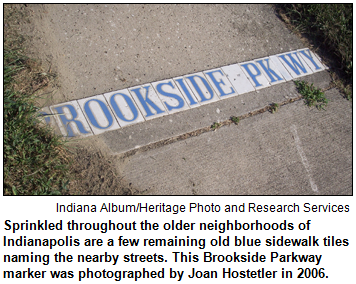 Some were changed because of landmarks such as the Indiana Statehouse. Its construction resulted in Tennessee Street being renamed Capitol Avenue in the 1890s, according to Joan. She is co-owner of Heritage Photo & Research Services, which specializes in local history research and preserving, digitizing and archiving historic photographs.
Some were changed because of landmarks such as the Indiana Statehouse. Its construction resulted in Tennessee Street being renamed Capitol Avenue in the 1890s, according to Joan. She is co-owner of Heritage Photo & Research Services, which specializes in local history research and preserving, digitizing and archiving historic photographs.
According to Steve, the founder of Campbell Strategies, an Indy-based consulting firm, the street naming process in Indy can be divided into two categories: Names in the "old city" (pre-Unigov city limits), and then names in the suburban neighborhoods that were developed later.
During the show, Steve explains that Hague Road on the far-northeast side was named after a farmer who owned large tracts of land in the area.
According to Joan, some street names were changed because of anti-German sentiment after World War I. They include two streets on the west side: Bismarck Avenue, which became Pershing Avenue, and Belleview Place, which once was called Germania.
In the 1890s, an African-American city councilman pushed to change the name of Mississippi Street. It was renamed Senate Avenue in 1895.
Tune in to our "encore" show to hear more insights about the naming - and re-naming - process involving Indy streets.
Trees, trees and trees
For the second classic show (original air date: Oct. 29, 2011), which focuses on all things trees, Nelson will be joined in studio by David Forsell, president of Keep Indianapolis Beautiful, Inc. During the show, David identifies the tree in Indy that he considers "the most beautiful tree I've ever seen."
 David and Nelson also share details about the city's oldest tree, a bur oak in Irvington that may be about 400 years old. David's organization, which is known as KIB and headquartered in a renovated warehouse in Fountain Square, has planted hundreds of trees in that neighborhood alone by partnering with various community groups. KIB has a goal of eventually planting 100,000 trees across Indy.
David and Nelson also share details about the city's oldest tree, a bur oak in Irvington that may be about 400 years old. David's organization, which is known as KIB and headquartered in a renovated warehouse in Fountain Square, has planted hundreds of trees in that neighborhood alone by partnering with various community groups. KIB has a goal of eventually planting 100,000 trees across Indy.
During the show, David shares details about how his volunteer-based organization decides where to plant trees - and which species to plant.
To top it off, David and Nelson share insights about Indiana's official state tree. It's the tulip tree, sometimes called the yellow poplar.
They also explore a tree native to Indiana that's praised for its fall coloration, the sugar maple. Its dense crowns are known for turning brilliant shades of orange and red.
Cafeterias across Indiana
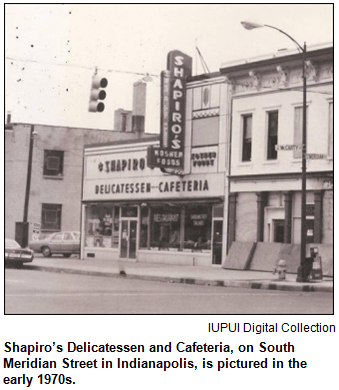 (Oct. 27, 2012) - As we enter the season known at least in part for its focus on food, Hoosier History Live! chows down. Rather than feast on Halloween candy or Thanksgiving turkey, though, we dig in to our state's cafeteria culture.
(Oct. 27, 2012) - As we enter the season known at least in part for its focus on food, Hoosier History Live! chows down. Rather than feast on Halloween candy or Thanksgiving turkey, though, we dig in to our state's cafeteria culture.
Unaware that Indiana was famous for its cafeterias?
Well, think how many have flourished for generations of hungry Hoosiers. Gray Brothers Cafeteria in Mooresville has received national acclaim for its fresh-made rolls, fried chicken and old-fashioned pies. Indiana-based MCL Cafeterias is described in Tray Chic: Celebrating Indiana's Cafeteria Culture (Emmis Books, 2004) as "arguably the largest family-owned cafeteria chain in the nation." Poe's Cafeteria in Martinsville is cherished by devotees of its persimmon pudding, gooseberry pie and other scrumptious fare.
And Shapiro's Delicatessen has been a landmark in downtown Indy for more than 100 years, although fourth-generation owner Brian Shapiro has been quoted as saying he dislikes the term "cafeteria."
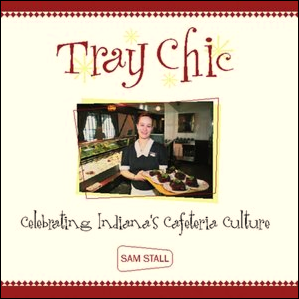 Even so, all of those beloved cafeterias (and a platter of others) are featured in Tray Chic, and its author is among Nelson's in-studio guests. He is Indianapolis-based writer Sam Stall, who also pens a question-and-answer column in Indianapolis Monthly magazine called "The Hoosierist". A native of Goshen, Sam is the author or co-author of about 20 books, many focusing on aspects of pop culture.
Even so, all of those beloved cafeterias (and a platter of others) are featured in Tray Chic, and its author is among Nelson's in-studio guests. He is Indianapolis-based writer Sam Stall, who also pens a question-and-answer column in Indianapolis Monthly magazine called "The Hoosierist". A native of Goshen, Sam is the author or co-author of about 20 books, many focusing on aspects of pop culture.
In addition to Sam, Nelson is joined on our exploration of cafeteria culture by a culinary queen who is well-known among Hoosier foodies. Daina Chamness of Greenwood has carved out a long career thanks to her work both in broadcasting and in the kitchen. Now known for her wine cake mixes, Daina formerly specialized in single-serving pies of all varieties.
Speaking of pies: As part of our cafeteria conversation, Nelson and his guests will discuss sugar cream pie, which was the focus of our show (with ever-delightful Daina as a guest) four years ago. At that point, legislators were debating whether to anoint sugar cream pie as Indiana's "official state pie". Not only did the lawmakers end up doing so by a vote of 99-to-1 (Nelson will share details), but sugar cream pie also is the official pie of the Indianapolis Colts.
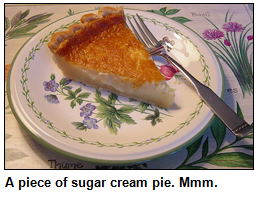 Sugar cream pie is relevant to our topic because Jonathan Byrd's in Greenwood and other cafeterias are among the few eateries that regularly serve it. (Sugar cream pie also was the focus of a "Hoosierist" column by Sam awhile back.) In Tray Chic, Sam describes the sprawling Jonathan Byrd's as the cafeteria version of an "epic, Cecil B. De Mille-style scale" production.
Sugar cream pie is relevant to our topic because Jonathan Byrd's in Greenwood and other cafeterias are among the few eateries that regularly serve it. (Sugar cream pie also was the focus of a "Hoosierist" column by Sam awhile back.) In Tray Chic, Sam describes the sprawling Jonathan Byrd's as the cafeteria version of an "epic, Cecil B. De Mille-style scale" production.
Noting that Hoosier cafeterias long have been hailed for their comfort food, Sam writes: "Some would say that the long view down the tray line is what heaven looks like."
According to Tray Chic, though, cafeterias are vanishing in many parts of the country.
"Today, they're as state-of-the-art as a brontosaurus, and almost as rare - unless you live in Indiana," Sam writes. In the Hoosier state, he explains, cafeterias are "culinary landmarks."
 The former Laughner's Cafeterias chain, which traced its beginnings to a storefront restaurant in 1900 in downtown Indy, opened the state's first cafeteria and was on the cutting edge then of "food service technology," according to Tray Chic.
The former Laughner's Cafeterias chain, which traced its beginnings to a storefront restaurant in 1900 in downtown Indy, opened the state's first cafeteria and was on the cutting edge then of "food service technology," according to Tray Chic.
Expansion of the Laughner's chain included the 1964 opening in Southern Plaza shopping center of a cafeteria in a structure that, as Tray Chic puts it, resembled a "big, Tudor-style house." In 1987, the chain opened a Laughner's Super Cafeteria on the far northside of Indy. After about 100 years in operation, though, the last Laughner's closed in 2000.
The MCL chain, however, has survived with signature fare, including cloverleaf rolls, carved roast beef, Swiss steak and Irani iced tea. According to Reid Duffy's Guide to Indiana's Favorite Restaurants(IU Press, 2006), the chain resulted from a business relationship between co-founder Charles McGaughey and George Laughner, a son of the Laughner's founder. (The "L" in MCL stands for Laughner.)
 By 2006, the MCL chain had more than 20 cafeterias, including restaurants in Anderson, Bloomington, Muncie, Richmond, Speedway, Terre Haute and West Lafayette.
By 2006, the MCL chain had more than 20 cafeterias, including restaurants in Anderson, Bloomington, Muncie, Richmond, Speedway, Terre Haute and West Lafayette.
In Mooresville, Gray Brothers seats 500 and often feeds 3,000 patrons per day, according to Tray Chic. With homemade dishes that have won praise from national food critics, Gray Brothers has been a landmark on State Road 67 since the late 1960s.
Shapiro's roots go back much farther. In 1905, two years after immigrating from Russia because of anti-Jewish pogroms, Louis and Rebecca Shapiro opened a kosher grocery shop on what's now the south side of downtown Indy, according to Reid Duffy's book. 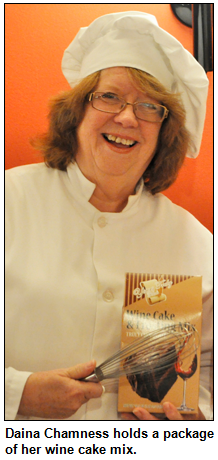 The transition to a restaurant - with cafeteria-style service lines - began in the 1930s when Louis delegated the store to his sons Abe, Izzy and Max.
The transition to a restaurant - with cafeteria-style service lines - began in the 1930s when Louis delegated the store to his sons Abe, Izzy and Max.
And about 120 years before that, hundreds of Quakers from North Carolina traveled to Indiana to settle. Our guest Daina Chamness noted during our previous show that sugar cream pie may have its origins in a dessert made by Quaker farm wives.
In any case, food historians say sugar cream pie became a favorite on Hoosier farms because its ingredients consisted of staples (including flour, cream and sugar) available year-round in farm kitchens. Wick’s Pies,, a multi-generational business in Winchester in far-eastern Indiana, is the country's largest maker of sugar cream pies.
Speaking of farms: In Tray Chic, Sam write that, for Hoosiers, cafeterias often conjure up "ancestral memories of old-fashioned farm dinners, or fond reflections of Sunday after-church suppers at Grandma's." Typically, he notes, cafeterias serve fried chicken, macaroni and cheese, pecan pies and "pretty much anything else that farm wives set out for their families 150 years ago."
Some fun facts:
- The word "cafeteria" is derived for a Spanish term for coffee shop, according to Tray Chic.
- According to Reid Duffy's book, Louis Shapiro's grandfather had been a primary food supplier for the czar of Russia's naval fleet.
- At Jonathan Byrd's in Greenwood, Sam Stall writes, the serving line is about as long as a tennis court.
Roadtrip: The Cabinet of Dr. Caligari
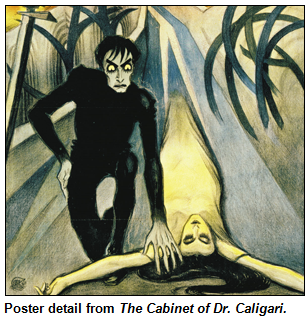 Roadtripper Chris Gahl of Visit Indy suggests that we scare ourselves with a couple of classic vintage film this Halloween night! The 1920s German Expressionist fright movie, The Cabinet of Dr. Caligari, will be screened at Indiana Landmarks Center at 1201 Central Ave. in Indianapolis from 7 to 9:30 p.m. on Halloween night, Wednesday, Oct. 31.
Roadtripper Chris Gahl of Visit Indy suggests that we scare ourselves with a couple of classic vintage film this Halloween night! The 1920s German Expressionist fright movie, The Cabinet of Dr. Caligari, will be screened at Indiana Landmarks Center at 1201 Central Ave. in Indianapolis from 7 to 9:30 p.m. on Halloween night, Wednesday, Oct. 31.
Also on the bill will be the 1921 Buster Keaton comedy The Haunted House. Film historian Eric Grayson will introduce the films.
As an added bonus, along with flashing lights, you'll hear the restored 1892 pipe organ in Cook Hall playing scary music to accompany the silent films with organist Mark Herman. Cree-ee-py! Cost is $10 for Indiana Landmarks members, $12 for non-members, and a cash bar will be available.
History Mystery
During the 1960s and '70s, a family-owned chain of restaurants flourished in the Indianapolis area. Frequently patronized by families with young children, the restaurants were not cafeterias. They specialized in char-broiled hamburgers, baked potatoes, tossed salads, steaks and other traditional American food.
Locations of the restaurants included 56th and Illinois streets, the Nora area and the Devington shopping center at East 46th and Arlington.
The chain, which also included a restaurant on East Washington Street, had a family-ownership relationship with an Indianapolis-founded drug store chain.
Question: What was the once-popular Indy-based restaurant chain?
This week's prize is a pair of tickets to the Indiana Experience at the Indiana History Center, and a gift certificate to Ram Restaurant and Brewery in downtown Indianapolis.
New time! ... Noon to 1 p.m. on Saturdays
Hoosier History Live! expands to one hour
The nation's only live with call-in talk radio show about history, Hoosier History Live! with Nelson Price, has expanded to a one-hour format and now is on the air at a new weekly time slot: noon to 1 p.m. on Saturdays.
The show will continue to be heard over the air at WICR 88.7 FM in the central Indiana area, or online anywhere at www.hoosierhistorylive.org.
We thank all of our sponsors and individual supporters who have helped us over the years. With so many forms of media disappearing or diminishing, and in particular locally focused content about history, we are pleased to still be around.
Landmarks and lyrics across Indiana
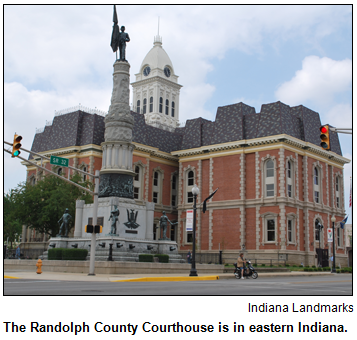 (Oct. 20, 2012) - A beloved, now-vacant diner in Plainfield, a vaudeville theater in Vincennes and the historic Colgate Palmolive plant and clock near Jeffersonville are among nearly two dozen landmarks across Indiana that have become the muse for Hoosier poets.
(Oct. 20, 2012) - A beloved, now-vacant diner in Plainfield, a vaudeville theater in Vincennes and the historic Colgate Palmolive plant and clock near Jeffersonville are among nearly two dozen landmarks across Indiana that have become the muse for Hoosier poets.
How can you wax poetic about the Plainfield Diner, which was placed a few years ago on the "10 Most Endangered Places" list by Indiana Landmarks, the historic preservation organization? Well, four members of Brick Street Poetry, inspired by the diner and other landmarks, join us to share insights about the well-known sites - and a sampling of the poetry that has resulted.
Our guests include Joyce Brinkman, Indiana's former poet laureate. Although she lives in Indianapolis today, Joyce grew up along the Ohio River and has chosen to write about the Colgate Palmolive plant, which opened in 1924, and its clock, which is the largest in the state and visible for miles. She is a board member of Brick Street Poetry, a statewide group based in Zionsville that publishes the Tipton Poetry Journal and hosts a monthly reading series, Poetry on Brick Street.
Also as part of "Landmark Lyrics", a partnership between Indiana Landmarks and Brick Street, award-winning poet J.L. Kato of Beech Grove has written about the Plainfield Diner on the National Road/U.S. 40. 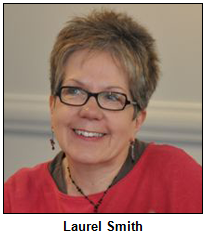 Considered a rare surviving example in the Hoosier state of the Streamline Moderne style, the Plainfield Diner opened in 1954, still has its original interior and inspired a Facebook crusade to spare it from possible demolition.
Considered a rare surviving example in the Hoosier state of the Streamline Moderne style, the Plainfield Diner opened in 1954, still has its original interior and inspired a Facebook crusade to spare it from possible demolition.
Hoosier History Live! focused on the Plainfield Diner's fate - which remains uncertain - during a "Diners Across Indiana" (click to read that show's enewsletter) show in 2010. 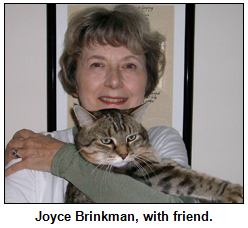 J.L. Kato, who joins Nelson and Joyce in studio, says he drew on boyhood memories of learning to drink coffee in a diner for his poem, "Coffee, High and Dry", which uses diner and trucker lingo.
J.L. Kato, who joins Nelson and Joyce in studio, says he drew on boyhood memories of learning to drink coffee in a diner for his poem, "Coffee, High and Dry", which uses diner and trucker lingo.
Nelson's guests also include Laurel Smith, an English professor at Vincennes University who has written a poem about the Pantheon Theatre, which is on the current "10 Most Endangered" list. Built from 1919 through 1921, the theater hosted vaudeville shows, early performances by Vincennes native Red Skelton and touring theatrical productions. According to Indiana Landmarks, the now-vacant theater is deteriorating to such an extent its decorative interior is threatened - and the historic theater could be auctioned at a tax sale.
Laurel says her poem inspired by the Pantheon, Talking Snapshots, is intended "to suggest the spirit of a family scrapbook; in this case, the family is the whole community."
 Landmark Lyrics also includes a poem about the Randolph County Courthouse in far-eastern Indiana. The historic courthouse is the subject of a poem by Ben "Kahlil" Rose, a photographer and filmmaker who grew up in Tipton County. Ben, the first African-American graduate of Tipton High School, is working on a documentary about the history of black farming settlements in Indiana. Ben says he was intrigued by Randolph County because of its early, significant African-American farming community.
Landmark Lyrics also includes a poem about the Randolph County Courthouse in far-eastern Indiana. The historic courthouse is the subject of a poem by Ben "Kahlil" Rose, a photographer and filmmaker who grew up in Tipton County. Ben, the first African-American graduate of Tipton High School, is working on a documentary about the history of black farming settlements in Indiana. Ben says he was intrigued by Randolph County because of its early, significant African-American farming community.
Built in the 1870s, the Randolph County Courthouse in Winchester has drawn widespread attention in recent years because of a crusade to save it by local "calendar girls." Members of a bridge-playing club (some in their 80s and 90s) who were aghast at a plan to demolish the courthouse, the women disrobed to pose for a calendar that was sold to help fund its renovation.  Ben's poem about the courthouse is titled For Old Time's Sake.
Ben's poem about the courthouse is titled For Old Time's Sake.
Other landmarks that are the subjects of Landmark Lyrics poetry include the spectacularly restored Lerner Theatre in Elkhart; Beck's Mill in Salem; the Frankfort Roundhouse, a vacant turn-around terminal for trains in Frankfort; the Greyhound Station, a former bus terminal in Evansville, and Lyles Station, a historic African-American settlement in Princeton.
The partnership between Brick Street Poetry and Indiana Landmarks culminate Nov. 15 at 7 p.m. with a visual presentation and poetry reading at Indiana Landmarks Center, 1201 Central Ave. in Indianapolis. After the free program, a selection of the visuals and poetry will be published in the Tipton Poetry Journal.
The Colgate Palmolive plant, the focus of Joyce Brinkman's poem, opened in a former reformatory.  According to Indiana Landmarks, a former cell block became the Laundry Soap Building for the Colgate complex, which manufactured soap and toiletries. (The former warden's house became the recreation building for the plant's workers, who numbered 1,500 at the factory's peak.)
According to Indiana Landmarks, a former cell block became the Laundry Soap Building for the Colgate complex, which manufactured soap and toiletries. (The former warden's house became the recreation building for the plant's workers, who numbered 1,500 at the factory's peak.)
The massive Colgate Clock originally was located atop a Colgate factory in New Jersey. The clock was moved to Jeffersonville in 1924 and faces Louisville, Ky., across the Ohio River.
In Vincennes, the Pantheon Theatre, the subject of Laurel Smith's poem, also has a rich history. In addition to Skelton, entertainers and musicians who performed in the historic theater included W.C. Fields, Duke Ellington, Sally Rand and Will Rogers.
"Like many small communities, we are constantly challenged in Vincennes to balance historical preservation with modern development to meet the needs of people who live here," Laurel notes. Of several current suggestions for re-use of the once-glorious Pantheon, Laurel has a favorite idea. Nelson will ask her to share details during the radio show.
More about our four poet guests:
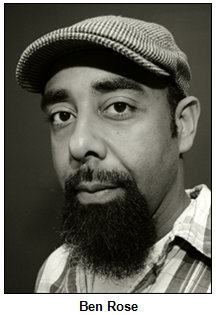 Laurel Smith currently is serving as the chair of the English department at Vincennes University. Her poetry has appeared in several publications, including the book And Know this Place: Poetry of Indiana (Indiana Historical Society Press, 2011). She also is the co-author of Early Works by Modern Women Writers: Woolf, Bowen, Mansfield, Cauther and Stein (Mellen, 2006).
Laurel Smith currently is serving as the chair of the English department at Vincennes University. Her poetry has appeared in several publications, including the book And Know this Place: Poetry of Indiana (Indiana Historical Society Press, 2011). She also is the co-author of Early Works by Modern Women Writers: Woolf, Bowen, Mansfield, Cauther and Stein (Mellen, 2006).- Joyce Brinkman is well-known for creating collaborative poetry projects with visual artists and various organizations and businesses. Her poetry is featured on a 25-foot-high stained glass window by British glass artist Martin Donlin at the Indianapolis International Airport; in lighted glass at the Indianapolis Public Library's Central Library and on an artists' wall in El Salvador. Her published works include two chapbooks, Tiempo Espanol and Nine Poems in Form Nine.
- A native of Japan, J.L. Kato has spent most of his life in Indiana. He describes his immigrant experience in Shadows Set in Concrete, which won the 2011 Best Book of Indiana Award for poetry.
- In addition to poetry, photography and filmmaking, Ben "Kahlil" Rose has been active in theater and is the father of four children. His multi-media work can be viewed at theidentitycomplex.com
History Mystery
The two dozen or so historic structures that are the focus of the "Landmarks Lyrics" collaboration between Brick Street Poetry and Indiana Landmarks include Bush Stadium, the home of the Indianapolis Indians until the opening of the $20 million Victory Field in 1996.
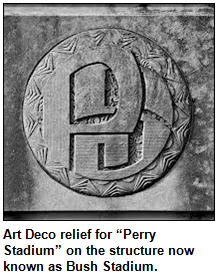 The baseball team had played its first game in Bush, then known as Perry Stadium, in 1931. The sports facility on West 16th Street was renamed Bush Stadium in 1967 in honor of Owen Bush, a former manager of the team.
The baseball team had played its first game in Bush, then known as Perry Stadium, in 1931. The sports facility on West 16th Street was renamed Bush Stadium in 1967 in honor of Owen Bush, a former manager of the team.
However, in between the Perry and Bush eras and beginning during World War II, the stadium was known by another name.
Question: What was it?
This week's prize is a pair of tickets to Conner Prairie, courtesy of Conner Prairie, and a gift certificate to Iron Skillet Restaurant on West 30th Street in Indianapolis, courtesy of Visit Indy.
Roadtrip: Indianapolis Pop-Up Modern Tour
Move over, Columbus, Indiana. Roadtripper Chris Gahl of Visit Indy tells us that downtown Indy will show off its modern architectural marvels with a free tour this Saturday, Oct. 20, from 2 to 5 p.m. The Pop Up Mod Tour begins on the southeast quadrant of Monument Circle, starting with a discussion of the c. 1970 landscape installation on the Circle.
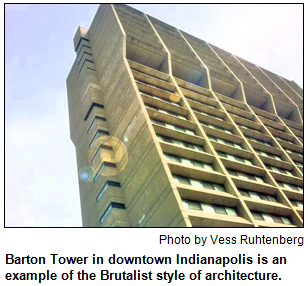 You'll also see the 1970 American Fletcher National Bank (now Chase), the 1962 City-County Building, which replaced the historic county courthouse and came to symbolize the unification of city and county governments, and the 1975 Minton-Capehart Federal Building, complete with a recently restored Milton Glaser mural.
You'll also see the 1970 American Fletcher National Bank (now Chase), the 1962 City-County Building, which replaced the historic county courthouse and came to symbolize the unification of city and county governments, and the 1975 Minton-Capehart Federal Building, complete with a recently restored Milton Glaser mural.
Also on the tour is the James Whitcomb Riley Center (a residential complex now known as Riley Towers, completed in 1963), which was designed by the well-known Chicago firm of Perkins + Will.
Your last stop is Massachusetts Avenue to learn about Barton Tower; it was designed by Evans Woollen and Associates and was completed in 1968.
You also can take the tour in any order; just look for a vested docent outside each location. And you can download a tour map here. This Roadtrip was recommended by modern enthusiast (and two-time Hoosier History Live! guest) Connie Zeigler.
If a town is on the state map, he's been there
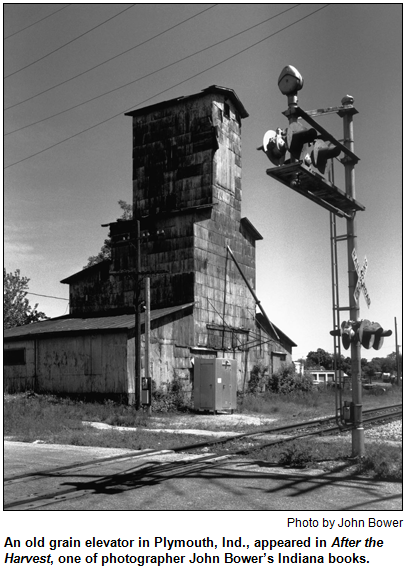 (Oct. 13, 2012) - On state maps of Indiana, there are about 2,099 cities and towns, according to a count by John Bower, an award-winning photographer.
(Oct. 13, 2012) - On state maps of Indiana, there are about 2,099 cities and towns, according to a count by John Bower, an award-winning photographer.
He has counted them because John, who specializes in black-and-white photography, has an unusual distinction: He has visited every city and town. With his artist wife Lynn, he owns Studio Indiana near Bloomington, the base for their travels.
His photos - which often, as he puts it, depict "the ignored, forgotten or cast aside" - have been collected in several books, each with a different focus.
Nearly two years ago, John was Nelson's guest to share insights and anecdotes from his journeys. They have included stops to photograph courthouse attics, barn roofs with advertising, historic jails, monasteries, abandoned lodges and houses of worship in cities like South Bend in northern Indiana, as well as towns like Vevay on the Ohio River.
Now John returns to share more stories, which he and Lynn (who often writes the text) recount in photo books such as The Common Good (2010). Not only does that book include photos of historic jails in Nashville and Vevay, it includes a close-up image of "Old Sparky," a onetime electric chair at the Indiana State Prison in Michigan City.
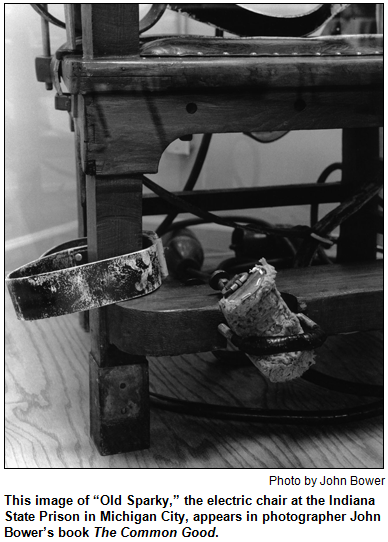 "It was constructed of worn, dark wood that had been carefully crafted, with dovetail joints used in some places," John writes. "A small sign explained that the wood had been salvaged from Indiana's old gallows. ... Overall, it was an eerie combination of antique, mundane and grisly."
"It was constructed of worn, dark wood that had been carefully crafted, with dovetail joints used in some places," John writes. "A small sign explained that the wood had been salvaged from Indiana's old gallows. ... Overall, it was an eerie combination of antique, mundane and grisly."
Other photos are evocative for far different reasons. His book 2nd Stories (2005), which explores "what's upstairs, on top and overhead," includes photos of the attics in the Hancock County Courthouse in Greenfield and the Monroe County Courthouse in Bloomington.
It also features several photos of the the Monastery Immaculate Conception in Ferdinand, known as the "Castle on the Hill." Built between 1915 and 1924 (work was suspended during World War I) and listed on the National Register of Historic Places, the monastery is the home of the Sisters of St. Benedict. John and Lynn Bower visited during an extensive renovation designed to give the monastery, as a nun explained to them, a "feminine feel."
He also photographed an abandoned synagogue in South Bend that was built in 1901, as well as a massive vacant Knights of the Pythias Lodge in Shelbyville. (Its first floor once had been occupied by a Murphy's Dime Store.) John and Lynn were struck by the "once majestic" Lodge Ballroom on an upper floor.
"While our society values the newest, the costliest and the flashiest, I'm motivated to rediscover that which has been ignored, forgotten or cast aside," John says. "By using the inherent drama of black-and-white photography, I'm able to capture the essence - the élan vital - of these subjects."
 John and Lynn Bower will celebrate their 40th wedding anniversary next month. The couple met when they were teachers in Kendallville. After school, they often would hop into a car and travel an unfamiliar route.
John and Lynn Bower will celebrate their 40th wedding anniversary next month. The couple met when they were teachers in Kendallville. After school, they often would hop into a car and travel an unfamiliar route.
On their journeys, John has taken photos of barns with "billboard" advertising on their roofs in Orange County and Martin County. And his book After the Harvest (2007) focuses on historic grain elevators and feed mills.
Some notes from their journeys:
- In Cloverdale, John photographed a historic retail shop described as "the oldest continually operating hardware store in Indiana." Founded in 1887, the Cloverdale Hardware Store is featured in 2nd Stories.
- According to The Common Good, the historic electric chair at the Indiana State Prison was used 62 times to administer the death penalty, beginning in 1914. Last used in 1994, the chair is a museum piece and today sits in the prison's Indiana Room.
- In addition to feed mills, After the Harvest features photos of their "ancestors": grist mills. According to the book, Indiana had more than 700 grist mills in 1860. The Bowers call them a "powerful civilizing force" because grinding grain was so important to early Hoosiers that trails were created between farms and the mills. Then pioneers began forming towns near the grist mills.
History Mystery
In his travels around the Hoosier state, John Bower of Studio Indiana has taken countless photos of distinctive barns. For many decades, Indiana had more of one kind of barn - round barns - than any other state. In fact, one of Indiana's 92 counties promoted itself as the "Round Barn Capital of the World."
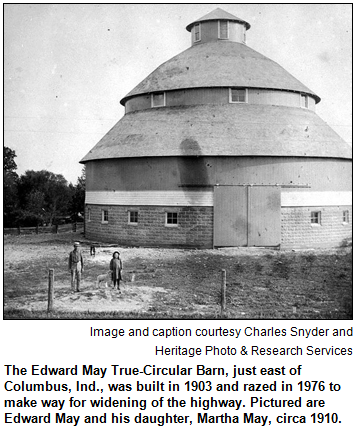 Round barns were said to be efficient in many ways, including saving farmers steps when feeding their livestock because all of the animals faced the same direction.
Round barns were said to be efficient in many ways, including saving farmers steps when feeding their livestock because all of the animals faced the same direction.
However, round barns fell out of favor for several reasons, including the inability of modern tractors and agricultural machinery to fit through their doors. In Indiana, the last round barn apparently was built in 1936.
Even so, they still are celebrated in the county known as the "Round Barn Capital of the World."
Question: What is the Indiana county?
Hint: It is not the county where the Edward May barn (pictured) was located.
This week's prize is a gift certificate for a 10-pack of tickets to Heartland Film Festival, courtesy of Heartland, and a pair of tickets to a public tour of Crown Hill Cemetery, given by the Crown Hill Heritage Foundation, courtesy of Visit Indy.
Roadtrip: Parke County Covered Bridge Fest through Oct. 21
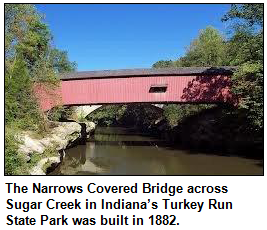 Roadtripper Chris Gahl of Visit Indy suggests that we head west from Indianapolis to the always fabulous fall foliage on display at the Parke County Covered Bridge Festival, which is going on now and runs through Oct. 21. With a total of 31 covered bridges, Parke County promotes itself as the "Covered Bridge Capital of the World".
Roadtripper Chris Gahl of Visit Indy suggests that we head west from Indianapolis to the always fabulous fall foliage on display at the Parke County Covered Bridge Festival, which is going on now and runs through Oct. 21. With a total of 31 covered bridges, Parke County promotes itself as the "Covered Bridge Capital of the World".
This countywide festival first started in 1957 and is headquartered around the courthouse lawn in Rockville. You'll find plenty of food booths, crafters and antiques around the courthouse square, as well as maps for self-guided tours throughout the county to check out all those great bridges and little towns!
Don't want to drive or bike yourself? Bus tours leave the courthouse lawn daily during the festival at 10:45 a.m. and 2:15 p.m. ET. All tickets are $15 per person, and tours will travel to either the northwest or southwest part of the county. Bus-tour information is at (765) 569-5226, or email info@coveredbridges.com to reserve your seat.
Hollywood icons Red Skelton, Robert Wise and Irene Dunne
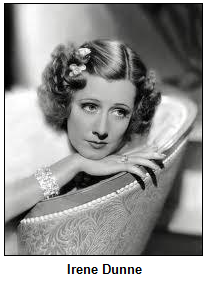 (Oct. 6, 2012) - Aside from being icons of Hollywood with links to Indiana, what could three luminaries - comedian Red Skelton, acclaimed director Robert Wise(The Sound of Music and West Side Story) and 1930s and '40s movie star Irene Dunne - have in common?
(Oct. 6, 2012) - Aside from being icons of Hollywood with links to Indiana, what could three luminaries - comedian Red Skelton, acclaimed director Robert Wise(The Sound of Music and West Side Story) and 1930s and '40s movie star Irene Dunne - have in common?
All three are the subjects of biographies written by movie historian Wes Gehring, a film professor at Ball State University who will be Nelson's guest. Wes' newest book is the just-released Robert Wise Shadowlands (Indiana Historical Society Press), a biography of the Academy Award-winning director who was born in Winchester and grew up in Connersville.
With Wes in studio, not only do we focus on the life and career of Robert Wise (1914-2005), we also explore the Hoosier roots and careers of Red Skelton, a native of Vincennes, and Irene Dunne, who grew up in Madison.
Wes delved into their lives in Red Skelton: The Mask Behind the Mask (IHS Press, 2008), which explores, as Wes puts it, the comedian's "hardscrabble beginnings with a shockingly dysfunctional family in southern Indiana" and Irene Dunne: First Lady of Hollywood (Scarecrow Press, 2003). 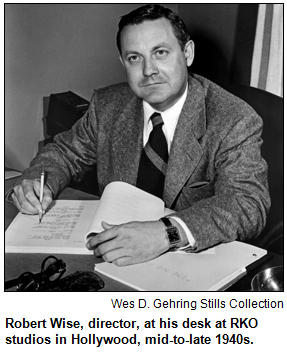 It's a look at the versatile actress, who won critical acclaim for her roles in genres ranging from musicals like Show Boat (1936) to comedies (including The Awful Truth in 1937 with Cary Grant) and dramas such as I Remember Mama (1948).
It's a look at the versatile actress, who won critical acclaim for her roles in genres ranging from musicals like Show Boat (1936) to comedies (including The Awful Truth in 1937 with Cary Grant) and dramas such as I Remember Mama (1948).
Like Irene Dunne (1898-1990), Robert Wise was known for astonishing versatility, directing movies ranging from the science fiction cult classic The Day the Earth Stood Still (1951) and the horror movie The Haunting (1963), which is set in a spooky New England mansion, to the two musicals for which Wise won Oscars as Best Director, The Sound of Music (1965) and West Side Story (1961).
In fact, many film historians contend Wise's versatility explains why he never quite became a household name like fellow directors Alfred Hitchcock and Steven Spielberg, who are associated with specific genres.
Certainly Red Skelton (1913-1997) became a household name, achieving major stardom in movies, TV, radio and on Broadway after getting his start in vaudeville shows and, before that, in burlesque.
On his enormously popular TV series, which enjoyed a run of nearly 20 years (1951-1971), Skelton delighted audiences with the antics of characters such as Clem Kadiddlehopper, a confused bumpkin, and Freddie the Freeloader, a hobo who never spoke.
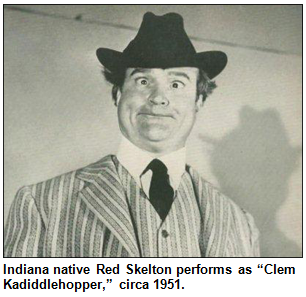 Like Freddie, Skelton endured dire poverty. As Wes recounts in his biography, Skelton, the youngest of four brothers, was born two months after the death of his father. Years later, Skelton claimed his father had been a circus clown, but Wes disputes that with extensive research indicating the elder Skelton was an alcoholic grocer in Vincennes.
Like Freddie, Skelton endured dire poverty. As Wes recounts in his biography, Skelton, the youngest of four brothers, was born two months after the death of his father. Years later, Skelton claimed his father had been a circus clown, but Wes disputes that with extensive research indicating the elder Skelton was an alcoholic grocer in Vincennes.
Although Red (real name: Richard) Skelton worked his way up to stardom, he continued to cope with, as Wes puts it, a "sometimes tragic personal life" that included three marriages, the death of his 9-year-old son from leukemia in 1958, the suicide of his second wife and his lingering bitterness at the entertainment industry after the cancellation of his TV series.
Robert Wise and Irene Dunne had more stable personal lives, although her father, a steam vessel supervisor, also died when she was a child. She had been born in Louisville, Ky., but moved with her widowed mother to Madison. In the Ohio River town, she attended St. Michael's Catholic Church, graduated from Madison High School and sang at civic gatherings.
Her talent resulted in a scholarship to study music at a conservatory in Indianapolis; eventually, she landed roles in touring stage shows.
 At Connersville High School, the auditorium has been renamed in Wise's honor. In his biography of the filmmaker, Wes quotes from columns (titled "Wise Crax") he wrote for the high school newspaper.
At Connersville High School, the auditorium has been renamed in Wise's honor. In his biography of the filmmaker, Wes quotes from columns (titled "Wise Crax") he wrote for the high school newspaper.
After graduation, Wise attended Franklin College. Short of money, he left school during the Depression and followed an older brother to Hollywood. One of his big breaks involved working as a film editor for Orson Welles on the classic Citizen Kane (1941).
Long before The Haunting, Wise had experience directing horror and thriller movies. His credits included The Cure of the Cat People (1944) and The Body Snatcher (1945) with Bela Lugosi and Boris Karloff.
Some fun facts:
- Irene Dunne was nominated five times for an Academy Award but never won. She also served one term as a delegate to the United Nations. According to Wes' biography, she called her appointment to the U.N. in 1957 by President Eisenhower "the highlight of my life."
- During Robert Wise's boyhood in the 1920s, his father ran a meat-packing plant in Connersville. Dazzled by silent movies, young Robert often saw three per week at the town's three theaters, which all were in walking distance of the family's home, according to Robert Wise Shadowlands.
- In Vincennes, Skelton, a poor student, dropped out of school when he was about 13. His gigs included touring with traveling medicine shows that sold "magic" bottles of elixir.
After years of pratfalls in his famous slapstick routines, Skelton needed to wear leg braces, although he concealed that from his fans.
History Mystery
In 1966, Robert Wise directed an epic movie that starred an actor who, like the director, was an Indiana native. Set in China during the 1920s, the critically acclaimed movie had an antiwar theme and a running time of about three hours; it was filmed on location in Asia. 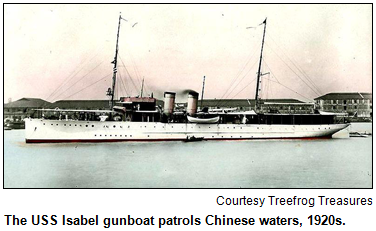 For his leading role as a machinist in the U.S. Navy on a gunboat, the Hoosier-born actor earned his only Academy Award nomination; he did not go on to win the Oscar.
For his leading role as a machinist in the U.S. Navy on a gunboat, the Hoosier-born actor earned his only Academy Award nomination; he did not go on to win the Oscar.
Question: Name the Indiana-born actor and the epic movie in 1966 in which he starred that Robert Wise directed.
This week's prize is a gift certificate to Dave and Buster's restaurant in Castleton in Indianapolis and a pair of tickets to a public tour of Crown Hill Cemetery, given by the Crown Hill Heritage Foundation. These prizes are courtesy of Visit Indy.
Roadtrip: Heartland Film Festival Oct. 18-27
Our charismatic Roadtripper, Chris Gahl of Visit Indy, returns to our airwaves this week to remind us that one of Indy's premier events, the Heartland Film Festival, is just around the corner, October 18-27.
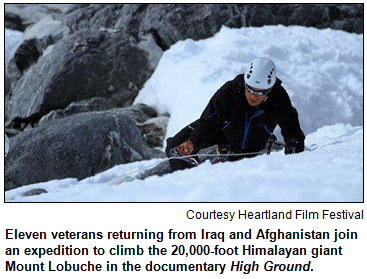 A little "history" ... In 1991 a group of Indianapolis film lovers united to create a unique film festival to honor beautifully made films that celebrate the positive aspects of life. The Heartland Film Festival started in 1992 as a small event in Indianapolis and has expanded over time to become one of the fastest-growing film festivals in the country.
A little "history" ... In 1991 a group of Indianapolis film lovers united to create a unique film festival to honor beautifully made films that celebrate the positive aspects of life. The Heartland Film Festival started in 1992 as a small event in Indianapolis and has expanded over time to become one of the fastest-growing film festivals in the country.
Today, the annual film festival is a 10-day event full of independent films and a variety of special events for film enthusiasts of all ages.
This year's movies will screen at AMC Showplace Traders Point 12 and AMC Castleton Square 14. Opening night is Thursday night, Oct. 18, at 7:30 p.m. at the Indianapolis Museum of Art for a screening of High Ground.
Admission is free, and popcorn, beer, soda and wine are available for purchase. Tickets for all events may be purchased online at Heartland Film Festival.
Ancient people here - and agricultural beginnings in Indiana
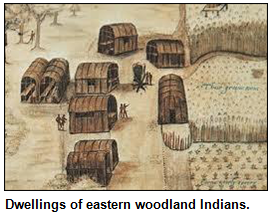 (Sept. 29, 2012) - With our expanded, one-hour format, we can dig deeper (pardon the pun; the guest will be an archaeologist) with topics that have sparked great interest from listeners. So we are going to explore more aspects of the so-called "Very First Hoosiers," or ancient people who lived more than 10,000 years ago in the densely wooded forests that became the site of Indiana.
(Sept. 29, 2012) - With our expanded, one-hour format, we can dig deeper (pardon the pun; the guest will be an archaeologist) with topics that have sparked great interest from listeners. So we are going to explore more aspects of the so-called "Very First Hoosiers," or ancient people who lived more than 10,000 years ago in the densely wooded forests that became the site of Indiana.
Dr. Christopher Schmidt, an archaeologist, biological anthropologist and popular University of Indianapolis faculty member, returns to share insights about these early residents - as well as fresh insights about the beginnings of agriculture.
Chris, the director of the Indiana Prehistory Laboratory at UIndy, has overseen excavations across Indiana and is credited with discovering the oldest known man-made tool in Hoosier soil. Created from the leg bone of a white-tailed deer, the tool is an awl (used for making clothes) discovered during a dig near the town of Flora in Carroll County.
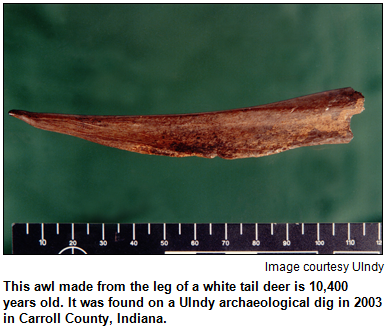 Chris discussed the tool, which is 10,400 years old, and other aspects of the "Very First Hoosiers" when he was Nelson's studio guest in June.
Chris discussed the tool, which is 10,400 years old, and other aspects of the "Very First Hoosiers" when he was Nelson's studio guest in June.
Now he returns to share more details about the ancient Hoosiers, as well as the animal and plant life that surrounded them. Chris describes the ancient people of nearly 11,000 years ago as hunter-gatherers who ate both meat and plants.
As centuries passed, the people began to develop agriculture, a move that, according to Chris, also meant an increase in various diseases. He plans to share insights about the correlation as well as about the origin of maize in Indiana.
During our show in June, Nelson asked Chris about the relationship between the ancient people and Native Americans.
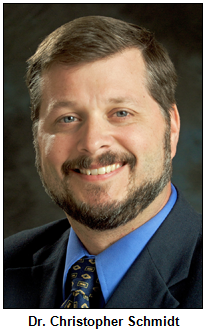 "They were Native Americans - not culturally, but biologically," Chris replied. Their ancestors are believed to have traveled from the Bering Straits to North America, then dispersed.
"They were Native Americans - not culturally, but biologically," Chris replied. Their ancestors are believed to have traveled from the Bering Straits to North America, then dispersed.
Although ancient people had arrived in the future site of Indiana more than 10,000 years ago, the origin of agriculture did not begin until much later.
"The first time we've seen evidence that people manipulated plants in the Eastern Woodlands that became Indiana was about 3,000 years ago," Chris says.
The ancient people, who lived in structures similar to wigwams, initially cultivated four varieties of plants that, according to Chris, today might be dismissed as "weeds." Among them was a plant commonly known as goosefoot, including a species of it that recently has become popular in today's cuisine with its Spanish name, quinoa.
Sunflowers also were cultivated by ancient people in future Indiana. Then as now, quinoa, sunflowers and other plants were cultivated so their seeds could be eaten, according to Chris.
Conclusions about the ancient people's diet and agricultural cultivation come from analyzing a variety of sources, including fossils found in Indiana.
"I've looked at thousands of casts of teeth over the years," Chris says.
 In addition to overseeing excavations in Carroll County, Chris has led digs in Monroe County (at a site not far from Oliver Winery) as well as Johnson, Jackson and Dearborn counties.
In addition to overseeing excavations in Carroll County, Chris has led digs in Monroe County (at a site not far from Oliver Winery) as well as Johnson, Jackson and Dearborn counties.
Particularly once early Native Americans began cultivating maize - a term Chris says is generally synonymous with corn - they often selected floodplains as the sites of their fields.
"Floodplains provided good ways to irrigate your crops," he explains.
He describes the maize consumed by the ancient people this way: "The actual corn they cultivated to eat was very similar, nearly identical, to the corn we eat today, except smaller."
Initially, though, the plant did not produce multiple seeds in cobs. In what Chris calls a "huge achievement," ancient people selectively bred their maize to produce cobs filled with corn kernels. "The plant in nature didn’t do that."
That accomplishment didn't originate in the future site of Indiana, but stalks of corn with cobs quickly spread across North America, including the future Hoosier state.
Excavations here also indicate the "Very First Hoosiers" eventually cultivated various types of gourds. Then as now, gourds were not eaten. Instead, they were cultivated for what Chris calls "utilitarian" purposes, including serving as water jugs.
History Mystery
Ancient people who lived more than 10,000 years ago shared the wilderness that became Indiana with various animals, some of which became extinct in the Hoosier state. They included a pig-like creature that was discussed by anthropologist Dr. Christopher Schmidt when he was a studio guest in June on Hoosier History Live!
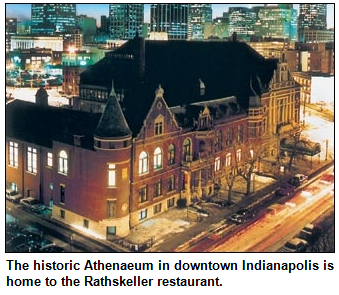 Although the creature, which has a snout like a pig, has long been extinct in the Midwest, it can be found in other parts of North America, as well as throughout Central and South America. The medium-sized creatures prefer to eat roots, grass, seeds and fruit. Their tusks are shaped differently than those of pigs.
Although the creature, which has a snout like a pig, has long been extinct in the Midwest, it can be found in other parts of North America, as well as throughout Central and South America. The medium-sized creatures prefer to eat roots, grass, seeds and fruit. Their tusks are shaped differently than those of pigs.
Question: Name the pig-like creature found during ancient eras on the site of today's Indiana.
This week's prize is a gift certificate to The Rathskeller Restaurant and a pair of tickets to the Indianapolis Zoo, courtesy of Visit Indy. You will not find the meat of this particular animal on the menu at The Rathskeller, nor will you find this extinct animal at the Zoo. But there sure is a lot to savor and enjoy in Indy.
Roadtrip: Amazing Maize at the Indiana State Museum
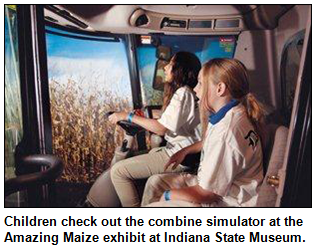 Our regular Roadtripper, Chris Gahl of Visit Indy, is off this week, so a guest Roadtripper will bring us up to speed on the Amazing Maize: The Science, History and Culture of Corn exhibit, which should be your next stop after listening to this week's Hoosier History Live! show about early agriculture in Indiana.
Our regular Roadtripper, Chris Gahl of Visit Indy, is off this week, so a guest Roadtripper will bring us up to speed on the Amazing Maize: The Science, History and Culture of Corn exhibit, which should be your next stop after listening to this week's Hoosier History Live! show about early agriculture in Indiana.
The exhibit at the Indiana State Museum runs through March 24, 2013. According to the Indiana State Museum's website, it takes 25 corn plants per person per day to support the American way of life. This 10,000-year global genetic journey explores the relationship between people and corn, arguably the most productive domesticated plant and the greatest plant breeding achievement of all time.
You can also play an online "corny" game for kids, presented here by the Indiana State Museum. And if you're a teacher, here is a Teacher's Guide for all ages.
Unique history of New Harmony
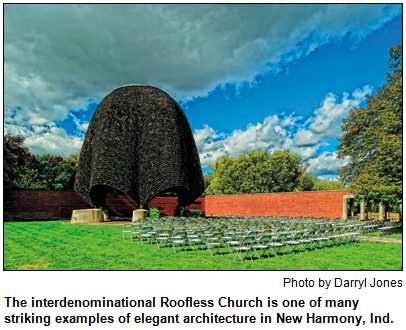 (Sept. 22, 2012) - A small, idyllic village that became world-famous because of two experimental utopian communities during the early 1800s is the this show, one in our rotating series about Hoosier towns.
(Sept. 22, 2012) - A small, idyllic village that became world-famous because of two experimental utopian communities during the early 1800s is the this show, one in our rotating series about Hoosier towns.
New Harmony, located on the Wabash River in far-southwestern Indiana, was the setting for two historic attempts at communal living.
The town's founders in 1814 were German immigrant George Rapp and his followers, who became known as the Harmonists. Devoted to hard work and self-sacrifice, including celibacy, they built the village while waiting for the second coming of Christ.
The Harmonists eventually sold their scenic village to Scottish industrialist Robert Owen, a social reformer who attracted some of the era's most progressive educators and scientists to New Harmony, many of whom arrived in a "Boatload of Knowledge" in 1826.
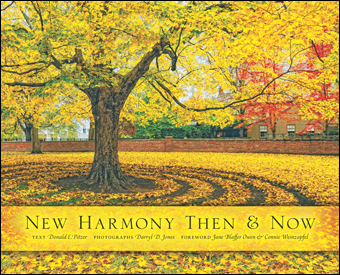 To explore these two attempts at utopia, why they did not last, the current vitality and cultural appeal of the village, as well as a wealth of other aspects of its heritage, Nelson is joined in studio by the collaborators on a new book, New Harmony: Then and Now (Indiana University Press). They are:
To explore these two attempts at utopia, why they did not last, the current vitality and cultural appeal of the village, as well as a wealth of other aspects of its heritage, Nelson is joined in studio by the collaborators on a new book, New Harmony: Then and Now (Indiana University Press). They are:
- The author, Donald Pitzer, a professor emeritus of history at the University of Southern Indiana in Evansville. He also is director emeritus of the university's Center for Communal Studies and has spent more than 40 years researching the Harmonist and Owenite communities in New Harmony.
- Acclaimed photographer Darryl Jones, who is known for his images of Indiana. Darryl also has collaborated on books written by two favorite Hoosier History Live! guests: Historical novelist James Alexander Thom (they collaborated on Spirit of the Place: Indiana's Hill Country, and you can click on the Thom link to hear the podcast of the Hoosier History Live! show) and Ray Boomhower of the Indiana Historical Society, who partnered with Darryl for Destination Indiana: Travels through Hoosier History.
Colorful aspects of New Harmony heritage - beyond the intriguing attempts at utopia - that Don, Darryl and Nelson explore include the village's interdenominational Roofless Church, which was designed by legendary architect Philip Johnson in 1960.
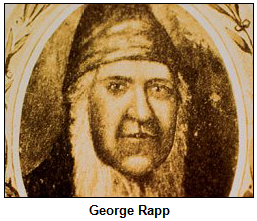 In the early 1800s, the followers of prophet George Rapp fled Germany because they objected to some teachings of the Lutheran church. After initially settling in Pennsylvania, the Harmony Society came to the Indiana wilderness in a quest for spiritual fulfillment.
In the early 1800s, the followers of prophet George Rapp fled Germany because they objected to some teachings of the Lutheran church. After initially settling in Pennsylvania, the Harmony Society came to the Indiana wilderness in a quest for spiritual fulfillment.
According to our guest Don Pitzer, the Harmonists of George Rapp, who numbered about 2,000 in total, "are thought to be the largest religious group to immigrate to America following a single leader."
Harmonist building techniques, which used Roman numeral markings still visible on some of the historic New Harmony structures, "anticipated modern pre-fabricated construction," Don Pitzer writes. Rapp's followers built dormitories to separate the sexes.
The Harmonists sold the village and 20,000 acres of forests, orchards, meadows and farmland in 1824 to Owen, a wealthy cotton mill owner in Scotland. He had been born in Wales in 1771. At the dawn of the Industrial Revolution, Owen became appalled at miserable living conditions, lack of sanitation and rampant crime.
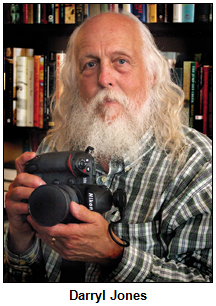 Owen vowed to create a haven free from poverty and inequality that would emphasize education, culture, science and technology. That's why he brought distinguished scholars, scientists, intellectuals and educators to New Harmony via the Wabash River on a so-called "Boatload of Knowledge."
Owen vowed to create a haven free from poverty and inequality that would emphasize education, culture, science and technology. That's why he brought distinguished scholars, scientists, intellectuals and educators to New Harmony via the Wabash River on a so-called "Boatload of Knowledge."
Alas, his utopian community didn't last. Nelson will explore the reasons with Don and Darryl, whose striking color photos in New Harmony Then and Now depict historic structures from both utopian communities, including an original Harmony Society cabin, now part of the Barrett Gate House, as well as Harmonist Community Houses.
Much of the credit for saving and restoring historic New Harmony is attributed to philanthropist Jane Blaffer Owen, a Texas oil heiress who died at age 95 in 2010. Mrs. Owen married a descendant of Robert Owen, then crusaded to restore the community's heritage, as well as celebrate art and culture.
Well-known sites built in modern times that draw visitors to New Harmony include the Roofless Church, as well as the Red Geranium, an acclaimed restaurant. Today, New Harmony also is known for its cultural retreats, interfaith seminars, musical performances and art galleries.
Some insights related to New Harmony:
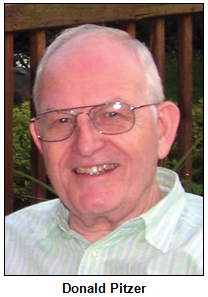 Although the Harmonists' practice of celibacy fascinates the public, the initial utopia seekers found other endeavors to enjoy. According to Don Pitzer, the Harmonists set up the first town band and the first commercial brewery in Indiana.
Although the Harmonists' practice of celibacy fascinates the public, the initial utopia seekers found other endeavors to enjoy. According to Don Pitzer, the Harmonists set up the first town band and the first commercial brewery in Indiana.- The second utopian society also created "firsts." Writes Don Pitzer: "Robert Owen set up the first infant school in the United States at New Harmony, starting what became the kindergarten movement in America." The pioneering "infant school" was housed in Harmonist Community House No. 2 on Main Street, a historic structure that has been preserved; Darryl's photo of it is featured in New Harmony Then and Now.
- Descendants of Robert Owen had an impact on Indiana in many ways. His son David Dale Owen became known as "the pioneer geologist of the Midwest" and is regarded as the founder of the Indiana Geological Society. Another son, Robert Dale Owen, was elected to the Indiana legislature and became an early advocate for women's rights. Yet another son, Richard Owen, became the first president of Purdue University.
History Mystery
A fictional town in Indiana named Harmony is the setting for a series of novels by a contemporary Hoosier storyteller known for his folksy humor. The protagonist in the novels is a Quaker minister, as is the Hoosier author of the books.  His fictional Harmony is a "small town with a kindly spirit," although it bustles with gossip, small-town scandals and eccentric characters.
His fictional Harmony is a "small town with a kindly spirit," although it bustles with gossip, small-town scandals and eccentric characters.
Even though the author gave the name "Harmony" to his fictional Hoosier town, he has conceded the community closely resembles Danville, Ind., his own hometown.
Question: Name the Indiana author who has set a series of books in a fictional town named Harmony.
This week's prize is a gift certificate to a deluxe room at the New Harmony Inn in New Harmony, courtesy of the New Harmony Inn, Resort and Conference Center.
Roadtrip: Panning for gold in Gatesville in Brown County
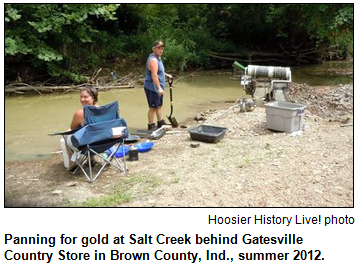 Chris Gahl of Visit Indy returns to our airwaves this week to let us know that there's a free visit to Salt Creek behind the Gatesville Country Store in Brown County if you're interested in panning for gold!
Chris Gahl of Visit Indy returns to our airwaves this week to let us know that there's a free visit to Salt Creek behind the Gatesville Country Store in Brown County if you're interested in panning for gold!
The Gatesville Store rents and sells gold panning equipment, and it also offers camping, rest rooms and a small restaurant. It's owned and operated by entrepreneur Robin Stevens, a native of Brown County who has a background in chemical engineering, geology and hospitality; all skills that seem to intersect with her business offering.
According to the Indiana Department of Natural Resources, panning for gold as a hobby is definitely alive and well in Indiana. Gold is not a naturally occurring metal in Indiana; instead, it was slowly relocated here from Canada by the glaciers, and some of it wound up in the streams of Brown County.
The Gatesville Country Store is near the intersection of Gatesville Road and Salt Creek Road in Brown County and is open seven days. The phone number is (812) 988-0788. No, they don’t have a website, but the food is home cooking at its best.
Amelia Earhart and her Indiana connections
 (Sept. 15, 2012) - She vanished 75 years ago over the South Pacific while attempting to fly around the world in a Lockheed Electra 10E twin-engine airplane sponsored by Purdue University.
(Sept. 15, 2012) - She vanished 75 years ago over the South Pacific while attempting to fly around the world in a Lockheed Electra 10E twin-engine airplane sponsored by Purdue University.
That's just one of the connections between famous aviator Amelia Earhart and the Hoosier state. She was particularly associated with Purdue, which has the world's largest and most comprehensive collection of artifacts associated with the famous aviator, whose disappearance in 1937 remains a mystery.
During the final two years before she vanished, Amelia Earhart was a sort of visiting-celebrity-in-residence on the West Lafayette campus, where she was a career counselor for women students, and where she lectured and conducted conferences. She also was an adviser to the university's department of aeronautics.
Despite her fame, Earhart chose to stay in a women's dorm (then known as South Hall, today it's part of Duhme Hall) and eat with students in the cafeteria.
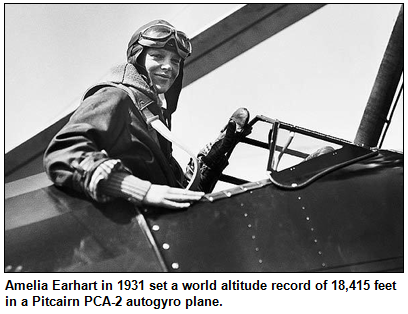 In 1935, the same year she joined the Purdue faculty, "Lady Lindy" visited the Indianapolis Motor Speedway. She became the first woman to receive an official position during the Indianapolis 500, serving as a race official. Earhart also demonstrated a parachute training device before the race began.
In 1935, the same year she joined the Purdue faculty, "Lady Lindy" visited the Indianapolis Motor Speedway. She became the first woman to receive an official position during the Indianapolis 500, serving as a race official. Earhart also demonstrated a parachute training device before the race began.
To explore these and a sky-high stack of other Earhart links to Indiana, Nelson is joined in studio by Purdue staff writer and historian John Norberg, an aviation expert who has written extensively about her colorful life. The huge collection of Earhart memorabilia at Purdue includes some of her flight suits, logs and diaries, lecture notes, letters, poems and even a pre-marital agreement with her husband, George Putnam.
She wasn't a native Hoosier. Born in Atchison, Kansas, in 1897, Earhart earned her pilot's license in 1922 and within a month set an altitude record (14,000 feet) for a woman aviator. Subsequently, her list of record-breaking achievements included becoming the first woman to fly across the Atlantic Ocean, in 1928, and two years later setting a speed record (181 mph) for a woman in flight.
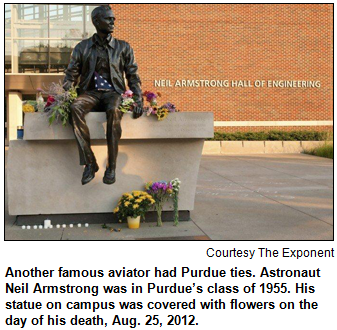 Invitations to establish a relationship with Purdue apparently were appealing for several reasons. She liked the fact that engineering and mechanical training were fully open to women students, and she was appreciative that, in 1935, Purdue was the only university in the country with its own airstrip.
Invitations to establish a relationship with Purdue apparently were appealing for several reasons. She liked the fact that engineering and mechanical training were fully open to women students, and she was appreciative that, in 1935, Purdue was the only university in the country with its own airstrip.
With this year's 75th anniversary of her disappearance, Amelia Earhart (click to view a Discovery News video clip) has been in the news again. Nelson asks guest John Norberg for his reaction to the recent discovery in the South Pacific of a jar of anti-freckle cream, apparently of a kind used by the redheaded aviator.
Fun fact: When Earhart, who loved buttermilk, was observed drinking it several times in the Purdue cafeteria, a campus craze for the beverage kicked off.
A statue honoring Amelia Earhart stands in front of what today is known as Earhart Dining Hall. The statue was arranged by Purdue's former president, France Cordova, an Earhart fan. Cordova, who stepped down in July, was Purdue's first woman president.
 Nelson also asks the aviation historian for insights about the Purdue years of astronaut Neil Armstrong, who died last month at age 82. John, the author of Wings of Their Dreams: Purdue in Flight, spoke at a recent memorial service for Armstrong, who was a member of Purdue's class of 1955. He also was an official guest at this week's celebration honoring Armstrong at the National Cathedral in Washington D.C.
Nelson also asks the aviation historian for insights about the Purdue years of astronaut Neil Armstrong, who died last month at age 82. John, the author of Wings of Their Dreams: Purdue in Flight, spoke at a recent memorial service for Armstrong, who was a member of Purdue's class of 1955. He also was an official guest at this week's celebration honoring Armstrong at the National Cathedral in Washington D.C.
At Purdue, the trove of Earhart artifacts began with donations from Putnam, who had his wife declared legally dead in 1939. In 2002, his granddaughter, a descendant from an earlier marriage, donated nearly 500 items to the university.
Purdue's sponsorship of her Lockheed Electra included arranging for financial assistance from Indianapolis business leader J.K. Lilly and other donors. Between 1930 and 1935, Earhart had set seven women's aviation records. She also was the first person (man or woman) to fly solo from Honolulu to Oakland, Calif.
The pioneer aviator was 39 years old when she disappeared with her navigator, Fred Noonan, while flying from New Guinea to the Howland Islands. She was attempting to become the first woman pilot to circumnavigate the globe.
History Mystery
Purdue University has been nicknamed the "Mother of Astronauts." From the beginning of America's space exploration program, many of the men and women who have become astronauts attended college on the West Lafayette campus. From the first man to walk on the moon, Neil Armstrong (class of '55), to physician-scientist David Wolf (class of '78), the first Indianapolis native in space, Purdue has influenced the exploration of "the New Frontier."
 However, from the 1960s through the 1990s and beyond, Purdue waged a perpetual one-upsmanship battle with another institution of higher education over which school could claim the most Americans selected for space flight.
However, from the 1960s through the 1990s and beyond, Purdue waged a perpetual one-upsmanship battle with another institution of higher education over which school could claim the most Americans selected for space flight.
The other university also counts many alums among American astronauts - perhaps, on occasion, close to as many as Purdue.
Question: What is the other institution of higher ed?
Hints: It's not located in Indiana, and it is a private university.
This week's prize is a gift certificate to Rick's Boatyard Café on Indy's west side, courtesy of Visit Indy, and a pair of tickets to Conner Prairie, courtesy of Conner Prairie
Roadtrip: Eleutherian College, and 1950s Union Street in Indy
 Amy Lamb of the Indiana Historical Society steps in for Chris Gahl of Visit Indy this week with a kind of double Roadtrip exploring the heritage of Hoosiers from special ethnic groups; free African-Americans who had the opportunity to study at Historic Eleutherian College near Madison, Ind., and a visit with displaced Eastern European Jews resettling in Indianapolis after World War II.
Amy Lamb of the Indiana Historical Society steps in for Chris Gahl of Visit Indy this week with a kind of double Roadtrip exploring the heritage of Hoosiers from special ethnic groups; free African-Americans who had the opportunity to study at Historic Eleutherian College near Madison, Ind., and a visit with displaced Eastern European Jews resettling in Indianapolis after World War II.
The fall festival to celebrate historic Eleutherian College will take place the weekend of Sep. 21-23 on the grounds of the college itself at 6927 W. State Road 250, near Madison, Ind.
The college site is actually in the country; from Madison go north on State Road 7 and turn east on State Road 250, and soon you will come upon the beautiful village of Lancaster and see the college, a three-story limestone building, on your left.
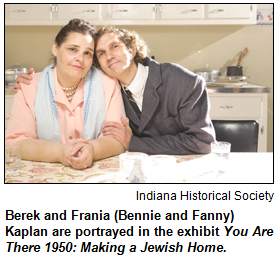 Eleutherian College was one of only a few institutions before the Civil War to intentionally adopt a model of multiracial and coeducational education. Its location less than 10 miles from the slave state of Kentucky made it exceptional among its peer institutions. For more information about the fall festival, visit Facebook or call (812) 866-7291.
Eleutherian College was one of only a few institutions before the Civil War to intentionally adopt a model of multiracial and coeducational education. Its location less than 10 miles from the slave state of Kentucky made it exceptional among its peer institutions. For more information about the fall festival, visit Facebook or call (812) 866-7291.
And, it is coming up on your last opportunity to visit You Are There 1950: Making a Jewish Home at the Eugene and Marilyn Glick Indiana History Center in downtown Indianapolis, which closes on Sept. 29.
Find out about a family's story of tragedy, courage and new beginnings by visiting the kitchen of Berek (Benny) and Frania (Fanny) Kaplan's Union Street home in a southside Indianapolis neighborhood on April 5, 1950, just a year after their resettlement from a post-World War II displaced-persons camp. Guests will join Mrs. Kaplan as she prepares a kosher meal and learn how Hoosier hospitality helped the Kaplans create a new home.
As always, visit the Hoosier History Live! website to for links to more information about these events.
Yearbooks: How to use in historical detective work
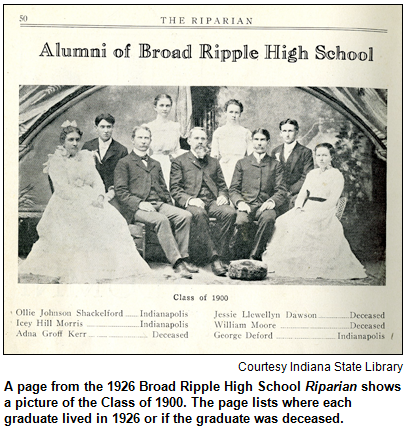 (Sept. 8, 2012) - For the first show in our newly expanded format, Hoosier History Live! headed back to school.
High school, that is. On a treasure hunt. The trove is ... yearbooks from across the state, including some that date back more than 100 years.
(Sept. 8, 2012) - For the first show in our newly expanded format, Hoosier History Live! headed back to school.
High school, that is. On a treasure hunt. The trove is ... yearbooks from across the state, including some that date back more than 100 years.
Our guest, Rachael Heger of the Indiana State Library, shares tips about using high school yearbooks across Indiana to discover historical insights about everything from local businesses to people, fashions, fads and community news.
The state library, where Rachael is director of the Indiana division, has a stash of yearbooks available for the public to use. They include several from long-closed schools such as St. Agnes Academy, a Catholic girls school, and Harry E. Wood High School, both in Indianapolis, as well as from small high schools in towns like Monticello, Logootee and Salem.
Not to mention yearbooks from Culver Military Academy in northern Indiana, Ben Davis High School in Indy, and Bedford High School in southern Indiana. And although Rachael says high schools mostly gave "birth" to yearbooks beginning in the early 1900s, the state library's collection even has some from the 1890s.
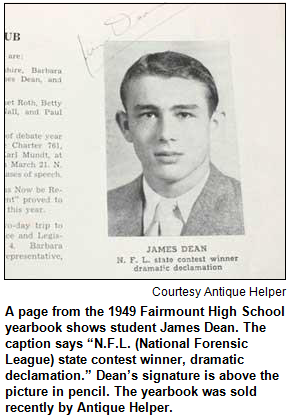 They include yearbooks from 1894 for Shortridge High School (then known as Indianapolis High School) and from 1897 for Wabash High School in Wabash, Ind. Other historic yearbooks include those from 1900 for Manual High School in Indy and from 1906 for Converse High School in Converse, Ind.
They include yearbooks from 1894 for Shortridge High School (then known as Indianapolis High School) and from 1897 for Wabash High School in Wabash, Ind. Other historic yearbooks include those from 1900 for Manual High School in Indy and from 1906 for Converse High School in Converse, Ind.
Fun fact: According to Rachael, a yearbook from the former Fairmount High School featuring future movie icon James Dean (class of '49) recently sold at an auction for $2,000.
"The ads in the back sections of yearbooks are an incredible resource about local businesses of the era, particularly those that marketed to teenagers," Rachael says. "You often see photos of their interiors, get a flavor of their products and pick up all kinds of other information."
Dig deeper, she urges, than just hunting up who was voted "Most Likely to Succeed" and who may have been regarded as the class nerd. Consider the insights available about ancestors or acquaintances who worked as teachers or school administrators. Town histories also unfold in yearbooks because many feature accounts of local news ranging from blizzards to festivals.
Sometimes you don't even have to turn pages when embarking on a yearbook search. IUPUI has digitized yearbooks for Attucks High School, and the Indianapolis Public Library did the same for Shortridge High School.
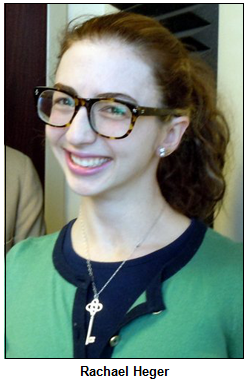 Even ancestry.com, the genealogical website, features various Hoosier high school yearbooks, albeit spotty runs for them. For example, North Central High School yearbooks on ancestry.com include the volumes for 1957, several years in the 1960s and some in the mid-1970s.
Even ancestry.com, the genealogical website, features various Hoosier high school yearbooks, albeit spotty runs for them. For example, North Central High School yearbooks on ancestry.com include the volumes for 1957, several years in the 1960s and some in the mid-1970s.
The bottom line, according to our guest Rachael Heger: "Yearbooks can be used as a research tool for more than just nostalgia."
Some more fun facts:
- Rachael was our guest in January 2012 for a show about another area of her expertise: The Hoosier connections of Rev. Jim Jones, a native of Lynn, Ind., who founded his infamous Peoples Temple in Indy. You can click to see the Hoosier History Live! enewsletter from the Jim Jones show.
- In the Shortridge High yearbook for 1940, Kurt Vonnegut Jr. gave himself a fake middle name ("Snarfield") in the caption for his senior photo. He's identified as Kurt Snarfield Vonnegut Jr. "He spoofs the whole yearbook process," says his lifelong friend, Majie Failey, who was a guest for a Vonnegut-themed show last year. You can click to see the Hoosier History Live! enewsletter from the Vonnegut-themed show.
- According to the Broad Ripple High School yearbook for 1965, senior David Letterman was voted "Class Smart Alec." Anyone surprised?
History Mystery
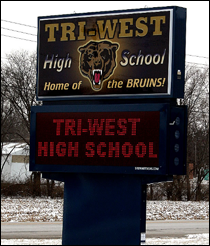 If you looked through the 1989 yearbook for Tri-West Hendricks High School in Lizton, Ind., you would notice a familiar face in a photo of the senior who was elected prom king. While attending Tri-West, the future celebrity actually lived in the nearby town of Pittsboro with his parents.
If you looked through the 1989 yearbook for Tri-West Hendricks High School in Lizton, Ind., you would notice a familiar face in a photo of the senior who was elected prom king. While attending Tri-West, the future celebrity actually lived in the nearby town of Pittsboro with his parents.
Both then and now, Tri-West High School is attended by teenagers who live in three Hendricks County towns: Lizton, Pittsboro and North Salem. While living in Pittsboro and attending Tri-West, the future celebrity and his family often dined at Frank & Mary's Restaurant, a popular eatery known for its catfish.
Name the future celebrity who was a member of Tri-West's class of 1989.
This week's prize was a gift certificate to Crowne Plaza Hotel near the Indy airport, courtesy of Visit Indy, and a pair of tickets to Conner Prairie, courtesy of Conner Prairie.
Roadtrip: A weekend of festivals
Chris Gahl of Visit Indy will be Roadtripping about with 250 travel journalists from all over the world this week, so standing in will be Garry Chilluffo of Chilluffo Photography with the message that if you can't find the right event to suit your mood or ethnic persuasion this weekend, you are simply in the wrong state of mind!
 Indianapolis seems to enjoy celebrating its diversity. Greek, Chinese, German, French and, the venerable Penrod Art Fair on the grounds of the Indianapolis Museum of Art at 4000 Michigan Road, all take place this weekend all over the city.
Indianapolis seems to enjoy celebrating its diversity. Greek, Chinese, German, French and, the venerable Penrod Art Fair on the grounds of the Indianapolis Museum of Art at 4000 Michigan Road, all take place this weekend all over the city.
And if you are a regular listener, you will know that "Penrod" is actually a rather mischievous boy character created by Indiana author Booth Tarkington.
Pick from:
- The Greek Fest at Holy Trinity Greek Ordodox Church in Carmel.
- French Market Festival at St. Joan of Arc Parish at Central and 42nd Street.
- The 38th Annual Oktoberfest at German Park.
- The Chinese Festival at Military Park.
Garry will be calling in live from the annual meeting of Indiana Landmarks at Indiana Landmarks Center at 12th and Central in Indianapolis.
As always, check the links on the Hoosier History Live! website and enewsletter for all your Roadtrip details.
Architecture around Indy with Jonathan Hess
(Sept. 1, 2012) - At least as much as anyone during the last 25 years, Jonathan Hess has left his fingerprints on landmark Indianapolis buildings. And he's about to do it again by designing the International Orangutan Center at the Indianapolis Zoo.
 Jonathan first made headlines in the 1980s when, as a young architect, he was selected by octogenarian Hoosier industrialist Harrison Eiteljorg to design the $14 million museum that would exhibit his vast art collection. Years later, Jonathan oversaw the renovation of his own work with the expansion of the Eiteljorg Museum of American Indians and Western Art in 2005. Also that year, he designed the expansion of the Indianapolis Museum of Art.
Jonathan first made headlines in the 1980s when, as a young architect, he was selected by octogenarian Hoosier industrialist Harrison Eiteljorg to design the $14 million museum that would exhibit his vast art collection. Years later, Jonathan oversaw the renovation of his own work with the expansion of the Eiteljorg Museum of American Indians and Western Art in 2005. Also that year, he designed the expansion of the Indianapolis Museum of Art.
So Jonathan, president of Browning Day Mullins Dierdorf, is our in-studio guide as he shares architectural insights about Indy landmarks, both those he did not design and those he did.
The latter include the towering Pagoda at the Indianapolis Motor Speedway; the current Herron School of Art, which opened in 2005 in a building that once housed the law school on the IUPUI campus; and an addition to the Children's Museum.
Is it any wonder The Indianapolis Star once referred to Jonathan Hess as "the rock star" of Indy architects?
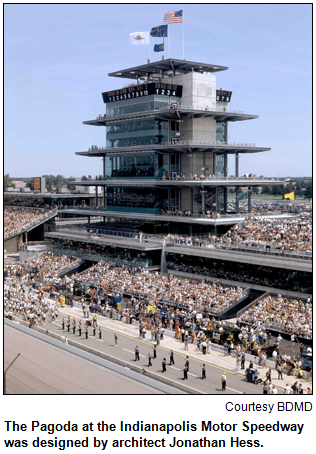 "Kids have this innate desire to make things," Jonathan, who dreamed of an architectural career as boy, once told Nelson, our host.
"Kids have this innate desire to make things," Jonathan, who dreamed of an architectural career as boy, once told Nelson, our host.
Nelson has interviewed Jonathan several times over the years in connection with the blockbuster debuts of his various projects. The list includes a renovation at St. Luke's United Methodist Church (the state's largest Methodist congregation) and Lilly Hall at Butler University.
Even though he's primarily known for his extensive work in Indy, Jonathan also has had an impact elsewhere in Hoosierland. He was the architect for the Indiana Basketball Hall of Fame in New Castle, for example.
Indy, by the way, is his adopted hometown. Jonathan grew up in Normal, Ill., and studied architecture at the University of Illinois. In reference to that, here's another quote from an interview with Nelson more than 20 years ago:
"Most of my college friends in architecture went to Chicago or other large markets. When I told them I was coming here, they said, 'Indianapolis? Architecture? Good luck.'"
Now that Jonathan has had such a major impact on Indy - and is about to design the atrium that will be the epicenter of the world's largest center for orangutans, the endangered ape species - it's an ideal time to ask the architect to share his insights.
 The $20 million orangutan center, which will include a climate-controlled 90-foot-high atrium, is scheduled to open in 2014. Jonathan has been spending hours observing orangutans (their natural habitat is the rain forests of Sumatra and Boreno) to analyze their needs in terms of, well, creature comforts.
The $20 million orangutan center, which will include a climate-controlled 90-foot-high atrium, is scheduled to open in 2014. Jonathan has been spending hours observing orangutans (their natural habitat is the rain forests of Sumatra and Boreno) to analyze their needs in terms of, well, creature comforts.
The exhibit will include indoor as well as outdoor vantage points for observing orangutans and a tower stretching 150 feet high. Orangutans will be able to illuminate the tower themselves at night by activating a switch, according to news accounts.
At the Speedway, the Pagoda designed by Jonathan (at the request of owner Tony George) pays tribute to the racetrack's heritage. Beginning in the 1920s, an eye-catching, Japanese-style pagoda was a landmark at the Speedway for decades.
Painted green and white, the first was built of wood and burned to the ground in 1925 on the day after the Indianapolis 500. 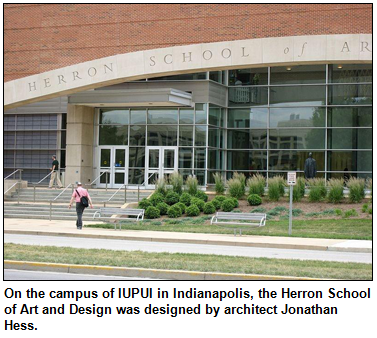 Although a second pagoda was erected, the Speedway began to take on a modern look in the mid-1950s, with aluminum and steel seats replacing wooden ones. So the modernistic Tower Terrace was built and became a fixture until the debut of the Pagoda (which is 153 feet tall) designed by Jonathan.
Although a second pagoda was erected, the Speedway began to take on a modern look in the mid-1950s, with aluminum and steel seats replacing wooden ones. So the modernistic Tower Terrace was built and became a fixture until the debut of the Pagoda (which is 153 feet tall) designed by Jonathan.
His career was fast-tracked in 1985 when Jonathan, then in his 20s, was chosen by Harrison Eiteljorg to design his namesake museum. Nelson will ask Jonathan to share details about the trips the two men took to the Southwest in search of inspiration for the museum, which opened in 1989 and helps anchor White River State Park.
For the expansion and renovation of the IMA, which was unveiled in 2005, Jonathan designed, among other aspects, a new Entrance Pavilion. According to an Indianapolis Star account, he had an epiphany about the pavilion's design and placement while watching his children draw with chalk on the family's driveway. Filled with sudden inspiration, Jonathan grabbed a piece of chalk and sketched the Entrance Pavilion to the art museum.
Jonathan and his wife, Jody, are the parents of three children.
History Mystery
In 1903, construction began of a Neoclassical building in downtown Indianapolis. Its grand architectural style combines elements of Greek, Roman and Renaissance classicism. In addition, the massive building is lined on all sides by Doric columns.
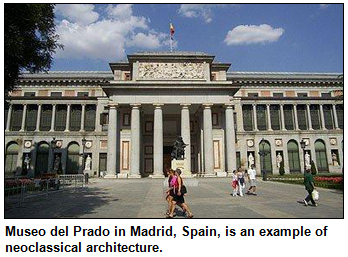 The building started a trend in the architecture for large public structures in Indy. Other buildings influenced by it included the initial Indianapolis-Marion County Public Library, a portion that's now known as the Cret Building.
The building started a trend in the architecture for large public structures in Indy. Other buildings influenced by it included the initial Indianapolis-Marion County Public Library, a portion that's now known as the Cret Building.
Question: Name the large public structure that influenced architecture after it was built in the early 1900s. Hint: The historic building is still in use.
This week's prize is a gift certificate to Lorenzo's Ristorante in downtown Indianapolis at 15 E. Maryland St., and pair of tickets to the Indianapolis Zoo, courtesy of Visit Indy (formerly ICVA).
Roadtrip: New guided walking tour of downtown Columbus, Ind.
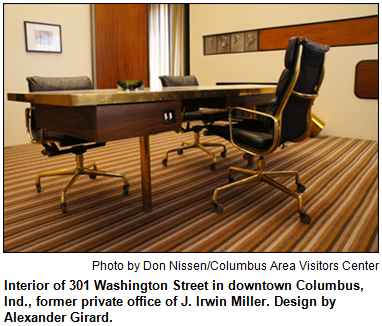 Chris Gahl of Visit Indy (formerly the Indianapolis Convention and Visitors Association) reminds us that, just as many New Yorkers have never been to the Statue of Liberty, many Hoosiers also have not taken the various architectural tours offered in modern architectural mecca of Columbus, Ind., just 50 minutes south of Indianapolis on I-65.
Chris Gahl of Visit Indy (formerly the Indianapolis Convention and Visitors Association) reminds us that, just as many New Yorkers have never been to the Statue of Liberty, many Hoosiers also have not taken the various architectural tours offered in modern architectural mecca of Columbus, Ind., just 50 minutes south of Indianapolis on I-65.
According to the Columbus Visitors Center, in addition to the guided Architectural Tour, which takes two hours by motorcoach, and the separate guided Miller Home and Garden tour, which takes 90 minutes, a new downtown guided Walking Tour of Columbus is offered every other Saturday.
One of the highlights of the Walking Tour includes the interior of 301 Washington St., the former office of Columbus industrialist and architectural aficionado J. Irwin Miller.
"It's like looking into a time capsule; a look at the Mad Men office architectural era," says Erin Hawkins of the Columbus Visitors Center.
For detailed info on all the tours, check the group's website.
Aug. 25 show
Carmel city history
Maybe not every Hoosier is aware that, 175 years ago, Bethlehem was the initial name of the village in Hamilton County that became Carmel. Or that Range Line Road apparently once led clear south to Monument Circle in downtown Indy.
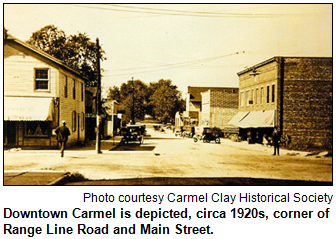 Is any Hoosier, though, unaware of the explosive growth that has occurred in Carmel, which barely had 500 residents in 1900? Just this week, Carmel landed the No. 1 spot on the "100 Best Places to Live" published by Money Magazine.
Is any Hoosier, though, unaware of the explosive growth that has occurred in Carmel, which barely had 500 residents in 1900? Just this week, Carmel landed the No. 1 spot on the "100 Best Places to Live" published by Money Magazine.
To explore the history of the city that (according to 2010 U.S. Census info shared by a demographer on Hoosier History Live! awhile back) now has 79,191 people, Nelson is joined in studio by three guests with some deep perspectives on the bustling city.
They are historian Katherine Dill, executive director of the Carmel Clay Historical Society, and lifelong Carmel residents Nancy Childs and Karla Katterhenry, whose ancestors once owned a business in the Old Town area of the city. Today, the Old Town area anchors the Carmel Arts & Design District, which includes galleries, boutiques and other shops.
They share insights about the community that formed in 1837 as Bethlehem. (The name change occurred because it turned out a town of Bethlehem already was under way in far-southern Indiana.) Many early settlers were Quakers who had migrated to the area from North Carolina. They included the ancestors of our guest Nancy Childs, who attends Carmel Friends Church, 651 W. Main St., which evolved from the early Quakers in Carmel.
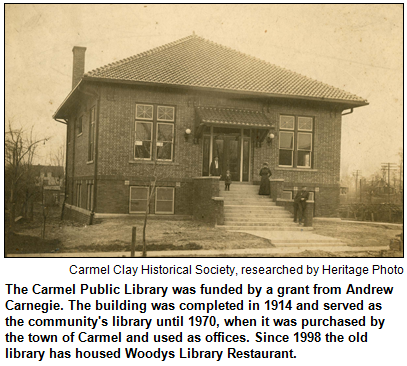 The town got its first boost in the 1880s when the Monon Railroad opened a Carmel depot. Next to the Monon in the early 1900s was Brunson's Sawmill and Lumberyard, which was owned by the great-grandparents of Karla Katterhenry, our guest. Her grandfather became manager of the lumberyard.
The town got its first boost in the 1880s when the Monon Railroad opened a Carmel depot. Next to the Monon in the early 1900s was Brunson's Sawmill and Lumberyard, which was owned by the great-grandparents of Karla Katterhenry, our guest. Her grandfather became manager of the lumberyard.
Today, the Monon Trail, the reclaimed railroad right-of-way, is a popular urban greenway that runs from 146th Street nearly to downtown Indy. In Carmel, the $55 million Monon Community Center, a family recreational facility with a lavish water park, opened in 2007.
Carmel High School is the state's largest, with 4,600 students enrolled. Its girls swimming team holds an ongoing national record. Beginning in 1986, the team has won 26 straight state championships, more than any other girls team in any sport across the country. Carmel High also repeatedly has won state championships in other sports, including football, boys swimming and tennis.
Our guests Karla and Nancy have been involved with the Carmel Clay School District in several ways. In addition to being Carmel High alum (both are members of the Class of '61), Nancy taught at Clay Middle School (then a junior high) during the 1970s. Karla was an instructional assistant for 28 years, retiring last May from Carmel Elementary School.
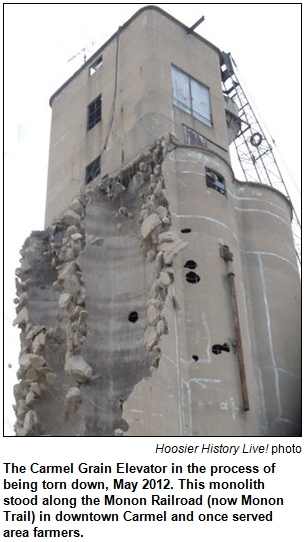 As a teenager, Karla worked at Brown's Pharmacy, a bustling hang-out for the after-school crowd that longtime Camel residents will recall with fondness. The drug store was located at 20 N. Range Line Road.
As a teenager, Karla worked at Brown's Pharmacy, a bustling hang-out for the after-school crowd that longtime Camel residents will recall with fondness. The drug store was located at 20 N. Range Line Road.
Also on Range Line Road - at its intersection with Main Street, to be precise - one of the country's first automatic traffic lights was installed in the early 1920s. The stoplight was created by Carmel inventor Leslie Haines.
The historic stoplight is exhibited at the Monon Depot Museum operated by the Carmel Clay Historical Society. Our guest Katherine Dill, its director, has lived in Carmel for eight years and previously worked for the Indiana Historical Society.
Some fun facts:
- Carmel has been called the "roundabout capital of the nation" because of the development of so many of the circular intersections on local streets.
- In 1913, downtown Carmel was devastated by a fire. Ironically, 1913 also was the year of the greatest flood in Indiana's history; torrential rainfall caused massive flooding across the state, including in Carmel.
- The Money Magazine list of "100 Best Places to Live" showcases small cities with populations of 50.000 to 300,000. Among other factors, Carmel was hailed for its schools, art and design district, and bicycle paths. Its neighbor in Hamilton County, the city of Fishers - which, like Carmel, has more than doubled in population since 2000 - was ranked No. 12 on the list.
History Mystery
In Carmel, a family of exceptional tennis players was known as "Indiana's first family of tennis" from the late 1970s through the 1990s. One of the eldest brothers among eight siblings in the family achieved perhaps the greatest success on the professional circuit of any tennis player in Indiana history.
As a Carmel High School student, he won the state championship in tennis. In college, he was a three-time All-American. As a touring pro, he competed against many of the sport's biggest names, reaping international attention at the U.S. Open in 1986 with an upset victory over superstar Jimmy Connors.
He eventually became director of the Indianapolis Tennis Center. Sadly, he was just 34 years old when he died of brain cancer in 1998.
Question: Who was the famous tennis player from Carmel?
This week's prize was a pair of tickets to a pair of tickets to Conner Prairie, courtesy of Conner Prairie, and an overnight stay at University Place Hotel on the IUPUI campus, courtesy of Visit Indy (formerly ICVA).
Roadtrip: Indiana African American Heritage Trail
Chris Gahl of Visit Indy (formerly the Indianapolis Visitors and Convention Association) recommends that we check out the Indiana African American Heritage Trail, which starts at The Depot in Jeffersonville, Ind.
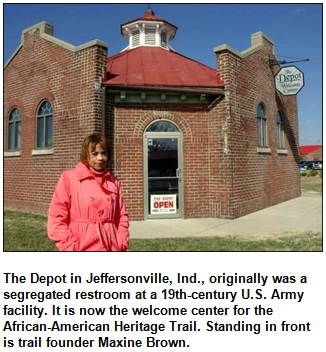 The Depot is a former segregated restroom that was, interestingly, divided for white males, white females, black males and black females. It is located at 600 Quartermaster Station in Jeffersonville, Clark County, and there one can pick up brochures and self-guided tour information for such sites as nearby Taylor High School in Jeffersonville, Leora Brown School in Corydon, or the farther-away Lyles Station in Gibson County, an early African-American settlement.
The Depot is a former segregated restroom that was, interestingly, divided for white males, white females, black males and black females. It is located at 600 Quartermaster Station in Jeffersonville, Clark County, and there one can pick up brochures and self-guided tour information for such sites as nearby Taylor High School in Jeffersonville, Leora Brown School in Corydon, or the farther-away Lyles Station in Gibson County, an early African-American settlement.
If you'd like to learn more about Indiana African-American history, be sure to sign up for the Progressive Journey Conference to be held in Jeffersonville on October 10-12.
One of the highlights of the conference will be a lunch at Cedar Farm, also known as the Kintner-Withers House, an antebellum home overlooking the Ohio River in Laconia, Ind. It was purchased in 1985 by the William and Gayle Cook family of Bloomington, Ind., and is generally not open to the public. The house is painted light yellow with white trim and green shutters, based on an 1898 painting by Indianapolis artist William Forsyth.
Mrs. Cook will be greeting her guests for the luncheon, which will be followed by a re-enactment of an 1814 Indiana court case in which a woman of color successfully sued the white man to whom she had been indentured on grounds of assault, trespass and false imprisonment. Following the re-enactment, a group discussion about the 1814 case will be led by Judge Maria Granger, judge of Floyd County Superior Court 3.
More information about the Progressive Journey Conference is available here, and you also can register for just specific days or events, rather than the whole conference. You also can receive more information by calling Heritage Trail founder Maxine Brown at (502) 550-0484.
This n' that
A retrospective of Pan Am Games impact, and more
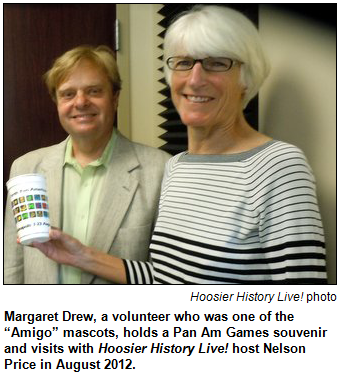 (August 2012) - Remember Indianapolis's "Naptown" days? In the early 1980s, Indianapolis was at a crossroads, and civic leaders developed a vision that set the city on its path to becoming the amateur sports capital of the world.
(August 2012) - Remember Indianapolis's "Naptown" days? In the early 1980s, Indianapolis was at a crossroads, and civic leaders developed a vision that set the city on its path to becoming the amateur sports capital of the world.
Much like Super Bowl XLVI, the 1987 Pan Am Games, which were the focus of two recent Hoosier History Live! shows, put Indianapolis on the map.
Join Indiana Humanities and Indiana Sports Corp for Chew on This, a series of dinner conversations at 10 various bars and restaurants across Indianapolis to discuss the success, failures and lasting impact of the Pan Am Games on its 25th anniversary.
Chew On This: Crossroads 1987 is presented by Hoosier History Live! partner Indiana Humanities.
- When: Wednesday, Aug. 22 from 6 to 7:30 p.m.
- Cost: $20.
Other bits of Hoosier History Live! news:
- Thanks again to James Alexander Thom, a best-selling author of historical fiction, and Judy O'Bannon, former Indiana first lady and public television producer, for providing letters of support. Hoosier History Live! has been nominated for the Indiana History Outstanding Event or Project Award for 2012 with the Indiana Historical Society.
- Nelson is newly featured in the Historic Indianapolis website as a "heritage steward." Author/historian Tiffany Benedict Berkson, who has appeared on Hoosier History Live!, interviews our host about his career, family and current activities. Check out the Q-and-A here.
Ask Nelson
(Aug. 18, 2012) - The last time we turned the tables on our host, author/historian Nelson Price, and let our listeners interview him, a caller wanted to know why novelist Kurt Vonnegut Jr. wasn't buried at Crown Hill Cemetery near several generations of his extended family. (Answer: The literary lion, who died in 2007, had expressed a desire to be cremated.)
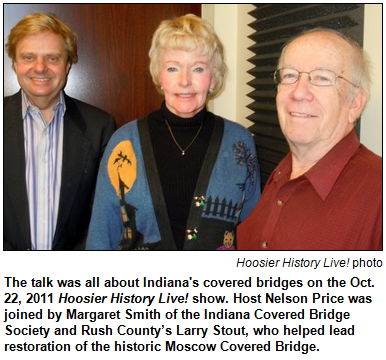 Another caller inquired about one of the most sensational news stories of 1913: the mysterious disappearance in New Castle of a 9-year-old girl named Catherine Winters. Despite an exhaustive national search that persisted for years, she never was found. Dozens of theories about what happened to "poor little Catherine Winters" (as she became known across Indiana) were suggested but never were proved.
Another caller inquired about one of the most sensational news stories of 1913: the mysterious disappearance in New Castle of a 9-year-old girl named Catherine Winters. Despite an exhaustive national search that persisted for years, she never was found. Dozens of theories about what happened to "poor little Catherine Winters" (as she became known across Indiana) were suggested but never were proved.
To give our listeners another opportunity to question Nelson, who calls himself a "garbage can of useless Hoosier trivia," Hoosier History Live! occasionally opens the phone lines and does an "Ask Nelson" show wherein listeners call in and ask questions of Nelson, who writes books about famous Hoosiers (both historic and contemporary figures) and Indianapolis city history.
As a commentator on motor-coach tours across the state, he also has shared insights on trips to destinations such as Wildflower Woods, the historic cabin near Rome City of Gene Stratton-Porter, the famous author, photographer and naturalist of the early 1900s. Other destinations of his tours have included the T.C. Steele State Historic Site in Brown County, which includes the studio and home (known as the "House of the Singing Winds") of Indiana's most famous painter.
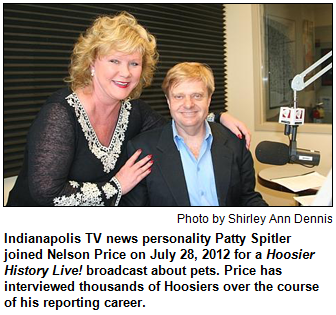 Nelson welcomes questions about any Indiana-related topic and loves to share anecdotes and insights. His books include Indiana Legends: Famous Hoosiers from Johnny Appleseed to David Letterman (Hawthorne Publishing) and Indianapolis Then and Now (Thunder Bay Press), a visual history of the Hoosier capital that features historic and contemporary images of about 70 sites. Those sites include the Columbia Club (did you know that, in the mid-1800s, a doctor's home and office were located on the Monument Circle site?), Broad Ripple and Beech Grove.
Nelson welcomes questions about any Indiana-related topic and loves to share anecdotes and insights. His books include Indiana Legends: Famous Hoosiers from Johnny Appleseed to David Letterman (Hawthorne Publishing) and Indianapolis Then and Now (Thunder Bay Press), a visual history of the Hoosier capital that features historic and contemporary images of about 70 sites. Those sites include the Columbia Club (did you know that, in the mid-1800s, a doctor's home and office were located on the Monument Circle site?), Broad Ripple and Beech Grove.
Speaking of Broad Ripple and Beech Grove: In our four-and-a-half years on the air, Hoosier History Live! has explored the heritage of those communities, as well as the histories of places ranging from Fort Wayne to Vincennes. We also have done rotating shows about our state's ethnic heritage. So we've explored immigration from Germany, Ireland, Scotland, Italy, Cuba, Greece and Brazil, among others. That means Nelson enjoys passing along insights that our expert guests have shared.
Freely conceding he can be stumped, Nelson hopes that won't be the goal. Instead, the idea is to enjoy a spontaneous, informative conversation with listeners about our state's fascinating heritage.
Some fun facts that may inspire questions, drawn from his books Indiana Legends and Legendary Hoosiers, which include profiles and vignettes about 160 famous men and women:
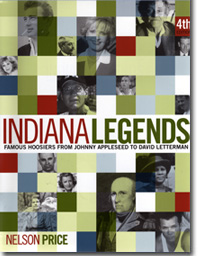 Although the woman who alerted federal authorities to the whereabouts of bank robber John Dillinger has gone down in history as the “Lady in Red”, Anna Sage always contended she was wearing an orange skirt on July 22, 1934. That's when she informed federal agents that she would be accompanying Dillinger, a former Mooresville farm boy who became "Public Enemy Number One," to the Biograph Theatre in Chicago. Dillinger was killed in the resulting shootout.
Although the woman who alerted federal authorities to the whereabouts of bank robber John Dillinger has gone down in history as the “Lady in Red”, Anna Sage always contended she was wearing an orange skirt on July 22, 1934. That's when she informed federal agents that she would be accompanying Dillinger, a former Mooresville farm boy who became "Public Enemy Number One," to the Biograph Theatre in Chicago. Dillinger was killed in the resulting shootout. - Popcorn king Orville Redenbacher (1907-1995), who grew up on a farm near Brazil, is credited with making the first substantial alterations in popcorn since Native Americans introduced it to white settlers more than 250 years ago. After spending more than 40 years crossbreeding hybrids, Redenbacher created a variety that was whiter, fluffier and able to expand 40 times its original size when popped.
- When Indianapolis native Marilyn Tucker Quayle was the nation's second lady, she co-wrote a novel titled Embrace the Serpent, a political thriller. Nelson interviewed Mrs. Quayle, the wife of then-Vice President Dan Quayle, about the novel, which focused on a power play between Cuba and the United States. Her co-author with the novel, published in 1992, was her older sister, Nancy Tucker Northcutt; the sisters are graduates of Broad Ripple High School.
Want to know more about any of this - or any other Indiana-related topic? Questions or insights always are welcome from our wonderful listeners.
History Mystery
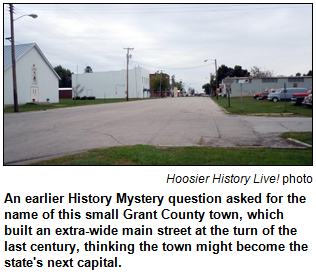 Among the famous Hoosiers featured in Nelson Price's books Indiana Legends and Legendary Hoosiers is a baseball star of the late 1940s through the 1950s who is the pride of his Hoosier hometown. He was a pitcher for the Brooklyn Dodgers during the Jackie Robinson era, playing in five World Series. His claims to fame include being chosen to pitch the opening game in Los Angeles when the Dodgers moved there from Brooklyn in 1958.
Among the famous Hoosiers featured in Nelson Price's books Indiana Legends and Legendary Hoosiers is a baseball star of the late 1940s through the 1950s who is the pride of his Hoosier hometown. He was a pitcher for the Brooklyn Dodgers during the Jackie Robinson era, playing in five World Series. His claims to fame include being chosen to pitch the opening game in Los Angeles when the Dodgers moved there from Brooklyn in 1958.
After retiring from pro baseball, he resettled in his Indiana hometown, where he became a civic leader, serving as a bank president and a board member of the city's largest hospital. As a teenager, he had been a high school baseball star in his hometown. In recent years, he has been named a Living Legend by the Indiana Historical Society and is known for playing a rendition of Take Me Out to the Ballgame on his harmonica.
Question: Name both the famous Hoosier and his Hoosier hometown.
This week's prize was a pair of tickets to IndyFringe, courtesy of IndyFringe, a pair of tickets to Conner Prairie, courtesy of Conner Prairie, and a pair of tickets to the Eiteljorg Museum, courtesy of the ICVA.
Roadtrip: Quilt Show at Nancy Noel's The Sanctuary
 Chris Gahl of the ICVA suggests that we could easily make a day of it by Roadtripping to Zionsville to see Nancy Noel's astonishing collection of hand-crafted quilts.
Chris Gahl of the ICVA suggests that we could easily make a day of it by Roadtripping to Zionsville to see Nancy Noel's astonishing collection of hand-crafted quilts.
The renowned Central Indiana artist is holding her annual quilt show at her gallery, The Sanctuary, in the historic village of Zionsville. The show continues through Saturday, Sept. 1, and vintage and contemporary quilts will take their place alongside Nancy's artwork in the beautifully restored 150-year-old Victorian church that is home to her largest and most complete collection.
Also available are gallery tours, dining at The Sanctuary's restaurant, Ghyslain, quilt history sessions and quilting demonstrations. Enjoy!
Tiny towns that refuse to die
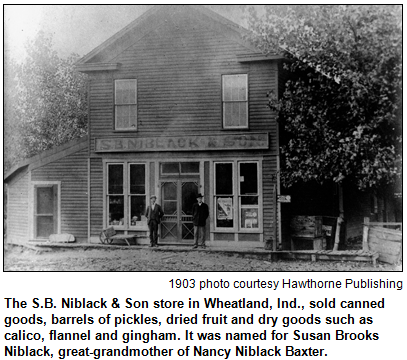 (Aug. 11, 2012) - Even though only about 200 to 400 people live in some Indiana towns - and their head count 100 years ago numbered in that range as well - some of these tiny places on the state map are chugging along. To explore four towns that refuse to die, Nelson is joined in studio by well-known author and editor Nancy Niblack Baxter, whose father grew up in the early 1900s in one of these Hoosier burgs.
(Aug. 11, 2012) - Even though only about 200 to 400 people live in some Indiana towns - and their head count 100 years ago numbered in that range as well - some of these tiny places on the state map are chugging along. To explore four towns that refuse to die, Nelson is joined in studio by well-known author and editor Nancy Niblack Baxter, whose father grew up in the early 1900s in one of these Hoosier burgs.
His hometown was Wheatland (pop.: about 200), a Knox County town east of Vincennes that's been revitalized thanks to an annual festival known as Wheatfest; the opening last month of a new branch of the Knox County Public Library, a bustling gathering spot called the Crossroads Café and other factors.
As described by Nancy's late father in his newly re-released memoir, The Life and Times of a Hoosier Judge: John Niblack, Second, Wheatland Edition (Hawthorne Publishing), the town in 1900 had "two main dusty roads," one of which had been created from an old buffalo trace - a path carved out by buffalo in their migrations, then the route often was used by Native Americans, followed by the earliest white settlers.
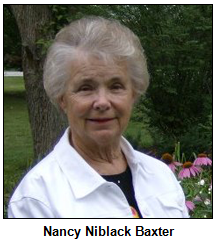 In addition to Wheatland, Nancy shares insights about Merom, a southwestern Indiana town on the Wabash River in Sullivan County.
In addition to Wheatland, Nancy shares insights about Merom, a southwestern Indiana town on the Wabash River in Sullivan County.
With a current population of about 300, Merom has resurrected its historic Chautauqua, a festival featuring speakers and music. During the early 1900s, a Chautauqua circuit flourished across the country, with towns serving as hosts for visiting performers, speakers and musicians.
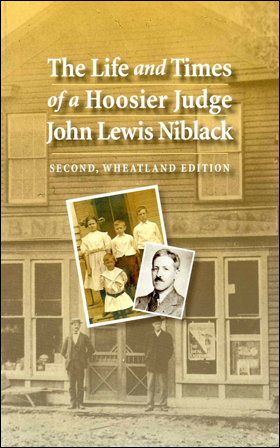 At the other end of the Hoosier state, the town of Bryant (pop. 252) is the home of Bearcreek Farms, a 200-acre complex with a dinner theater. Located about three miles south of Geneva in Jay County, Bryant also is the site of Loblolly Nature Preserve and hosts an annual Loblolly Days festival. Apparently a Loblolly Queen is chosen based on how much hay she can bale in one minute.
At the other end of the Hoosier state, the town of Bryant (pop. 252) is the home of Bearcreek Farms, a 200-acre complex with a dinner theater. Located about three miles south of Geneva in Jay County, Bryant also is the site of Loblolly Nature Preserve and hosts an annual Loblolly Days festival. Apparently a Loblolly Queen is chosen based on how much hay she can bale in one minute.
Loblolly Marsh was a setting for A Girl of the Limberlost, a bestselling novel in 1909 by Gene Stratton-Porter, the famous Hoosier naturalist and photographer. She crusaded to preserve the marsh.
Kudos to our regular listener, Terri Gorney of Fort Wayne, for suggesting Bryant to feature in this "tiny towns" show.
We also plan to explore Monterey, a town in Pulaski County that almost withered in the 1950s. With just 250 people then, Monterey was in danger of losing its post office (it had been condemned) and folding up.
Instead, residents decided the town could survive if a doctor and dentist were lured to the community, a story that's recounted in Hoosier Lore (Brooks Publishing), a new collection of human-interest columns written by the late Al Spiers. (His daughter, Sally Spiers, was Nelson's guest in April for a "True Tall Tales" show on Hoosier History Live!) In Monterey, the Lion's Club, then the smallest in the state, took up the cause to keep the town alive with a "civic miracle."
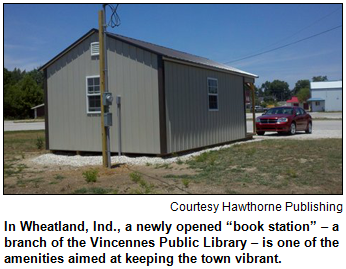 Our guest Nancy Niblack Baxter is the author of eight books about Indiana or the Civil War. She also has edited more than 200 books and currently is the senior editor at Hawthorne Publishing.
Our guest Nancy Niblack Baxter is the author of eight books about Indiana or the Civil War. She also has edited more than 200 books and currently is the senior editor at Hawthorne Publishing.
Much of the memoir of her father, John Niblack, is set in Wheatland about 1910. His grandparents' general store then sold canned goods, barrels of pickles, dried fruit and dry goods such as calico, flannel and gingham.
The self-sustaining town included a barber shop, drug stores, a bank and two institutions Nancy identifies as the strength of the tiny community: the school and the church.
Some other then-or-now tidbits about the tiny towns that Nancy and Nelson explore:
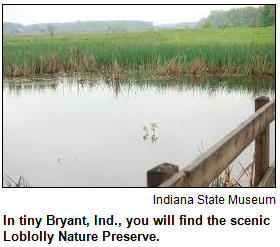 In Bryant, Loblolly Marsh includes 440 acres and has been named the state's 250th nature preserve this summer by Gov. Mitch Daniels. In a recent column in The Indianapolis Star, outdoors writer Skip Hess analyzed the various definitions of "loblolly." Some say it means "low, wet place," while others define it as a "mud hole" or "mire." (On Hoosier History Live!, Skip joined Nelson, his former Star colleague, for a "Fishing across Indiana" show two summers ago.)
In Bryant, Loblolly Marsh includes 440 acres and has been named the state's 250th nature preserve this summer by Gov. Mitch Daniels. In a recent column in The Indianapolis Star, outdoors writer Skip Hess analyzed the various definitions of "loblolly." Some say it means "low, wet place," while others define it as a "mud hole" or "mire." (On Hoosier History Live!, Skip joined Nelson, his former Star colleague, for a "Fishing across Indiana" show two summers ago.)- Merom is the setting for Bluff Park, which overlooks the Wabash River, and a large conference center.
- To keep Monterey alive when the town struggled in the 1950s, its Lions Club had auctions, bake sales, fish fries and amassed enough pledges to construct a new civic center. It included medical offices in the hope they would attract a doctor and a dentist - a "big dream," as Al Spiers put it, that came true.
History Mystery
A gourmet restaurant in northern Indiana has attracted national attention from food critics and helped revitalize the small town in which it's located. The town of about 1,700 residents is in a region that once was a popular hunting and fishing area for the Miami Indians.
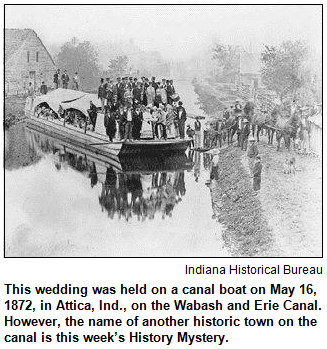 With the construction of the Wabash & Erie Canal, the town flourished as a trading center and shipping point. After World War II, the town declined; many vacant storefronts lined its Main Street.
With the construction of the Wabash & Erie Canal, the town flourished as a trading center and shipping point. After World War II, the town declined; many vacant storefronts lined its Main Street.
Beginning in the 1990s, though, its historic downtown was revitalized. The gourmet restaurant - a destination for foodies from across Indiana and beyond - opened in 2000 in an old bank building.
Question: What is the town?
This week's prize was a pair of tickets to Conner Prairie and the 1859 Balloon Voyage, courtesy of Conner Prairie, as well as a gift certificate to Tastings, A Wine Experience, located at the Conrad in downtown Indianapolis, courtesy of the ICVA.
Roadtrip: Following Lydia at the Indiana State Fair
Have you heard that fair-train whistle blowing? Roadtripper Chris Gahl of the ICVA tells us that now is the time to head to the Indiana State Fair!
In 1852, the first Indiana State Fair was held in downtown Indianapolis at what is now known as Military Park.  In 1860, the fair was held at the old Marion County Fairgrounds near 19th and Delaware streets, which later became Camp Morton, a Civil War prison camp for captured Confederate soldiers. Now the area is a downtown neighborhood known as Herron Morton Place.
In 1860, the fair was held at the old Marion County Fairgrounds near 19th and Delaware streets, which later became Camp Morton, a Civil War prison camp for captured Confederate soldiers. Now the area is a downtown neighborhood known as Herron Morton Place.
And the gates opened at the Indiana State Fairgrounds on East 38th Street for the first time on Sept. 19, 1892, when that location was pretty much out in the country. The first electric interurban trolley in Indianapolis traveling to Broad Ripple from downtown had a special line to serve fairgoers, and the Monon Railroad had a siding for cattlemen and farmers to drop off goods at the fair, as did the Nickel Plate, the diagonal railroad line that now runs the fair train.
While you are at the Indiana State Fair, be sure to check out Indianapolis writer Rita Kohn's new play, Following Lydia. The Fair Lady Players portray seven women traveling down the Ohio River from Pittsburgh in 1824. The play is presented at the Pioneer Village at the following times:
- Aug. 12 at 12:30 p.m.
- Aug. 14 at 11 a.m. and 1 p.m.
- Aug 15 at 10 a.m. and noon.
Admission to Following Lydia is free with fair entrance.
And don't forget the free park and ride lot located behind Glendale Town Center, which offers free bus service to the fair.
Bits-o'-news
A helping hand, plus a nice nomination
Thanks to new individual donor Sharon Butsch Freeland, and remember you can always visit Support us to learn more about keeping us going. Our Irvington Library listening group continues to meet to listen to and discuss the show on Saturday mornings.
And thanks to volunteer Gavin Viegas for extra help with tech support this week.
Also, we're happy to mention that Hoosier History Live! has been nominated for the Indiana History Outstanding Event or Project Award for 2012 with the Indiana Historical Society, with letters of support from James Alexander Thom, a best-selling author of historical fiction, and Judy O'Bannon, former Indiana first lady and public television producer.
Pan Am Games of 1987, Part II
(Aug. 4, 2012) - Weren't the details riveting that Mark Miles shared during our July 14 show about dealing with Fidel Castro?
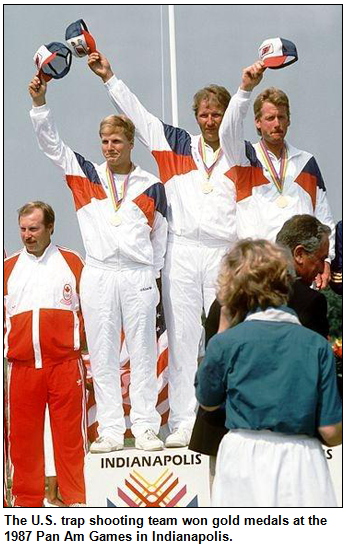 Mark, chairman of the organizing committee for the Pan American Games of 1987 in Indianapolis, also shared a fascinating anecdote about a red "hotline" telephone that was placed at his seat during the closing ceremonies of the historic games.
Mark, chairman of the organizing committee for the Pan American Games of 1987 in Indianapolis, also shared a fascinating anecdote about a red "hotline" telephone that was placed at his seat during the closing ceremonies of the historic games.
And our other guest on the show, sports columnist Bill Benner, shared insights about how Pan Am's basketball final (which was won unexpectedly by Brazil) dramatically changed international hoops competition.
The insights about Castro - who laid down conditions before agreeing to send a Cuban delegation to Indy - and other anecdotes were compelling. But the insights from our two "heavy hitter" guests meant that much turf was left uncovered about the Pan Am Games, the world's second-largest multi-sport event. Only the Olympics are larger.
We did not get a chance to explore stories involving the astounding 36,000 Hoosiers who served as volunteers in August 1987. So they will be the focus of our "Part II" show, along with other aspects of the historic games that served as Indy's "coming-out party" on an international stage.
As we advance toward the 25th anniversary of Pan Am - the Indiana Sports Corp plans a celebration Aug. 23 in downtown Indy - Nelson's guests will be two Hoosiers who immersed themselves in the games as volunteers:
- Margaret Drew of Indianapolis was among those who donned a lime-green costume to portray Amigo, the parrot that was the mascot for the games. At the time, she was an administrative law judge for the Department of Natural Resources.
- Suzy Henschen of Indianapolis headed up the massive aides-de-camp program. Of the more than 900 international VIPs who attended the games, about 130 were assigned a local aide-de-camp, who became a sort of "personal assistant" on call 24/7.
"It changed my life," Suzy recalls.
 Consider: Because of her experience with Pan Am, Suzy was hired in Honduras by organizers of the Central American Games. They asked her to train their aides-de-camp for those games in 1990 and even hailed her arrival in their country with a front-page newspaper article about the "expert" from Indianapolis.
Consider: Because of her experience with Pan Am, Suzy was hired in Honduras by organizers of the Central American Games. They asked her to train their aides-de-camp for those games in 1990 and even hailed her arrival in their country with a front-page newspaper article about the "expert" from Indianapolis.
Next up: Organizers in El Salvador hired Suzy to train aides-de-camp for the Pan Am Games of 1994, which were held in that Central American country.
You are invited to phone in at (317) 788-3314 and share your Pan Am anecdotes and insights. And Nelson, our host, plans to share details about his media duties covering the history-making diving and swimming competitions. We ran out of time for those in our first show.
Nor was there time then to explore the Athletes Village, which was housed at Fort Harrison, then still an active military facility.
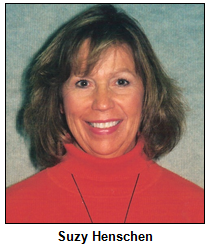 More than 4,000 athletes from 38 countries competed in 30 sports, ranging from baseball, boxing and gymnastics to tae kwon do and volleyball.
More than 4,000 athletes from 38 countries competed in 30 sports, ranging from baseball, boxing and gymnastics to tae kwon do and volleyball.
Equestrian events, which were held at Camp Atterbury's horse park in Johnson County, had a crew of volunteers that included Margaret Drew, our guest, who was not in her Amigo outfit for that duty. Eight years earlier, she had moved to Indy from Wisconsin.
"I never intended to stay here at all, but the Pan Am Games were a wonderful experience and made me feel very connected to this place," Margaret says.
Suzy Henschen, our other guest, grew up in Speedway and, for Pan Am, trained primarily college students to serve as more the more than 130 aides-de-camp to the VIPs. During our show, Suzy will describe how a student from Stanford University - who traveled from California at her own expense and arranged for local housing so she could be an aide-de-camp - was devastated when her VIP never showed up. The incident began as a crisis but eventually paid unexpected dividends for Suzy.
 The aides-de-camp, like hundreds of Hoosiers, immersed themselves in conversational Spanish and in foreign cultures for the Pan Am Games, in which countries across the western hemisphere are represented by their national teams. Participating nations ranged from Cuba, Canada, Mexico and Jamaica to tiny Suriname, a nation with only one swimming pool then.
The aides-de-camp, like hundreds of Hoosiers, immersed themselves in conversational Spanish and in foreign cultures for the Pan Am Games, in which countries across the western hemisphere are represented by their national teams. Participating nations ranged from Cuba, Canada, Mexico and Jamaica to tiny Suriname, a nation with only one swimming pool then.
Even so, Suriname swimmer Anthony Nesty won gold and bronze medals at Pan Am. He went on to capture a gold medal the next year at the 1988 Seoul Olympics, meaning his Pan Am success served as a predictor of his Olympic accomplishments, as it did for other athletes. They included diving superstar Greg Louganis, who swept his sport's gold medals both in Indy and in Seoul.
According to subsequent estimates, the Pan Am Games drew more than 150,000 visitors to Indy. (The total spectators at all events was estimated at 900,000.) Easily the largest sporting event ever staged in Indy at that point, the Pan Am Games secured the city's reputation as an amateur athletics capital and as a host city.
History Mystery
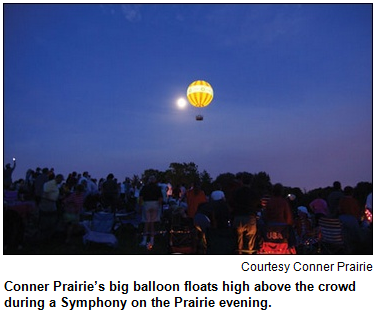 In August 1987, the same month Indianapolis hosted the Pan American Games, another international sports event was held in the Hoosier state. The other event was in northern Indiana, the only time it has been held on Hoosier soil. Like the Pan Am Games, this other event was attended by then-Vice President George H.W. Bush and involved multiple sports.
In August 1987, the same month Indianapolis hosted the Pan American Games, another international sports event was held in the Hoosier state. The other event was in northern Indiana, the only time it has been held on Hoosier soil. Like the Pan Am Games, this other event was attended by then-Vice President George H.W. Bush and involved multiple sports.
Question: What was the international event? Hint: It was discussed during a recent Hoosier History Live! show.
This week's prize was a pair of tickets to Conner Prairie and the 1859 Balloon Voyage, courtesy of Conner Prairie, as well as a pair of tickets to Symphony on the Prairie at Conner Prairie, courtesy of the ICVA. Now, doing all that in one day, especially a day in the 80s weather-wise, would be wonderful!
Roadtrip: IndyFringe is coming up fast!
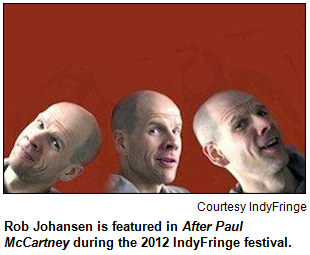 Roadtripper Chris Gahl of the ICVA tells us that Massachusetts Avenue in Indy will explode again for the eighth time in August for the annual IndyFringe Festival.
Roadtripper Chris Gahl of the ICVA tells us that Massachusetts Avenue in Indy will explode again for the eighth time in August for the annual IndyFringe Festival.
A free opening-night party for the theater festival kicks off on Thursday, and the festival itself runs from Aug. 16 to 29.
Among this year's internationally flavored offerings are SimpliCity, by Colombian playwright Carlos Monte, and Do Re Me Fa So Latino, a comedic Hispanic re-imagination of American pop culture, presented by the Yes Theatre Co. of Indianapolis. See you on the avenue!
Online audio continues to grow
Tornado show gets perma-archived with a kind assist
(July 2012) - Thank you to Phil and Pam Brooks for underwriting the podcast of "Palm Sunday tornado outbreak of 1965," and thanks to Jed Duvall for editing the show.
If you would like special shows to be archived as audio on the website, please let us know, and we do appreciate financial support for the additional tech work involved.
Thanks also to recent individual donors Gretchen Wolfram, David Willkie, and Dana Waddell and Clay Collins.
Never-ending kudos to Richard Sullivan of Monomedia, who continues to make our enewsletter and website look so professional, and to our unflappable artist, Pam Fraizer of Fraizer Designs, who created the Hoosier History Live! "look" in 2007, including the caricature logo with our charismatic blond host, Nelson Price.
Thanks also to the staff of Indianapolis Public Library Irvington Branch, who facilitate a weekly listening group for Hoosier History Live! at the branch library by providing a place for patrons to meet, a radio, and learning materials to go along with each week's topic. All are welcome to stop by the library about 11:15 a.m. each Saturday to listen to the show in a group.
Dog days in Indiana with Patty Spitler
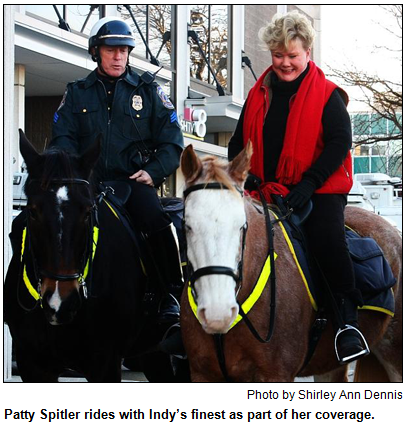 (July 28, 2012) - Hoosiers, this show is your chance to bone up on insights about our best friends. To explore the good (canine assistance programs), the bad (unwanted and neglected pets) and the ugly (the surging popularity of breeds so ugly they are adorable), Nelson is joined in studio by a popular Indianapolis-area TV personality long known for her love of - and detailed reports about - dogs.
(July 28, 2012) - Hoosiers, this show is your chance to bone up on insights about our best friends. To explore the good (canine assistance programs), the bad (unwanted and neglected pets) and the ugly (the surging popularity of breeds so ugly they are adorable), Nelson is joined in studio by a popular Indianapolis-area TV personality long known for her love of - and detailed reports about - dogs.
Patty Spitler not only is the host of Pet Pals TV, a syndicated program broadcast every Saturday at 10:30 a.m. on WNDY-TV/Channel 23, she is the owner of Louie, a Bernese mountain dog. She shares details about the Indiana Canine Assistant Network, an innovative statewide program in which dogs spend 18 months to two years living with hosts who train them to be service dogs.
In addition, Patty and Nelson explore the surging popularity (both nationally and in Indiana) of English bulldogs, a breed that, according to the American Kennel Club, hit the top 10 in 2008 for the first time in more than 70 years.
For the past two years, English bulldogs have ranked No. 6 among 157 breeds listed by the kennel club. In Indiana, much of the recent popularity has been attributed to the basketball triumphs of Butler University and its beloved bulldog mascot, Blue II. Patty plans to share concerns about health and maintenance issues associated with the breed, as well as other breed-specific advice.
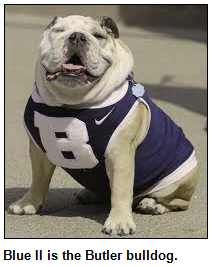 The American Kennel Club announced earlier this year that the most popular breeds in the country are, in order, the Labrador retriever, German shepherd, beagle and golden retriever. Larger breeds have been steadily moving up the list, according to the kennel club.
The American Kennel Club announced earlier this year that the most popular breeds in the country are, in order, the Labrador retriever, German shepherd, beagle and golden retriever. Larger breeds have been steadily moving up the list, according to the kennel club.
Also during our show, Patty discusses her reports involving Indianapolis Animal Care and Control, where 17,000 unwanted pets or lost animals were taken last year. (In addition to dogs and cats, animals brought to the shelter have included horses, owls and even bears, according to Patty's reports.)
On a personal level, Patty shares details about how Louie, her cherished 6-year-old dog, helped pull her out of a depression. Her bout with depression occurred after she left WISH-TV/Channel 8 in Indianapolis in 2004; she had worked 23 years as an anchor and entertainment reporter at the CBS affiliate. Patty left because of health issues; she is a spokesperson for Hear Indiana, an advocacy group for the hearing impaired.
She also volunteers for various organizations concerned with animal welfare and is an advocate for spaying and neutering pets.
In addition to hosting Pet Pals TV, which also is broadcast on WIWU-TV in Marion, Ind., as well as in Dayton, Ohio, Patty continues to appear regular on WISH-TV's weekend morning shows and Indy Style, its weekday mid-morning program.
On Pet Pals TV, Patty has reported about the Indiana Canine Assistant Network, known as ICAN, which is celebrating its 10th anniversary this year.  The program brings together dogs training to be service dogs; children and adults with disabilities, and incarcerated offenders. After a screening process, men and women in Indiana correctional facilities become trainers for ICAN dogs. (The dogs-in-training live with their trainers, called "handlers", inside the prison.)
The program brings together dogs training to be service dogs; children and adults with disabilities, and incarcerated offenders. After a screening process, men and women in Indiana correctional facilities become trainers for ICAN dogs. (The dogs-in-training live with their trainers, called "handlers", inside the prison.)
The Labrador retriever's use as a police and search-and-rescue dog - as well as its reputation for playfulness with families - account for the breed's continuing popularity, according to the kennel club. The club also reports that Bernese mountain dogs (like Patty's own Louie) are increasing in popularity, rising from 54th to 34th place among the breeds this past year.
English and French bulldogs, although increasing rapidly in popularity, are among breeds known for various health issues, including breathing difficulties. Also, according to Patty's research, more than 80 percent of all bulldogs now must be delivered by Caesarian; the percentage is even higher for French bulldogs and for Boston terriers. Yet the English bulldog, because of its gentle nature, distinctive appearance and association with sports teams like Butler's, is rising every year in popularity lists.
History Mystery
The History Mystery is a carry-over from last week because there wasn't a correct answer. Our guests included Indianapolis civic leader Georgia Buchanan, whose parents were Greek immigrants, so the question focuses on an aspect of Greek heritage.
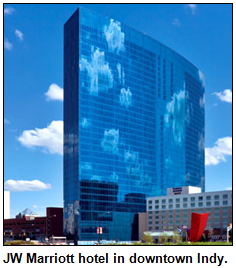 For nearly 50 years, Holy Trinity Greek Orthodox Church was located at 40th and Pennsylvania streets. In 2008, the congregation moved to a new building in Carmel with an eye-catching, Byzantine-style dome. Before either of those sites, however, the Greek Orthodox community in Indy worshipped downtown. Beginning in the 1920s, the parish church was located at a site near a current landmark building. A historic marker near the well-known building of today describes the original Greek Orthodox church on the site.
For nearly 50 years, Holy Trinity Greek Orthodox Church was located at 40th and Pennsylvania streets. In 2008, the congregation moved to a new building in Carmel with an eye-catching, Byzantine-style dome. Before either of those sites, however, the Greek Orthodox community in Indy worshipped downtown. Beginning in the 1920s, the parish church was located at a site near a current landmark building. A historic marker near the well-known building of today describes the original Greek Orthodox church on the site.
Question: Name the spacious building that's on or near the original Greek church's site.
Hints: The current landmark building opened in 1999. And it is not Lucas Oil Stadium, Bankers Life Fieldhouse or Fire Station No. 13, which were incorrect guesses by callers last week.
This week's prize wais an overnight at the new JW Marriott in downtown Indianapolis, and two tickets to the Eiteljorg Museum, courtesy of the ICVA.
Roadtrip: Freetown Village 'living museum' of African American history
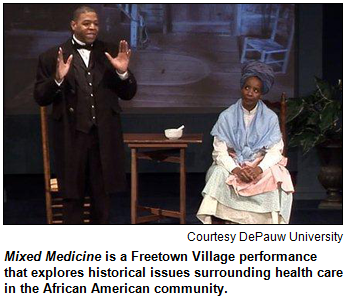 Roadtripper Chris Gahl of the ICVA tells us that Indianapolis living-history museum Freetown Village is a great opportunity for Hoosiers to learn more about African American lives and culture in Indiana through theatrical performances, storytelling, folk crafts, heritage workshops, music and day camp.
Roadtripper Chris Gahl of the ICVA tells us that Indianapolis living-history museum Freetown Village is a great opportunity for Hoosiers to learn more about African American lives and culture in Indiana through theatrical performances, storytelling, folk crafts, heritage workshops, music and day camp.
Founded by Ophelia Wellington of Indianapolis in 1982, Freetown Village was created to theatrically present the predominantly African American settlements scattered throughout Indiana during the post-Civil War era.
Many Indiana settlements were created by former slaves who had moved north and who could now be paid for their work, purchase land, attend school and be legally married.
In Indianapolis, many African Americans settled in Indianapolis just west of downtown in the old Fourth Ward, now home to IUPUI and surrounding neighborhoods.
Contact Freetown Village via its website or at (317) 631-1870 to book one of their many performance options, including the Touring Troupe, Freetown Village Singers and Craft Workshops. Tell them the Roadtripper sent you!
History of Special Olympics, other opportunities for special-needs Hoosiers
(July 21, 2012) - Amid the "Olympics summer" hoopla under way, Hoosier History Live! will explore the unfolding of opportunities - in sports competition and all aspects of life - for Hoosiers with special needs. What options were available (and not available) more than 40 years ago? How has the evolution unfolded? What have been the challenges and joys along the way?
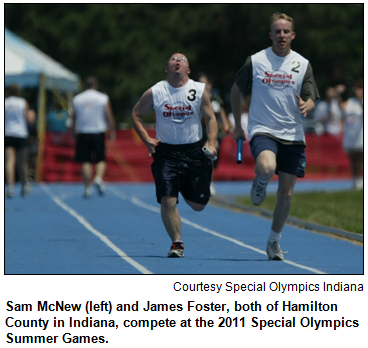 Nelson is joined in studio by two Hoosiers who for decades have been on the front lines of advocacy for young people with special needs. Indianapolis civic leader Georgia Buchanan not only is the author of a new memoir, 428½: My Journey Beyond the Railroad Tracks(IBJ Book Publishing), she is the mother of a special-needs son, Bryan Hadin, who will turn 49 next month.
Nelson is joined in studio by two Hoosiers who for decades have been on the front lines of advocacy for young people with special needs. Indianapolis civic leader Georgia Buchanan not only is the author of a new memoir, 428½: My Journey Beyond the Railroad Tracks(IBJ Book Publishing), she is the mother of a special-needs son, Bryan Hadin, who will turn 49 next month.
Georgia and Nelson are joined by Mike Furnish, who has been president/CEO of Special Olympics Indianafor 22 years. Before that, he was a manager at what today is known as Noble of Indiana, which was founded in the 1950s by parents of children with developmental disabilities. (Many of the pioneer parents were ignoring advice from doctors to institutionalize their children.)
"Doctors answered most of my questions as best they could, but there was so much that was a question mark, even to them," Georgia writes in her book, referring to Bryan's childhood in the 1960s and early '70s.
An arts advocate and journalist, Georgia, 85, is the daughter of Greek immigrants who settled in Indy during the 1920s.  Her memoir's title, 428½, refers to the street address of their walk-up apartment in a near-westside neighborhood with a mix of immigrant families. (As regular listeners will recall, she was Nelson's guest three years ago for a show about Greek immigration to Indiana.)
Her memoir's title, 428½, refers to the street address of their walk-up apartment in a near-westside neighborhood with a mix of immigrant families. (As regular listeners will recall, she was Nelson's guest three years ago for a show about Greek immigration to Indiana.)
She also is a past board president of Special Olympics Indiana. Its first Summer Games in the Hoosier state were held at Indiana State University in 1970, two years after the international games were launched by founder Eunice Kennedy Shriver.
Georgia's son, Bryan, has competed in Special Olympics events, including the Frisbee toss, track and bowling. After receiving a diploma from North Central High School, he became a worker at the greenhouse in what was then called Noble Industries. At Noble's annual celebration on Sept. 12, Georgia will sign copies of her memoir and share remarks about being the mother of a special-needs son. She also will sign books at 1 p.m. Aug. 18 at Black Dog Books in Zionsville.
Our guest Mike Furnish has served as a global trainer for Special Olympics, traveling to assist programs in such countries as Russia, Hungary and South Africa. In Indiana, Special Olympics' outreach program in 22 years has expanded from 44 counties to more than 75 of our 92 counties.
Fun fact: In August 1987, the same month that Indy hosted the Pan Am Games, the International Special Olympics Gameswere staged on Hoosier soil for the first time. The games at the University of Notre Dame were attended by celebrities such as Arnold Schwarzenegger and Whitney Houston.
Georgia and Bryan also attended the international games and watched the parade of athletes from around the world.
"Notre Dame, with its golden dome, added an amazing backdrop," she writes in 428½.
 In August 2006, Indiana sent a delegation of 82 athletes to compete in the first USA National Games in Ames, Iowa. The Hoosier team returned with more than 100 medals, according to Special Olympics Indiana.
In August 2006, Indiana sent a delegation of 82 athletes to compete in the first USA National Games in Ames, Iowa. The Hoosier team returned with more than 100 medals, according to Special Olympics Indiana.
All of that is a universe away from opportunities in the early 1900s, when, according to Georgia's book, a few schools in the Indianapolis area offered classes for students who were categorized as "mentally defective." Individualized instruction was available, she writes, "for 'slow' students and those suffering from tuberculosis."
Various advancements occurred, most significantly on a national level in 1973 when the U.S. Congress passed legislation requiring public schools to provide an education for all school-age children.
Twenty years earlier, parents of special-needs students had organized to open Noble School, the predecessor of what became Noble Industries.
Today, Noble of Indiana, which has five sites (including ones in Broad Ripple, Carmel and Richmond), offers an array of services. They range from youth summer camps to employment services for adults.
History Mystery
In honor of the Greek heritage of our guest, Indianapolis civic leader Georgia Buchanan, the History Mystery focuses on an aspect of Greek culture.  For nearly 50 years, Holy Trinity Greek Orthodox Church was located at 40th and Pennsylvania streets. In 2008, the congregation moved to a new building in Carmel with an eye-catching Byzantine-style dome.
For nearly 50 years, Holy Trinity Greek Orthodox Church was located at 40th and Pennsylvania streets. In 2008, the congregation moved to a new building in Carmel with an eye-catching Byzantine-style dome.
Before either of those sites, however, the Greek Orthodox community in Indy worshipped downtown. Beginning in the 1920s, the parish church was located at a site near a current landmark building. A historic marker near the well-known building of today describes the original Greek Orthodox church on the site.
Question: Name the spacious building that's on or near the original Greek church's site.
Hint: The current landmark building opened in 1999.
This week's prize was an overnight at the new JW Marriott in downtown Indianapolis, and two tickets to the Eiteljorg Museum, courtesy of the ICVA.
Roadtrip: Wayne County Historical Museum in Richmond
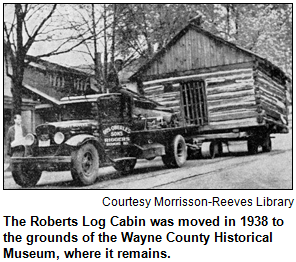 Roadtripper Chris Gahl of the ICVA tells us to head east from Indy on either I-70 or on the Old National Road (U.S. 40) to the eclectic Wayne County Historical Museum in Richmond, Ind.
Roadtripper Chris Gahl of the ICVA tells us to head east from Indy on either I-70 or on the Old National Road (U.S. 40) to the eclectic Wayne County Historical Museum in Richmond, Ind.
Composed of eight buildings on a compact site, the museum is an eclectic repository of Wayne County and Richmond history from early pioneer life through the industrial revolution into modern times.
Exhibits include two original local log cabins, a Conestoga wagon, a blacksmith shop and a 3000-year-old mummy and a recently updated gallery telling the story of life and death in ancient Egypt. The museum was also mentioned on the July 17, 2010 Hoosier History Live! show about Wayne County history with guest Carolyn Lafever.
Pan Am Games of 1987 with Mark Miles, Bill Benner
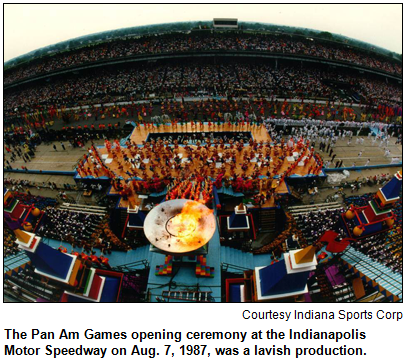 (July 14, 2012) - It's been called Indy's "coming-out party" on an international stage. More than 4,000 athletes from 38 countries in the western hemisphere descended on the Hoosier capital in August 1987 for the colorful Pan American Games, the second-largest multi-sport event in the world. Only the Olympic Games are larger.
(July 14, 2012) - It's been called Indy's "coming-out party" on an international stage. More than 4,000 athletes from 38 countries in the western hemisphere descended on the Hoosier capital in August 1987 for the colorful Pan American Games, the second-largest multi-sport event in the world. Only the Olympic Games are larger.
Jumping the gun on next month's 25th anniversary of this milestone in Indy history - which also had ramifications across the sports world - two "heavy hitters" will be Nelson's guests to share insights about the Pan Am Games, which drew an astounding 36,000 Hoosiers as volunteers.
Mark Miles, president of PAX/I (Pan American Games Ten/Indianapolis), will be one of our guests. Of course, Mark went on to serve as chairman of the host committee of the 2012 Super Bowl, the only Indy event to eclipse Pan Am in magnitude.
Nelson also will be joined by sports columnist Bill Benner, who covered Pan Am's basketball competition for The Indianapolis Star. Today, Bill is a senior associate commissioner for the Horizon League, as well as a columnist for the Indianapolis Business Journal.
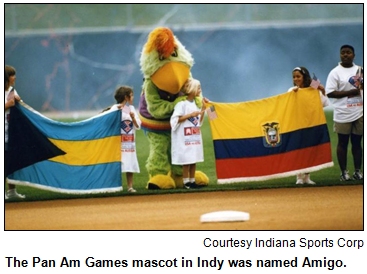 The dazzling Pan Am Games featured 30 sports, ranging from boxing, field hockey and baseball to tae kwon do, archery and gymnastics. As a writer at The Indianapolis News, Nelson covered two of the marquee sports, swimming and diving. In fact, he reported the triumphs of one of Pan Am's superstars, Greg Louganis, who still is considered to have been the best diver in competitive history. (Louganis made history in Indy by becoming the first to pull off a "triple double" - that is, win both of diving's gold medals in three consecutive Pan Am Games.)
The dazzling Pan Am Games featured 30 sports, ranging from boxing, field hockey and baseball to tae kwon do, archery and gymnastics. As a writer at The Indianapolis News, Nelson covered two of the marquee sports, swimming and diving. In fact, he reported the triumphs of one of Pan Am's superstars, Greg Louganis, who still is considered to have been the best diver in competitive history. (Louganis made history in Indy by becoming the first to pull off a "triple double" - that is, win both of diving's gold medals in three consecutive Pan Am Games.)
Indy was designated as the host late in the game - and only after Chile, then Ecuador, bowed out.
Countless stories unfolded after that, culminating with concerns from the American Legion, which is headquartered in Indy, about the spotlight that would fall on communist Cubaduring the closing ceremonies, which were planned for American Legion Mall in the open air.  Closing ceremonies were moved to the stadium then known as the Hoosier Dome; performers included Gloria Estefan, a Cuban exile, and the Miami Sound Machine.
Closing ceremonies were moved to the stadium then known as the Hoosier Dome; performers included Gloria Estefan, a Cuban exile, and the Miami Sound Machine.
Cuba, in fact, resulted in headlines every step of the way. Before the games, Mark traveled twice to Cuba to meet with dictator Fidel Castro to convince him to send his athletes to Indy. Their participation sparked tremendous interest, along with tensions. During the boxing competition, a brawl broke out between Cuban athletes and anti-Castro exiles who stomped on a Cuban flag.
Even so, the games were considered such a spectacular success that they, as the Indianapolis Star later phrased it, "cemented Indianapolis' reputation as a can-do host city and an amateur sports leader."
For 16 days at 24 venues in Indy and elsewhere across the state - the yachting competition was based in Michigan City; a horse park at Camp Atterbury hosted equestrian events - Pan Am became, as The Star put it, "a rip-roaring, heart-stopping celebration of sports and civic pride."
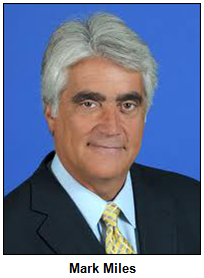 The opening ceremonies, a sensory bombardment that featured everything from parachutes and balloons to roller skaters and fireworks, were held at the Indianapolis Motor Speedway and staged by Walt Disney Productions. Spectators included then-Vice President George H.W. Bush.
The opening ceremonies, a sensory bombardment that featured everything from parachutes and balloons to roller skaters and fireworks, were held at the Indianapolis Motor Speedway and staged by Walt Disney Productions. Spectators included then-Vice President George H.W. Bush.
Emotional scenes unfolded at the finals of basketball when Brazil beat the USA at Market Square Arena. Not only did Brazilian basketball star Oscar Schmidt fall to the floor in tears - photos of his reaction became some of the games' most enduring images - but the tournament also "changed the course of international hoops history," to quote our guest Bill Benner. He will elaborate during our show.
Another emotional scene came in baseball, when Cuba surged from behind to pull out a victory, also over the USA, at the former Bush Stadium.
At the IU Natatorium, Nelson reported on the triumphs of a previously unknown swimmer from Costa Rica, 16-year-old Silvia Poll, who stunned spectators by winning eight medals. In diving, Louganis gave one of his gold medals to a spectator: Ryan White, a 15-year-old with AIDS who had crusaded to attend school in Howard County.
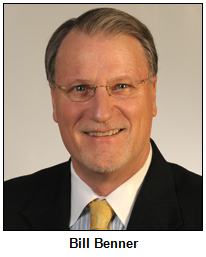 To highlight the 25th anniversary of the $34 million sports spectacle, the Indiana Sports Corp.and Indiana Humanitiesare launching a series of events and forums about Pan Am memories and the continual impact of the historic games. Nelson is among those who have shared reflections in the sports corporation's blog.
To highlight the 25th anniversary of the $34 million sports spectacle, the Indiana Sports Corp.and Indiana Humanitiesare launching a series of events and forums about Pan Am memories and the continual impact of the historic games. Nelson is among those who have shared reflections in the sports corporation's blog.
Some fun facts:
- During the games, Fort Harrison served as the Athletes Village, complete with lodging, a dining hall and a nightclub.
- In swimming, Anthony Nesty of Suriname captured gold and bronze medals, even though there was only one swimming pool in the entire country for his training.
- The mascot of the games was Amigo, a lime-green parrot.
- The horde of Hoosier volunteers served in capacities ranging from Spanish translators to chauffeurs.
- Total spectators for all events exceeded 900,000.
History Mystery
Just three years after a lavish renovation, the Circle Theatre on Monument Circle in downtown Indy served as the unlikely venue for a sports competition during the Pan Am Games in 1987.
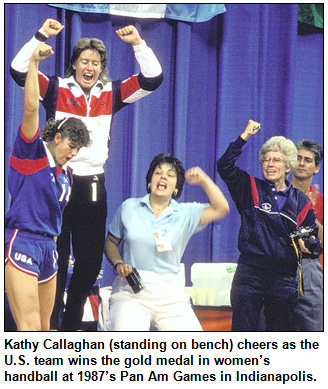 Critics expressed concerns about potential damage to the historic Circle Theatre, which was not yet known as Hilbert Circle Theatre. The theater, a former silent movie palace built in 1916, had deteriorated for decades before the $6.8 million renovation in 1984, after which it became the new concert hall for the Indianapolis Symphony Orchestra. Before the Pan Am Games began, a platform was built on the Circle Theatre's stage to protect it during the athletic competition.
Critics expressed concerns about potential damage to the historic Circle Theatre, which was not yet known as Hilbert Circle Theatre. The theater, a former silent movie palace built in 1916, had deteriorated for decades before the $6.8 million renovation in 1984, after which it became the new concert hall for the Indianapolis Symphony Orchestra. Before the Pan Am Games began, a platform was built on the Circle Theatre's stage to protect it during the athletic competition.
Question: For what sport did the Circle Theatre serve as the unlikely venue during Pan Am?
To win the prize, you must call in with the correct answer during the live show and be willing to be placed on the air. Please do not call if you have won a prize from any WICR show during the last two months. The call-in number is (317) 788-3314, and please do not call until you hear Nelson pose the question on the air.
This week's prize is two admissions to the Indianapolis Zoo and two tickets to the Indiana State Museum, courtesy of the ICVA.
Roadtrip: Middle Eastern Festival on Indy's eastside
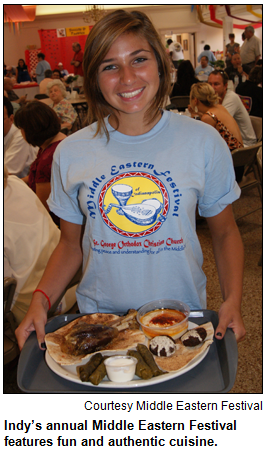 Our intrepid Roadtripper, Chris Gahl of the ICVA, returns to our airwaves to suggest that we check out the Middle Eastern Fest. It's coming up the weekend of July 20-22 at St. George Orthodox Christian Church at 4020 N. Sherman Drive on Indy's eastside.
Our intrepid Roadtripper, Chris Gahl of the ICVA, returns to our airwaves to suggest that we check out the Middle Eastern Fest. It's coming up the weekend of July 20-22 at St. George Orthodox Christian Church at 4020 N. Sherman Drive on Indy's eastside.
Live Middle Eastern bands and dancers will perform throughout the weekend, and tempting treats, including lamb shanks, gyros, stuffed grape leaves, and falafel, will be available.
This year’s festival will be the 17th annual, and next year the festival will move north to the new St. George church in Fishers.
Parking is free, and admission is $5 for those 12 and older. Opa!
David Willkie on grandfather Wendell - and roof-living
 (July 7, 2012) - More than 50 years after his colorful grandfather, as a dark-horse, maverick presidential candidate, took on Franklin D. Roosevelt, David Willkie made his own headlines. In 1992, he lived for 60 days on the slate roof of the Athenaeum in downtown Indy as a fund-raising ploy to help save the historic structure from possible demolition.
(July 7, 2012) - More than 50 years after his colorful grandfather, as a dark-horse, maverick presidential candidate, took on Franklin D. Roosevelt, David Willkie made his own headlines. In 1992, he lived for 60 days on the slate roof of the Athenaeum in downtown Indy as a fund-raising ploy to help save the historic structure from possible demolition.
So David joins Nelson in studio to share insights about two topics: the life of Wendell Willkie, the Republican Party's nominee for president in 1940, and the roof-living stunt as a recent college graduate atop the building that was designed in the 1890s by architect Bernard Vonnegut and became the hub of German cultural life in the Hoosier capital.
A caveat: David never personally knew his grandfather, who died suddenly in 1944 at age 52. He has fond memories, though, of his grandmother, Edith Willkie, who almost became the country's first lady. She was from Rushville, the town from which Wendell Willkie, a native of Elwood, based his rollicking presidential campaign. David, who grew up in Rushville, recently settled in Indianapolis after serving for several years on the staff of U.S. Sen. Richard Lugar.
 During several Hoosier History Live! shows, studio guests have shared memories or anecdotes about the unlikely presidential campaign of Wendell Willkie, a self-made business leader who never had held elective office of any kind before his unsuccessful crusade to stop FDR from winning an unprecedented third term.
During several Hoosier History Live! shows, studio guests have shared memories or anecdotes about the unlikely presidential campaign of Wendell Willkie, a self-made business leader who never had held elective office of any kind before his unsuccessful crusade to stop FDR from winning an unprecedented third term.
The chant "We want Willkie! We want Willkie! We want Willkie!" swept delegates to the 1940 Republican convention, which had been deadlocked on more traditional candidates.
"The miracle of modern politics," analysts called the upset nomination of Willkie.
Subsequently, his speech on a sweltering Saturday in Elwood drew a crowd of 215,000, making it one of the largest political gatherings in Indiana history. (By the time Willkie wound down on the 102-degree afternoon, nearly 360 people needed to be treated for heat-related disorders.)
Although Willkie had been sharply critical of aspects of FDR's New Deal and was defeated in the general election, he became a good friend of his rival. In fact, President Roosevelt even designated Willkie to be his personal representative to the Allied nations of Europe.
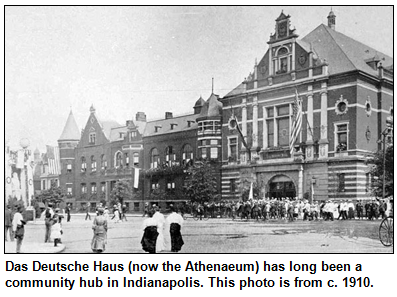 Decades after her husband's untimely death, Edith Willkie periodically brought her young grandson, David, to the Athenaeum, 401 E. Michigan St. So those visits were among David's personal connections when he camped out atop the building's roof in 1992, the 20th anniversary of which will be celebrated this fall during GermanFest.
Decades after her husband's untimely death, Edith Willkie periodically brought her young grandson, David, to the Athenaeum, 401 E. Michigan St. So those visits were among David's personal connections when he camped out atop the building's roof in 1992, the 20th anniversary of which will be celebrated this fall during GermanFest.
During his 60 days of roof-living, David, then 22 years old and a recent Indiana University graduate, was interviewed by everyone from WFBQ-FM's Bob and Tom to national media. He says he even received a phone call from literary lion Kurt Vonnegut Jr., the grandson of the architect, who expressed concerns about David's health and safety.
On the roof, David lived in a metal shed. At that point, the Athenaeum was rapidly deteriorating. Not only did the roof leak, birds were seen flying inside the historic structure. David's roof-living stunt raised $157,000 for structural repairs, with the Lilly Endowment eventually contributing $645,000.  (To salute the 20th anniversary, as well as to raise more funds, Cassie Stockamp, president of the Athenaeum Foundation, will live on the roof for a week in October.)
(To salute the 20th anniversary, as well as to raise more funds, Cassie Stockamp, president of the Athenaeum Foundation, will live on the roof for a week in October.)
If roof-living sounds scrappy and adventurous, those traits also were attributed to David's grandfather. As a young man, Wendell Willkie held down a series of jobs, including working as a short-order cook and driving a bakery wagon. Eventually, though, he became an extremely successful attorney, then one of the country's top utility executives.
He tangled with FDR over the government's new Tennessee Valley Authority, which Willkie regarded as competing with his electric company's holdings in Tennessee. However, Wendell Willkie also was regarded as socially progressive, a champion of civil rights and as an internationalist. (After his defeat by FDR, he wrote a bestselling book titled One World.)
"I won't be dropped into a mold," he said several times. "I want to be a free spirit."
Tune in to our show to hear insights from the grandson of one of the most intriguing political figures in Hoosier history - as well as David's recollections about life atop a distinctive roof.
History Mystery
Wendell Willkie had a lifelong Hoosier rival. The rival, a Democrat who became Indiana's governor in the 1930s, had attended Indiana University with Willkie. On campus, Willkie's rival attained amazing success, serving as student body president, editor of the newspaper and several other leadership roles. He became dean of the IU School of Law at age 34, the youngest dean in the school's history.
The rival was touted as a Democratic presidential candidate (although he never was nominated by the party) and, after World War II, became ambassador to the Philippines. Two dormitories at IU are named in honor of Wendell Willkie and his rival.
Question: Name the lifelong rival of Wendell Willkie.
This week's prize was two admissions to Conner Prairie Interactive History Park, courtesy of Conner Prairie, and two admission to Symphony on the Prairie, courtesy of the ICVA.
Roadtrip: Indianapolis City Market Catacombs
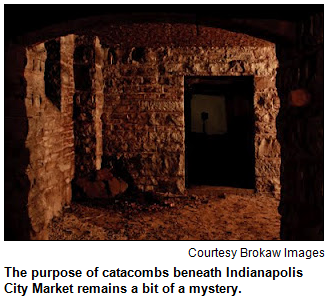 With Roadtripper Chris Gahl of the ICVA out on assignment, we thank Garry Chilluffo of Chilluffo Photography for stepping in to tell us about a mysterious Roadtrip with new, regularly scheduled tours that are open to the public.
With Roadtripper Chris Gahl of the ICVA out on assignment, we thank Garry Chilluffo of Chilluffo Photography for stepping in to tell us about a mysterious Roadtrip with new, regularly scheduled tours that are open to the public.
Indianapolis City Market and Indiana Landmarks have joined forces to offer public tours of the City Market Catacombs, the still-existing basement beneath what was once Tomlinson Hall, the huge public building built in 1886 by architect Dietrich Bohlen just west of the City Market. Tomlinson Hall burned to the ground in 1958, but the catacombs remain, and their exact purpose remains a bit of a mystery, although we expect Garry to be able to tell us more.
Fun fact: According to Historic Indianapolis, in 1912, the mayor of Indianapolis, Samuel Shank, allowed homeless men to sleep in the catacombs, and donations of food and clothing also were offered.
Public tours are offered every Wednesday during the weekly Farmers Market in front of City Hall and on the fourth Saturday of each month.
Famous fashion designers from Indiana
 (June 30, 2012) - Is it surprising that three of the top fashion designers of the last 100 years had Hoosier connections?
(June 30, 2012) - Is it surprising that three of the top fashion designers of the last 100 years had Hoosier connections?
Bill Blass, who became internationally known for his classic sportswear and evening gowns, was a native of Fort Wayne.
In Evansville, Roy Halston Frowick attended Bosse High School. Eventually calling himself just Halston, he created the pillbox hat worn by Jacqueline Kennedy as first lady. Then he designed dresses worn by celebrities such as Liza Minnelli and became a celebrity himself at the epicenter of Manhattan's fast-paced nightlife of the 1970s.
And from the early 1940s through the late 1960s, the country's foremost fashion designer was Norman Norell, who grew up in Noblesville and Indianapolis.
To explore the lives, creations and careers of these icons, Nelson is joined in studio by Petra Slinkard, curatorial associate at the Indianapolis Museum of Art. The museum features clothes created by the three designers in An American Legacy: Norell, Blass, Halston & Sprouse, an exhibit that opened earlier this year. It includes an evening gown created for former first lady Nancy Reagan by Blass, who designed the red dresses she made famous in the White House.
Although the three designers flourished during different eras, which were reflected in their designs, there may be some common, uh, threads.
"All of them were intensely creative individuals with a strong work ethic that was very Midwestern," Petra Slinkard notes.
Blass (1922-2002), a 1939 graduate of South Side High School, had a turbulent family life in Fort Wayne - his father committed suicide in their parlor when Bill was 5 years old - before he moved to New York to study fashion. His eventual mentor was Norell (1900-1972), a member of the Levinson family, well-known clothing retailers in Indiana.
Norman David Levinson created the name "Norell," which he explained this way: "Nor is for Norman. L for Levinson. Another L for looks." His clients included some of the world's most glamorous women, such as Lauren Bacall.
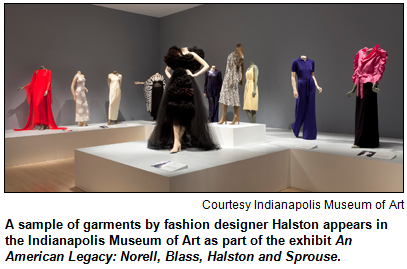 Unlike the other two famous designers, Halston (1932-1990) was not born in Indiana; he was a native of Iowa. But he spent most of his youth in Evansville and even attended Indiana University before heading to New York. The IMA exhibit includes a green and yellow gown he designed in1972 based on "flowers" paintings by Andy Warhol.
Unlike the other two famous designers, Halston (1932-1990) was not born in Indiana; he was a native of Iowa. But he spent most of his youth in Evansville and even attended Indiana University before heading to New York. The IMA exhibit includes a green and yellow gown he designed in1972 based on "flowers" paintings by Andy Warhol.
"Warhol and Halston were friends, had a similar outlook on life and surrounded themselves with the same people," Petra Slinkard notes. "It was inevitable that the most popular artist of the era would collaborate with the top designer."
All three designers won multiple Coty Awards, the top honor in the American fashion industry. In fact, Norell won so many Cotys in the late 1940s and 1950s that he was the first designer inducted into the industry's hall of fame.
 Norell also became the first fashion designer to market his name on a perfume, which made its debut in 1968. Eventually, he was vastly eclipsed in product marketing by Bill Blass, who lent his name to everything from bed linens and fountain pens to chocolates and fragrances.
Norell also became the first fashion designer to market his name on a perfume, which made its debut in 1968. Eventually, he was vastly eclipsed in product marketing by Bill Blass, who lent his name to everything from bed linens and fountain pens to chocolates and fragrances.
When Blass, who was known for designing classic looks that always stayed in style, retired in 1999, he sold his company for $50 million.
Halston's business experiences did not have positive outcomes. In the 1980s, he negotiated a deal with JCPenney to sell his creations, which backfired because more upscale retailers immediately dropped him, Petra notes. Even worse, Halston eventually lost the right to use his own name because of tangled agreements with conglomerates.
In the designers' heydays, though, clothes by all three not only were purchased by celebrities, they also were sold to Hoosiers by locally owned retailers such as L.S. Ayres, Block's and Wasson's.
Some other tidbits:
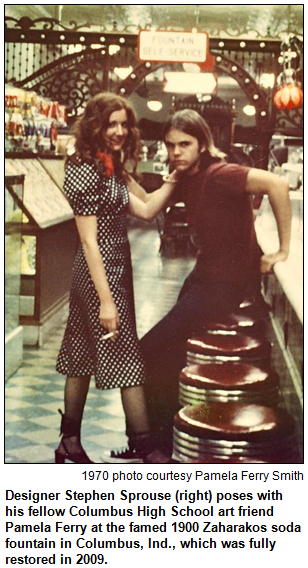 In addition to the creations of Blass, Norell and Halston, works by another top fashion designer are featured in the IMA exhibit. Stephen Sprouse (1953-2004), who grew up in Columbus, got his start working for Halston in the late 1970s. Influenced by punk rock and graffiti, he introduced what the IMA calls "street style" to high fashion. Like Halston, Sprouse died after a fast-paced lifestyle.
In addition to the creations of Blass, Norell and Halston, works by another top fashion designer are featured in the IMA exhibit. Stephen Sprouse (1953-2004), who grew up in Columbus, got his start working for Halston in the late 1970s. Influenced by punk rock and graffiti, he introduced what the IMA calls "street style" to high fashion. Like Halston, Sprouse died after a fast-paced lifestyle.- In addition to being the home state of top designers, Indiana also produced the fashion industry's best-known publicist. Crawfordsville native Eleanor Lambert (1903-2003) revolutionized fashion coverage by inventing the International Best Dressed List in 1940.
- During World War II when restrictions were placed on fabrics such as silk, Norell used sequins and jewels on dresses to mask cheaper fabrics. Eventually, his sequined "mermaid" sheaths in various fabrics became one of his signature styles; they also became some of the most expensive dresses in America.
- Partially because of the impact of World War II on French designers, Norell elevated the American fashion industry to unparalleled esteem in the 1940s. "Made Seventh Avenue the Rival of Paris" was the front-page headline in The New York Times when Norell died in 1972.
- In his posthumously published autobiography Bare Blass (HarperCollins, 2002), Bill Blass indicates his boyhood interest in fashion was inspired in part by a fellow Fort Wayne native. While watching movies, he was intrigued by the glamorous gowns worn by actress Carole Lombard.
History Mystery
On Monument Circle in downtown Indy, a department store replaced the lavish English Theater and Opera House, which had been built in the 1880s. The demolition in the late 1940s of the ornate English structures, which also included a hotel, to make way for the new department store continues to be regarded as an outrage by historic preservationists.
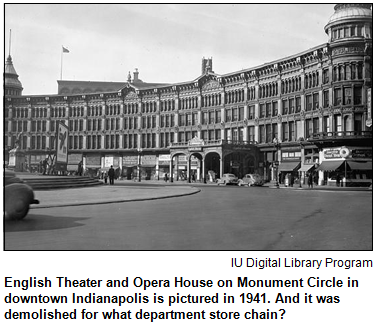 The department store, part of a national chain, was in a building that, like its English predecessors, was curved to mimic the curve of Monument Circle. The department store remained on the Circle for not quite 30 years, closing during the 1970s with the decline in downtown shopping before the rejuvenation of downtown.
The department store, part of a national chain, was in a building that, like its English predecessors, was curved to mimic the curve of Monument Circle. The department store remained on the Circle for not quite 30 years, closing during the 1970s with the decline in downtown shopping before the rejuvenation of downtown.
Question: Name the department store.
This week's prize was a gift certificate to Tastings at the Conrad Hotel in downtown Indianapolis, courtesy of the ICVA. The prize package also includes a pair of admissions to Conner Prairie Interactive History Park, as well as a pair of 1859 Balloon Voyage tickets, courtesy of Conner Prairie.
By the way, a big congratulations to last week's winner, who called in from the Irvington Library Hoosier History Live! listening group. The group meets informally each week to listen to the live show. Thanks to the Indianapolis Public Library, Irvington Branch, for providing a place for the group to meet, as well as a radio and books and other "learn more" materials that pertain to the show's topic. The group welcomes new members.
By the way, it's easy to form your own listening group; all you need is a quiet space to meet weekly and access to a radio and/or a laptop for online listening. It's a great way to explore history in a face-to-face setting. If you are a small business, it's a good way to bring people into your business each week!
Roadtrip Re-trek: German Park on Indy's far-southside
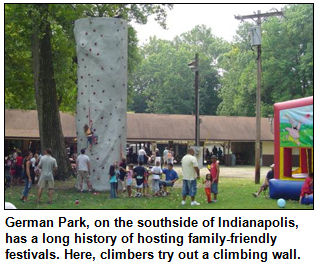 As Roadtripper Chris Gahl of the ICVA was not able to get through our ever-humming phone lines on last week's show, we thought we would again have him call in about one of Indy's hidden treasures: German Park on Indy's far southside.
As Roadtripper Chris Gahl of the ICVA was not able to get through our ever-humming phone lines on last week's show, we thought we would again have him call in about one of Indy's hidden treasures: German Park on Indy's far southside.
At German Park, you don't have to be German or have a membership card to dance the night away at the German Park summer festivals. Expect beer, brats, fun and games for the kids, and dancing in the old pavilion with a live band.
In 1881, 30 acres were purchased at 8600 S. Meridian Street to create Germania Park. Now known as German Park, the private park is owned and operated by the Federation of German Societies in Indianapolis and boasts a number of summer festivals.
The next Summerfest will be Saturday, July 21, hosted by the Indianapolis Saenger Chor. Die Freudemacher will be playing that evening, and gates open at 5 p.m. Admission for adults is $3.
Also located on the grounds of German Park is the Edelweiss Restaurant, which is open to the public for dinner Tuesday through Saturday from 5 to 9 p.m. The restaurant serves sauerbraten, wiener schnitzel and other German delights.
Civic and business leader Andre Lacy as Living Legend
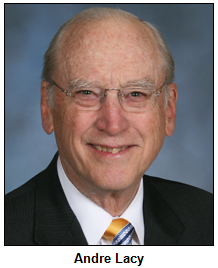 (June 23, 2012) - His towering list of civic and business endeavors - from serving as board chairman of one of Indy's largest privately held firms to leadership posts at the Indiana State Fair Commission, Indianapolis Motor Speedway Corp., Indiana Chamber of Commerce, Indianapolis Public Schools, United Way of Central Indiana and the Indianapolis 500 Festival Association - almost could stack as high as Mount Kilimanjaro.
(June 23, 2012) - His towering list of civic and business endeavors - from serving as board chairman of one of Indy's largest privately held firms to leadership posts at the Indiana State Fair Commission, Indianapolis Motor Speedway Corp., Indiana Chamber of Commerce, Indianapolis Public Schools, United Way of Central Indiana and the Indianapolis 500 Festival Association - almost could stack as high as Mount Kilimanjaro.
Adventure-seeking Andre Lacy has climbed that volcano in Tanzania. He's also an avid motorcyclist, scuba diver and whitewater rafter. Not only that, Mr. Lacy pilots a plane that he owns.
A few weeks before Mr. Lacy and his sister, civic leader Margot Lacy Eccles, are named Living Legends by the Indiana Historical Society, Mr. Lacy joins Nelson in studio for a look at his life, career, civic endeavors and passions.
Andre Lacy is the chairman of LDI Ltd., formerly Lacy Diversified Industries. It, in turn, evolved from a company founded by his grandfather, H.J. Lacy, in 1912 that became one of the country's largest makers of cardboard boxes. This year marks the 100th anniversary of the company that initially was known as U.S. Corrugated-Fibre Box.
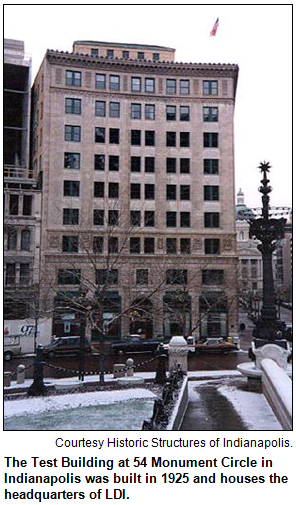 Today, LDI Ltd. is a holding company headquartered on Monument Circle that, according to a recent Indianapolis Business Journal article, has enjoyed steady growth ever since 1961, when Mr. Lacy joined the company; it now buys regional distribution businesses and helps them grow to national expansion. (Although Mr. Lacy retired as CEO in 2007, he remains board chairman.)
Today, LDI Ltd. is a holding company headquartered on Monument Circle that, according to a recent Indianapolis Business Journal article, has enjoyed steady growth ever since 1961, when Mr. Lacy joined the company; it now buys regional distribution businesses and helps them grow to national expansion. (Although Mr. Lacy retired as CEO in 2007, he remains board chairman.)
But Andre Lacy is known as much for his civic activities as his business success. Not only is he an alum of Shortridge High School (a member of the Class of '57, Mr. Lacy was inducted last month into his alma mater's hall of fame), he served as president of the IPS board in the mid-1980s.
He's also an alum of the renowned Stanley K. Lacy Executive Leadership Series, a program for emerging civic leaders. It was established in the 1970s by his mother, Edna Balz Lacy, in honor of Mr. Lacy and Mrs. Eccles' brother, who was killed in an automobile accident.
Andre Lacy and his wife, Julia, have three adult sons. One of them, J.A. Lacy, has been named chief operating officer at LDI, which, according to the IBJ, is preparing to hand off leadership to him. The IBJ also reported that Andre Lacy, despite being in his early 70s, rode a motorcycle to the Arctic Circle last year.
Yet, according to several accounts, Mr. Lacy also has agricultural roots. Active in 4-H as a youth, he worked on weekends at a family farm with dairy cattle.
 During the 1930s, his grandfather purchased farms in Speedway, Westfield and Brownsburg. According to Out of the Box: 100 Years and Counting (IBJ Book Publishing), a corporate history of LDI, one of the farms eventually became the site of Speedway High School.
During the 1930s, his grandfather purchased farms in Speedway, Westfield and Brownsburg. According to Out of the Box: 100 Years and Counting (IBJ Book Publishing), a corporate history of LDI, one of the farms eventually became the site of Speedway High School.
"Even to this day, I can tell you the butterfat content properties relative to Jersey and Guernsey and Holstein cattle," Andre Lacy told The Indianapolis News in 1987.
Long before Mr. Lacy's teenage years in the 1950s, his family's business had become a national force in the packaging industry. During the 1920s, corrugated boxes replaced wooden crates as the major way of shipping many products, including fruits and vegetables.
Upon the sudden death of Andre Lacy's father, Howard J. Lacy II, in 1959, Edna Lacy became chairman of the company, making her one of the first women executives of a major Indiana business. 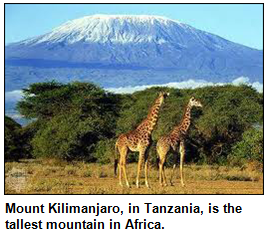 (After graduating from college, Andre Lacy joined the company and worked for years with his mother, who died in 1991.) The company was renamed Lacy Diversified Industries in 1972, and later LDI.
(After graduating from college, Andre Lacy joined the company and worked for years with his mother, who died in 1991.) The company was renamed Lacy Diversified Industries in 1972, and later LDI.
Away from the office, Mr. Lacy has a full schedule with his civic endeavors and various adventures. According to Out of the Box, he has attended every Indianapolis 500 race since he was 7 years old. His enthusiasm for motorcycles revved up when LDI acquired Tucker Rocky, a Texas-based distributor of motorcycle parts.
So there's much turf for us to cover with this Living Legend-to-be.
By the way, other Hoosiers named Legends at the historical society's annual gala include a fellow inductee into the Shortridge hall of fame: Max Schumacher, the longtime president of the Indianapolis Indians. Others to be named Legends at the July 20 gala are Gerald and Dorit Paul, arts and cultural leaders in Indy.
History Mystery
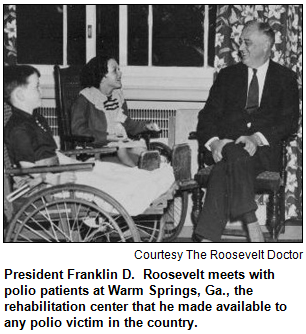 Our History Mystery is a carry-over from last week, when there wasn't a correct answer. The question concerns one of Franklin D. Roosevelt's visits to Indiana.
Our History Mystery is a carry-over from last week, when there wasn't a correct answer. The question concerns one of Franklin D. Roosevelt's visits to Indiana.
During a visit while president in the 1930s, FDR attended the dedication of a massive memorial in southern Indiana. The memorial, which honors a military leader who shaped Indiana's history, is said to be the largest memorial west of Washington, D.C., that pays tribute to an individual.
Question: Name the famous historic figure honored with the memorial dedicated by President Roosevelt.
Hint: It's not a memorial to Benjamin Harrison, which was an incorrect guess by a caller last week.
This week's prize was four tickets to the Indiana Experience, including You Are There: 1955: Ending Polio. These tickets are courtesy of the Indiana Historical Society. You also receive a one-night stay at the Fairfield Inn by Marriott Indianapolis Downtown, which is courtesy of the ICVA.
Roadtrip: German Park on Indy's far-southside
 Hoosier History Live! has explored German heritage in Indiana in a number of past shows, but did you know that you don't have to be German, or have a membership card, to dance the night away with friends of all ages at German Park on Indy's far south side?
Hoosier History Live! has explored German heritage in Indiana in a number of past shows, but did you know that you don't have to be German, or have a membership card, to dance the night away with friends of all ages at German Park on Indy's far south side?
Roadtripper Chris Gahl of the ICVA tells us that back in 1881, 30 acres was purchased at 8600 S. Meridian Street to create Germania Park. Now known as German Park, the private park is owned and operated by the Federation of German Societies in Indianapolis and boasts a number of summer festivals which include beer, brats, live bands, dancing in the old pavilion and fun and games for the kids.
This Saturday night, June 23, German Park is open to the public for a Summerfest from 5 to 11 p.m. with live music by Alpine Express. Admission is $3, and children under 12 are admitted for free.
Also located on the grounds of German Park is the Edelweiss Restaurant, which is open to the public for dinner Tuesday through Saturday from 5 to 9 p.m. The restaurant serves sauerbraten, wiener schnitzel and other German delights. Don't be surprised if an accordion player stops by your table while you dine.
Polio epidemic during the 1940s and '50s
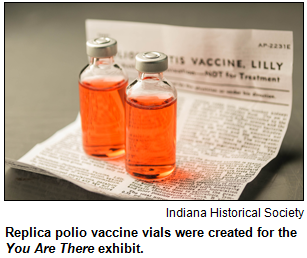 (June 16, 2012) - With its devastating impact and its tendency to strike children, teenagers and young adults, polio created widespread panic during the 1940s and '50s. Epidemics of the often-fatal disease occurred in earlier decades as well, but Hoosier History Live! will focus on the 1940s and '50s because of some significant aspects that unfolded in Indiana then.
(June 16, 2012) - With its devastating impact and its tendency to strike children, teenagers and young adults, polio created widespread panic during the 1940s and '50s. Epidemics of the often-fatal disease occurred in earlier decades as well, but Hoosier History Live! will focus on the 1940s and '50s because of some significant aspects that unfolded in Indiana then.
"It was so frightening because, even though we knew polio was caused by a virus, we didn't know how it was being transmitted," recalls Wanda Fortune, an Indianapolis civic leader who is one of Nelson's guests.
"Feeding the fear," says Eloise Batic, "was that the treatments seemed to be as frightening as polio itself. The image of an iron lung terrified people, particularly children."
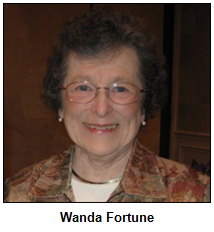 Eloise, the director of exhibitions research for the Indiana Historical Society, joins Nelson and Wanda on our show to share insights about the era and the Hoosier aspects.
Eloise, the director of exhibitions research for the Indiana Historical Society, joins Nelson and Wanda on our show to share insights about the era and the Hoosier aspects.
Wanda has been widowed twice. Both of her husbands were involved with the "polio story" as it unfolded in the Hoosier capital. Her first husband, a surgeon who was treating child patients with polio in 1945, contracted the disease himself and spent a week in an iron lung. Her second husband was a top analytical chemist at Eli Lilly and Co. in the 1950s.
That's the era depicted by the historical society in a new "You Are There" multimedia exhibit that is set on the Lilly campus, where employees rushed to pack vials of the new vaccine discovered by Dr. Jonas Salk.
More than 20,000 cases of polio were reported every year across the country during the early 1950s. According to the historical society, about 75 percent of the cases in 1954 - the year before Salk developed his vaccine - occurred in people under age 20.
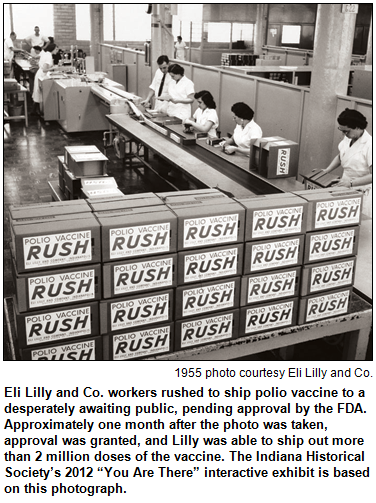 The peak years for the polio epidemic in Indiana were 1949 (when 1,147 cases were reported) and 1954 (with 1,448 cases), according to the historical society.
The peak years for the polio epidemic in Indiana were 1949 (when 1,147 cases were reported) and 1954 (with 1,448 cases), according to the historical society.
In the mid-1940s, Wanda's first husband, Dr. K. Randolph Manning, was in his residency as a young orthopedic surgeon. He was treating child patients at Indianapolis hospitals when he was afflicted with polio; Wanda had been married to him for just three months.
"Randy was very fortunate because he recovered and was able to resume a full life, including his medical practice," she says.
Her second husband, Dr. Brooks Fortune, helped oversee research and development (as well as quality control) at Lilly. Wanda married him long after 1955. That's when employees - including women assembly workers at Lilly depicted in a photo that has inspired the new Indiana Experience at the Eugene and Marilyn Glick Indiana History Center - hurried to pack and send the vaccine around the world. Salk's discovery of the polio vaccine is considered one of the greatest medical breakthroughs in history.
Lilly was one of five companies across the country funded by the National Foundation for Infantile Paralysis (which later became the March of Dimes) to begin, in advance, mass production and distribution of the Salk vaccine.
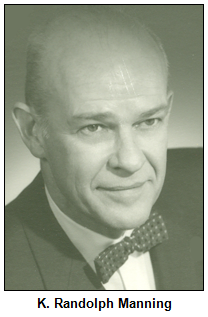 The polio virus, spread by contaminated water or food, entered the central nervous system of victims. In severe cases, it caused lifelong paralysis or death. Although cases of polio had been reported in the United States before the 20th century, the first major epidemic occurred in 1916, when more than 27,000 people were paralyzed and 6,000 died, according to the historical society. After 1916, polio outbreaks occurred almost every summer.
The polio virus, spread by contaminated water or food, entered the central nervous system of victims. In severe cases, it caused lifelong paralysis or death. Although cases of polio had been reported in the United States before the 20th century, the first major epidemic occurred in 1916, when more than 27,000 people were paralyzed and 6,000 died, according to the historical society. After 1916, polio outbreaks occurred almost every summer.
Treatments before the Salk vaccine - hailed as a miracle - included surgeries to lengthen tendons and limbs; electrotherapy; the "Sister Kenny" treatment (named for an Australian nurse) that involved the application of hot, moist packs to relieve muscle spasms as well as forms of physical therapy; injections of antibody serums and the iron lung.
A pediatric iron lung - used for infants and toddlers stricken with the virus - is displayed in the historical society's You Are There exhibit; it is on loan from the Indiana Medical History Museum.
Some victims remained in iron lungs for years. Fortunately, Dr. Manning, Wanda's husband, spent only about one week in an iron lung before he began to recover.
Not only was he able to resume treating young patients, Dr. Manning and Wanda had four children of their own. When they married, Wanda had been training to be a nurse in Indianapolis; one of her nursing-school classmates was stricken with the polio virus and has suffered extensive paralysis ever since.
 Wanda, a member of the historical society's board of trustees, was widowed in 1984 after nearly 40 years of marriage. In 1990, she married Dr. Fortune, the analytical chemist who had an extensive career at Lilly. Even decades later, Dr. Fortune was being thanked by physicians as far away as South Korea for his role in overseeing the manufacture of the Salk vaccine, which was shipped around the world from the Lilly production and packaging center.
Wanda, a member of the historical society's board of trustees, was widowed in 1984 after nearly 40 years of marriage. In 1990, she married Dr. Fortune, the analytical chemist who had an extensive career at Lilly. Even decades later, Dr. Fortune was being thanked by physicians as far away as South Korea for his role in overseeing the manufacture of the Salk vaccine, which was shipped around the world from the Lilly production and packaging center.
"Lilly was a well-oiled machine by the time the Salk vaccine was becoming available," Eloise notes. The manufacturing and packaging at Lilly began in March 1955 - a photo that inspired the new exhibit was taken March 16 at Building 314 on Lilly's campus - even though the Salk vaccine wasn't approved for distribution until April. That way, shipments were ready instantly.
By 1960, polio cases in America had dropped to just 3,000, according to the historical society. In 1970, there were about 10 cases in the country. Elsewhere in the world, where access to the Salk vaccine is difficult, polio remains a concern.
History Mystery
 Franklin D. Roosevelt, one of the nation's best-known polio victims, visited Indiana several times. During a visit while president in the 1930s, FDR attended the dedication of a massive memorial in southern Indiana. The memorial, which honors a military leader who shaped Indiana's history, is said to be the largest memorial west of Washington D.C. that pays tribute to an individual.
Franklin D. Roosevelt, one of the nation's best-known polio victims, visited Indiana several times. During a visit while president in the 1930s, FDR attended the dedication of a massive memorial in southern Indiana. The memorial, which honors a military leader who shaped Indiana's history, is said to be the largest memorial west of Washington D.C. that pays tribute to an individual.
Question: Name the famous historic figure honored with the memorial dedicated by President Roosevelt.
This week's prize was four tickets to the Indiana Experience, including You Are There: 1955: Ending Polio. These tickets are courtesy of the Indiana Historical Society. Also: a one-night stay at the Fairfield Inn by Marriott Indianapolis Downtown, which is courtesy of the ICVA.
Roadtripper: Pine Hills Nature Preserve
We welcome back Roadtripper Chris Gahl of the ICVA to our airwaves! He tells us about Pines Hills Nature Preserve southwest of Crawfordsville, which is a hidden treasure for hikers and was also the first project of the the Nature Conservancy's Indiana Chapter.
You'll see rock formations at Pine Hills that few ever see, including the Devil's Backbone, which is a strip of rock about six feet wide with nothing but sheer cliff on either side of it. You'll also see graffiti from the 1850s, and it's also very near to Shades State Park. Have a great hike, and this suggestion is courtesy of Eric Grayson.
Very first Hoosiers: ancient people here
 (June 9, 2012) - Nearly 11,000 years ago, people lived in the dense, mature forests that centuries later became the site of the Hoosier state. Our studio guest is an expert on these ancient human beings, what they ate, how they lived, and the animals (some long gone from Indiana; others similar to, but different in size and shape from critters found here today) with whom the people shared the wilderness.
(June 9, 2012) - Nearly 11,000 years ago, people lived in the dense, mature forests that centuries later became the site of the Hoosier state. Our studio guest is an expert on these ancient human beings, what they ate, how they lived, and the animals (some long gone from Indiana; others similar to, but different in size and shape from critters found here today) with whom the people shared the wilderness.
Dr. Christopher Schmidt, a biological anthropologist and archaeologist who is one of the most popular faculty members at the University of Indianapolis, joins Nelson in studio to share insights about the people who merit being called "the very first Hoosiers."
Chris, a lifelong Hoosier who is director of the Indiana Prehistory Laboratory at UIndy, has led excavations across the state and is credited with being a crucial part of the team that discovered the oldest known man-made tool (that can be accurately dated) in Indiana.
"These were not slow-witted cave people or aimless wanderers," Chris emphasizes. "They were hunter-gatherers who lived in groups of about 20 or 50 people. When they ventured out into foraging groups, they would often stay under natural, overhanging rock shelters. For a more extended basis, they lived in dwellings they built that were comparable to what we know as wigwams."
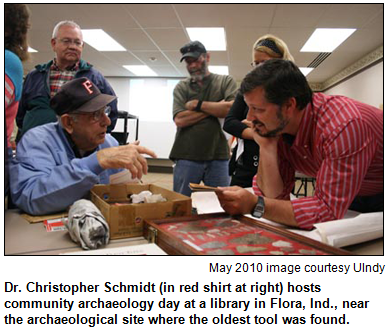 According to Chris, these first Hoosiers shared the dense forest with mastodons, giant beavers, musk ox (which have long been gone from Indiana, but can be found in Alaska today) and the peccary, a pig-like creature that was becoming extinct in the Midwest.
According to Chris, these first Hoosiers shared the dense forest with mastodons, giant beavers, musk ox (which have long been gone from Indiana, but can be found in Alaska today) and the peccary, a pig-like creature that was becoming extinct in the Midwest.
"Other animals here then would be recognizable today - white-tailed deer, bobcats, snakes, lizards and black bears," Chris says. By studying the teeth of ancient humans, Chris gains insights about their diet and the diseases they endured.
So how did these ancient people get to the future site of Indiana?
"Our best information indicates they came from the Bering Straits, then over a period of centuries, spread out," Chris says. "First, they traveled south to what became California, then some of the ancient people moved into the Midwest."
The oldest tool that's been discovered in Indiana is a prehistoric bone artifact. Determined to be about 10,400 years old, the tool was found near the town of Flora in Carroll County during an excavation by Chris and others on a UIndy archaeology team. The tool, an awl carved from the bone of a white tail deer, is stored in the Indiana Prehistory Lab in the basement of Good Hall.
 According to Chris, the first Hoosiers had a varied diet.
According to Chris, the first Hoosiers had a varied diet.
"They ate both meat and plants, including nuts, seeds and small animals," he said. "They liked to live along waterways, so there were clusters of ancient people along the Ohio River, from sites near what became Madison over to Evansville. They were not warring groups."
Fascinated by archaeology and paleontology since boyhood, Chris grew up in Indianapolis and Carmel. He was a running back on Carmel High School's varsity football team in 1986.
"My goal from the beginning has been to emphasize Indiana and its important role in what anthropologists call pre-history," he said. "Dozens of books and articles were being published about ancient people, but the area that became Indiana was being completely overlooked. In a very practical way, I've been trying to call attention to what was here."
In addition to overseeing digs in Carroll County, Chris has led excavations in Monroe, Jackson, Johnson and Dearborn counties.
History Mystery
One of the greatest leaders in Native American history was born in 1751 not far from the eventual site of Fort Wayne. He grew up in a Miami village said to be, in several ways, similar to European villages of the era.
Often described as calm and even-tempered, the Miami leader was respected both in peace and in war. His Miami warriors eventually were overwhelmed by the forces of a former Revolutionary War hero in the Battle of the Fallen Timbers in 1794. Although the Miami leader was defeated, he continued to be so respected that he lived in a lodge in northeastern Indiana until his death in 1812.
Question: Name the Native American leader.
This week's prize was an overnight stay at the Crowne Plaza Indianapolis Airport and a pair of tickets to the NCAA Hall of Champions in White River State Park. These prizes are courtesy of the ICVA.
Roadtripper: Wine Down on the Farm at Huddleston Farmhouse
Guest Roadtripper this week is Joe Frost with the Eastern Regional Office of Indiana Landmarks in Cambridge City, Ind. He'll tell us about new opportunities at Indiana Landmarks' 1841 Huddleston Farmhouse, which is located on U.S. 40, the Old National Road, about 20 miles west of Richmond and 60 miles east of Indianapolis.
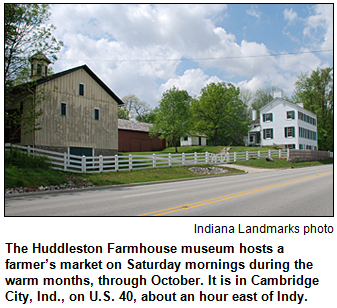 Weary travelers making the difficult trek westward on the National Road in the early 1800s stopped at the Huddleston family's farm in Cambridge City for meals, provisions, shelter and to feed and rest their horses.
Weary travelers making the difficult trek westward on the National Road in the early 1800s stopped at the Huddleston family's farm in Cambridge City for meals, provisions, shelter and to feed and rest their horses.
The Huddleston Farmhouse Museum offers visitors a glimpse of the daily lives of John and Susannah Huddleston and their 11 children, as well as the travelers who crowded the porches and yard and rented the farmhouse's two "travelers' kitchens" for cooking and sleeping.
The museum also operates as the National Road Heritage Site, where exhibits offer modern-day travelers a vivid picture of cross-country travel on the Historic National Road from Cumberland, Md., to Vandalia, Ill., from the pioneer era to the present.
New this year at the Huddleston Farmhouse is a weekly Farmers Market on Saturdays from 8 a.m. to noon from now through October. It's an opportunity to find fresh local produce, herbs, plants, flowers, arts, crafts and more.
And Joe, who also is executive director of the Indiana National Road Association, will also invite us to Wine Down on the Farm at Huddleston Farmhouse on June 28 from 5:30 to 7:30 p.m. That evening, plan to enjoy hors d'oeuvres and wine while viewing a show of paintings by Fort Wayne artist Gwen Gutwein.
And Roadtripper Chris Gahl of the ICVA will be back with us live next Saturday!
Brain chemistry and genetics studies in mental illness, addictions
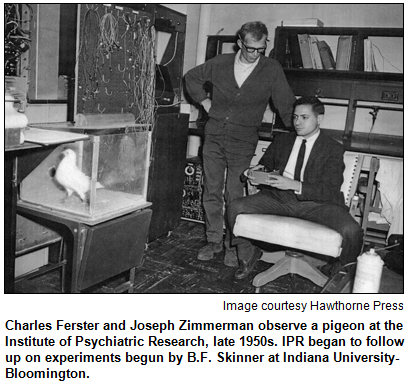 (June 2, 2012) - Folks who don't regard Indiana as cutting-edge may be surprised to learn that, beginning about 120 years ago, Hoosier researchers were pioneers in brain studies to help the mentally ill.
(June 2, 2012) - Folks who don't regard Indiana as cutting-edge may be surprised to learn that, beginning about 120 years ago, Hoosier researchers were pioneers in brain studies to help the mentally ill.
The research, which eventually included the biological aspects of addictions, had its beginnings in a two-story, brick building known as the Pathology Department on the grounds of what was then called the Central Indiana Hospital for the Insane (later Central State Hospital) on the near-westside of Indy. Today, the Pathology Department, which opened amid much fanfare in the 1890s, is the site of the Indiana Medical History Museum.
Studies that went on there - as well as subsequent lab work (including animal research that involved rats and pigeons) at the Institute of Psychiatric Researchat the IU Medical School - were at the forefront in establishing biological influences on depression, alcoholism and other mental health issues.
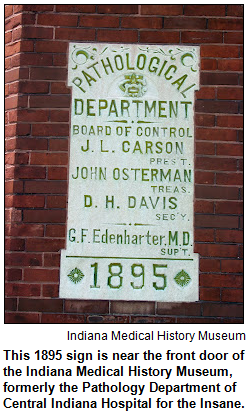 The idea for the studies, regarded as "state of the art in brain science of the time," according to two psychiatrists who will join Nelson in studio, was to "use the best in science to improve the condition of the mentally ill in Indiana."
The idea for the studies, regarded as "state of the art in brain science of the time," according to two psychiatrists who will join Nelson in studio, was to "use the best in science to improve the condition of the mentally ill in Indiana."
Nelson's guests will be Dr. Lucy Jane King and Dr. Alan Schmetzer, professors emeriti of psychiatry at the IU School of Medicine. They are co-authors of a new book, Dr. Edenharter's Dream (Hawthorne Publishing), which describes the decades of historic research in brain chemistry and genetics that unfolded in the Hoosier capital.
It began, our guests note, during an era when psychiatric hospitals were derided as "insane asylums"; mental illnesses often were attributed solely to bad parenting and other "nurture" factors.
Our guests credit Dr. George Edenharter (1857-1923), who oversaw the opening of the Pathology Department in 1896 as a house laboratory and teaching facility, with a "forward-thinking attitude" about the brain and genetics that kicked off decades of ground-breaking research.
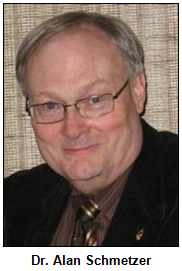 Among the Hoosiers who were affected, during an era before antibiotics, were people suffering from syphilis and other disorders that involved infections of the brain and caused symptoms similar to those created by other conditions. Because symptoms of mental illness often improved if patients experienced fevers, some Hoosiers with syphilis and other disorders deliberately were infected with mild cases of malaria, according to Dr. Edenharter's Dream.
Among the Hoosiers who were affected, during an era before antibiotics, were people suffering from syphilis and other disorders that involved infections of the brain and caused symptoms similar to those created by other conditions. Because symptoms of mental illness often improved if patients experienced fevers, some Hoosiers with syphilis and other disorders deliberately were infected with mild cases of malaria, according to Dr. Edenharter's Dream.
Decades later, studies with inbred rats - including some that preferred alcohol to other rewards - helped clarify various types of alcoholism in people, including binge drinking. Rat and pigeon research at the Institute for Psychiatric Research also clarified the impact of serotonin in mood disorders such as major depression, according to Dr. King and Dr. Schmetzer.
They trace the decades of brain and genetics research in Indiana to the studies undertaken at the Pathology Department, which had an autopsy room and labs equipped with low-level microscopes in the early 1900s.
"This was state-of-the-art at the time," Dr. King said during a recent presentation at the Indiana Medical History Museum, 3045 W. Vermont St. In their book, Dr. King and Dr. Schmetzer describe the Pathology Department as "a national model visited by psychiatrists from around the country."
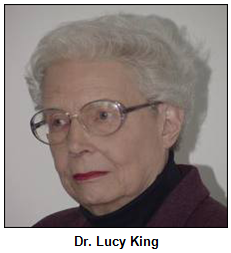 Dr. King noted the Pathology Department, because it was a teaching facility located on the grounds of the state hospital, "was the first place in the United States where all of the components of psychiatry came together - patients, education and research."
Dr. King noted the Pathology Department, because it was a teaching facility located on the grounds of the state hospital, "was the first place in the United States where all of the components of psychiatry came together - patients, education and research."
An auditorium in the Pathology Department-turned-Medical History Museum was used for lectures and demonstrations to medical students about the influences of brain chemistry and genetics on mental disorders.
"When it opened, the building housed the largest research facility in the state, even larger than the laboratories at Indianapolis City Hospital (later Wishard) or the medical colleges," according to Destination Indiana (Indiana Historical Society Press) by historian Ray Boomhower, a frequent Hoosier History Live! guest.
 Our upcoming guests Dr. King and Dr. Schmetzer have had long, distinguished careers in psychiatry.
Our upcoming guests Dr. King and Dr. Schmetzer have had long, distinguished careers in psychiatry.
Dr. King has written about the early years of what became Central State Hospital - and the lives of patients there - in a previous book, From Under the Cloud at Seven Steeples. (At Central State, a long-demolished building that housed women patients was known as "Seven Steeples" because of its distinctive architecture.)
Dr. Schmetzer interacted with many of the psychiatric researchers of recent decades described in Dr. Edenharter's Dream. The book also recounts the impact of Larue Carter Memorial Hospital, a psychiatric hospital that opened in 1952, on Cold Spring Road, and the rat and pigeon studies undertaken in the 1950s and '60s at the nearby Institute of Psychiatric Research. (Larue Carter and the research institute were connected by an underground tunnel.)
During the era of the animal research, Dr. Edenharter had been dead for about 30 years. His funeral, Dr. King notes, was on the grounds of the Central Indiana Hospital for the Insane, which was renamed Central State in 1927. It was closed in 1994.
Note: The guests for this live program had originally been scheduled to appear on May 5, but Hoosier History Live! was pre-empted that day.
History Mystery
An Indiana governor during the 1950s campaigned on a platform that included reforms of mental health treatment. A native of Brazil, Ind., he was a Republican who had been a trial lawyer. During World War II, the future governor participated in the Normandy invasion on June 6, 1944, and became a personal friend of Dwight Eisenhower. Before serving as governor, he was national commander of the American Legion.
Question: Who was the Indiana governor?
This week's prize wais a pair of tickets to Conner Prairie Interactive History Park, courtesy of Conner Prairie, as well as a one-night stay at University Place Hotel on the IUPUI campus, courtesy of the ICVA.
Roadtripper: History on tap at Conner Prairie
With Roadtripper Chris Gahl of the ICVA spending some quality time with VIPs this weekend (his family!), a guest Roadtripper called in to suggest that we check out "History on Tap" at Conner Prairie Interactive History Park the evening of Friday, June 15.
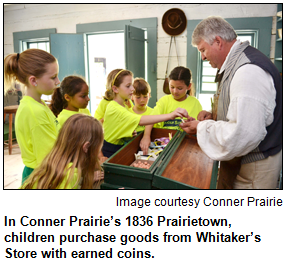 The park's first-ever craft beer event is being hosted by Conner Prairie Horizon Council, the park's young professionals group. A highlight of the evening will include a short beer brewed on site by Conner Prairie's costumed staff in 1836 Prairietown.
The park's first-ever craft beer event is being hosted by Conner Prairie Horizon Council, the park's young professionals group. A highlight of the evening will include a short beer brewed on site by Conner Prairie's costumed staff in 1836 Prairietown.
But, backing up a bit, don't forget that the 1836 Prairietown Grand Reopening weekend celebration will be June 9 and 10, unveiling new experiences, adventures and structures, including a brand-new entry portal to help orient guests to what life was like in 1836.
Special activities for the weekend will include a land auction where guests can bid on and "purchase" their own piece of Prairietown. Guests will also be able to visit the new Barker Brothers' Pottery Shop and, for an additional fee, participate in a new make-and-take pottery activity. A party will also be held throughout the town that includes music, dancing, games and more. Puppet shows, participatory plays, crafts and even a few surprises are in store for visitors during the weekend celebration as well.
Don’t forget that the Allisonville Road bridge over I-465 on the northeast side of Indianapolis will be closed this summer, so be sure to check out the Conner Prairie website for an alternative route.
Nelson appears on Legally Speaking show
(June 2, 2012) - If you aren't already in the routine of tuning in to WICR-FM (88.7) before Hoosier History Live! on Saturday mornings, one more reason to listen is the show Legally Speaking at 10 a.m. Our host Nelson Price was the studio guest of our good friend and WICR colleague, attorney Charles Braun, the host of Legally Speaking. His show is the longest-running call-in legal advice program on the air in the country.
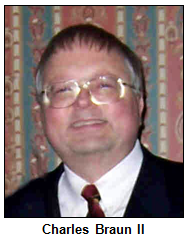 Charles invited Nelson to share insights about "The Art of Interviewing." A veteran journalist who was a feature writer/columnist for 20 years with The Indianapolis Star and its sister newspaper, the former Indianapolis News, Nelson has interviewed thousands of Hoosiers. He also has taught classes in interviewing - often titled "Making People Talk" - at the Writers' Center of Indiana (where he's a board member) and at Indiana University-Purdue University at Indianapolis, where Nelson has shared interviewing tips for an array of people, from professionals in sales and marketing to volunteers putting together church, family and neighborhood histories.
Charles invited Nelson to share insights about "The Art of Interviewing." A veteran journalist who was a feature writer/columnist for 20 years with The Indianapolis Star and its sister newspaper, the former Indianapolis News, Nelson has interviewed thousands of Hoosiers. He also has taught classes in interviewing - often titled "Making People Talk" - at the Writers' Center of Indiana (where he's a board member) and at Indiana University-Purdue University at Indianapolis, where Nelson has shared interviewing tips for an array of people, from professionals in sales and marketing to volunteers putting together church, family and neighborhood histories.
Nelson shared his favorite (and least favorite) interview questions. He also talked about how to handle sensitive issues, tips for getting people to elaborate in their responses, the best (and worst) interview settings, and the legal and ethical issues of taping interviews, including phone interviews.
Cuban immigration to Indiana
(May 26, 2012) - Not only does guest Danny Lopez have perspectives to share on the topic of Cuban heritage - all four of his grandparents left their homeland in 1960, fleeing political and economic upheavals - he also has broader insights about Hispanic and Latino demographics. He's the executive director of the Indiana Commission on Hispanic/Latino Affairs.
So Danny joins Nelson in studio for this show, one in our rotating series about ethnic immigration to the Hoosier state. Hoosier History Live! has explored our German, Irish, Italian, Greek, Scottish, Brazilian and even our Sikh heritage in Indiana.
 Referring to 2010 U.S. Census data, Danny notes that the number of Hoosiers with Hispanic/Latino heritage nearly has doubled since the turn of the new century, climbing to 389,000.
Referring to 2010 U.S. Census data, Danny notes that the number of Hoosiers with Hispanic/Latino heritage nearly has doubled since the turn of the new century, climbing to 389,000.
About 85 percent are of Mexican heritage. The next largest ethnic groups of Hispanic/Latino heritage in Indiana, according to Danny, are Puerto Ricans, followed by Cubans.
Unlike surrounding Midwestern states that have experienced only slight population increases or, in the case of Michigan, even lost residents since the turn of the 21st century, Indiana's population climbed 6.6 percent. According to an Indianapolis Star analysis of 2010 U.S. Census data, Hispanics accounted for 43 percent of the population increase in the Hoosier state.
Cuban-Americans here (there are 4,300 of them, Danny Lopez reports) differ from their counterparts from other Latin homelands in several ways.
According to Danny, the largest concentrations of the 4,300 people of Cuban heritage live in South Bend and Fort Wayne. He attributes that to the impact for several generations drawn by, respectively, the University of Notre Dame as well as by Catholic parishes that have assisted Cuban families, including children in the early 1960s, who were evacuated because of the Fidel Castro regime.
Regarding the overall Hispanic/Latino population, though, the largest concentrations are in Indianapolis and Lake County. The average age of Hoosiers of Hispanic/Latino heritage is younger than those of many other ethnic immigration groups here, Danny notes.
Danny has been a Hoosier since 2008. He grew up in Miami and graduated from an all-male, Jesuit-run preparatory school there that had been attended by his ancestors in Havana. Jesuit priests re-established the school in Miami after Castro (despite being an alumnus himself) shut it down and converted the building into an armory, according to Danny.
With his wife, who also is Cuban-American and working on a graduate degree at IU, Danny lives in Bloomington. He commutes to Indy for his job with state government, where he also is the education director for the Indiana Civil Rights Commission. Previously, Danny spent two years as a top staff member with Bloomington Mayor Mark Kruzan.
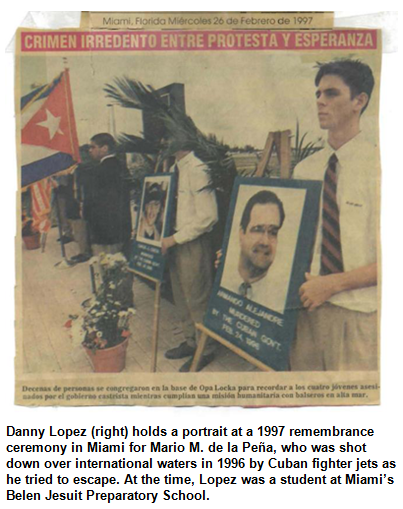 His wife's grandfather graduated from Notre Dame. Danny's paternal grandfather attended his alma mater, the all-male, Jesuit-run prep school, but it had a different setting then. The prep school was based in Havana (not Miami) during his grandfather’s era.
His wife's grandfather graduated from Notre Dame. Danny's paternal grandfather attended his alma mater, the all-male, Jesuit-run prep school, but it had a different setting then. The prep school was based in Havana (not Miami) during his grandfather’s era.
With increasing waves of Hispanic/Latino immigration to Indiana and other states, concerns have been expressed about "linguistically challenged" children in schools. In some immigrant households, as Danny notes, young children are the only English speakers among the family members.
But Danny also emphasizes that a reverse effect has the potential for unnecessarily limiting the advancement and talents of Hispanic and Latino children.
"We have concerns that many Hispanic families are not encouraging their kids to develop, or even keep, their fluency in Spanish," he said. "The parents want their children to assimilate so badly that they are discouraging their Spanish language usage. Obviously, though, fluency in Spanish will be a tremendous asset for professional opportunities later in life."
Another issue concerns the terms "Hispanic" and "Latino." Although often used interchangeably, the terms actually have different meanings and connotations with various ethnic heritage groups, an issue discussed last June on Hoosier History Live! during our show about Brazilian immigration. Nelson plans to have Danny share his insights on this topic, which has affected the way people have described themselves on census forms.
"Learn more" web links:
- Here is a video of an interview with guest Danny Lopez on Newsmakers from WNIN in Evansville, Ind., about Hispanic and Latino affairs.
- Here is an article from the Miami Herald about "Operation Peter Pan" or "Pedro Pan." From 1960 to 1962, about 14,000 Cuban children were flown to Miami as refugees without their parents because their parents feared for their safety under Castro.
- Here is a CNBC video about the Pedro Pan airlift with some great historic footage of the children in the early 1960s and their reunion some 50 years later.
- Here is a report from the Kelley School of Business about Indiana's Latino population.
History Mystery
During the 1990s, a city in Indiana elected a Hispanic mayor, one of the first in the state. He won two terms in office as mayor of the Hoosier city, serving from 1996 to 2003. A Democrat, he is the son of Spanish immigrants and was just 35 years old when he first won election as mayor of the city, which has been gaining population for several years. During his second term in city hall - in 2002 - the mayor launched an unsuccessful campaign for Indiana secretary of state.
Question: Name the city in Indiana that had a two-term mayor of Hispanic heritage beginning in 1996.
This week's prize was a pair of tickets to Conner Prairie Interactive History Park, courtesy of Conner Prairie, as well as a one-night stay at Residence Inn by Marriott in downtown Indianapolis on the canal, courtesy of the ICVA.
Guest Roadtripper: Ernesto Gonzalez
As Roadtripper Chris Gahl of the ICVA was playing host to visiting VIPs this race weekend, we thought we'd take the opportunity to have Cuban-born Indy resident Ernesto Gonzalez fill in for Chris with a report on the Latin and salsa dance scene in Indy, be it the Jazz Kitchen, the Red Room, or ... well, Ernesto is an active dancer and will have to tell us.
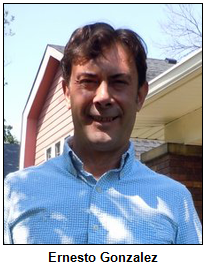 Ernesto came to Indy in 1980 as a 17-year-old, being sponsored by the Indiana Catholic Conference at 1400 N. Meridian St. in downtown Indianapolis.
Ernesto came to Indy in 1980 as a 17-year-old, being sponsored by the Indiana Catholic Conference at 1400 N. Meridian St. in downtown Indianapolis.
"I came as a political refugee, completely by myself, speaking no English, with only the clothes on my back," he says.
Ernesto has worked in Indianapolis as a hair designer for 32 years.
"America provides opportunities," he says. "I believe in hard work, and in reaping the rewards of hard work. I also believe that it is very important for everyone coming to this country to learn English."
Ernesto's parents and three siblings still live in Cuba, and 15 years ago Ernesto sponsored one of his brothers in moving to Indianapolis.
Janie and Kindergarten College: pioneers of children's TV
 (May 19, 2012 - encore presentation) - To thousands of Baby Boomer and Gen X children across central Indiana and beyond, the hosts of two daily TV shows seemed more famous than Hollywood movie stars.
(May 19, 2012 - encore presentation) - To thousands of Baby Boomer and Gen X children across central Indiana and beyond, the hosts of two daily TV shows seemed more famous than Hollywood movie stars.
As the ukulele-playing, puppet-befriending and child-focused star of Popeye and Janie (later known as just Janie when her popularity eclipsed that of the cartoon character), Janie Woods Hodge enjoyed a spectacular run on WTTV-Channel 4, appearing every weekday from 1963 to 1986.
Not only does the indefatigable Janie join Nelson in studio for this encore broadcast of one of the most popular shows in our Hoosier History Live! archives (its original air date was May 7, 2011), another perky pioneer of children's TV in Indiana also is a studio guest.
She is Indianapolis civic leader Pat Garrett Rooney, who, as Pat Garrett (or just "Pat," as she was known on the air to rotating groups of children who joined her) was the host of Kindergarten College, a show seen daily on Channel 13 (then an ABC affiliate) from 1957 through 1973.
Janie's show, which was stuffed with everything from safety tips to a segment called "Janie's Tree House" that featured local Boy Scout, Girl Scout and Brownie troops, became so popular it was syndicated to TV markets across Indiana and as far away as Illinois, Ohio and West Virginia.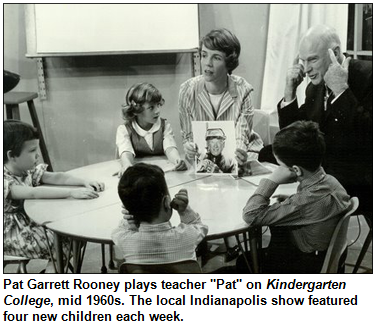
And get this, kids: For most of the span that Janie was hosting a live daily TV show, she also was working as a music teacher at Indianapolis Public Schools. Plus, she was the mother of two young sons.
Similarly, Pat was the mother of two young children when she began Kindergarten College. She was the host of Indianapolis-based Kindergarten College from 1963 to 1966, when she bowed out due to her pregnancy with her third child, a daughter. (In that era, a pregnant woman was verboten on children's shows. During our show, Pat shares an anecdote about a curious boy who couldn’t resist commenting on her appearance and wardrobe.)
So how do the grown-up Baby Boomers and Gen X fans - Nelson unabashedly counts himself among their legion - explain the impact and appeal of Janie to newbies to Indiana? Or to those too young to have enjoyed her effervescence?
Suffice it to say Popeye and Janie regularly beat NBC-TV's juggernaut, The Today Show, in the ratings across central Indiana. And that Janie interviewed celebrities such as Betty Ford when the then-first lady visited the Children's Museum.
As many Hoosiers know, Janie gave a big leg up (or should we say a boot up?) to a young vocalist named Bob Glaze. As Cowboy Bob, he joined Janie on the air, cut a wildly popular album of Christmas songs with her in 1968, and then became the host of his own show on WTTV-Channel 4.
Janie's gigs included narrating Peter and the Wolf with the Indianapolis Symphony Orchestra and performing at Lollipop Concerts attended by hundreds of captivated youngsters. On Kindergarten College, youngsters joined Pat for "Breakfast with Santa," "Breakfast at Easter" and other celebratory events.
So during our show, the two TV pioneers share a trove of memories, insights and anecdotes involving animal guests (visitors from the Indianapolis Zoo and pet shops were frequent guests on Janie and Kindergarten College), curious kids and special programs, including Janie's live broadcasts from the Indiana State Fair.
Remarkable life of Herman B Wells
 (May 12, 2012) - For six generations, he was "Mr. IU" - the pre-eminent personality associated with the Bloomington campus of Indiana University. Beloved for his jovial disposition and nationally acclaimed as a visionary, Herman B Wells had a glorious life, but also a much more complex one than many admirers realized.
(May 12, 2012) - For six generations, he was "Mr. IU" - the pre-eminent personality associated with the Bloomington campus of Indiana University. Beloved for his jovial disposition and nationally acclaimed as a visionary, Herman B Wells had a glorious life, but also a much more complex one than many admirers realized.
As an eagerly anticipated new biography points out, a pattern of suicides ran in the family of the rotund, gregarious educator whom many Hoosiers likened to Santa Claus. (During his run as IU president from the 1930s to the early 1960s - and then for an additional 35 years as the chancellor - Herman B Wells donned a white beard to portray St. Nick during holiday seasons.)
To explore the long life (1902-2000) of the man whose other nicknames included "Hermie," Nelson is joined in studio by James Capshew, who first met the legendary figure when he was hired in the late 1970s to work as the chancellor's houseboy.
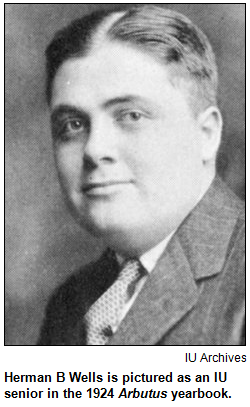 Today, Jim is an associate professor of history and philosophy of science at I.U. as well as the author of Herman B Wells (I.U. Press), a biography that also describes social history as it unfolded during the 97 years that Dr. Wells lived.
Today, Jim is an associate professor of history and philosophy of science at I.U. as well as the author of Herman B Wells (I.U. Press), a biography that also describes social history as it unfolded during the 97 years that Dr. Wells lived.
Jim's book details Herman B Wells' stealth-like, crucial roles in racially integrating aspects of IU ranging from the Commons dining facility in the student union to the basketball court and the swimming pool.
Dr. Wells also used his clout to defend sex researcher Alfred Kinsey, whose work at IU came under fire in the 1950s.
"Either you have academic freedom or you don't," Dr. Wells told Nelson, our host, who includes him in his book Indiana Legends: Famous Hoosiers from Johnny Appleseed to David Letterman. "There is no compromise. Without it, you don’t have a university. You have a trade school."
Describing Herman B Wells as "empathetic, shrewd and charming," Jim Capshew writes: "Wells built an institution, and, in the process, became one himself."
When Wells, a native of Boone County and a fifth-generation Hoosier, arrived as a student at IU in 1921, the student body totaled 2,500; more than 90 percent were from Indiana. The size and demographics of the student body - along with a staggering array of other aspects of I.U. - were about to be transformed.
Barely 35 years old in 1937 when he was named IU president (initially on an interim basis), Herman B Wells was the youngest college president in America then. He already had made a statewide name for himself by helping put together what Jim Capshew calls "a comprehensive reform package" that helped save Indiana's banks during the Great Depression.
 His father, Granville, was a banker in Lebanon who had been a schoolteacher, as had Wells' beloved mother, Bernice, who became a familiar figure to generations of IU students. ("Mother Wells" lived with her son, a lifelong bachelor, until her death.)
His father, Granville, was a banker in Lebanon who had been a schoolteacher, as had Wells' beloved mother, Bernice, who became a familiar figure to generations of IU students. ("Mother Wells" lived with her son, a lifelong bachelor, until her death.)
As Jim, our guest, recounts in his new book, Granville Wells suffered from a mood disorder, was often "withdrawn and morose" and killed himself in the 1940s. More than 30 years earlier, when Herman was 12 years old, his paternal grandmother had committed suicide.
In contrast, Jim writes, Herman B Wells "projected radiant savoir faire," exhibited tremendous interpersonal skills and had a remarkable memory for names and faces. An opera lover who had been an economics professor before becoming an administrator, Dr. Wells often is credited as the impetus for elevating IU's music and business schools by, among other things, courting outstanding deans to Bloomington.
In the aftermath of World War II, Wells took a leave from the IU presidency to serve as a cultural affairs advisor in the reconstruction of Europe. About the same time, Dr. Wells prevailed on IU's basketball coach, Branch McCracken, to recruit Bill Garrett, an African-American high school basketball star from Shelbyville, thereby shattering the color barrier in Big 10 basketball.
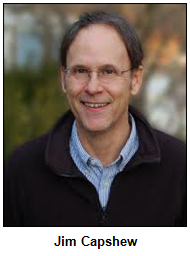 When Dr. Wells was awarded his honorary doctorate, IU's trustees praised him as an "educator, statesman, leader of men, devoted Hoosier and also a wise citizen of the world."
When Dr. Wells was awarded his honorary doctorate, IU's trustees praised him as an "educator, statesman, leader of men, devoted Hoosier and also a wise citizen of the world."
Some fun facts:
- Surprisingly, young Herman B Wells was not a distinguished student during his undergrad years in the 1920s. According to Jim Capshew's biography, his grades primarily were Bs and Cs.
- Jim's book also describes how, at age 15, Herman B Wells suffered from a severe case of the mumps that left him with persistent groin pain for several years.
- Jim Capshew grew up in Bloomington. Early in his tenure as Dr. Wells' houseboy, he escorted the legendary educator to the Brown County Playhouse - and watched in awe as fellow theater-goers spontaneously gave his boss a prolonged standing ovation.
History Mystery
Because of his distinguished career and undeniable impact, Herman B Wells received honorary degrees, including an honorary doctorate from Indiana University.
Despite that, another influential and famous Hoosier - not Herman B Wells - is listed in the Guinness Book of World Records as having more honorary degrees than anyone in the world.
Question: Name the famous Hoosier.
This week's prize is a gift certificate to any of the Occasions Divine restaurants, which include Serenity, Serendipity 2, Signature, and Scrumptious, as well as an overnight stay at University Place Conference Center and Hotel on the IUPUI campus. These prizes are courtesy of the ICVA.
Roadtripper: Rotary Jail in Crawfordsville
Roadtripper Chris Gahl of the ICVA tells us that Indiana boasts the only known working "rotary jail" still in existence. Mother may have had something different in mind when you told her you'd take her out for a "spin," but the Montgomery County Rotary Jail Museum is off I-74 west of Indianapolis in Crawfordsville. The unique jail first opened in 1882.
 Builders William H. Brown and Benjamin F. Haugh of Indianapolis believed their patented design would help maintain strict Victorian social order by limiting personal contact between inmate and jailer.
Builders William H. Brown and Benjamin F. Haugh of Indianapolis believed their patented design would help maintain strict Victorian social order by limiting personal contact between inmate and jailer.
Prisoners were put in 16 pie-shaped cells housed in large cylinder which literally spun around with a hand crank. The jailer could rotate the large cylinder, positioning one of the 16 cells in front of a stationary door opening, allowing the jailer to move an inmate in or out one at a time while the other prisoners were facing a wall.
Decades later, however, the jail was deemed unsafe, unsanitary and inhumane, and in 1967, after numerous condemnations by inspectors, a Montgomery County grand jury ordered the structure abandoned.
Both the jail and jailer's magnificent two story Eastlake-design home attached to the jail are now open as the Rotary Jail Museum. It is open Wednesday through Saturday from 10 a.m. to 3 p.m.; check the museum's website for details.
You can also view a current video of the rotating jail.
May 5 show - web-only encore presentation
Thomas Edison's links to Indiana
Note: The Hoosier History Live! broadcast for May 5 has been pre-empted by WICR for UIndy softball coverage, so we are offering the program in its entirety as a podcast on the Hoosier History Live! website and enewsletter. Thanks to Jed Duvall for quick work in making this podcast possible.
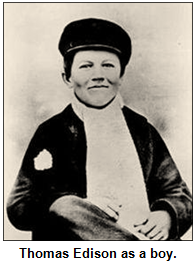 Are you unaware that one of America's greatest inventors had connections to the Hoosier state? Well, Hoosier History Live! is about to share some, ahem, illuminating info about Thomas A. Edison thanks to a resident expert, Indianapolis-based playwright-performer Hank Fincken.
Are you unaware that one of America's greatest inventors had connections to the Hoosier state? Well, Hoosier History Live! is about to share some, ahem, illuminating info about Thomas A. Edison thanks to a resident expert, Indianapolis-based playwright-performer Hank Fincken.
When the future icon was 17 years old in 1864, Thomas Edison lived in Indianapolis and worked at Union Depot, the forerunner of Union Station, as a telegraph operator. He invented an early machine while living in the Hoosier capital. And - fasten your seat belts - he eventually was fired from his job at Union Depot.
Before that, young Tom Edison had worked in Fort Wayne as a telegrapher. He was fired from that job, too.
What's the back-story about this tumultuous era in the life of Edison (1847-1931), who went on to hold more than 1,000 patents? Tune in as we explore Edison's connections to Indiana and other aspects of his colorful life with Hank, who performs one-man plays across the country "in character" as the famous inventor known for his independent spirit.
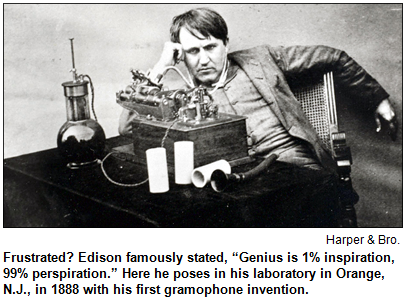 Edison was born in Milan, Ohio, and grew up in Michigan. By the 1860s, when teenage Tom came to Indianapolis, the bustling town was nicknamed "Railroad City" because the depot served as a junction for so many train lines, according to the book Indianapolis Union Station, written in 2000 by James Hetherington. That meant the Western Union railroad telegraph office, where Edison worked, was "busy and important."
Edison was born in Milan, Ohio, and grew up in Michigan. By the 1860s, when teenage Tom came to Indianapolis, the bustling town was nicknamed "Railroad City" because the depot served as a junction for so many train lines, according to the book Indianapolis Union Station, written in 2000 by James Hetherington. That meant the Western Union railroad telegraph office, where Edison worked, was "busy and important."
But Hank shares insights about why things didn't work out in Indy for the future inventor of the incandescent light bulb, the phonograph and so much else that became part of daily life.
"When the reasonable doesn’t work, try the unreasonable," Hank (as Edison) tells audiences.
Regular listeners will recall that Hank has been our guest before. In 2009, he shared insights about the life of John Chapman, who became a folk legend as Johnny Appleseed, another character in Hank's repertoire of historic figures and one-man shows. More info about Hank's plays and performances - including video excerpts of him in costume as Edison - is at hankfincken.com.
Some fun facts:
 After being fired from his Union Depot job in Indianapolis, Tom Edison moved to Cincinnati, then to Louisville. The teenager was fired from jobs in various cities besides Indy and Fort Wayne. Hank will share insights about why young Edison was able to land new jobs despite a string of dismissals in his past.
After being fired from his Union Depot job in Indianapolis, Tom Edison moved to Cincinnati, then to Louisville. The teenager was fired from jobs in various cities besides Indy and Fort Wayne. Hank will share insights about why young Edison was able to land new jobs despite a string of dismissals in his past.- "He learned early on that the real profit was not in the inventing, but in the manufacturing," Hank says.
- Union Depot, which opened in the 1850s in Indianapolis, was the country's first truly "union" train station in which lines from different railroads converged on the same spot. Five competing railroad lines cooperated in building Union Depot, according to a "Culture Watch" column in the Indianapolis Star written by Jim Glass. (Jim was a guest on Hoosier History Live! for a show about another transportation artery, the Old National Road.)
- In the 1880s, ever-increasing requests for accommodations from more railroad lines resulted in the replacement of Union Depot on the site with a massive new Union Station, which, of course, still stands today. Designed in Romanesque Revival architecture, the railroad station became the showplace of Indianapolis as "the Crossroads of America."
- Later in life, Edison, who primarily became based out of New Jersey, enjoyed a romantic correspondence with an Indianapolis woman, according to Hank.
- For most of his life, Edison was hearing-impaired. This didn't stop him from being an audio pioneer, with the phonograph being one of his most important inventions. According to Hank, the genius inventor resisted dabbling in the early radio industry because he was convinced listeners would want to select their own music rather than having it chosen for them by broadcast stations.
- During the 1890s, Edison became a pioneer in early motion pictures. Although "flickers" were silent then, Hank says Edison always knew movies eventually would "talk."
Because this is an encore presentation of a show that originally aired on May 14, 2011, there will be no live call-in for the History Mystery.
Encore presentation
Amusement park history in Indy
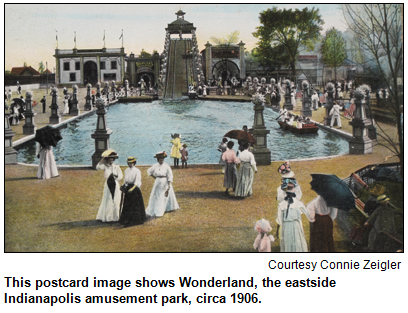 (April 28, 2012) - Ferris wheels, roller coasters, shoot-the-chutes, bumper cars, dunk tanks, fun houses, landscaped gardens and waterslides. All were enticements - along with cotton candy and Coney dogs - for Hoosiers who patronized three popular amusement parks in Indianapolis.
(April 28, 2012) - Ferris wheels, roller coasters, shoot-the-chutes, bumper cars, dunk tanks, fun houses, landscaped gardens and waterslides. All were enticements - along with cotton candy and Coney dogs - for Hoosiers who patronized three popular amusement parks in Indianapolis.
All three are bygone and had some dark chapters in their histories, including, in some cases, raging fires, racial discrimination, neighborhood objections over plans to serve alcohol and as many financial ups and downs as a wild ride.
To explore the heritage of three major amusement parks that opened more than 100 years ago, Nelson is joined in studio for this encore broadcast of a popular show from our archives (its original air date was July 9, 2011) by historic preservationist Connie Zeigler, president and owner of C. Resources Inc.
A writer and historian, Connie has researched the beginnings - during the amusement park craze that swept the country in the early 1900s - of Riverside Amusement Park, the wildly popular attraction on the westside of Indy that flourished until 1970. Connie's 2007 thesis about Indianapolis amusement park history can be read here.
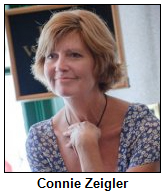 Connie, a regular columnist for Urban Times, the monthly newspaper that serves historic neighborhoods in Indy, also has researched Wonderland Amusement Park, a lavish entertainment complex on East Washington and Gray streets with a short (1906-1911) but spectacular and colorful life. When illuminated at night, Wonderland's 125-foot central tower was said to be visible for miles.
Connie, a regular columnist for Urban Times, the monthly newspaper that serves historic neighborhoods in Indy, also has researched Wonderland Amusement Park, a lavish entertainment complex on East Washington and Gray streets with a short (1906-1911) but spectacular and colorful life. When illuminated at night, Wonderland's 125-foot central tower was said to be visible for miles.
The third major amusement park in Indy was located in Broad Ripple and had a series of lives. Known as White City Amusement Park when it opened in 1906, the entertainment center was named after the "white city" architecture featured at the legendary 1893 World's Columbian Exposition in Chicago.  White City burned to the ground in 1908 after a fire that started in its "Mystic Cave" attraction, which was a simulated opium den.
White City burned to the ground in 1908 after a fire that started in its "Mystic Cave" attraction, which was a simulated opium den.
Wonderland also succumbed to flames (ironically, its attractions included a re-enactment of the 1889 Johnstown, Pa., flood), destroyed by a roaring nighttime blaze that, as Connie put it in an Urban Times column, left the once-lavish amusement park "a soaked, smoldering ruin."
Wonderland never reopened, but White City did. Later known as Broad Ripple Amusement Park or similar names, it held forth at the site into the 1940s.
For nearly 60 years, though, Riverside was king of the heap in Central Indiana. Its attractions included dueling roller coasters, a miniature railroad, a dance hall and a roller skating rink. Today, there is a Facebook page for people to share their Riverside memories and photos.
Riverside, however, was not beloved in every aspect. The amusement park outraged many Hoosiers by persisting with a "whites only" admission policy even into the 1960s, even as its surrounding neighborhood became increasingly diverse. African-Americans were permitted to visit only on "Colored Weekends," which were far from frequent.
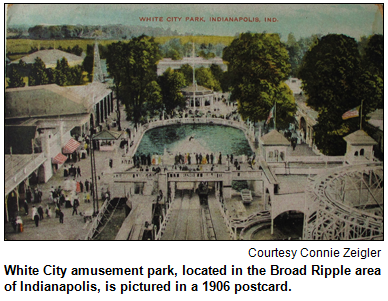 There also were controversies about possible histoplasmosis and the deterioration of the attractions. By some accounts, Riverside was losing more than $30,000 annually when it closed after the 1970 season.
There also were controversies about possible histoplasmosis and the deterioration of the attractions. By some accounts, Riverside was losing more than $30,000 annually when it closed after the 1970 season.
So what developed on the sites of these once-popular amusement parks?
Riverside: Since 2000, subdivisions of homes, townhouses and condos, including River's Edge, have been built on the site.
Wonderland: The factory plant of P.R. Mallory and Co., an Indy-based electrical components manufacturer, employed hundreds of workers before it, too, closed.
White City: According to Connie, the lavish initial amusement park was located on what today is Broad Ripple's dog park, which opened as Indy's first "bark park" (where dogs can frolic off-leash) in 1999.
True tall tales from 1950s Indiana
(April 21, 2012) - To the residents of Howe, Ind., a town character was known as the "Skunk Woman." Not only did she keep skunks as pets, she seldom bathed.
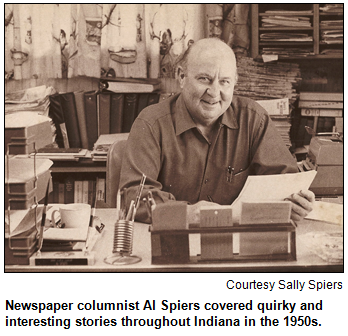 In the 1950s, the talk of Goshen was a rooster described as "over-hormoned." (During that era, roosters routinely were injected with female hormones so they would shun hens, stop crowing, eat hearty and be tender.) Despite multiple injections, a resilient rooster named Elco resumed fraternizing with hens as well as emitting "cock-a-doodle-doos" - all in front of stunned onlookers during a Jaycees event.
In the 1950s, the talk of Goshen was a rooster described as "over-hormoned." (During that era, roosters routinely were injected with female hormones so they would shun hens, stop crowing, eat hearty and be tender.) Despite multiple injections, a resilient rooster named Elco resumed fraternizing with hens as well as emitting "cock-a-doodle-doos" - all in front of stunned onlookers during a Jaycees event.
Accounts of the "Skunk Woman" and of the resilient rooster were syndicated across the state during the 1950s by Al Spiers, a Michigan City-based columnist and editor. Although Al died in 1994, his columns about true tall tales from across Indiana have been collected in a new book, Hoosier Lore (Brooks Publications), put together by his daughter, Sally Spiers.
An Indianapolis civic leader who is retired after a career in city and state governments, Sally is Nelson's studio guest to explore the colorful people, critters, towns and events that her father described.
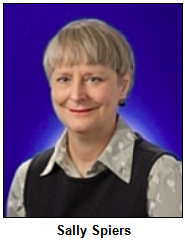 His stories from the Hoosier front during the 1950s include an account from Churubusco about alleged sightings of a giant turtle in Fulks Lake; the town celebrates a Turtle Days festival every summer in honor of Indiana's counterpart of the Loch Ness Monster.
His stories from the Hoosier front during the 1950s include an account from Churubusco about alleged sightings of a giant turtle in Fulks Lake; the town celebrates a Turtle Days festival every summer in honor of Indiana's counterpart of the Loch Ness Monster.
Hoosier Lore also includes columns about a widow in northern Indiana who became known as "mom" to countless soldiers during World War II and afterward because of her generosity; Al Spiers also wrote about the "tired, decaying" town in Pulaski County of Monterey, which needed a civic miracle to survive.
Some of the tales in Hoosier Lore had their origins long before the 1950s. The "Skunk Woman" (whose real name was Chrissy Hand), for example, died in LaGrange County in 1925. When Al Spiers visited 30 years later, though, he was able to interview many residents of Howe who had known her.
Based on their accounts, he reported that the "Skunk Woman," who lived on a farm, hated water.
"When she went to town, she wore monstrous hats, and even on hot days, a long, thick coat."
In addition to a collection of pets in her house that included chickens, guinea pigs, dogs and cats, she typically kept about half a dozen skunks ("not de-skunked skunks, but fully equipped specimens," Al Spiers wrote) wandering around inside. As her fame grew, the "Skunk Woman" became a LaGrange County tourist attraction.
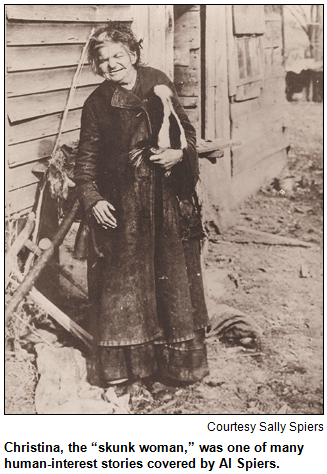 "Whenever a crowd gathered, Chrissy would emerge with two or three cuddly skunks adorning her shoulders and bosom. She'd dance a jig, sing a few ditties and gather coins tossed by the tourists."
"Whenever a crowd gathered, Chrissy would emerge with two or three cuddly skunks adorning her shoulders and bosom. She'd dance a jig, sing a few ditties and gather coins tossed by the tourists."
The fame of the "over-hormoned" rooster was more localized. According to Al Spiers' account in Hoosier Lore, Elco received multiple hormone injections prior to a Goshen festival in 1953. Typically, even one or two such injections caused a rooster's comb to turn from a stiff red to "a limp, floppy pink," altered his full-throated crow into "a confused, subdued cackle" and decreased his romantic interests. During a Jaycees festival, though, Elco sprang to life - despite some "refresher" injections - when placed in a cage with hens.
Al Spiers, an inductee into the Indiana Journalism Hall of Fame, was editor of the Michigan City News-Dispatch, as well as a human-interest columnist. Sally Spiers is president of the Chatham Arch Neighborhood Association; she has worked as a community crime prevention manager for the city of Indy and as an investment adviser examiner for the Indiana secretary of state's securities division. Sally also is a former member of U.S. Sen. Richard Lugar's staff.
She grew up in Michigan City during the era when her father was writing the columns featured in Hoosier Lore. They include accounts from the mid-1950s about the "turtle tizzy" in Churubusco involving residents who claimed to have seen the so-called "Beast of 'Busco" beginning in 1949.
Even though Fulks Lake already had been partially drained and skin divers deployed (with no confirmations of the turtle's presence) by the time Al Spiers wrote his accounts, folklore about a massive beast persists to this day. At dusk, Spiers drove to Fulks Lake, which he described as primarily an "overgrown" pond.
"But in the east corner there's a wild and spooky section - swampy, full of tangled, dead trees and brush, silent and brooding," he reported. "It looks like a hunk of Florida everglades, or a set for a movie starring prehistoric monstrosities."
Sightings of a giant turtle in those environs are not verified, but their impact on the town of Churubusco is undeniable. So Sally and Nelson explore the effects of the "Beast of 'Busco" accounts, along with other Hoosier Lore tales that captivated so many readers during the 1950s.
History Mystery
Folklore involving Hoosier animals often includes stories about an enormous steer of the early 1900s. Known as Old Ben, the steer was said to be the largest in the world. He apparently weighed more than 4,700 pounds in 1910, when Old Ben slipped on the ice and broke both legs. Euthanized after the accident, Old Ben was stuffed by a taxidermist.
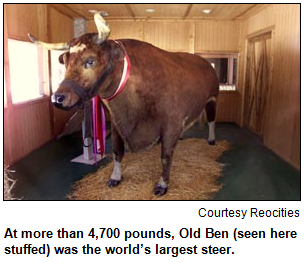 Years later, Old Ben was placed on exhibit at a public park in an Indiana city, where he remains to this day. Visitors frequently stop by to look at Old Ben in a pavilion at the park's welcome center.
Years later, Old Ben was placed on exhibit at a public park in an Indiana city, where he remains to this day. Visitors frequently stop by to look at Old Ben in a pavilion at the park's welcome center.
Question: Name the Indiana city where the stuffed Old Ben, reportedly the world's largest steer, is exhibited in a park.
This week's prize is two tickets to the Indiana Wine Fair in southern Brown County on Saturday, April 28, courtesy of the Story Inn, and an overnight stay at the Marriott Indianapolis East, courtesy of the ICVA.
Roadtripper
Roadtripper Chris Gahl of the ICVA reminds us that there is a free concert or performance almost every day around lunchtime at the Artsgarden, that magnificent glass "bubble" nested in downtown Indianapolis and hovering over the busy intersection of Washington and Illinois Streets.
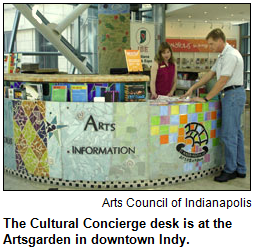 The Artsgarden was built in 1995 by the Arts Council of Indianapolis as a part of the Circle Centre Mall project, and of course it is connected by walkways to the mall and downtown hotels and the Indiana Convention Center.
The Artsgarden was built in 1995 by the Arts Council of Indianapolis as a part of the Circle Centre Mall project, and of course it is connected by walkways to the mall and downtown hotels and the Indiana Convention Center.
In fact, if you are visiting Indianapolis and staying at a downtown hotel, you don't need to rent a car because downtown Indy is totally walkable, and walkways keep you out of frigid weather in the winter and steamy weather in the summer. If you are parking downtown, however, look for the Circle Centre Mall parking lots for the best parking rates.
The Artsgarden is also home to the Cultural Concierge booth, which is a sort of "visitor's center" for information about the arts for visitors and locals alike, and is always fully stocked with maps and information about museums, the arts, and cultural events. The booth does not sell tickets but can direct guests to a nearby Ticketmaster outlet in the mall.
The Cultural Concierge hours are 10 a.m. to 9 p.m. Monday through Saturday, and 10 a.m. to 6 p.m. on Sunday. The phone number is ( 317) 624-2563.
Broad Ripple neighborhood history in Indy
 (April 14, 2012) - It's our 200th show, ideal to focus on a historic village that became one of the most distinctive neighborhoods in Indianapolis and is about to celebrate its 175th anniversary. The colorful history of Broad Ripple involves bungalows, ducks, the Central Canal, famous son David Letterman, a bygone amusement park, popular nightspots, ethnic restaurants and the 1922 annexation of a bucolic village by Indy.
(April 14, 2012) - It's our 200th show, ideal to focus on a historic village that became one of the most distinctive neighborhoods in Indianapolis and is about to celebrate its 175th anniversary. The colorful history of Broad Ripple involves bungalows, ducks, the Central Canal, famous son David Letterman, a bygone amusement park, popular nightspots, ethnic restaurants and the 1922 annexation of a bucolic village by Indy.
Nelson is joined in studio by two guests with deep connections to the neighborhood: Bridget Carson, a board member of the Broad Ripple Village Association and a key organizer of the upcoming anniversary celebrations, and Alice Ashby Roettger, whose family moved to the community in 1936 and who has researched the histories of many of its homes, sites and notable figures.
The village dates to April 1837, when it was platted and named Broad Ripple, apparently as a tribute to the ripples created by the White River as it flowed over rocks.
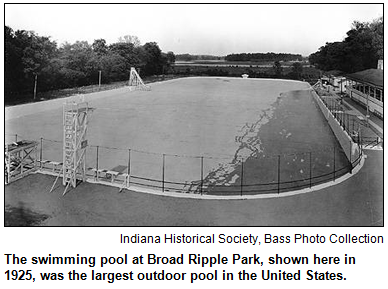 Although early accounts describe hardscrabble labor and revelry by Central Canal workers, Broad Ripple had become a tranquil getaway by the turn of the last century, with visitors from downtown Indy traveling by streetcars (and, later, interurbans) to enjoy fishing, dancing on cruise boats, shopping and other leisurely diversions.
Although early accounts describe hardscrabble labor and revelry by Central Canal workers, Broad Ripple had become a tranquil getaway by the turn of the last century, with visitors from downtown Indy traveling by streetcars (and, later, interurbans) to enjoy fishing, dancing on cruise boats, shopping and other leisurely diversions.
In the early 1900s, White City Amusement Park opened in what's now Broad Ripple Park. Although White City is long gone (a roaring fire in 1908 was among its challenges), other historic structures remain. They include the American Legion Post 34, 6440 N. Westfield Boulevard., and Indianapolis Fire Department Station 32, which opened about the time of annexation and today is the city's oldest fire station still in use.
Other landmarks include the Vogue, which opened as a popular movie theater in 1938 and endured a decline (Letterman has said he saw his first X-rated films there during the late 1960s) before a series of renovations that today make it a popular venue for concerts.
Many of Broad Ripple's bungalows were built between the late 1910s and mid-1930s. The Masonic Lodge (official name: J.S. Mustard Hall) was constructed even earlier, opening in 1908 in a building that also housed a series of banks.
Notable graduates of Broad Ripple High School include Letterman (class of '65), Marilyn Quayle, architect Michael Graves and former Lt. Gov. John Mutz. Some of them attended School 80, which was built in 1929. So did our guest Alice Ashby Roettger and her future husband, architect Richard Roettger. School 80, 920 E. 62nd St., has been converted into condos, which typifies the clamor for residential living in Broad Ripple.
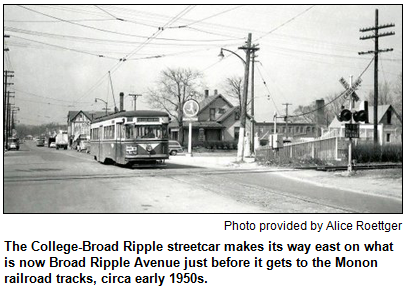 For many generations, the neighborhood has been known for cafes and small, specialty shops ranging from antique and hobby stores to today's vintage clothing and gourmet pet food shops. Residents say the focus on locally owned, specialty stores helped the neighborhood survive retail competition that accelerated with the opening of nearby Glendale Shopping Center in 1958.
For many generations, the neighborhood has been known for cafes and small, specialty shops ranging from antique and hobby stores to today's vintage clothing and gourmet pet food shops. Residents say the focus on locally owned, specialty stores helped the neighborhood survive retail competition that accelerated with the opening of nearby Glendale Shopping Center in 1958.
To mark Broad Ripple's anniversary, upcoming festivities include a photo scavenger hunt that kicks off April 17; a race of rubber duckies April 21 on the Central Canal and a birthday party April 22 that's free and open to the public at the Indianapolis Art Center, 820 E. 67th St.
The art center was designed by Graves (Broad Ripple High class of '52), who is nationally renowned as a pioneer of post-Modernist architecture. In his hometown, he also has designed the NCAA Headquarters and Hall of Champions in White River State Park.
Some fun facts:
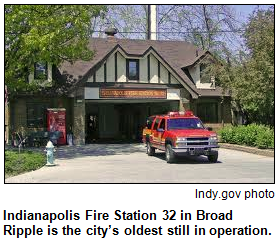 In 1924, the U.S. Olympic Swimming Trials were at Broad Ripple Park's pool, then the largest outdoor swimming pool in the country. The star of the trials was Johnny Weissmuller, who went on to win gold medals in the Olympics, then star in Tarzan movies. (Regular listeners of Hoosier History Live! will recall a Trivia Mystery awhile back about Weissmuller and the 1924 swim trials.)
In 1924, the U.S. Olympic Swimming Trials were at Broad Ripple Park's pool, then the largest outdoor swimming pool in the country. The star of the trials was Johnny Weissmuller, who went on to win gold medals in the Olympics, then star in Tarzan movies. (Regular listeners of Hoosier History Live! will recall a Trivia Mystery awhile back about Weissmuller and the 1924 swim trials.)- The first dog park in Indy opened in Broad Ripple Park in 1999. As a feature writer/columnist for The Indianapolis Star, our host Nelson wrote about the opening of the historic "bark park."
- The antique carousel from White City Amusement Park is at the Children's Museum of Indianapolis.
History Mystery
In Broad Ripple during the early 1900s, Watt's Drug Store was located in a two-story brick building. Its top floor was occupied by the International Order of Odd Fellows.
By 1925, Watt's had been replaced on the ground level by another drug store, which was a Broad Ripple landmark until 1990. Today, the location is the site of Chelsea's, a gift and card shop.
Question: What was the drug store that occupied the high-visibility site in Broad Ripple for more than 60 years, beginning in the mid-1920s?
This week's prize was four tickets to the Indiana Wine Fair in southern Brown County on Saturday, April 28, courtesy of the Story Inn, and an overnight stay at the Hampton Inn in downtown Indianapolis, courtesy of the ICVA.
Roadtrip: Cataract Falls and general store
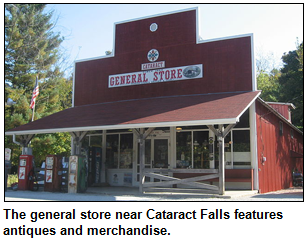 Roadtripper Chris Gahl of the ICVA suggests that we head a little over an hour's drive southwest of Indianapolis to visit Cataract Falls near Cloverdale, which is part of Lieber State Recreation Area.
Roadtripper Chris Gahl of the ICVA suggests that we head a little over an hour's drive southwest of Indianapolis to visit Cataract Falls near Cloverdale, which is part of Lieber State Recreation Area.
To get to the falls, take I-70 west from Indianapolis to Cloverdale and exit south on 231. In about seven miles you will see a sign for the park on the right. There are both upper and lower falls, connected by a scenic hiking trail along Mill Creek, but it is also possible to drive between the falls. The upper falls is the largest waterfall in Indiana by volume.
The park also features a restored covered bridge, and don't miss the old general store in the town of Cataract!
Dan Patch, the first superstar racehorse
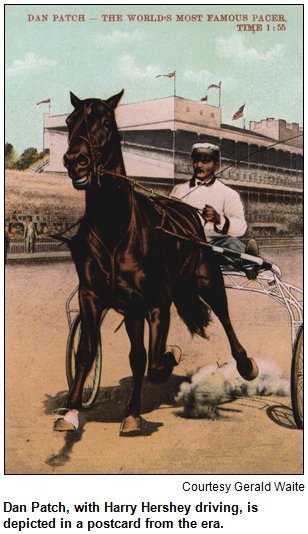 (April 7, 2012) - According to many sports historians, the greatest athlete of the early 1900s was a Hoosier - and he wasn't a baseball player, a bicyclist, a boxer or even a human being.
(April 7, 2012) - According to many sports historians, the greatest athlete of the early 1900s was a Hoosier - and he wasn't a baseball player, a bicyclist, a boxer or even a human being.
Dan Patch was a racehorse who became a top national celebrity, never lost a race on the grand circuit of harness racing and was hailed as the "Epitome of Excellence in American Sports."
Yet this superstar, who eventually endorsed an array of products from sleds to washtubs, had gangly, crooked legs at his birth in 1896. He was foaled in a barn in Oxford, a western Indiana town that continues to celebrate an annual Dan Patch Days Festival in honor of the famous son. (This year's event, the 43rd festival, will be Sept. 7-9 at Rommel Park in Oxford.)
A pacer who stunned spectators in 1900 at the Benton County Fairgrounds with an incredible win in his first race, Dan Patch initially was owned by local storekeeper Daniel Messner Jr. The barn where "the Patch" was foaled and raised still stands and is owned by Messner's grandson.
To explore the life of the racehorse that captivated Americans (even a popular dance, known as the "Dan Patch Two-Step," was composed in his honor, as was a "Dan Patch March"), Nelson is joined in studio by two guests. They are Oxford resident Bob Glaspie, who owns a vast collection of Dan Patch memorabilia, and Gerald Waite, a lecturer emeritus at Ball State University who has written extensively about the legendary horse.
Dan Patch also has been the subject of a bestselling biography, Crazy Good: The True Story of Dan Patch, the Most Famous Racehorse in America (Simon & Schuster, 2008) by Charles Leerhsen, whom our guest Bob escorted around Oxford during his research.
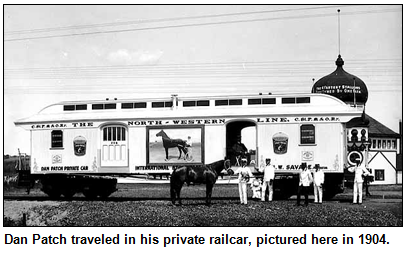 Dan Patch's dominance hurt betting at racetracks because, if the undefeated champ was entered, everyone knew who would win. Other prominent owners also didn't want their racehorses "to submit to the humiliation of being beaten every time," according to an award-winning cover story written by our guest Gerald Waite for Traces of Indiana and Midwestern History magazine. So for several years, "the Patch" raced against a stopwatch, essentially competing against himself to set new world records.
Dan Patch's dominance hurt betting at racetracks because, if the undefeated champ was entered, everyone knew who would win. Other prominent owners also didn't want their racehorses "to submit to the humiliation of being beaten every time," according to an award-winning cover story written by our guest Gerald Waite for Traces of Indiana and Midwestern History magazine. So for several years, "the Patch" raced against a stopwatch, essentially competing against himself to set new world records.
Our guest Bob Glaspie, 86, a farmer who grew up in Benton County, owns one of the historic stopwatches, as well as more than 300 other pieces of memorabilia. They include Dan Patch-endorsed children's wagons (they were sold in three styles), a straight razor, a pocket knife and a clothes wringer.
 "Probably the rarest item is Dan Patch billiard chalk," he says. "This chalk has never touched a cue, and it's in the original box."
"Probably the rarest item is Dan Patch billiard chalk," he says. "This chalk has never touched a cue, and it's in the original box."
He also owns a horseshoe discovered in the Messner barn that, Bob says, "almost certainly was worn by Dan Patch."
The wonder horse had multiple owners, concluding with Marion W. Savage, a Minneapolis-based entrepreneur and master promoter who pioneered much of the product licensing. (In addition to the businesses that purchased the rights to the racehorse's name and image, many others undoubtedly used them without permission, according to Gerry Waite's article in Traces.) In 1902, politicians even campaigned for office "by handing out Dan Patch cigars and balloons to voters," Gerry noted.
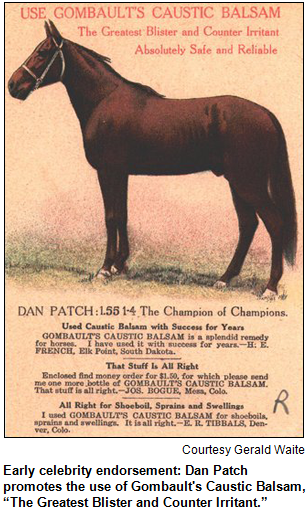 Yet the subject of so much lavish praise apparently did not let the acclaim go to his head. Dan Patch, Gerry wrote, was "said to be as gentle as a Newfoundland dog."
Yet the subject of so much lavish praise apparently did not let the acclaim go to his head. Dan Patch, Gerry wrote, was "said to be as gentle as a Newfoundland dog."
And here's how our guest described the horse's reaction to an early celebration in his honor at the town square in Oxford:
"Accounts of the time remarked about the almost humanlike sense the horse showed in recognizing friends, dancing to the music, understanding what was said to him, and other characteristics of superior intelligence."
In retirement, Dan Patch enjoyed railroad tours to meet adoring fans across the country. He traveled in a specially designed, private railcar decorated with his portrait on the exterior. Some other facts:
- On the exterior of the Indiana State Museum, where the 92 counties are honored with icons, Benton County is represented by Dan Patch, with a depiction of a single, continuous wire bent to his form. (Thanks to our regular listener Judy Burkam for calling our attention to this.)
- Movies about the phenomenal horse include The Great Dan Patch (1949). Bob, our guest, and film historian Eric Grayson advise viewers to ignore the mountains depicted in Indiana scenes featured in the movie, which obviously was not filmed on location.
- Both the wonder horse and Savage, his final owner, took ill at the same time in 1916. They died 32 hours apart.
History Mystery
Cowboy Bob, the children's TV personality popular in central Indiana and beyond, had more than one horse during the long run of his programs, which included Chuckwagon Theater.  His best-known horse was named Skye. Even better known to fans of Cowboy Bob - who appeared regularly on WTTV-Channel 4 from the late 1960s through the 1980s - was his beloved dog.
His best-known horse was named Skye. Even better known to fans of Cowboy Bob - who appeared regularly on WTTV-Channel 4 from the late 1960s through the 1980s - was his beloved dog.
Question: What was the name of Cowboy Bob's dog?
This week's prize was a copy of the book The Dans, and One Was a Racer, by Mary E. Cross. This prize is courtesy of guest Bob Glaspie and his wife, Thelma. Also, you will have an opportunity to read the book in the lap of luxury with a one-night stay at the Crowne Plaza Hotel at Indianapolis Union Station, courtesy of the ICVA.
Roadtrip: Ravine Garden at the IMA
Roadtripper Chris Gahl of the ICVA returns to our airwaves to suggest that we enjoy spring in all its glory at the Ravine Garden on the grounds of the Indianapolis Museum of Art.
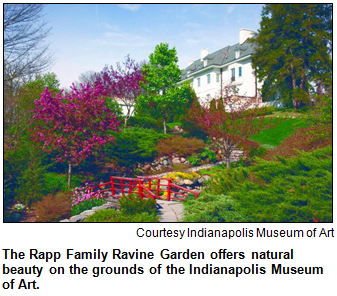 The Ravine Garden is a one-acre hillside garden that descends 40 feet from the terrace of the Lilly House (former home of J.K. Lilly Jr. of Eli Lilly and Co.) down to the Central Canal below. The historic gardens and grounds surrounding the Lilly House, together known as "Oldfields," were designed in the 1920s by landscape architect Percival Gallagher of Olmsted Brothers, the same firm that designed New York's Central Park and Chicago's Lincoln Park.
The Ravine Garden is a one-acre hillside garden that descends 40 feet from the terrace of the Lilly House (former home of J.K. Lilly Jr. of Eli Lilly and Co.) down to the Central Canal below. The historic gardens and grounds surrounding the Lilly House, together known as "Oldfields," were designed in the 1920s by landscape architect Percival Gallagher of Olmsted Brothers, the same firm that designed New York's Central Park and Chicago's Lincoln Park.
The Ravine Garden was restored to Gallagher's original vision in 1998 with funding from George and Peggy Rapp. The dramatic "wild" garden features a cascading stream, three rock-rimmed pools, and more than 19,000 bulbs, perennials, trees and shrubs.
There is no admission charge to enjoy all of the gardens and grounds at the IMA, including the adjacent 100 Acres: The Virginia B. Fairbanks Art & Nature Park. All of the museum grounds are open to the public from dawn until dusk, and free parking is ample. This "hidden oasis" makes for a great value as well as an opportunity to walk around outside and enjoy one of the most stunning landscapes in Indianapolis.
Indiana's remarkable suffragist
(March 31, 2012) - Among the distinguished Hoosiers honored with the first 10 pillars unveiled earlier this month along Georgia Street in downtown Indy, many of the notables remain household names. They include Madam Walker, Tecumseh and Abraham Lincoln, who spent his youth in Indiana.
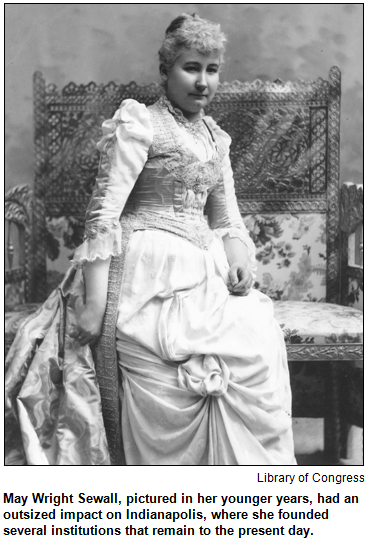 Who, though, was May Wright Sewall?
Who, though, was May Wright Sewall?
The dedication of her pillar - and Women's History Month - are ideal opportunities to explore the colorful life of this once nationally famous leader of the women's suffrage movement who also had a huge impact on her adopted hometown in the arts, culture and education.
Among an array of accomplishments, some of which were regarded as radical during her heyday, May Wright Sewall (1844-1920) launched a private school that revolutionized the education of girls in the Hoosier capital. She also became known as the leader of "half a million women" because of her influential work to organize women across the country - and even overseas, after trips to the Netherlands and other European countries.
Sadly, although Mrs. Sewall worked tirelessly for voting rights for women all of her life, she never got to cast a ballot in a presidential election. Her death in 1920 came just months before U.S. women got to vote for president for the first time.
To explore the life of this remarkable civic leader, who helped start groups that evolved into the Indianapolis Museum of Art as well as an into various non-profits that continue to this day, Nelson is joined in studio by two experts.
They are Ray Boomhower, author of But I Do Clamor: May Wright Sewall, A Life, and Jan Wahls, past president of the Indianapolis Propylaeum Club, which was founded by Mrs. Sewall during an era when a club both for women and managed by women was considered radical.
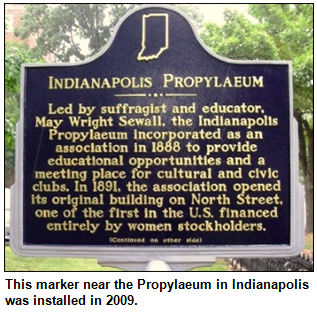 Jan, who often portrays Mrs. Sewall as a re-enactor in vintage costume, also is a member of the Contemporary Club, yet another civic organization founded by May that continues to this day.
Jan, who often portrays Mrs. Sewall as a re-enactor in vintage costume, also is a member of the Contemporary Club, yet another civic organization founded by May that continues to this day.
Consider this: When Mrs. Sewall launched the Indianapolis Classical School for Girls in the1880s, she shocked Hoosiers by insisting on a gymnasium. (In that era, physical education was almost unheard of for girls and women - who should not be seen sweating, according to prevailing social attitudes.)
Also at Mrs. Sewall's insistence, her students were taught Latin, Greek and world literature as part of a curriculum just as rigorous as that offered at a school for boys founded by her husband, Theodore Sewall. Before May Wright Sewall, education for most girls in Indy ended after some instruction in running a home.
"She served as an invaluable ally to such national suffrage leaders as Susan B. Anthony and Elizabeth Cady Stanton, and (she) gave the women's movement an international focus," Ray Boomhower writes in his biography.
 It's one of several books about notable Hoosiers written by Ray, who also is editor of Traces of Indiana and Midwestern History, the popular magazine published by the Indiana Historical Society.
It's one of several books about notable Hoosiers written by Ray, who also is editor of Traces of Indiana and Midwestern History, the popular magazine published by the Indiana Historical Society.
Like our guests Ray and Jan, our host Nelson also has ties to May Wright Sewall. Nelson is on the board of the Indianapolis Propylaeum Historic Foundation and serves as the emcee historian for the foundation's annual May Wright Sewall Award banquet. The award honors women civic leaders as well as community volunteers in education, the arts and cultural life, all endeavors in which Mrs. Sewall influenced the Hoosier capital.
In addition to founding the Art Association of Indianapolis, the predecessor to the museum of art, she founded the International Council of Women (and served two terms as its president), plus traveled overseas as a peace activist.
"My country is the world," Mrs. Sewall once said. "My countrymen are all mankind."
And aside from starting the Propylaeum and the Contemporary Club in her adopted hometown of Indy, she also began organizations such as the Indianapolis Women's Club. Sometimes Mrs. Sewall and other Hoosier women met in secret to plan strategies for obtaining the vote. (Many women feared rebukes from their husbands or friends if they shared the real purpose of the meetings. Mrs. Sewall, though, always enjoyed the support of her husband in her activism.)
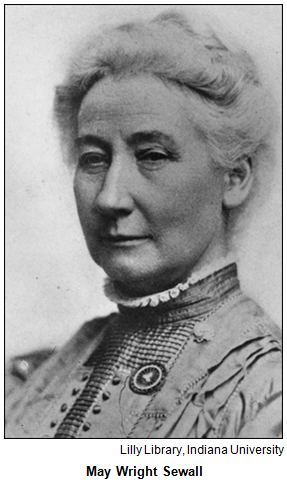 At the turn of the last century, May Wright Sewall was considered to be one of Indy's most prominent residents, along with her close friends, novelist Booth Tarkington and poet James Whitcomb Riley. She wasn't a native Hoosier, though. Born in Wisconsin, May was a gifted child who was said to have been reading classic literature as a 7-year-old.
At the turn of the last century, May Wright Sewall was considered to be one of Indy's most prominent residents, along with her close friends, novelist Booth Tarkington and poet James Whitcomb Riley. She wasn't a native Hoosier, though. Born in Wisconsin, May was a gifted child who was said to have been reading classic literature as a 7-year-old.
After a career as an educator everywhere from Michigan to Mississippi, Mrs. Sewall settled in the Hoosier capital in 1874 to teach at Indianapolis High School, which later became Shortridge High School. Eventually, she founded the Classical School for Girls, where she took pride in hiring all of the teachers personally. One of the teachers whom she trained went on to start Tudor Hall (now part of Park Tudor School), which continued to thrive after Mrs. Sewall's school closed in the early 1900s.
On top of everything else, Mrs. Sewall was considered a spectacular host at her Indianapolis home, which became known for its glittering soirees. Her guest book read like a Who's Who of distinguished Americans who visited the city, including suffrage leader Carrie Chapman Catt, humanitarian Jane Addams and Clara Barton of American Red Cross fame.
A final tidbit about May Wright Sewall: She also shocked the city by wearing her skirts at ankle length. In the 1890s, most women's skirts swept the ground. Historians say only a woman as highly regarded and as forceful as Mrs. Sewall could have gotten away with such a breach of etiquette.
History Mystery
The nation's oldest Catholic liberal arts college for women is located in Indiana. Since the 1840s, young women have been educated at the college, which was founded by a Catholic nun.
Question: What is the Catholic college with this historic distinction?
This week's prize is one night at the Jameson Inn Indianapolis West, as well as two tickets to the Rhythm Discovery Center in downtown Indianapolis, courtesy of the ICVA.
Roadtrip: Last Chance for You are There 1968: RFK Speaks
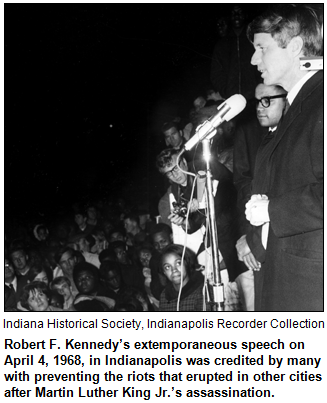 With Roadtripper Chris Gahl of the ICVA out on assignment, Amy Lamb of the Indiana Historical Society joins us on air to suggest that we make it down to see "You are There 1968: Robert F. Kennedy Speaks" at the Eugene and Marilyn Glick Indiana History Center before it closes on April 14.
With Roadtripper Chris Gahl of the ICVA out on assignment, Amy Lamb of the Indiana Historical Society joins us on air to suggest that we make it down to see "You are There 1968: Robert F. Kennedy Speaks" at the Eugene and Marilyn Glick Indiana History Center before it closes on April 14.
With the upcoming anniversary of Dr. Martin Luther King's assassination on April 4, the thoughts of many Hoosiers turn to the historic speech made by Senator Robert F. Kennedy to a downtown Indianapolis crowd in what is now King Park. RFK's extemporaneous speech disclosed Dr. King's death to the crowd and urged peace.
With the help of cutting-edge hologram technology combined with talented historical interpreters, visitors are able to step back in time and become a witness and meet individuals whose lives were changed by this pivotal event.
We also expect comment from show guest Ray Boomhowever, who wrote the book "Robert F. Kennedy and the 1968 Indiana Primary" (Indiana University Press). Ray also talked about his book on the April 12, 2008 edition of Hoosier History Live!
You also can view the video of RFK's 1968 Indianapolis speech here.
Palm Sunday tornado outbreak of 1965
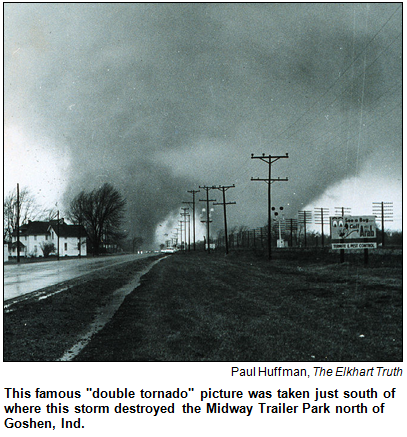 (March 24, 2012) - "The day started out warm and sunny, but became increasingly hot and humid, not at all like a typical day in April," Dennis Keyser recalls.
(March 24, 2012) - "The day started out warm and sunny, but became increasingly hot and humid, not at all like a typical day in April," Dennis Keyser recalls.
The hot, humid weather on Palm Sunday was particularly atypical in far-northern Indiana. That's where 10-year-old Dennis, a native of Bremen, lived with his family in 1965.
His boyhood experiences on April 11, 1965, changed his life - and set Dennis on his career path. Today, after studying atmospheric sciences at Purdue University and then earning a master's in meteorology with a focus on severe weather dynamics and forecasting, he lives in Silver Spring, Md., and works in a highly specialized field of troubleshooting and formatting related to weather data from satellites, radar and aircraft.
He was a passenger in his family's car on Palm Sunday 1965 when the hot, humid weather suddenly became eerie.
"As we approached LaPorte, we noticed the sky to the south and west began to take on a green color. I had never seen this before," he recalls.
After a harrowing car ride - during which a radio announcer proclaimed - "Bulletin: Tornado west of Bremen!" - Dennis and his family made it home. En route, he witnessed a portion of the tragic impact of the Palm Sunday tornado outbreak.
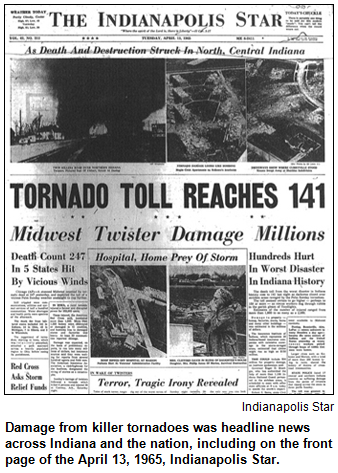 "I could not sleep that night," Dennis recalls. "Ambulances were coming into Bremen Hospital one block from my house all night long."
"I could not sleep that night," Dennis recalls. "Ambulances were coming into Bremen Hospital one block from my house all night long."
Devastating tornadoes struck northern Indiana communities, including Goshen, LaPaz, Lakeville and Wyatt (the first F-4 tornado alone, whose aftermath Dennis witnessed from the family car, killed 10 people and injured 180) as well as Dunlap, a small community between Goshen and Elkhart that was hit by two separate tornadoes - a rare "double funnel."
Dennis will be Nelson's guest to share insights about the tragic tornado outbreak on Palm Sunday of 1965, which became an unforgettable day for so many Hoosiers.
In total, the twisters killed 137 Hoosiers and injured about 1,200 others. According to several sources, 10 tornadoes swept through the state that day.
Much of Russiaville in Howard County was destroyed; in nearby Kokomo, a tornado that was 800 yards wide killed 25 people. Tornadoes also swept through Marion, Greentown, Berne and Sheridan.
"The ironic thing is that due to the heavy rain I never actually saw the tornado, even though we were not that far behind it to the north and west," Dennis recalls, referring to his family's terrifying car ride. 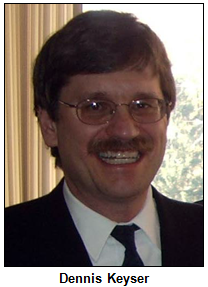 "In any event, all evening long we watched the South Bend news on TV. We heard about the other devastating tornadoes nearby."
"In any event, all evening long we watched the South Bend news on TV. We heard about the other devastating tornadoes nearby."
Sadly, this Hoosier history topic is timely because of the tragic tornado outbreak that ravaged far-southeastern Indiana earlier this month.
Six counties were hit hard by the March 2 tornadoes, which killed 13 Hoosiers and destroyed hundreds of homes and businesses. In Clark County, the towns of Marysville and Henryville have suffered horrific damage.
With the Palm Sunday tornadoes in 1965 - which affected six Midwestern states and are generally considered the worst outbreak in American history until that time - forecasts and watches about the severe weather were regarded as good.
However, subsequent research indicated many people did not receive the warnings because they were outdoors in the unseasonably balmy weather. And when telephone and electrical lines collapsed, people could not receive warnings about the ferocious tornadoes during an era before cell phones and the Internet.
Even three days after the tragic Palm Sunday tornado outbreak, our guest Dennis had an unforgettable experience: He saw his first U.S. president. Dennis' dad took him to South Bend to witness the arrival of Lyndon Johnson, who toured the devastation in northern Indiana.
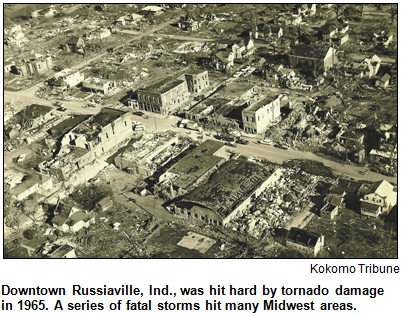 As a meteorologist now, Dennis works for the National Centers for Environmental Protection's Environmental Modeling Center in Camp Springs, Md. He also recommends this blog, which features reports by eyewitnesses to the Palm Sunday storms.
As a meteorologist now, Dennis works for the National Centers for Environmental Protection's Environmental Modeling Center in Camp Springs, Md. He also recommends this blog, which features reports by eyewitnesses to the Palm Sunday storms.
The tornadoes roared through Indiana in the late afternoon and evening. To this day, sources disagree about the precise location of the infamous "double-funnel tornado" that swept through residential areas near Elkhart and Dunlap.
Regardless, the tornado outbreaks destroyed several trailer parks and lakeside communities. In the Hoosier state, the first tornado touched down at 5:30 pm at Koontz Lake in far-northern Indiana. The outbreak eventually included a ferocious F-5 tornado (near Elkhart) with winds of between 261 and 318 mph.
History Mystery
Bremen is the hometown of Otis Bowen, a physician who became a popular governor of Indiana for two terms, beginning in 1972. One of Gov. Bowen's sons, Rob Bowen, also attempted a political career. In 1986, he campaigned to be Indiana's secretary of state, but he lost the election to a young attorney from another family well-known in Hoosier politics.
Question: Who defeated Rob Bowen in the 1986 election?
To win the prize, you must call in with the correct answer during the live show and be willing to be placed on the air. Please do not call if you have won a prize from any WICR show during the last two months. The call-in number is (317) 788-3314, and please do not call until you hear Nelson pose the question on the air.
This week's prize is one night at the Courtyard by Marriott in downtown Indianapolis, as well as two tickets to the NCAA Hall of Champions, courtesy of the ICVA.
Roadtrip: Greene County Railroad Viaduct
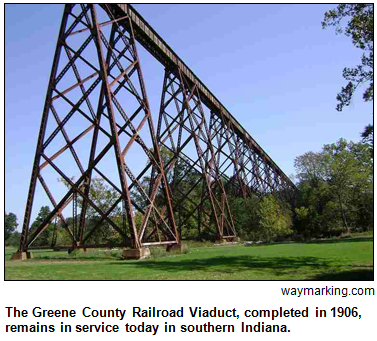 Roadtripper Chris Gahl of the ICVA suggests that we head southeast from Indianapolis to see a structure that is the third-largest of its kind in the world, the Greene County Railroad Viaduct, also known as the Tulip Trustle.
Roadtripper Chris Gahl of the ICVA suggests that we head southeast from Indianapolis to see a structure that is the third-largest of its kind in the world, the Greene County Railroad Viaduct, also known as the Tulip Trustle.
The viaduct was completed in 1906 when the Illinois Central tracks were extended from Indianapolis to Effingham, Ill. The steel and concrete structure is supported by 18 towers, is 2,295 feet (nearly half a mile) long, and 180 feet high, and it spans Richland Creek. Other than two 45-foot sections that were added in 1916, the bridge is much as it was when it was built.
Here are directions (yes, it is a backroads adventure); it's about 22 miles southwest of Bloomington. It still carries rail traffic, although, sadly, it appears to be a hot spot for graffiti.
This Roadtrip was suggested by Margaret Smith, who was a guest on the Oct. 22, 2011 Hoosier History Live! show when she talked about Indiana's covered bridges, along with Larry South of Rush County.
Ask Nelson
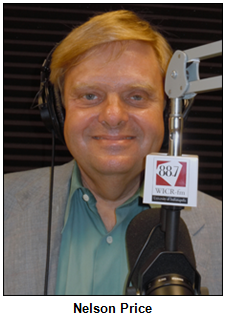 (March 17, 2012) - We're back live on the air this week! Every so often, we like to turn the tables and invite you to interview our host, author/historian Nelson Price. So this show will be an all call-in opportunity to question Nelson, who calls himself a "garbage can of useless Hoosier trivia."
(March 17, 2012) - We're back live on the air this week! Every so often, we like to turn the tables and invite you to interview our host, author/historian Nelson Price. So this show will be an all call-in opportunity to question Nelson, who calls himself a "garbage can of useless Hoosier trivia."
He can be stumped, so instead of that as a goal, the point is to draw him out about Indiana-related topics. Because Nelson has devoted his career to interviewing famous Hoosiers and exploring the state's heritage, including Indianapolis city history, he loves to share anecdotes and insights.
Hoosier History Live! will open the phone lines so listeners can call the WICR-FM studio - the number is (317) 788-3314 - and ask questions of Nelson, who has interviewed famous Hoosiers ranging from astronauts, TV stars, musicians and politicians to artists, novelists and sports figures.
He also has researched historic figures such as Little Turtle (did you know children in Miami villages during the 1700s played a game similar to today's lacrosse?), entrepreneur Madam Walker and bank robber John Dillinger.
As a commentator on motor coach tours across the state, Nelson has shared insights about scenic New Harmony, the site of two failed attempts at utopian living; the North Meridian Street mansions in Indianapolis (fun fact: in addition to novelist Booth Tarkington, some unlikely notables lived in the historic homes, including future pro wrestler Dick the Bruiser), and, in Winchester, the makers of sugar cream pie, Indiana's official state pie.
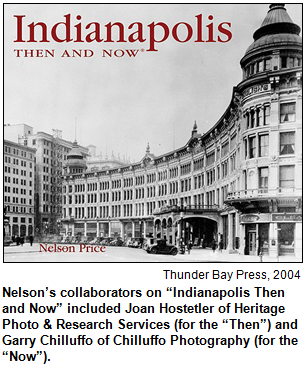 He welcomes questions about any of these places and people, as well as about the historic French Lick and West Baden hotels, Culver Military Academy on Lake Maxinkuckee (the second-largest natural lake in Indiana) or the Studebaker Brothers family and business sites in South Bend. All have been the destinations of tours with Nelson aboard as a commentator.
He welcomes questions about any of these places and people, as well as about the historic French Lick and West Baden hotels, Culver Military Academy on Lake Maxinkuckee (the second-largest natural lake in Indiana) or the Studebaker Brothers family and business sites in South Bend. All have been the destinations of tours with Nelson aboard as a commentator.
Nelson's books include Indiana Legends: Famous Hoosiers from Johnny Appleseed to David Letterman (Hawthorne Publishing) and Indianapolis Then and Now (Thunder Bay Press), a visual history of the Hoosier capital that features historic and contemporary images of about 70 sites.
They include Monument Circle (do you know what was on the site at the Circle City's center before the Soldiers and Sailors Monument was built?), historic homes in Woodruff Place and the bygone Riverside Amusement Park. He researched the history of those sites for his Indianapolis Then and Now book.
Some also have been the topics of Hoosier History Live! shows. So just like our listeners, Nelson has picked up insights from our parade of distinguished guests; he welcomes questions about them.
Some fun facts that may inspire questions:
- Garfield, the comic strip about the cantankerous cat drawn by Indiana native Jim Davis, is featured in more newspapers around the world than any other comic. Readers from Tokyo to Madrid chuckle at Garfield's quips. But affable Jim Davis, who grew up on a farm near Fairmount and lives today in a wooded retreat near Muncie, wasn't always successful. During interviews with Nelson over the years, Jim Davis has described his first cartoon character, which was a huge flop. Phone in and ask for details about this unappealing character, which, like Garfield, was a member of the animal kingdom.
- Among the vehicles exhibited at the Studebaker National Museum is the carriage that transported President Abraham Lincoln and his wife, Mary Todd Lincoln, to Ford's Theatre on the evening of his assassination in 1865. The carriage was made by Studebaker, which was founded by five brothers who are profiled in Nelson's books about famous Hoosiers. One of the brothers, Johnny (J.M.) Studebaker, had an intriguing connection to the California "Gold Rush" of 1849. Call in and ask for details.
- Nelson never interviewed James Whitcomb Riley (the Hoosier poet died in 1916), but he did talk many times with the last surviving person to have known him. Beginning when Agnes Search Bridgford was 92 years old, Nelson interviewed her over a period of several years before her death. He also has interviewed friends of legendary jazz guitarist Wes Montgomery and cousins of composer Cole Porter. Questions or insights about any are welcome from our wonderful listeners.
History Mystery
 A famous Hoosier novelist recently was a studio guest on Hoosier History Live! The novelist - who also has written screenplays and worked as a journalist - is among the 160 notables profiled in host Nelson Price's book Indiana Legends: Famous Hoosiers from Johnny Appleseed to David Letterman.
A famous Hoosier novelist recently was a studio guest on Hoosier History Live! The novelist - who also has written screenplays and worked as a journalist - is among the 160 notables profiled in host Nelson Price's book Indiana Legends: Famous Hoosiers from Johnny Appleseed to David Letterman.
Although the author-screenwriter grew up in Indianapolis, he or she primarily has lived as an adult in cities such as New York, Boston and Miami. However, this famous Hoosier recently returned to Indy to live.
Question: Name the famous Hoosier.
This week's prize is one night at the Wyndham Indianapolis West hotel (near the airport), courtesy of the ICVA.
Roadtrip: Desperate housewives from 1925
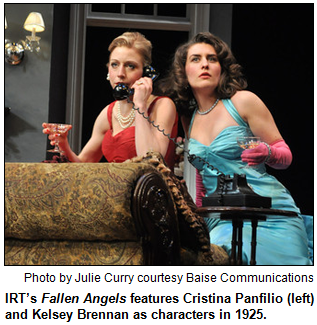 Roadtripper Chris Gahl of the ICVA will first have a few questions for Nelson on our "Ask Nelson" show, followed by a suggestion that we travel to the year 1925 for the Noel Coward farce Fallen Angels, now in downtown Indianapolis at the Indiana Repertory Theatre.
Roadtripper Chris Gahl of the ICVA will first have a few questions for Nelson on our "Ask Nelson" show, followed by a suggestion that we travel to the year 1925 for the Noel Coward farce Fallen Angels, now in downtown Indianapolis at the Indiana Repertory Theatre.
When their husbands go out of town for a golf outing, two wives who also are close friends are surprised by postcards from a mysterious Frenchman who happens to be an ex-lover and boyfriend to them both. Can the virtues of married life stand firm against the lure of lost romance?
Be sure to check out this fun and frothy farce at the IRT, now through April 15 on the Upperstage. Tickets are $25 to $52; prices vary based on day and time. Box-office phone number is (317) 635-5252.
Fun fact: Tallulah Bankhead starred in the original London production.
Encore presentation
James Alexander Thom and Dark Rain on historical fiction
(March 10, 2012) - Note: The Hoosier History Live! broadcast for March 10 was pre-empted by WICR for UIndy basketball NCAA tournament coverage, so we are offering the program in its entirety as a podcast on the Hoosier History Live! website and enewsletter.
Acclaimed far and wide for the depth of his historic research - his novels have sold more than 2 million copies around the world - James Alexander Thom is the best-known author currently living on Indiana soil.
This legendary Hoosier, a nature lover who lives in a 19th-century log cabin that he moved and reconstructed himself on a ridge near a forest in Owen County, prefers to be called "Jim." He joins Nelson in studio.  So does Jim's wife, Dark Rain Thom, a Shawnee elder, tribal historian and fellow author.
So does Jim's wife, Dark Rain Thom, a Shawnee elder, tribal historian and fellow author.
This will be an encore broadcast of their visit, which is one of the most popular shows in our Hoosier History Live! archives. Its original air date was April 2, 2011.
James Alexander Thom's novels have included Follow the River, which hit the New York Times bestseller list in 1981, and Panther in the Sky (1989), which focuses on the great Shawnee leader Tecumseh.
During our show, he shares insights and challenges about writing historical fiction. The Indiana Magazine of History calls him a "master of the form" in a review of Jim's newest book, The Art and Craft of Writing Historical Fiction (Writer's Digest Books).
Dark Rain, who served on the Lewis and Clark Bicentennial Planning Council, and Jim also are the co-authors of Warrior Woman (2004), a novelistic portrait of a real-life, female Shawnee leader of the 1770s. 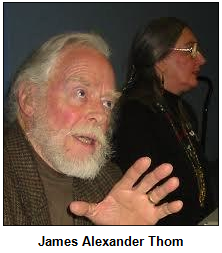 Drawing on their historical research, the Thoms describe the Shawnee "warrior woman," whose name was Nonhelema, as articulate, "imposing at more than six feet tall" and desirous of peace.
Drawing on their historical research, the Thoms describe the Shawnee "warrior woman," whose name was Nonhelema, as articulate, "imposing at more than six feet tall" and desirous of peace.
Compelled to fight when her tribe's homes were threatened by thousands of Virginians, she rode into battle "covered in war paint." She ultimately ended up, as the Thoms put it, "estranged from her own people - and betrayed by her white adversaries."
During this memorable show, Nelson talks to the husband-and-wife team about myths concerning the Shawnee, as well as their historic home.
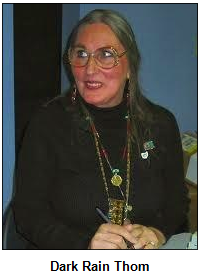 A native of Owen County, Jim did much of the salvage and reconstruction work himself on the cabin, reassembling it log by log, using material from the 1800s, and sleeping in a tent during the process. (During that stretch, he wrote at night by kerosene light.) The westward view from his secluded cabin - a panorama of a valley - is said to be nearly identical to the view 200 years ago.
A native of Owen County, Jim did much of the salvage and reconstruction work himself on the cabin, reassembling it log by log, using material from the 1800s, and sleeping in a tent during the process. (During that stretch, he wrote at night by kerosene light.) The westward view from his secluded cabin - a panorama of a valley - is said to be nearly identical to the view 200 years ago.
His bestseller Follow the River is a fictional account of the true story of a white woman captured by the Shawnee in 1755 and her eventual escape, which took her 1,000 miles.
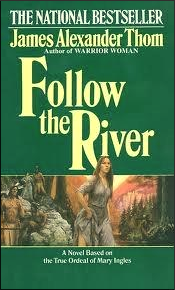 Jim's other bestsellers have included Long Knife (1979), about the exploits of George Rogers Clark during the Revolutionary War, and Sign-Talker (2000), which focuses on a French-Shawnee scout who provided invaluable assistance to Lewis and Clark.
Jim's other bestsellers have included Long Knife (1979), about the exploits of George Rogers Clark during the Revolutionary War, and Sign-Talker (2000), which focuses on a French-Shawnee scout who provided invaluable assistance to Lewis and Clark.
After Jim and Dark Rain met a Shawnee encampment in Ohio, the couple married in 1990. Before co-writing Warrior Woman with her husband, Dark Rain was the author of Kohkumthena's Grandchildren (1994), a history of the Shawnee.
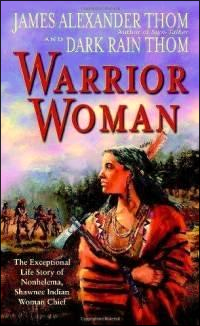 Fun fact: The artwork for her book's cover is an illustration of a Shawnee elder and a grandchild created by James Alexander Thom.
Fun fact: The artwork for her book's cover is an illustration of a Shawnee elder and a grandchild created by James Alexander Thom.
In addition to his creative and literary talents, Jim is known for going to great lengths to recreate the noises, smells and other sensations of the historic settings and experiences depicted in his books. According to several accounts, Jim fasted for so long while doing the research for Long Knife - he wanted to accurately and precisely describe the experience - that he nearly starved to death. For other book projects, Jim has waded through icy streams during winter.
In The Art and Craft of Writing Historical Fiction, he explains that he finds doing the research "as exciting and fascinating as doing the writing."
He has tracked down letters, journals, census reports and vintage newspapers, in addition to immersing himself in the sensory experiences of his characters.
His non-fiction books include The Spirit of the Place (1995), a celebration of Indiana's hill country that pairs Jim's descriptive prose with sweeping photos by acclaimed Indiana photographer Darryl Jones.  The Indianapolis Star lauded Jim's text as "spare, yet evocative."
The Indianapolis Star lauded Jim's text as "spare, yet evocative."
"I'm so glad that I grew up with the sense that the past isn’t 'back there'," Jim told Nuvo newsweekly in 2009. "History isn't 'back there.' We're still in it. It's a river. Everything that goes into it affects everything else, and we're creating more of it."
Not only are the Thoms' admirers legion, we can't resist noting that Jim won the inaugural Indiana Authors Award in 2009 (watch video here) given by the Indianapolis-Marion County Public Library Foundation.
Because this is an encore show, we won't have call-in opportunities from listeners or our History Mystery question. Those features will return next week, though, with a new live Hoosier History Live! show.
Roadtripper and History Mystery will return next week
As this is an encore presentation, there will be no Roadtrip or History Mystery reports during this week's webcast.
Irvington Library listening group continues to meet weekly
The Hoosier History Live! Irvington Library listening group continues to meet weekly on Saturdays at 11:15 a.m. in Story Theater at the library, 5625 E. Washington St. All are welcome, and no reservation is required.
The group's discussion leader is Mike Hylton, public services associate, a self-described history enthusiast. Mike reports that the discussion often goes on for nearly an hour after the show's broadcast, so bring a coffee in and join a conversation that is not online but with real humans!
We also invite you to join the conversation on the Hoosier History Live Facebook page.
Union Station history in Indy
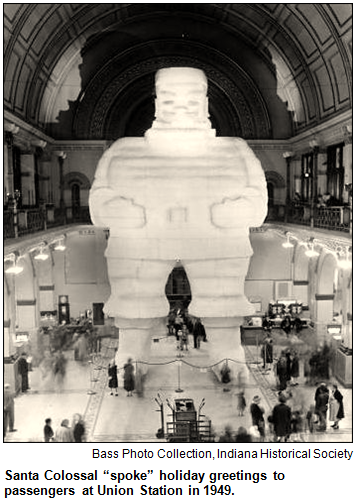 (March 3, 2012) - For the first time in American history, competing railway lines came together in a single central train depot, the country's first "union" station. It happened in Indianapolis in 1853, six years after the first railroad reached the Hoosier capital.
(March 3, 2012) - For the first time in American history, competing railway lines came together in a single central train depot, the country's first "union" station. It happened in Indianapolis in 1853, six years after the first railroad reached the Hoosier capital.
The opening of Union Depot helped account for explosive growth in Indy and the city's longtime "Crossroads of America" nickname.
During the 1880s, the initial depot was replaced by a nearby, majestic Union Station designed in Romanesque Revival architectural style with elegant Rookwood tiles in its interior and a 185-foot clock tower that became a city landmark.
To discuss the history of the station listed on the National Register of Historic Places - as well as the impact of the railroads on Indy - Nelson will be joined in studio by architectural photographer Garry Chilluffo of Chilluffo Photography. Garry, who often is a commentator on tours of the station, also is the corporate photographer for Crowne Plaza Union Station.
Today the historic train shed houses a Crowne Plaza luxury hotel, and the restored grand hall is a ballroom, with rooms in the former concourse serving as convention meeting rooms. (Hotel guests may stay in historic Pullman cars that have been converted to suites and named after famous people who traveled through the train station, such as Winston Churchill, Cole Porter and Amelia Earhart.)
 Garry will share insights about how train travel initially was considered unsafe - with good reason. Even so, its popularity soared, with Indianapolis serving as a major cross-country hub.
Garry will share insights about how train travel initially was considered unsafe - with good reason. Even so, its popularity soared, with Indianapolis serving as a major cross-country hub.
According to Indianapolis Union Station (2000, Guild Press of Indiana), by Jim Hetherington, in the three years after the arrival of the first railroad, the city's population more than doubled, increasing to 8,091 residents. By 1852, the population had soared to 10,800; in 1870, it was 48,224.
More than 200 trains passed through Union Station daily by 1910. Rail travel peaked in the 1920s, when famous Americans (ranging from politicians and movie stars to athletes and authors) who traveled by train east of the Mississippi River usually were routed through Union Station. In 1922, 6 million travelers passed through it.
"So many trains steamed in and out of Union Station during the heyday of the railroads that some had to wait for others to move out before they could even enter the station," Jim Hetherington notes in his history of the landmark.
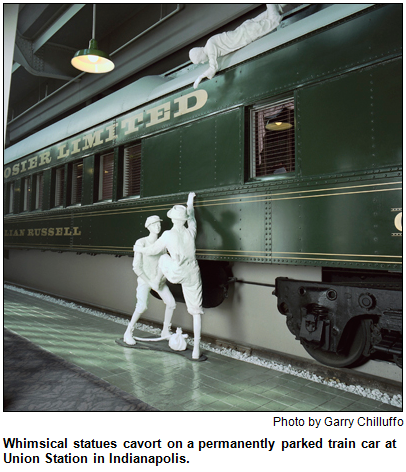 After the 1920s, train travel declined with the widespread availability of cars. World War II, though, sparked a major revival at Union Station in part because of restrictions on gasoline and the mass movements of American servicemen.
After the 1920s, train travel declined with the widespread availability of cars. World War II, though, sparked a major revival at Union Station in part because of restrictions on gasoline and the mass movements of American servicemen.
Next came another, steeper decline in train travel. By 1967, only 16 trains per day came through Union Station, according to a "Culture Watch" column in the Indianapolis Star by historian James Glass.
In 1986, a $48 million restoration and redevelopment of Union Station into a festival marketplace proved unsuccessful, but the National Register designation protects the magnificent structure from demolition. Its interior includes a bronze plaque in the head house that pays tribute to the initial Union Depot, as well as more than two dozen "Ghost People" - white fiberglass sculptures representing the thousands of passengers who traveled through Union Station in its heyday.
Fun facts:
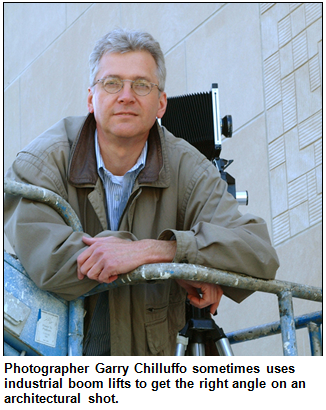 Garry, who enjoys shooting restoration photography of Indiana landmarks, collaborated with Nelson and photo historian Joan Hostetler on the Indianapolis Then and Now (2004, Thunder Bay Press) visual history book. It features a photo of Santa Colossal, a 51-foot high Styrofoam replica of Santa Claus that "spoke" yuletide greetings to thousands of passengers at the terminal during the late 1940s. ("Santa" was so popular that postcards with his image were handed out at Union Station for years afterward.)
Garry, who enjoys shooting restoration photography of Indiana landmarks, collaborated with Nelson and photo historian Joan Hostetler on the Indianapolis Then and Now (2004, Thunder Bay Press) visual history book. It features a photo of Santa Colossal, a 51-foot high Styrofoam replica of Santa Claus that "spoke" yuletide greetings to thousands of passengers at the terminal during the late 1940s. ("Santa" was so popular that postcards with his image were handed out at Union Station for years afterward.)- Union Station sparked explosive growth in the nearby Wholesale District, which featured several outdoor marketplaces in the late 1800s and early 1900s. Also nearby was an area of hotels and boardinghouses known as "the Levee" that eventually got a reputation as seedy.
- In 1864, a teenager named Thomas Edison worked at Union Station as a telegraph operator. He was fired from his job in part for devoting too much time to his inventions, as we learned in a Hoosier History Live! show last May about Edison's connections to Indiana with playwright Hank Fincken, who often portrays the inventor.
History Mystery
En route from Illinois to his presidential inauguration in 1861, Abraham Lincoln stopped at Union Depot, the predecessor train station to Union Station. During his stay in Indianapolis, President-elect Lincoln made a significant speech from the balcony of a local hotel.
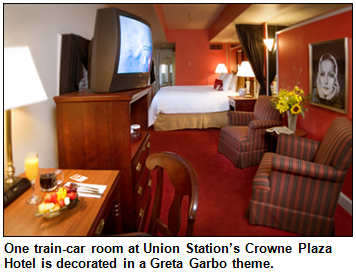 Located at Washington and Illinois streets, the hotel was considered the city's finest during Lincoln's stay. But in the early 1900s, it was demolished to make way for a much grander hotel, the Claypool Hotel.
Located at Washington and Illinois streets, the hotel was considered the city's finest during Lincoln's stay. But in the early 1900s, it was demolished to make way for a much grander hotel, the Claypool Hotel.
Question: Name the historic hotel in Indianapolis where President-Elect Lincoln stayed in 1861.
To win the prize, you must call in with the correct answer during the live show and be willing to be placed on the air. Please do not call if you have won a prize from any WICR show during the last two months. The call-in number is (317) 788-3314, and please do not call until you hear Nelson pose the question on the air.
Friends, we are continuing to receive a lot of interest in the History Mystery. Please be polite on the phone to our engineers and to our host!
In honor of this week's show topic, the prize is one night in a deluxe room at Crowne Plaza Hotel Indianapolis Union Station in downtown Indianapolis. All aboard! This prize is courtesy of the ICVA.
Roadtrip: Tyson Temple in Versailles
Roadtripper Chris Gahl of the ICVA will tell us about an Art Deco gem that sits right smack dab in the middle of the southeastern Indiana town of Versailles in Ripley County. And yes, it is called Ver-SALES in Indiana, as opposed to the French pronunciation of the word for that magnificent palace just a little west of Paris, France, which was occupied by Louis XIV and Marie-Antoinette prior to their beheading in the French Revolution.
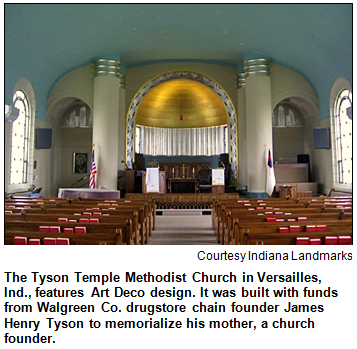 But forgive the digression into French history. James Henry Tyson, a native of Versailles, Ind., and a devout Methodist, was co-founder of the Walgreen Drug Co. and had the Tyson Methodist Temple commissioned and built in memory of his mother, a charter member of the town's United Methodist congregation.
But forgive the digression into French history. James Henry Tyson, a native of Versailles, Ind., and a devout Methodist, was co-founder of the Walgreen Drug Co. and had the Tyson Methodist Temple commissioned and built in memory of his mother, a charter member of the town's United Methodist congregation.
The ceiling in the temple's interior is designed to resemble the look of the night sky the day Tyson's mother died. And no hammers were used in its construction because "no hammers were heard" in the construction of Israel's Holy Temple.
The church continues to be an active Methodist congregation, and visitors are welcome at Sunday services. Tours can be arranged by calling (812) 689-6976 or visiting the church's website.
While in Versailles, be sure to stop by the lovely Versailles State Park. This Roadtrip was recommended by Connie Zeigler.
Murder of heiress Marjorie Jackson in 1977
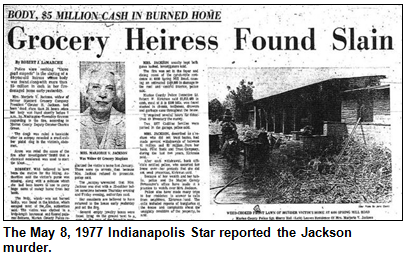 (Feb. 25, 2012) - Nearly 35 years later, it's still considered the largest cash burglary of a home in American history. Burglars stole more than $3.8 million - and left at least $5 million behind - in a sensational crime that included the murder of Marjorie Jackson, an eccentric widow in Indianapolis who had inherited a grocery-chain fortune.
(Feb. 25, 2012) - Nearly 35 years later, it's still considered the largest cash burglary of a home in American history. Burglars stole more than $3.8 million - and left at least $5 million behind - in a sensational crime that included the murder of Marjorie Jackson, an eccentric widow in Indianapolis who had inherited a grocery-chain fortune.
Reclusive and deeply distrustful of banks (about a year before Mrs. Jackson's murder in 1977, a bank vice president had embezzled about $700,000 from her), she stashed cash in vacuum cleaner bags, closets, toolboxes and drawers in her home on Spring Mill Road. Mrs. Jackson, 66, also placed gifts, cookies, pies and cake around her house with notes indicating they were gifts to God.
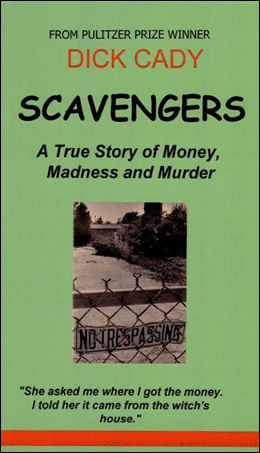 These and other astonishing aspects of a series of crimes involving the Jackson family are recounted in a new book written by Pulitzer Prize winner Dick Cady, a former investigative reporter and city editor for The Indianapolis Star.
These and other astonishing aspects of a series of crimes involving the Jackson family are recounted in a new book written by Pulitzer Prize winner Dick Cady, a former investigative reporter and city editor for The Indianapolis Star.
In Scavengers: A True Story of Money, Madness and Murder, Dick begins with the fatal shooting in 1931 of Mrs. Jackson's father-in-law, who founded the Standard Grocery chain. Her father-in-law, Lafayette Andrew Jackson, also distrusted banks. He was shot during a robbery at Standard headquarters in downtown Indianapolis.
Dick will join Nelson in studio to discuss the series of crimes against the Jackson family that culminated when Mrs. Jackson's body was discovered in a smoldering fire that culprits had set in an attempt to cover up the murder and robbery.
The culprits then made a trail of mistakes Dick calls "inept," including paying cash - with stacks of $100 bills - for flashy new cars. Some of the cash also was buried in an Arizona desert.
In withdrawing her fortune from banks, Mrs. Jackson had taken her cash away in grocery sacks and suitcases. Attempts to "freeze" her account were unsuccessful because Mrs. Jackson was able to convince judges that, although she may have been eccentric, she was capable of handling her own money.
Another complication: About a year before Mrs. Jackson's death, authorities were unable to prosecute intruders who absconded from her house with $800,000 in cash as well as jewelry. The case collapsed because Mrs. Jackson refused to file charges against the perpetrators. She also refused police protection.
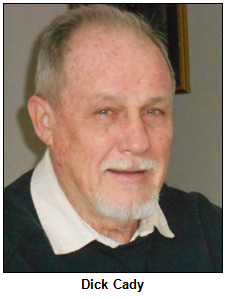 To describe details and share insights about a series of crimes that remain among the most notorious in Indianapolis history, Dick Cady has drawn on interviews, trial testimony, transcripts and official records. Scavengers opens with the fatal shooting of Lafayette Andrew Jackson in 1931, which elevated Mrs. Jackson's future husband, Chester, to head of the Standard Grocery chain.
To describe details and share insights about a series of crimes that remain among the most notorious in Indianapolis history, Dick Cady has drawn on interviews, trial testimony, transcripts and official records. Scavengers opens with the fatal shooting of Lafayette Andrew Jackson in 1931, which elevated Mrs. Jackson's future husband, Chester, to head of the Standard Grocery chain.
Chester Jackson met his future wife, who came from a hardscrabble background, when she was working at a Murphy's five-and-dime store in downtown Indy. According to Scavengers, he later referred to her as his "million-dollar baby from the five-and-ten cent store."
Hoosiers who associate Mrs. Jackson with the intense religious practices of her later years (she was known for spending hours daily in prayer and reading scripture) may be surprised to learn that, according to Scavengers, she was a mistress to Chester Jackson (who was married when he met her) for more than 20 years. The two even lived together for several years before he finally divorced his first wife and married Marjorie.
They bought the house in the 6400 block of Spring Mill Road in 1954. Chester Jackson died in 1970. Then Mrs. Jackson erected a wire privacy fence around the property. Convinced the end of the world was near and suspicious of banks, she began withdrawing her fortune and hiding it around the house.
History Mystery
Before reclusive heiress Marjorie Jackson moved to the house on Spring Mill Road where she was murdered, she lived in the Woodruff Place neighborhood of Indianapolis during the 1940s.
Several decades earlier, the historic Woodruff Place neighborhood had been the boyhood home of another eccentric Hoosier millionaire who primarily is remembered in connection with another residence. This Hoosier moved from Woodruff Place into an isolated house on the far-Northeastside that became the source of perhaps the biggest urban legend in Indianapolis history. For several generations, thousands of high school and college students made a ritual, particularly during Halloween season, of trespassing around his property at the house.
Question: Name both the eccentric Hoosier and his isolated house.
To win the prize, you must call in with the correct answer during the live show and be willing to be placed on the air. Please do not call if you have won a prize from any WICR show during the last two months. The call-in number is (317) 788-3314, and please do not call until you hear Nelson pose the question on the air.
The prize is a voucher for two tickets to the Indianapolis Symphony Orchestra for the Lilly Classical Series, the Symphony Hits powered by Lilly, or the Printing Partners Pops Series. This prize is courtesy of the ICVA.
The Roadtripper returns!
With the NFL Scouting Combine under way at Lucas Oil Stadium, our intrepid Roadtripper, Chris Gahl of the ICVA, will return live on the air with insights about the recent big event at the stadium. Well, that big event before "that other" big event - the Hoosier History Live! fourth anniversary party on Feb. 16! It's hard to get any sleep in this town!
Snow history with weatherman Chris Wright
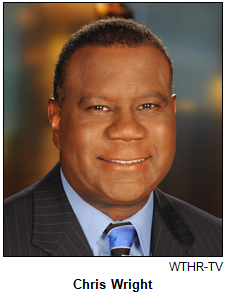 (Feb. 18, 2012) - Even though WTHR-TV/Channel 13 meteorologist Chris Wright is known for his sunny disposition, he loves snow. He frequently mentions his fondness during the evening newscasts of the NBC affiliate in Indianapolis. So who better to be our guide as we journey - or trudge - through snowfall history in the Hoosier state?
(Feb. 18, 2012) - Even though WTHR-TV/Channel 13 meteorologist Chris Wright is known for his sunny disposition, he loves snow. He frequently mentions his fondness during the evening newscasts of the NBC affiliate in Indianapolis. So who better to be our guide as we journey - or trudge - through snowfall history in the Hoosier state?
Chris, who has been an amiable on-camera presence at WTHR since 1999, joins Nelson in studio to cover the waterfront, snow-wise. We explore Indiana winters with the most white stuff and those with the least, as well as the dreaded "lake effect" that affects South Bend and other northern Indiana communities.
Of course, our current winter is far from history at this point. But we can explore the snowfall pattern so far. According to a recent Indianapolis Star story that relied on National Weather Service data, the snowiest January in Indy city history was January 1978. That reflects the notorious Blizzard of '78, generally considered the worst blizzard in city history.
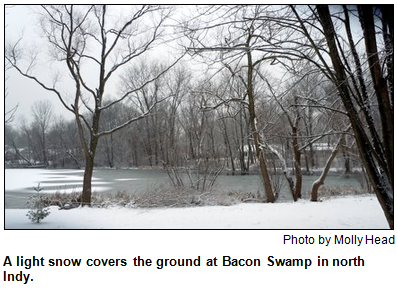 Incidentally, the blizzard's 30th anniversary was the topic of the second Hoosier History Live! show on Jan. 19, 2008. You can listen to a clip from Nelson's interview that day with guest Craig Widener, who was with the Red Cross and helped hundreds of stranded bus passengers in downtown Indianapolis.
Incidentally, the blizzard's 30th anniversary was the topic of the second Hoosier History Live! show on Jan. 19, 2008. You can listen to a clip from Nelson's interview that day with guest Craig Widener, who was with the Red Cross and helped hundreds of stranded bus passengers in downtown Indianapolis.
At the other extreme, the most snow-free January in city history occurred in 1937, when nary a flake fell from the sky. Indy's average snowfall in January is 8.6 inches, meaning last month's 4.4 inches was about half the January average.
In some parts of the state, though, this winter has not been a breeze. According to Associated Press reports, a storm system last Saturday dumped more than 12 inches of lake-effect snow on LaPorte and surrounding areas in northwest Indiana.
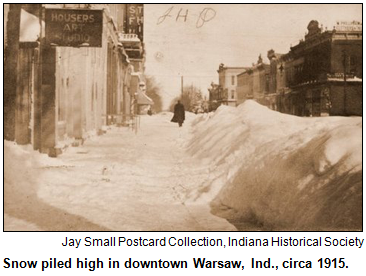 During January 1978, 30.6 inches of snow fell on the Indianapolis area. The Blizzard of '78, which began on Jan. 25 of that year, involved a massive snow dump accompanied (and churned) by howling winds of 55 mph. Frigid air temperatures hovered at zero degrees, but the wind chill made it feel like – 51 degrees. Bill Hudnut, Indy's mayor then, declared a citywide curfew as well as a snow emergency that lasted three days, the longest ever issued in city history.
During January 1978, 30.6 inches of snow fell on the Indianapolis area. The Blizzard of '78, which began on Jan. 25 of that year, involved a massive snow dump accompanied (and churned) by howling winds of 55 mph. Frigid air temperatures hovered at zero degrees, but the wind chill made it feel like – 51 degrees. Bill Hudnut, Indy's mayor then, declared a citywide curfew as well as a snow emergency that lasted three days, the longest ever issued in city history.
Maybe as a reward all these years later, the weather gods blessed Indy with a snow-free Super Bowl. (Fun fact: Chris Wright served on the Super Bowl Host Committee's weather subcommittee.) On Feb. 5, the day of the big game at Lucas Oil Stadium, zero snow (or any kind of perception) fell; the city enjoyed a high of 56 degrees.
![]() Compare that to a year prior - Feb. 5, 2011 - when Indy received 3.9 inches of snow; it was even worse in 2010, when 5.3 inches fell Feb. 5 on the Hoosier capital. These snowfall totals were included in a recent Indianapolis Star analysis.
Compare that to a year prior - Feb. 5, 2011 - when Indy received 3.9 inches of snow; it was even worse in 2010, when 5.3 inches fell Feb. 5 on the Hoosier capital. These snowfall totals were included in a recent Indianapolis Star analysis.
As we dig into snow history from Chris Wright, we can't resist pointing out the multifaceted talents of our guest. In addition to anchoring Channel 13's Sky Trak Weather, he hosts The Brain Game, the long-running quiz show featuring Hoosier high school students.
Chris also is the author of nine mystery novels, including Rockabye Baby (2001), which focused on a kidnapping aboard an airplane of a prominent attorney's infant daughter.
Before joining WTHR, Chris was the meteorologist for WISH-TV/Channel 8 in Indianapolis. In 1994, he was named the National Weather Association Broadcaster of the Year.
Chris recommends these "learn more" websites:
- National Snow and Ice Data Center.
- College of DuPage Next Generation Weather Lab.
- Indiana Department of Transportation.
History Mystery
The Trivia Mystery is carried over from last week's show, when there wasn't a correct answer. The question, part of our salute to Black History Month, concerns an early settlement of African-Americans in Hamilton County.
During the 1800s, black families journeyed from North Carolina to a rural area near what became the town of Noblesville and established their settlement. 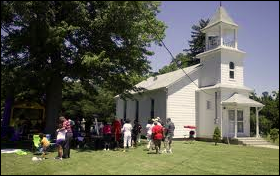 In 1865, the settlers built a chapel that remains on the site to this day. Reunions of descendants of the early settlers also continue to this day.
In 1865, the settlers built a chapel that remains on the site to this day. Reunions of descendants of the early settlers also continue to this day.
Hint: This settlement was not Freetown Village, which was an incorrect guess from a caller last week.
Question: Name the historic African-American settlement that occurred in Hamilton County.
The prize was a gift certificate to the Jameson Inn on the west side of Indianapolis. This prize is courtesy of the ICVA.
Four years on the air!
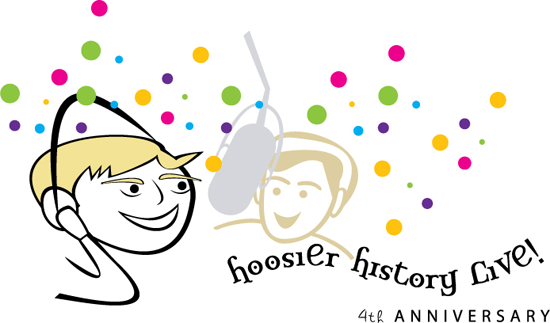 |
Can you believe it? Hoosier History Live! has been on the air for four years! We are proud to have become a unique asset to the state of Indiana, producing original content every week that is then added to our growing online archive. Thanks to all who have listened, clicked, browsed and supported the show!
 We plan to be around quite awhile longer, contributing to Indiana's culture and offering a well-reported take on our state's rich and varied history.
We plan to be around quite awhile longer, contributing to Indiana's culture and offering a well-reported take on our state's rich and varied history.
Look here soon for pictures from our Feb. 16 anniversary soiree at the Morris-Butler House, 1204 N. Park Ave. in Indianapolis. The event was generously hosted by Indiana Landmarks.
African-American newspapers across Indiana
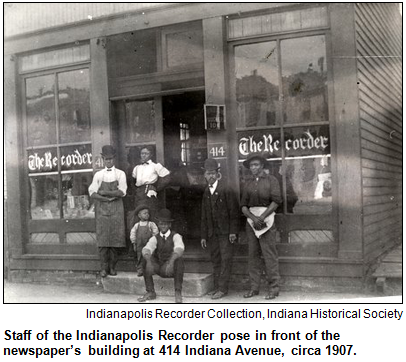 (Feb. 11, 2012) - They covered news, topics and public figures ignored or given short shrift by mainstream newspapers, including the triumphs of athletes such as bicyclist Major Taylor and baseball great Oscar Charleston.
(Feb. 11, 2012) - They covered news, topics and public figures ignored or given short shrift by mainstream newspapers, including the triumphs of athletes such as bicyclist Major Taylor and baseball great Oscar Charleston.
Since the late 1800s, African-American newspapers have had an impact on communities across the Hoosier state. The most enduring has been the Indianapolis Recorder, which our guest Wilma Moore calls "the single most important tool for researching the history of African Americans in Indianapolis."
As Hoosier History Live! salutes Black History Month, Nelson is joined in studio by Wilma, the senior archivist for African-American history at the Indiana Historical Society.
 In addition to delving into the history of the Recorder, a weekly newspaper that began in the 1890s, we will explore the Gary INFO in Lake County; the Evansville Argus, which was published from 1938 to 1943, and the Indianapolis Freeman, a competitor to the Recorder during the 1920s. The Freeman was heralded for increasing the popularity of Negro League Baseball because its sportswriters provided extensive coverage.
In addition to delving into the history of the Recorder, a weekly newspaper that began in the 1890s, we will explore the Gary INFO in Lake County; the Evansville Argus, which was published from 1938 to 1943, and the Indianapolis Freeman, a competitor to the Recorder during the 1920s. The Freeman was heralded for increasing the popularity of Negro League Baseball because its sportswriters provided extensive coverage.
Known for emphasizing local and statewide news, the Recorder covered topics ranging from the political power of the Ku Klux Klan in Indiana during the 1920s to the jazz scene that flourished along Indiana Avenue in Indianapolis after World War II.
Launched as a two-page church bulletin and business directory in 1897, the Recorder became a weekly two years later. At the turn of the last century, the Recorder reported the triumphs of Indy native Marshall "Major" Taylor, who became a world champion bicyclist.
And in 1901, according to Wilma's research, the Recorder published the names of black Indianapolis residents whose wealth was estimated at more than $5,000. The Recorder also listed African-Americans doing business in Indiana.
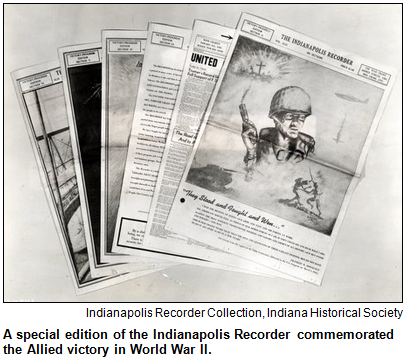 In Evansville, several newspapers serving the black community were launched, with the first appearing in 1880. All of them lasted less than a year, though, until the Evansville Argus began in 1938. Crusading against segregation, the Argus supported efforts to integrate Mechanical Arts, a vocational high school in Evansville. The Argus also published stories about local and national accomplishments by African-Americans.
In Evansville, several newspapers serving the black community were launched, with the first appearing in 1880. All of them lasted less than a year, though, until the Evansville Argus began in 1938. Crusading against segregation, the Argus supported efforts to integrate Mechanical Arts, a vocational high school in Evansville. The Argus also published stories about local and national accomplishments by African-Americans.
So did the Indianapolis Freeman, which began in 1888. Sportswriters at the Freeman were hailed for their in-depth coverage of Negro League Baseball, which, as we noted during a Hoosier History Live! show last summer, held their first official game in Indianapolis.
The Freeman extensively covered the triumphs of Indy native Oscar Charleston (1896-1954), a star in the Negro leagues who is considered to have been one of the greatest (albeit generally unheralded) players in baseball history.
In general, though, the Recorder offered much more extensive local coverage than the Freeman. That, according to the Encyclopedia of Indianapolis, was one of the factors in the demise of the Freeman in 1926.
Two newspapers also served the African-American community in Gary during more recent times. The Gary INFO stopped publishing in the late 1990s, according to Wilma's research. The Gary Crusader is affiliated with the Chicago Crusader; the publications even have shared some editors.
The Recorder, though, has the distinction of being the state's longest continually operated African-American newspaper. 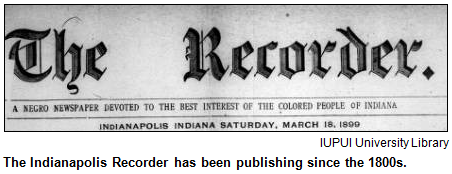 The family of one of its co-founders, George Stewart, owned the newspaper until the late 1980s, when it was purchased by former Indianapolis Star editor Eunice Trotter. In 1990, the weekly was purchased by Indianapolis businessman Bill Mays.
The family of one of its co-founders, George Stewart, owned the newspaper until the late 1980s, when it was purchased by former Indianapolis Star editor Eunice Trotter. In 1990, the weekly was purchased by Indianapolis businessman Bill Mays.
Distinguished journalists who began their careers at the Recorder include Washington Post columnist William Raspberry, who is nationally syndicated.
Since the 1970s and '80s, the Recorder has provided extensive coverage of Indiana Black Expo and the Circle City Classic, two Indianapolis-based events that have drawn national attention.
"It is the single, most important publication that captures a panoramic view of 20th-century black Indianapolis,' Wilma has written of the Recorder.
The digital archives of the Recorder are available at IUPUI's University Library. The full-text, searchable archives include more than 5,000 issues of the newspaper. The Jim Crow History website is another source for information about black-owned newspapers in Indiana.
History Mystery
In the 1800s, Hamilton County was the site of an early settlement of African-Americans. They journeyed from North Carolina to a rural area near what became the town of Noblesville and established their settlement. In 1865, the black families built a chapel that remains on the site to this day. Reunions of descendants of the early settlers also continue to this day.
Question: Name the historic African-American settlement that was established in Hamilton County.
To win the prize, you must call in with the correct answer during the live show. Please do not call if you have won a prize from any WICR show during the last two months. The call-in number is (317) 788-3314, and please do not call until you hear Nelson pose the question on the air.
The prize was a gift certificate to the Jameson Inn on the west side of Indianapolis. This prize is courtesy of the ICVA.
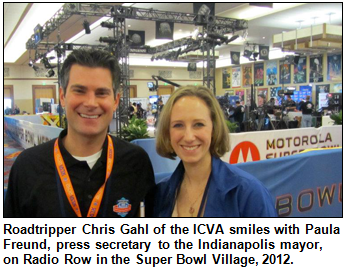 Roadtrip: Tales from the Super Bowl
Roadtrip: Tales from the Super Bowl
Roadtripper Chris Gahl, vice president of marketing and communications for the ICVA, returns to our airwaves this Saturday after a three-week hiatus, him having been at the epicenter of Indy's successful hosting of the Super Bowl.
We couldn't resist asking Chris if he would give us his own version of why Indianapolis made history last week.
Also, here's a locally produced time-lapsed video by Dusty Frey.
Sports team loyalties across Indiana
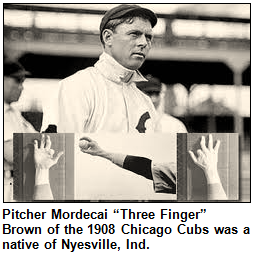 (Feb. 4, 2012) - During Super Bowl weekend in Indy, what better time to tackle the heritage of sports fans across the Hoosier state?
(Feb. 4, 2012) - During Super Bowl weekend in Indy, what better time to tackle the heritage of sports fans across the Hoosier state?
Beloved as the Indianapolis Colts have become in their hometown, do you recall that several years after their arrival in 1984 the Hoosier capital remained packed with Chicago Bears fans? In fact, early match-ups between the Colts and the Bears early on in the bygone stadium then known as the Hoosier Dome often included brother-vs.-brother clashes among families with sharply divided loyalties.
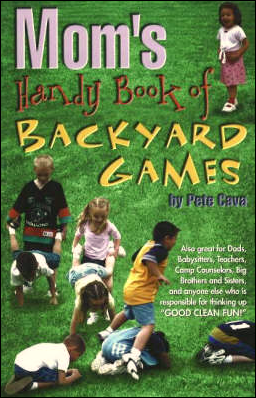 In baseball, some analysts contend that generations of Central Indiana residents have been about evenly divided between Chicago Cubs and Cincinnati Reds enthusiasts. (Pardon us as we hustle back to football for a sec to observe that the Cincinnati Bengals never seemed to catch fire in Central Indiana. They just didn't have the traditions or the colorful aura of Da Bears.)
In baseball, some analysts contend that generations of Central Indiana residents have been about evenly divided between Chicago Cubs and Cincinnati Reds enthusiasts. (Pardon us as we hustle back to football for a sec to observe that the Cincinnati Bengals never seemed to catch fire in Central Indiana. They just didn't have the traditions or the colorful aura of Da Bears.)
Of course, Cubs fans are renowned for their fervor and faith, despite the fact that the team hasn't won a World Series since 1908.
In Evansville and other areas of southwestern Indiana, the allegiance of many baseball fans is to the St. Louis Cardinals. Did you know that in terms of mileage, Evansville is closer to St. Louis than to Indy?
In Lake County and elsewhere in northwestern Indiana, of course, the Bears, Bulls, Cubs, White Sox and other Chicago-based teams enjoy passionate support.
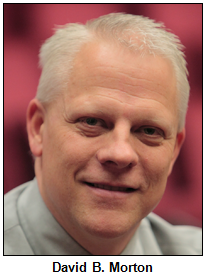 To explore sports team loyalties across Indiana - and across several sports, including football, basketball and baseball - Nelson is joined in studio by two veteran Indianapolis-based sports marketers with media backgrounds. His guests:
To explore sports team loyalties across Indiana - and across several sports, including football, basketball and baseball - Nelson is joined in studio by two veteran Indianapolis-based sports marketers with media backgrounds. His guests:
- Pete Cava, who has served in top posts with USA Track & Field and the Amateur Athletics Union. Pete is the author of Tales From the Cubs Dugout and Mom's Handy Book of Backyard Games.
- And David Morton, a principal of Sunrise Sports Group, sports marketing consultants. Sunrise specializes in athlete management, media relations, sponsorship sales and other sports-related services.
 On the eve of the big game at Lucas Oil Stadium, Pete, David and Nelson will delve into regional loyalties across Indiana and how some have shifted while others remain as rock-solid as a defensive lineman. Listeners are invited to call in and share their observations on this "divided loyalties" issue.
On the eve of the big game at Lucas Oil Stadium, Pete, David and Nelson will delve into regional loyalties across Indiana and how some have shifted while others remain as rock-solid as a defensive lineman. Listeners are invited to call in and share their observations on this "divided loyalties" issue.
According to the Northwest Indiana Business Quarterly, Super Bowl XLI in February 2007 - a Colts-vs.-Bears match-up - "tore at the region's football loyalties." 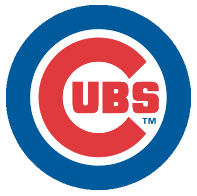 After the Colts won, their fans enjoyed temporary bragging rights in the region that traditionally has been Bears turf, the magazine notes.
After the Colts won, their fans enjoyed temporary bragging rights in the region that traditionally has been Bears turf, the magazine notes.
Even today, the Northwest Indiana magazine continues, "fans of the stylized 'C' of the Bears dominate the landscape - on flags, hats, sweatshirts and bumper stickers. But the fact that the blue horseshoe of the Colts is becoming a more common sight shows the importance of Northwest Indiana to both teams. ... The Indianapolis Colts have increased their presence in the region, bringing team officials, players and cheerleaders to high school games and other events."
Some fun facts:
- The star pitcher of the 1908 World Series won by the Cubs was a colorful Hoosier. A native of tiny Nyesville in far-western Indiana, Mordecai "Three-Finger" Brown lost part of his right hand in a childhood accident with a corn shredder. Some experts contend his reshaped hand became an asset because he was able to throw a curveball with an exceedingly sharp downward break. In the early 1900s, Brown's popularity in his home state is said to have sparked allegiance to the Cubs among many Hoosiers.
 In northwest Indiana, the Chicago White Sox even run a training academy for aspiring sluggers, pitchers and fielders. The Northwest Indiana Bulls/Sox Academy is located in Schererville in Lake County.
In northwest Indiana, the Chicago White Sox even run a training academy for aspiring sluggers, pitchers and fielders. The Northwest Indiana Bulls/Sox Academy is located in Schererville in Lake County.- During World War II, the Cincinnati Reds held spring training at Indiana University, igniting excitement in Bloomington and other southern Indiana communities. In 1943, the Reds used the campus fieldhouse (now Wildermuth Fieldhouse) for spring training amid news coverage that involved "nearly daily reports regarding the team's arrivals, preparations, practices and exhibition games," according to a recent retrospective in the Indiana Daily Student newspaper.
- No poll of central Indiana residents - at least, of the Colts enthusiasts among them - is needed to conclude that the New England Patriots won't be the local fan favorite in Sunday's game.
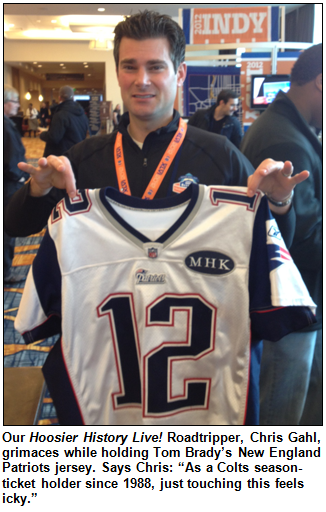 Aside from the intense rivalry between the Colts and the Patriots, there's the brother thing between New York Giants quarterback Eli Manning and a famous sibling who led the Colts to the Super Bowl win against the Bears in 2007.
Aside from the intense rivalry between the Colts and the Patriots, there's the brother thing between New York Giants quarterback Eli Manning and a famous sibling who led the Colts to the Super Bowl win against the Bears in 2007. - "Great Moments in Indy Sports" is a new exhibit at the Eugene and Marilyn Glick Indiana History Center that runs now through Aug. 11, presented in partnership with the Indianapolis Star.
History Mystery
He has a rare distinction. Not only did he grow up in Indiana, where he was a high school and college football star, he suited up both as a Baltimore Colt and as an Indianapolis Colt.
Question: Who is he?
Hint: He has been a studio guest on Hoosier History Live!
The prize was a gift certificate to Shula's Steakhouse at the Westin in downtown Indianapolis. This prize is courtesy of the ICVA.
Roadtrip: Quiet and serene Winona Lake
 As Roadtripper Chris Gahl of the ICVA is working non-stop through the Super Bowl, photo historian Joan Hostetler of Heritage Photo and Research Services, who is a native of Kosciusko County in northern Indiana, suggests that we might want to seek quiet and reflection at some point in time!
As Roadtripper Chris Gahl of the ICVA is working non-stop through the Super Bowl, photo historian Joan Hostetler of Heritage Photo and Research Services, who is a native of Kosciusko County in northern Indiana, suggests that we might want to seek quiet and reflection at some point in time!
One of her favorite "refuges" is Winona Lake near Warsaw, Ind., about a two-and-a-half-hour drive north from Indianapolis.
Joan tells us that Winona Lake was home to an independent Chautauqua in the early part of the 20th century, including visiting artists, religious leaders and notables such as William Jennings Bryan and Billy Sunday.
The historic guest houses and hotels now are part of a charming restored village; tune in Saturday to learn more!
Jan. 28 show
Rev. Jim Jones and Indiana connections
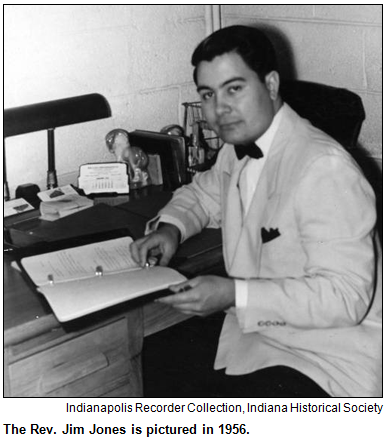 In the final portion of his life, Rev. Jim Jones was associated with Guyana, where more than 900 of his followers participated in a mass murder-suicide that shocked the world in 1978, and California, where his transplanted church, which he called the Peoples Temple, was based for several years.
In the final portion of his life, Rev. Jim Jones was associated with Guyana, where more than 900 of his followers participated in a mass murder-suicide that shocked the world in 1978, and California, where his transplanted church, which he called the Peoples Temple, was based for several years.
This 10 minute KPBS video about Jim Jones includes great shots of his preaching and interviews with former cult members.
The notorious spiritual leader, though, began life and launched his church in Indiana.
To explore and explain Jones' links to Indiana, Rachael Heger of the Indiana State Library joins Nelson in studio. Rachael, the Indiana division supervisor at the state library, has researched and gives presentations about the Hoosier chapters in the life of Jim Jones, who was born in the Randolph County town of Lynn in far-eastern Indiana in 1931.
After graduating from Richmond High School in 1948, Jones attended Indiana and Butler universities. He moved to Indianapolis in the 1950s and eventually launched his church, which had various locations. They included a building at 10th and Delaware streets and, before that, at 15th and New Jersey.
As Rachael notes in her talks, he sold monkeys to raise funds for his church. According to several accounts, the monkeys were imported from India and South America. Jones sold the monkeys door-to-door to Hoosiers. 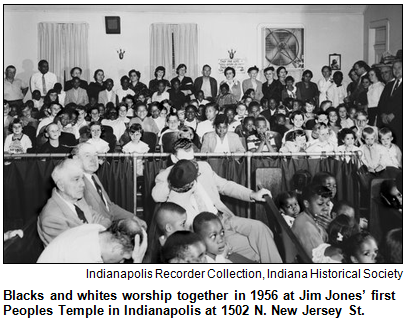 He also took out ads in local newspapers.
He also took out ads in local newspapers.
While living in Indiana, Jim Jones and his wife adopted several children of various races.
"He called this his 'Rainbow Family,'" Rachael notes.
Some of the children were of Korean-American ancestry, and others were Native American. In 1961, Jones and his wife became the first white couple in Indiana to adopt a black child, according to Rachael's research.
In the Hoosier capital, Jones started soup kitchens, took pride in the racial diversity of his congregations and was appointed in 1961 by then-Mayor Charles Boswell to the Indianapolis Human Rights Commission.
Amid increasing local skepticism as he characterized himself as a "prophet," Jones left Indiana in 1965 and urged hundreds of his followers to resettle in California with him. He briefly returned in 1971 to conduct a "healing crusade."
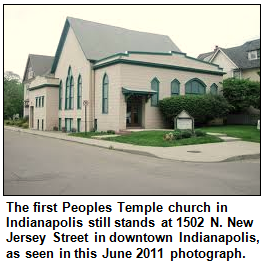 According to the Encyclopedia of Indianapolis, his Indianapolis years were both praised (for his civil rights and social work) and criticized because some people began to regard him as "an unbalanced, power-hungry fanatic." Reports surfaced about mass hypnosis and inauthentic healings.
According to the Encyclopedia of Indianapolis, his Indianapolis years were both praised (for his civil rights and social work) and criticized because some people began to regard him as "an unbalanced, power-hungry fanatic." Reports surfaced about mass hypnosis and inauthentic healings.
During the early 1970s, Jones established multiple congregations in California and, in Guyana, founded Jonestown, a communal outpost. That's where more than 900 followers were urged by Jones in November 1978 to drink cyanide-laced Kool-Aid in a mass suicide. (Authorities eventually discovered the corpse of Jones, who died of a gunshot wound that was determined to be self-inflicted.)
Earlier on the day of the mass suicides, a U.S. congressman from California and several reporters were murdered in Guyana after they arrived to investigate Jones' activities.
Journalists from Indiana also had been raising warning signs about Jones for several years. Carolyn Pickering, an investigative reporter for the Indianapolis Star who died in 2010, earned national recognition for being among the first in the country to expose "cult" aspects of Jones' sermons.
In 1972, after Jones had decamped to California, Pickering (who later was inducted into the Indiana Journalism Hall of Fame) contacted San Francisco sources for information about his transplanted church. That sparked an in-depth investigation by the San Francisco Examiner of Peoples Temple activities.
 Rachael, our guest, specializes in researching 20th-century history in Indianapolis, as well as business and women's history. Her presentations about the Hoosier years of Rev. Jim Jones are part of a series in which the state library responds to frequently asked questions from the public.
Rachael, our guest, specializes in researching 20th-century history in Indianapolis, as well as business and women's history. Her presentations about the Hoosier years of Rev. Jim Jones are part of a series in which the state library responds to frequently asked questions from the public.
Nelson, our host, also has a connection to the Jonestown aftermath. As a rookie reporter in 1982, four years after the Guyana tragedy, Nelson earned one of his first front-page bylines by breaking the story of a 79-year-old Indianapolis native who survived the Guyana tragedy by sleeping in her cottage rather than attending the "suicide" ceremony.
A 21-year adherent of Jones since his days in Indy, Hyacinth Thrash had begun boycotting his worship sessions because of their increasingly bizarre nature. Mrs. Thrash woke up to find herself in the midst of more than 900 corpses and waited alone for 12 hours until authorities arrived at the compound.
She is believed to be the only person to live through the night of Nov. 18, 1978, while remaining on the premises. (A few other survivors escaped by hiding in a nearby jungle instead of drinking the poisoned Kool-Aid.) Mrs. Thrash's story also is recounted in a book by Indianapolis author Marian Towne, The Onliest One Alive.
History Mystery
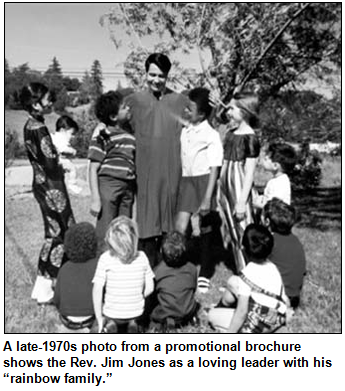 In the mid-1950s, Rev. Jim Jones organized large religious conventions at a massive building in downtown Indianapolis.
In the mid-1950s, Rev. Jim Jones organized large religious conventions at a massive building in downtown Indianapolis.
The building, at the corner of Ohio and New Jersey streets, was a city landmark for more than 45 years. A Spanish-style convention center and revival house with a whitewashed façade, the building was the setting for a wide variety of public events, including teacher conventions, religious revivals, political rallies and dance marathons.
Built in 1921, the building had a seating capacity of 10,000 and a choir loft that accommodated 1,500 more. For many years, choir performances were broadcast on national radio from the building, which was one of the few structures in downtown Indy then that could accommodate major events. The building was demolished in the late 1960s.
Question: Name the bygone building.
The prize was a pair of tickets to the Indianapolis Symphony Orchestra. This prize is courtesy of the ICVA.
Roadtrip: Super Biz Bowl on Feb. 1
Roadtripper Chris Gahl of the ICVA is working non-stop through Super Bowl weekend, so this Saturday, longtime downtown Indy resident Garry Chilluffo of Chilluffo Photography will be filling in. Garry suggests that all of us "locals" come down to the Super Biz Bowl at Super Bowl Village on Wednesday, Feb. 1, from 3 to 10 p.m., where the party will include - well, all of it!
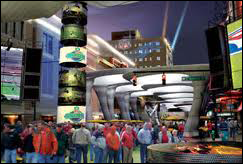 Scavenger hunts, "Fire and Ice" Lounges, free concerts on two stages, "Super Dash" - which is described as a sort of "human gerbil ball" competition - zip-line rides and The Huddle at Circle Centre mall in the space previously occupied by Nordstrom.
Scavenger hunts, "Fire and Ice" Lounges, free concerts on two stages, "Super Dash" - which is described as a sort of "human gerbil ball" competition - zip-line rides and The Huddle at Circle Centre mall in the space previously occupied by Nordstrom.
Getting in and out of downtown? A Super Bowl Village map is available. Also in the mix is the Super Bowl Park and ride service, as well as general "Know Before You Go information.
Don't want to plan ahead and pay only $1.75 each way? Create your own "park and ride" trip with IndyGo. For example, if you live on the north side of Indianapolis, park somewhere along North Meridian Street and take a regularly scheduled IndyGo bus - the 18, 38, or 39 - into downtown. The schedule remains the same through Super Bowl, and the last 39 bus leaves Ohio Street and Capitol Avenue at 11:45 p.m. and heads north on Meridian, back to your parked car.
Dan Wakefield on '50s landmarks in Indy
(Jan. 21, 2012) - First and foremost, he's probably known for his best-selling novel Going All the Way (1970), which was set in Indianapolis during the 1950s.
But Dan Wakefield also wrote an acclaimed memoir called Returning: A Spiritual Journey (1988), and returning is what the celebrated author-journalist-screenwriter-educator has just done. 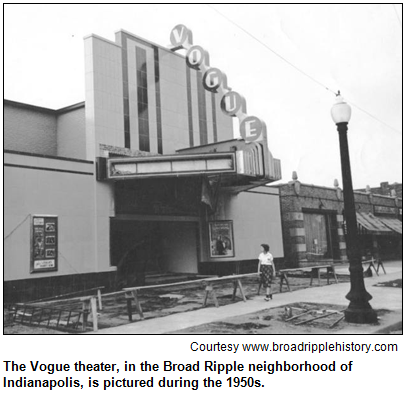 He recently moved back to his hometown (Wakefield, 79, grew up on the northside of Indy and graduated from Shortridge High School in 1950) after decades spent living in Miami, New York City and Boston.
He recently moved back to his hometown (Wakefield, 79, grew up on the northside of Indy and graduated from Shortridge High School in 1950) after decades spent living in Miami, New York City and Boston.
So Dan joins Nelson in studio to share insights on a range of topics. Ours being a history show, we can't resist having him reflect on local landmarks that not only figure in his early life; many have been featured in his books, particularly Going All the Way, which inspired a 1997 movie filmed in Indy.
The landmarks - some bygone, some very much still with us - include the Red Key Tavern; the Tee Pee and the Ron-D-Vu (beloved eateries that were the focus of a recent Hoosier History Live! show about drive-ins); the Mandarin Inn (in Dan's recollection, one of the few ethnic restaurants in the city during his boyhood years); Crown Hill Cemetery, and, of course, Shortridge.
During his high school days, Dan was co-sports editor of The Echo, the daily newspaper at Shortridge, sharing duties with Richard Lugar, the future mayor and U.S. senator.
 Dan's current project involves another illustrious Shortridge grad. He's assembling and editing a collection of letters from his late friend, literary icon Kurt Vonnegut Jr., a member of Shortridge's Class of 1940.
Dan's current project involves another illustrious Shortridge grad. He's assembling and editing a collection of letters from his late friend, literary icon Kurt Vonnegut Jr., a member of Shortridge's Class of 1940.
So there's much hometown turf to cover with Dan, whose other books include Starting Over (1973) - it was made into a movie starring Burt Reynolds and Candice Bergen - and Expect a Miracle (1995).
Since Dan's return to his hometown just before the holiday season, he's been living in an apartment in downtown Indy. For 17 years previously, he lived in the Miami area and taught at Florida International University. He's no stranger to audiences across the country, though. Thanks to his books such as Creating from the Spirit (1996) and How Do We Know When It's God? (1999), he has led workshops on creativity and spirituality in many cities.
For Hoosier History Live!, though, we will have our distinguished guest hone in on Indy-area sites that figured in his youth and, later, in his works.
The only child of a pharmacist and a housewife, Dan Wakefield grew up in Broad Ripple. He attended School 80 at 920 E. 62nd Street (it's now condos), was an active Boy Scout and found himself enthralled by movies at The Vogue, which today is a popular nightspot/concert venue since a series of renovations that began more than 30 years ago.
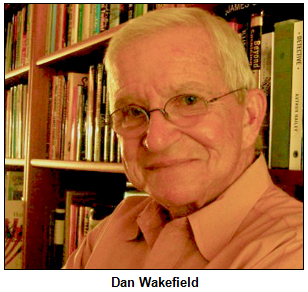 Sports-crazed as a boy, Dan once told Nelson - who features him in his book Indiana Legends: Famous Hoosiers from Johnny Appleseed to David Letterman, 4th Edition (2005) - that his goal was to grow up and coach football at the University of Notre Dame. Almost instantly cut from Broad Ripple High School's football team (in Returning, Dan describes himself as "small," "skinny," "bumbling" and "uncoordinated"), he transferred to Shortridge and thrived at The Echo.
Sports-crazed as a boy, Dan once told Nelson - who features him in his book Indiana Legends: Famous Hoosiers from Johnny Appleseed to David Letterman, 4th Edition (2005) - that his goal was to grow up and coach football at the University of Notre Dame. Almost instantly cut from Broad Ripple High School's football team (in Returning, Dan describes himself as "small," "skinny," "bumbling" and "uncoordinated"), he transferred to Shortridge and thrived at The Echo.
In Going All the Way, the alma mater of the central characters is called "Shortley," although the student newspaper is referred to as The Echo. Another character is a former waitress at the Ron-D-Vu. Referring in Returning to the drive-in's appeal for his pack of teenage friends, Dan writes:
"We giggled and punched and sang and screamed and piled into one another's jalopies, circling the drive-ins like sharks before nosing into a slot at the Ron-D-Vu for french-fried onion rings and a chance to talk to the fabulous girls who ran in their own herds."
In Going All the Way, which is set several years after the protagonists have graduated from high school, one character invites another to look at his artwork in the mid-afternoon of a summer day at the Red Key Tavern on North College Avenue.
 "That seemed a funny place to look at a painting, a bar that was dark even in the brightest part of the day," Dan writes. Even so, the characters are clearly fond of the Red Key, which they often just call "The Key." (With its jukebox and vintage atmosphere, the tavern remains a popular hangout today, more than 60 years after it opened.)
"That seemed a funny place to look at a painting, a bar that was dark even in the brightest part of the day," Dan writes. Even so, the characters are clearly fond of the Red Key, which they often just call "The Key." (With its jukebox and vintage atmosphere, the tavern remains a popular hangout today, more than 60 years after it opened.)
Crown Hill, the third-largest private (non-military) cemetery in the country, also remains as much of an Indy landmark as it was during Dan Wakefield's boyhood. Sprawling over 550 acres, Crown Hill has a three-arched Gothic gateway at Boulevard Place and 34th Street and is the burial site of more American vice presidents (three) than any other cemetery. Crown Hill also is the burial site of gangster John Dillinger, President Benjamin Harrison, poets, tycoons and generations of Vonneguts, although not of Kurt Jr., who died in 2007.
Dan Wakefield credits Vonnegut with helping draw the attention of publishers and critics to Going All the Way, which Dan set in Indy after initially considering Cleveland and other cities.
"Placing it in Indianapolis gave the book an emotional center," Dan once told Nelson. "I care about Indianapolis. I really don’t care about Cleveland."
History Mystery
 During a recent Hoosier History Live! show about drive-in restaurants, our focus included the beloved Tee Pee. The History Mystery inquired about the best-selling book that featured several mentions of the Ron-D-Vu; the answer was Going All the Way.
During a recent Hoosier History Live! show about drive-in restaurants, our focus included the beloved Tee Pee. The History Mystery inquired about the best-selling book that featured several mentions of the Ron-D-Vu; the answer was Going All the Way.
Among other drive-ins discussed during the show was a bygone restaurant on the westside of Indianapolis. Popular during the 1950s and '60s, the drive-in was located near West 16th Street and Lafayette Road.
Question: Name the drive-in restaurant.
The prize was a gift certificate to the Jameson Inn on the Westside of Indianapolis, as well as two tickets to the Indianapolis Motor Speedway Hall of Fame Museum. These prizes are courtesy of the ICVA.
Roadtrip: Super art
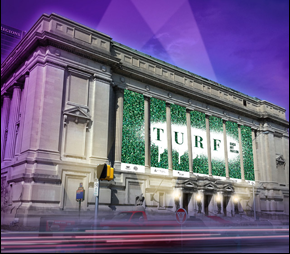 Roadtripper Chris Gahl of the ICVA tells us that "super local art," hand-made by artists right here in the "super city," can be seen now at the majestic old Indiana State Museum building downtown at 202 N. Alabama Street.
Roadtripper Chris Gahl of the ICVA tells us that "super local art," hand-made by artists right here in the "super city," can be seen now at the majestic old Indiana State Museum building downtown at 202 N. Alabama Street.
In an exhibit called TURF, the IDADA-inspired art showcase is inviting throngs of visiting Super Bowl fans to indulge in Indy's art scene. The exhibit also is intended to be a sort of gateway for visitors who might later want to explore the Massachusetts Avenue gallery and restaurant scene.
More than 1,000 Indianapolis Public Schools students will be taking a tour of TURF. The exhibit is free and open to the public Tuesday through Sunday from 10 a.m. to 7 p.m., right up to that fateful game day of Feb. 5.
Jan. 14 show
Indiana's youngest mayor on Frankfort history
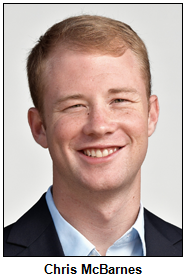 Before election day in November, Chris McBarnes made headlines across the state by campaigning for public office while attending classes at Butler University, where he was studying anthropology and communications.
Before election day in November, Chris McBarnes made headlines across the state by campaigning for public office while attending classes at Butler University, where he was studying anthropology and communications.
Now, the 23-year-old rising star in the Republican Party has graduated from college, is the new mayor of his hometown and has the distinction of being the youngest mayor of an Indiana city.
So Chris joins Nelson in studio to share insights about the history of Frankfort, the city of 16,400 people in Clinton County.
You may know Frankfort as the "Home of the Hot Dogs." Frankfort High School's mascot is the hot dog, and the community hosts the Frankfort Hot Dog Festival every summer.
There are other intriguing aspects of the town, though, including the award-winning Frankfort Community Public Library. It serves as a cultural center, with art galleries, a music room and a coffee bar.
In addition to sharing insights about the heritage of his hometown, which was founded in the 1830s, Chris McBarnes talks with Nelson about his personal journey and meteoric rise in politics.
 According to a profile of Chris in The Lafayette Journal and Courier, he was diagnosed at age 14 with a rare immune system disorder. The illness resulted in more than 25 surgeries and frequent hospitalizations at the Indiana University Medical Center, but it is now under control.
According to a profile of Chris in The Lafayette Journal and Courier, he was diagnosed at age 14 with a rare immune system disorder. The illness resulted in more than 25 surgeries and frequent hospitalizations at the Indiana University Medical Center, but it is now under control.
His mayoral crusade involved a lot of shoe leather. Last May, after winning the Republican primary with 60 percent of the vote, Chris was quoted as estimating he and a group of 25 volunteers knocked on the doors of 90 percent of Frankfort's homes. (According to news accounts, his Sigma Nu fraternity brothers at Butler pitched in as volunteers.)
During the campaign, Chris vowed to end an "old-boys system" of governing the town and expressed hopes he can inspire more of the community's young people to return after college.
"I am proud to say I'm a hometown product," his campaign website proclaimed. "I am a Frankfort Hot Dog through and through."
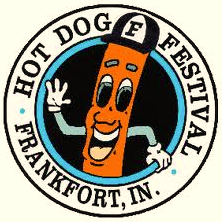 Named in tribute to Frankfurt, Germany, the Indiana town was developed on 60 acres donated by three brothers of German-American heritage who moved to the area in the late 1820s. Frankfort became the county seat of Clinton County and a stop on one of the legendary Monon train lines to Indianapolis.
Named in tribute to Frankfurt, Germany, the Indiana town was developed on 60 acres donated by three brothers of German-American heritage who moved to the area in the late 1820s. Frankfort became the county seat of Clinton County and a stop on one of the legendary Monon train lines to Indianapolis.
According to The Magnificent 92: Indiana Courthouses (Indiana University Press, 1991), the Clinton County Courthouse in Frankfort cost nearly $200,000 to build in the 1880s. (That expense, considered exorbitant then, was nearly three times the amount spent on courthouses in Wabash and Lagrange counties during the same era.)
A three-story structure with a clock and central tower rising to 165 feet above the town square, the Clinton County Courthouse is adorned by statuary and built of Indiana limestone. The architect, George Bunting of Indianapolis, also designed the county courthouses in several other Indiana cities, including Anderson and Franklin.
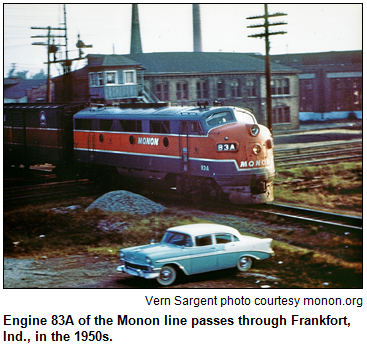 When Chris was growing up in Frankfort, his father, Tim McBarnes, was head golf pro at a country club. His mother, Kim, was a school nurse. The family also includes a brother, Craig, who completed on various Frankfort Hot Dog sports teams and now is a student at Butler.
When Chris was growing up in Frankfort, his father, Tim McBarnes, was head golf pro at a country club. His mother, Kim, was a school nurse. The family also includes a brother, Craig, who completed on various Frankfort Hot Dog sports teams and now is a student at Butler.
Some fun facts:
- Frankfort hosted the world premiere of the movie Blue Chips (1994), which starred Nick Nolte as a basketball coach with similarities to Bobby Knight. (Knight had a cameo role in the film. So did Larry Bird.) Several sequences in Blue Chips were shot at Frankfort High School's gym, which seats more than 6,000 spectators. Nelson was part of the media contingent that covered the movie's premiere in Frankfort.
- Frankfort High School's impressive gym is called the Everett Case Arena. A well-known figure in Hoosier basketball lore, Everett Case coached Frankfort teams to four state championships between 1925 and 1939.
- Although Chris McBarnes is the youngest mayor in Indiana, he's not the only youthful Hoosier who now may be called "His Honor." In last November's elections, candidates age 30 or under also were elected mayors in South Bend, LaPorte and Columbia City.
History Mystery
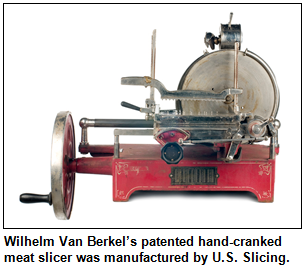 In the world of Hoosier high school mascots, the Frankfort High School Hot Dogs are unforgettable. A high school in another Indiana city also has a distinctive mascot name: the Slicers. The name originated because the Indiana city was the home of the U.S. Slicing Machine Company.
In the world of Hoosier high school mascots, the Frankfort High School Hot Dogs are unforgettable. A high school in another Indiana city also has a distinctive mascot name: the Slicers. The name originated because the Indiana city was the home of the U.S. Slicing Machine Company.
Question: What high school has sports teams known as the Slicers?
Hints: The high school - like Frankfort High in Frankfort - has the same name as its hometown. And the town is located in far-northern Indiana.
The prize was a gift certificate to Mo's, A Place for Steaks in downtown Indianapolis, as well as a pair of tickets to the IMAX theater at the Indiana State Museum. These prizes are courtesy of the ICVA.
Roadtrip: Adams Mill in Carroll County
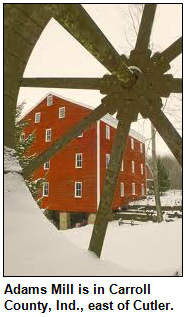 Roadtripper Chris Gahl of the ICVA suggests we take Highway 75 north out of Frankfort about 14 miles to Cutler in Carroll County and look for signs for Adams Mill. The grist mill is a splendid example of post-and-beam construction and is listed on the National Register of Historic Places.
Roadtripper Chris Gahl of the ICVA suggests we take Highway 75 north out of Frankfort about 14 miles to Cutler in Carroll County and look for signs for Adams Mill. The grist mill is a splendid example of post-and-beam construction and is listed on the National Register of Historic Places.
Legend has it that John Adams, who built the mill in 1845, walked along Wildcat Creek from Lafayette to Kokomo to find the perfect spot. He chose its location because of the oxbow bend in the creek there.
Although commercial milling ceased at Adams Mill in the 1950s, much of the mill machinery is still operational. The mill is open weekend afternoons from May through October, or by appointment at info@adams-mill.org. Perhaps you will get lucky and get a beautiful, quiet winter tour! And if you have trouble finding Adams Mill, just ask someone. After all, this is an Indiana Roadtrip!
Old Northside neighborhood history in Indy
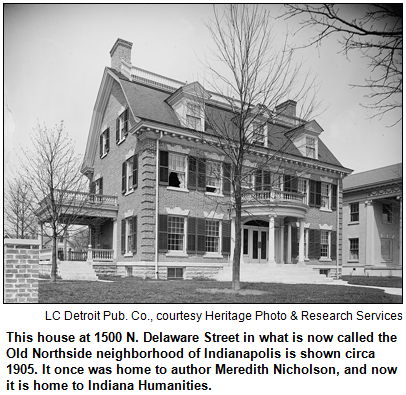 (Jan. 7, 2012) - Thanks to spacious Italianate and Queen Anne-style houses, many built in the late 1800s, the Old Northside in Indianapolis became the city's posh neighborhood through the World War I era.
(Jan. 7, 2012) - Thanks to spacious Italianate and Queen Anne-style houses, many built in the late 1800s, the Old Northside in Indianapolis became the city's posh neighborhood through the World War I era.
By the 1970s, when urban pioneers Paul Smith, Rick Patton and their wives moved into two of the historic homes, the neighborhood had become, as Rick puts it, "blighted." Paul says his house was even occupied by a drug dealer.
During the 30 years since then, many of the grand homes have been restored to their former glory in the neighborhood, which has been placed on the National Register of Historic Places and is now known as the Old Northside Historic District. Paul and Rick join Nelson in studio to explore the colorful heritage of the neighborhood that's roughly bounded by East 11th, Pennsylvania, East 16th and Carrollton streets.
During the decades that the Old Northside struggled, many of the once-fashionable homes (Rick estimates more than 100) were demolished. Others, including his, were converted to apartments.
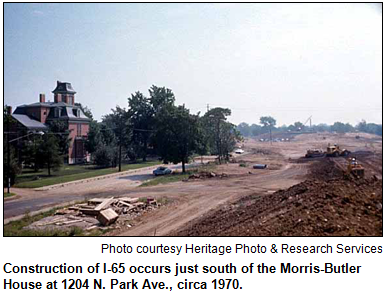 By the way, Rick's home was built in 1876 by the son-in-law of civic leader Ovid Butler, a founder of the university that now bears his name. In fact, the Old Northside was the initial site of Butler University, then known as North Western Christian University.
By the way, Rick's home was built in 1876 by the son-in-law of civic leader Ovid Butler, a founder of the university that now bears his name. In fact, the Old Northside was the initial site of Butler University, then known as North Western Christian University.
(Fun fact: College Avenue derives its name because the street led to the university, which moved to Irvington during the 1870s. Butler moved yet again, to its current location, in the 1920s.)
Paul Smith, whose house was built in 1882, is a past president of the Old Northside Neighborhood Association and a past board member of Indiana Landmarks, the historic preservation organization that last April became an Old Northside "resident" by moving into the former Central Avenue United Methodist Church, later known as the Old Centrum.
Most of the Old Northside's historic homes were built between the 1870s and the early 1900s.  Before the Civil War, property in what became the Old Northside was regarded as too far away from the bustling Mile Square to be developed for homes.
Before the Civil War, property in what became the Old Northside was regarded as too far away from the bustling Mile Square to be developed for homes.
That changed with the coming of horse-drawn trolleys and the extension of city streets. During the late 1800s and early 1900s, influential Old Northside residents included Benjamin Harrison (his Italianate home, now known as the Benjamin Harrison Presidential Site, is at 12th and Delaware streets); the Ayres and Wasson families of department store fame (their historic mansions were demolished); novelist Meredith Nicholson, author of the bestselling romance thriller House of 1,000 Candles, and Thomas Taggart, the former mayor who bought the French Lick Springs Hotel.
The Old Northside also includes the restored Morris-Butler House, the Victorian-era house museum owned by Indiana Landmarks. And it includes a Romanesque Revival house built in the 1890s at 1410 N. Delaware that, since the 1920s, has been housed the Propylaeum Club.
Why were so many homes demolished in the Old Northside?  Many, including the mansions of the Ayres and Wasson families, came down during the 1960s with the construction of I-65, which cuts through the neighborhood. Other homes were demolished as part of "urban renewal."
Many, including the mansions of the Ayres and Wasson families, came down during the 1960s with the construction of I-65, which cuts through the neighborhood. Other homes were demolished as part of "urban renewal."
Along with the spectacular renovations of many historic houses in recent years, new-home construction has occurred, particularly on the east edge of the neighborhood near College Avenue.
As Old Northside residents for more than 30 years - Paul and Rick arrived with their wives shortly after graduating from college - our guests share insights about the changes they have seen in their neighborhood. Paul is real estate manager for the city of Indianapolis; Rick is an executive for a textbook publisher.
As Rick notes with pride, the Old Northside today resembles the neighborhood depicted in historic photographs much more than the "blighted" residential area he encountered as a newlywed.
History Mystery
Central Avenue United Methodist Church was built in the early 1890s at 12th Street and Central Avenue in the Old Northside neighborhood. Last year, the Romanesque Revival building became the new headquarters of Indiana Landmarks after a spectacular renovation.  A congregation had not been worshipping in the building in recent years.
A congregation had not been worshipping in the building in recent years.
Through the early 1950s, though, Central Avenue United Methodist was attended by many top civic leaders and was extremely influential in city life. The church is credited with helping start Methodist Hospital and Wheeler Rescue Mission.
During the 1930s and '40s, Central Avenue was attended by a young boy who would grow up to be one of the best-known politicians in the state. He is still serving in public office.
Question: Who is he?
The prize was an overnight stay at the JW Marriott Hotel in downtown Indianapolis (just don't try to book your complimentary room during the Super Bowl!) as well as a pair of tickets to the Eiteljorg Museum, courtesy of the ICVA.
Roadtrip: City Gallery at Harrison Center for the Arts
 Roadtripper Chris Gahl of the ICVA suggests we head to one of the newest urban gems in the Old Northside, the City Gallery at Harrison Center for the Arts at 1505 N. Delaware St., across the street from the Meredith Nicholson House. The City Gallery is described as an urban living center that uses arts and culture to promote and tell the story of Indy's urban neighborhoods.
Roadtripper Chris Gahl of the ICVA suggests we head to one of the newest urban gems in the Old Northside, the City Gallery at Harrison Center for the Arts at 1505 N. Delaware St., across the street from the Meredith Nicholson House. The City Gallery is described as an urban living center that uses arts and culture to promote and tell the story of Indy's urban neighborhoods.
The center is not-for-profit and offers information for people thinking about moving into an Indianapolis neighborhood, either by renting or buying. Its biggest partner is the Indianapolis Neighborhood Housing Partnership.
The City Gallery opened in August of 2011 and is open for business Monday through Friday from 9 a.m. to 5 p.m., and on First Fridays until 9 p.m.
Stop in and check out how easy and affordable it can be to move into a fun and quirky neighborhood that perhaps you didn't even know about! The phone number is (317) 396-3886.
Jan. 8, 2012
Nelson Price speaks on Vonnegut family history
Interested in hearing Nelson's dynamic presentation about the Kurt Vonnegut family in Indianapolis? Come to the Kurt Vonnegut Memorial Library, 340 N. Senate Ave., this Sunday, Jan. 8, at 2 p.m.
This event was free of charge.
